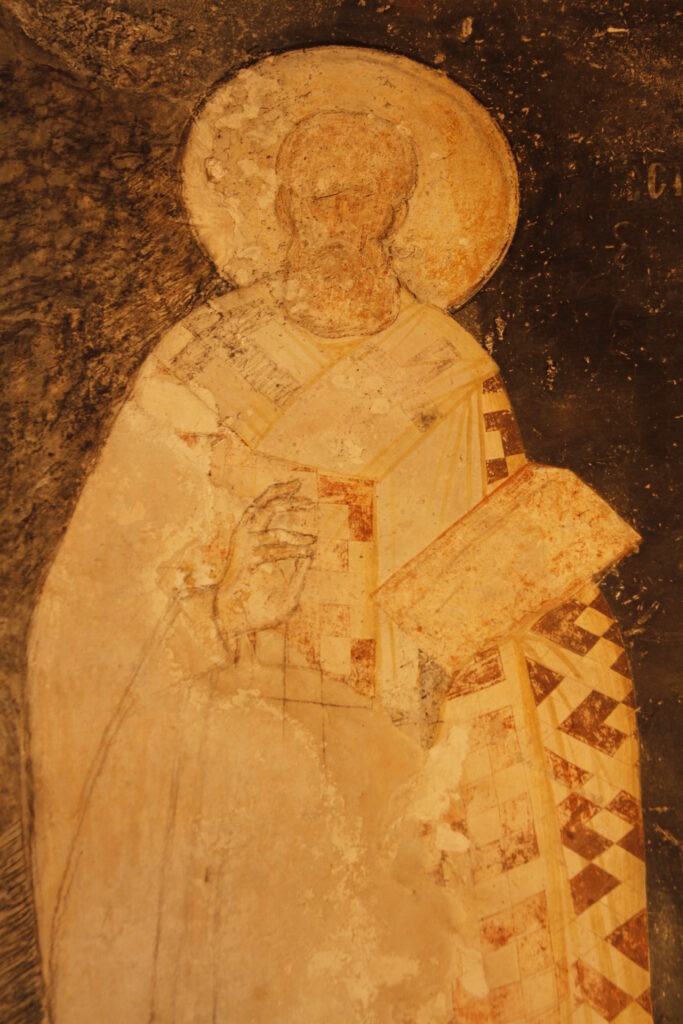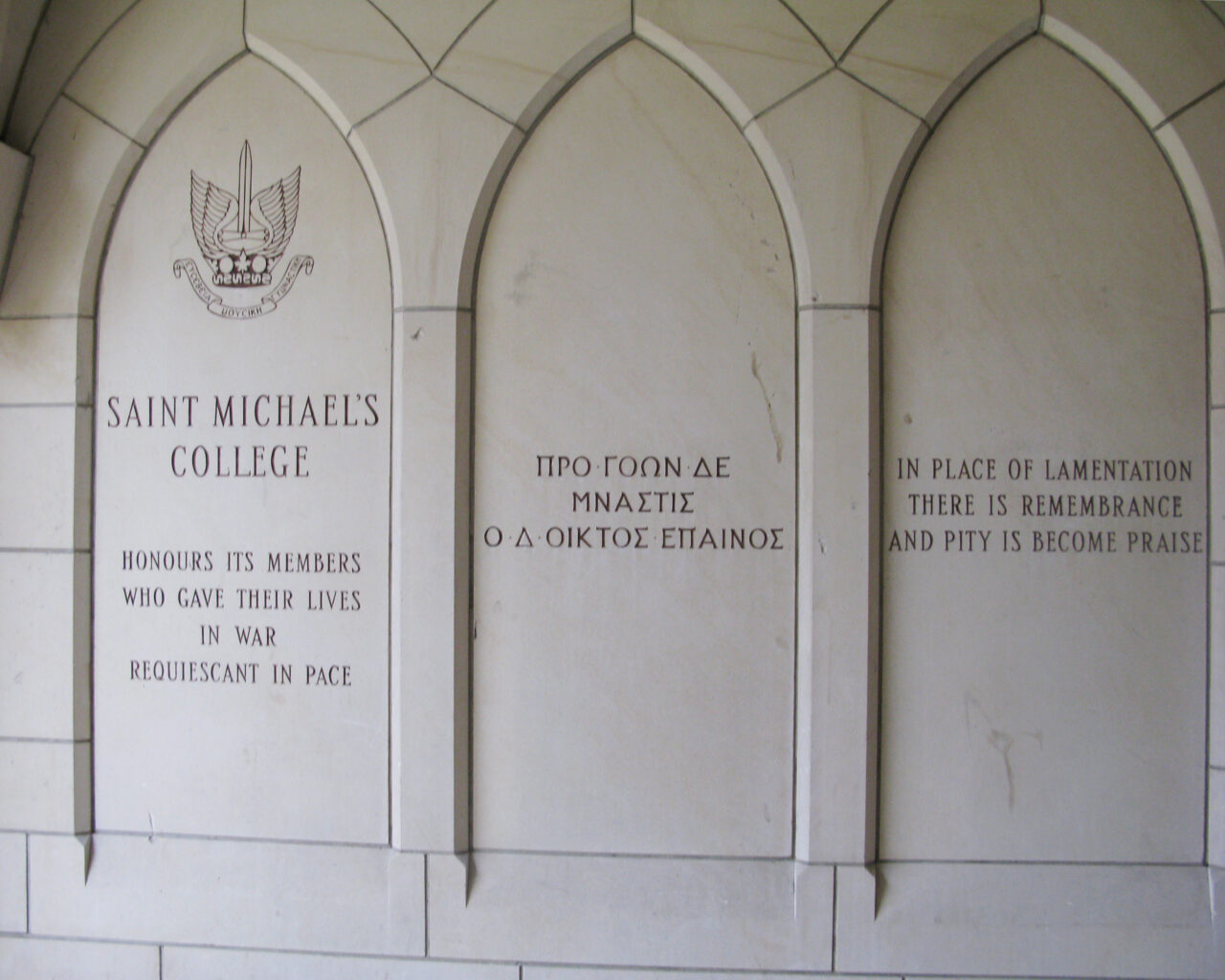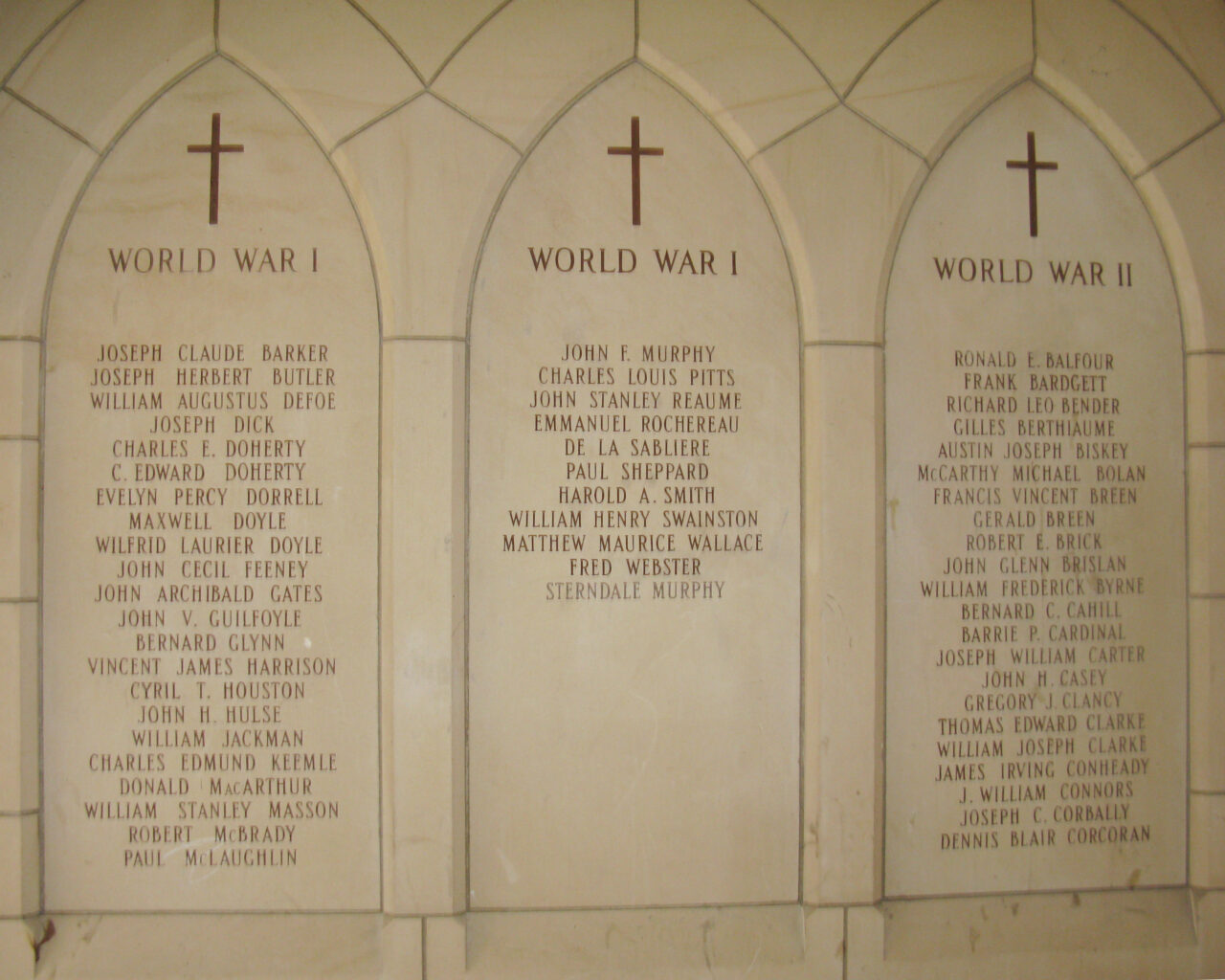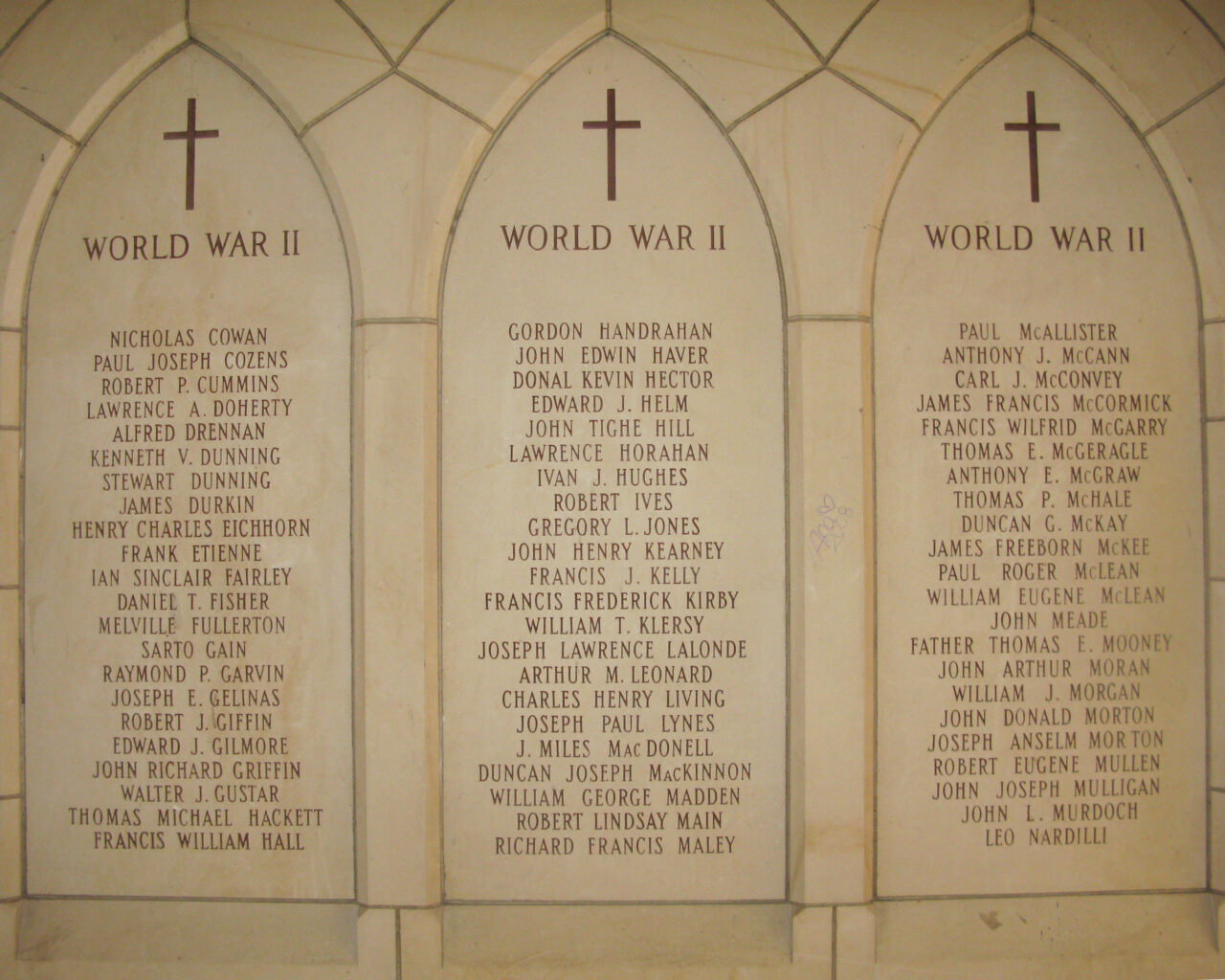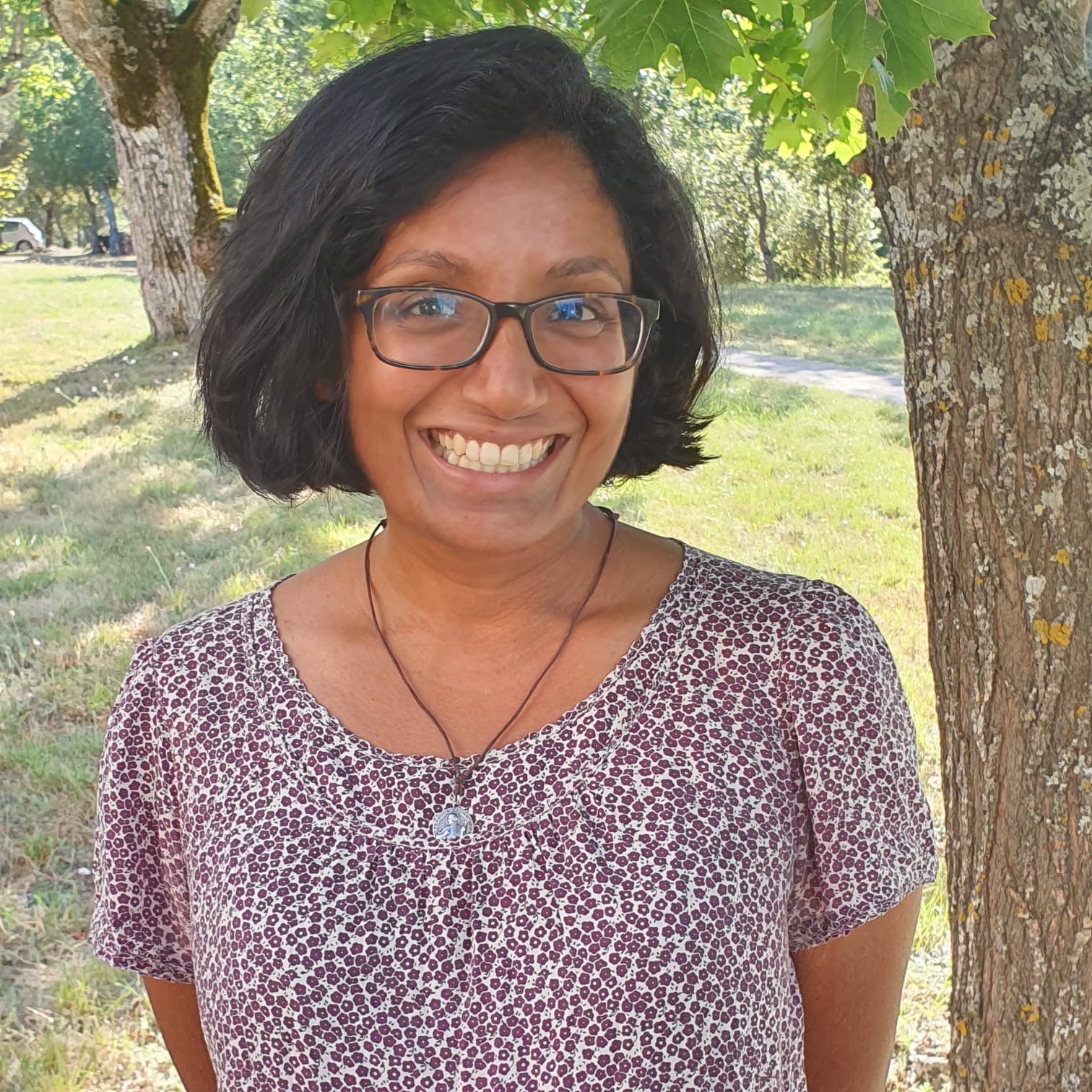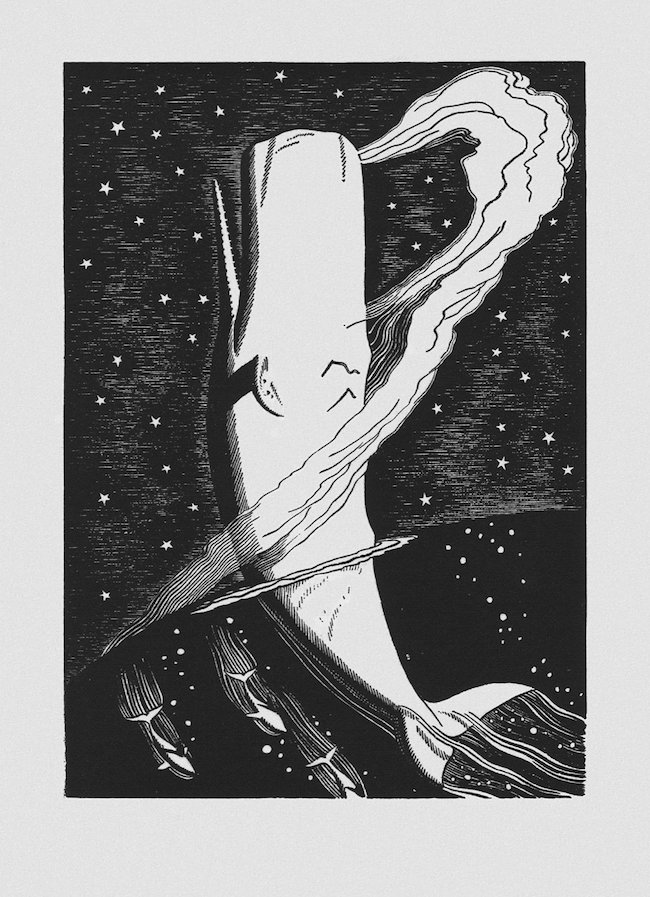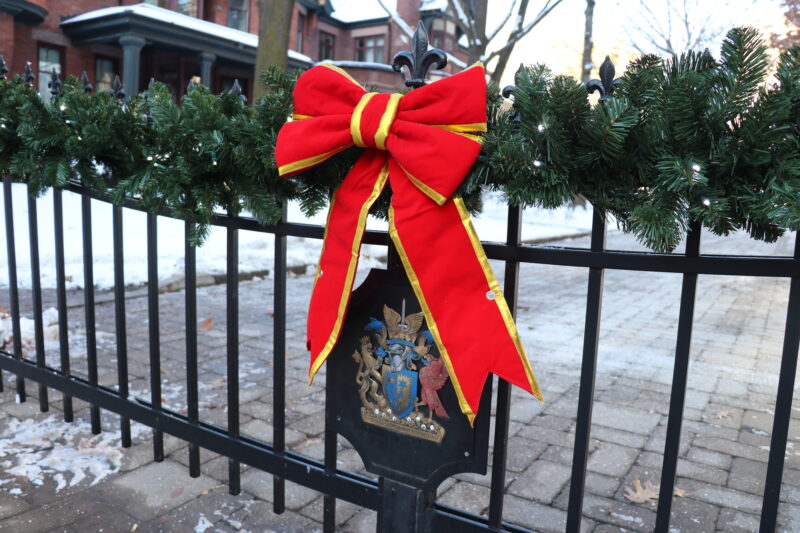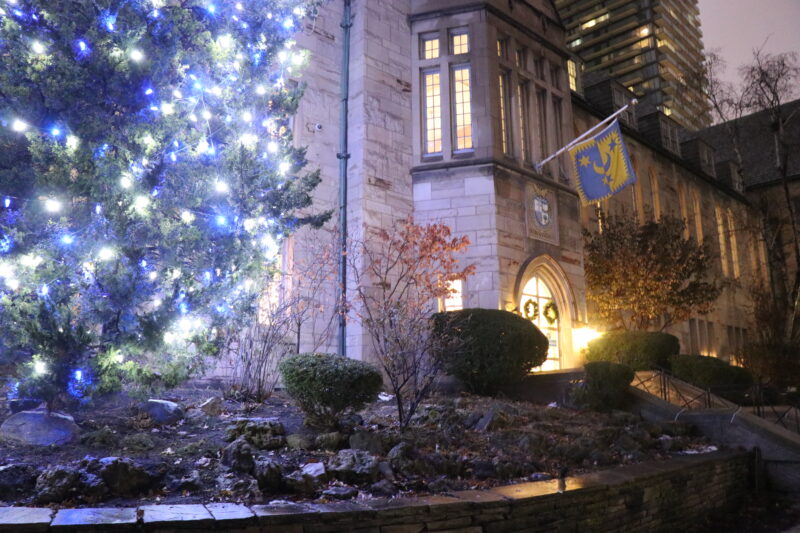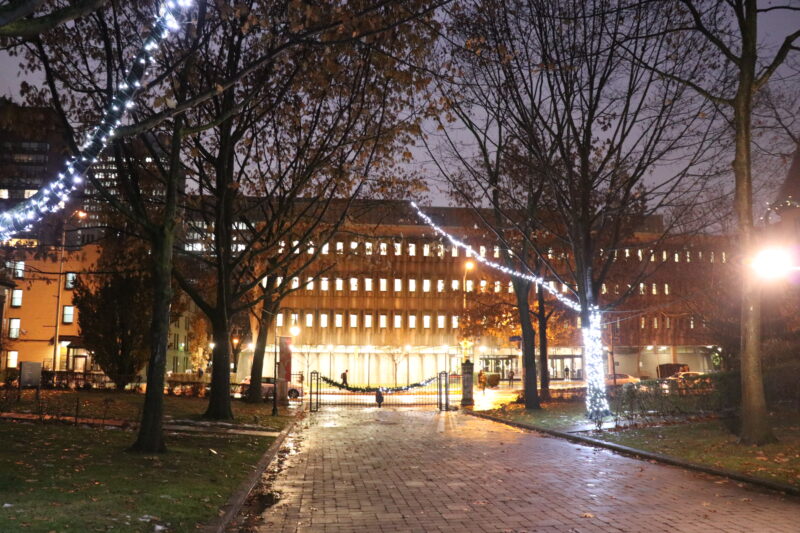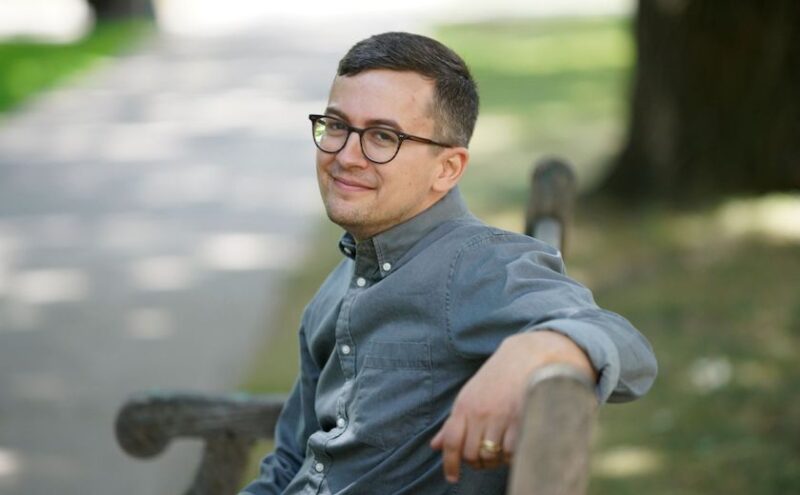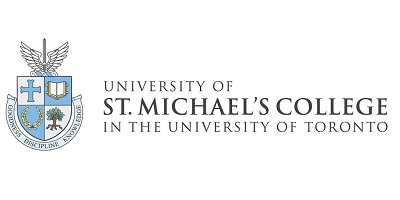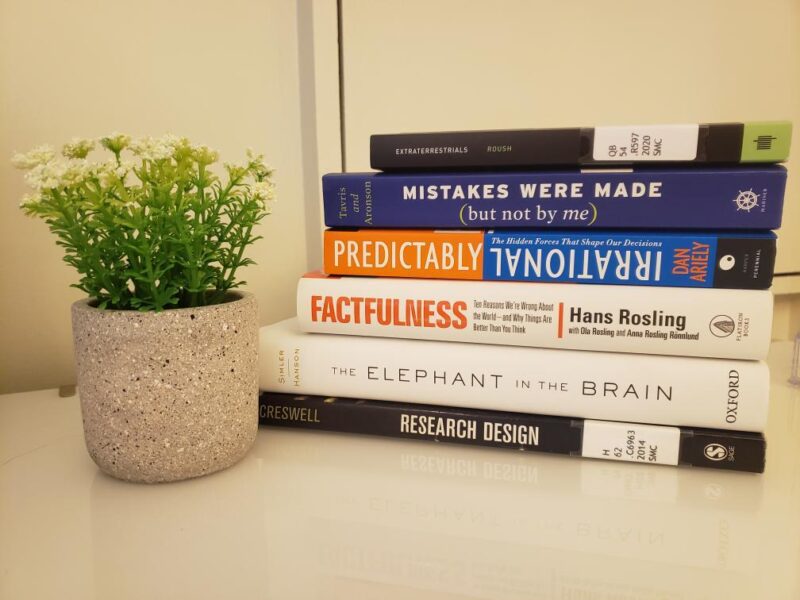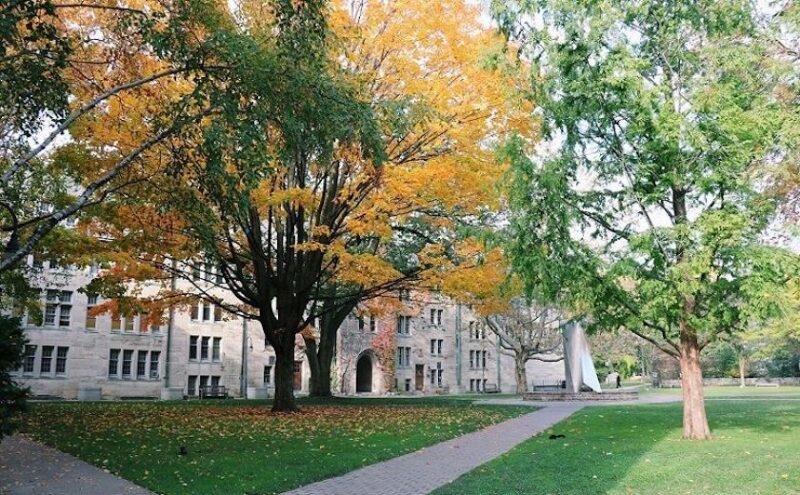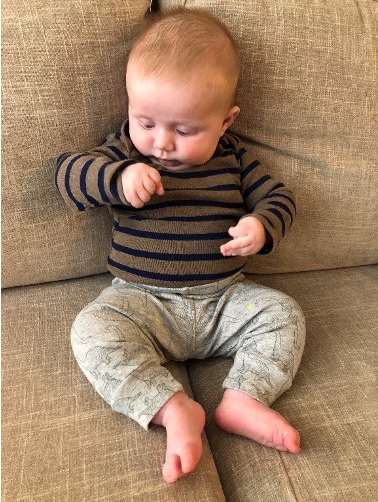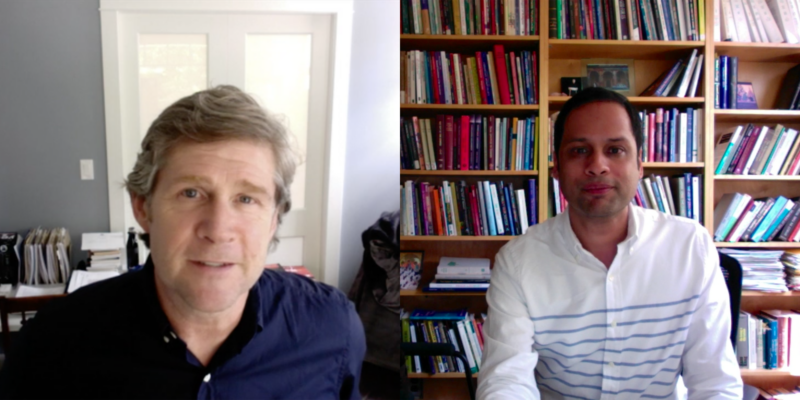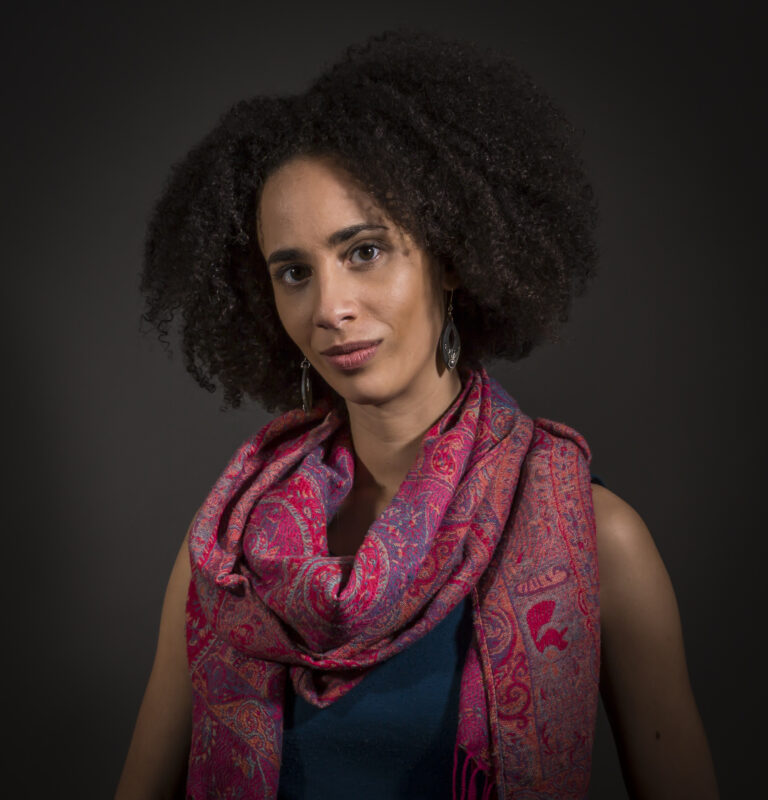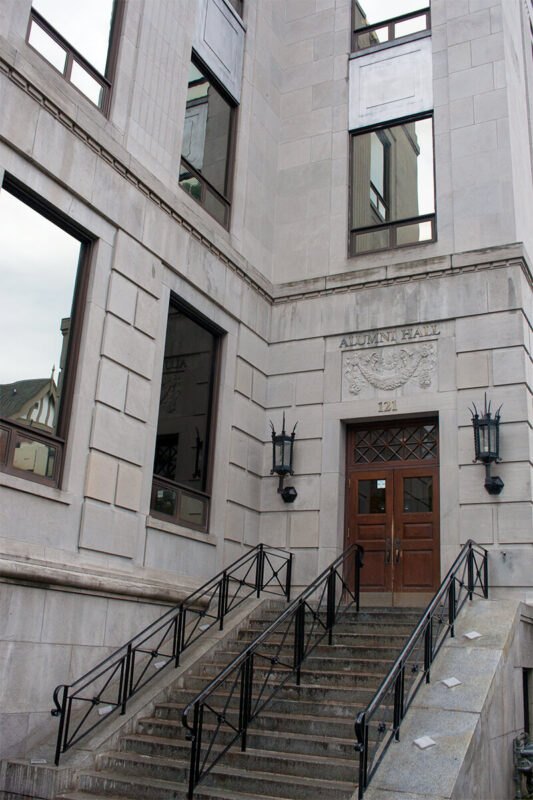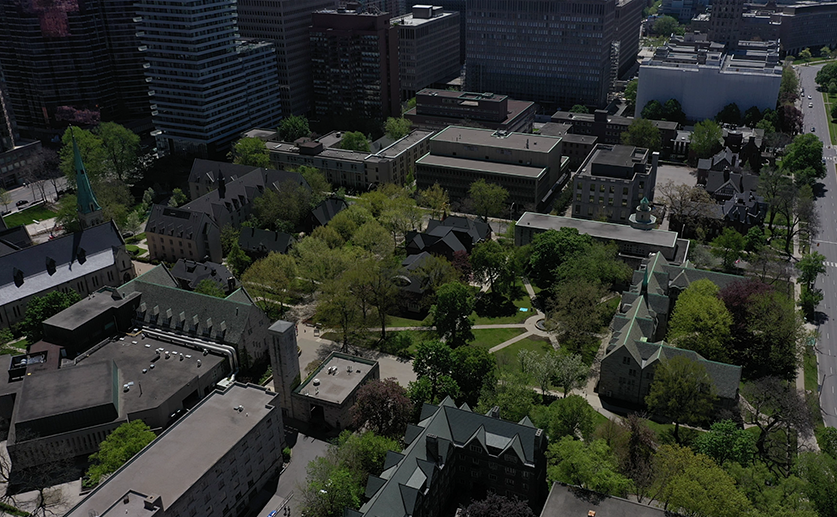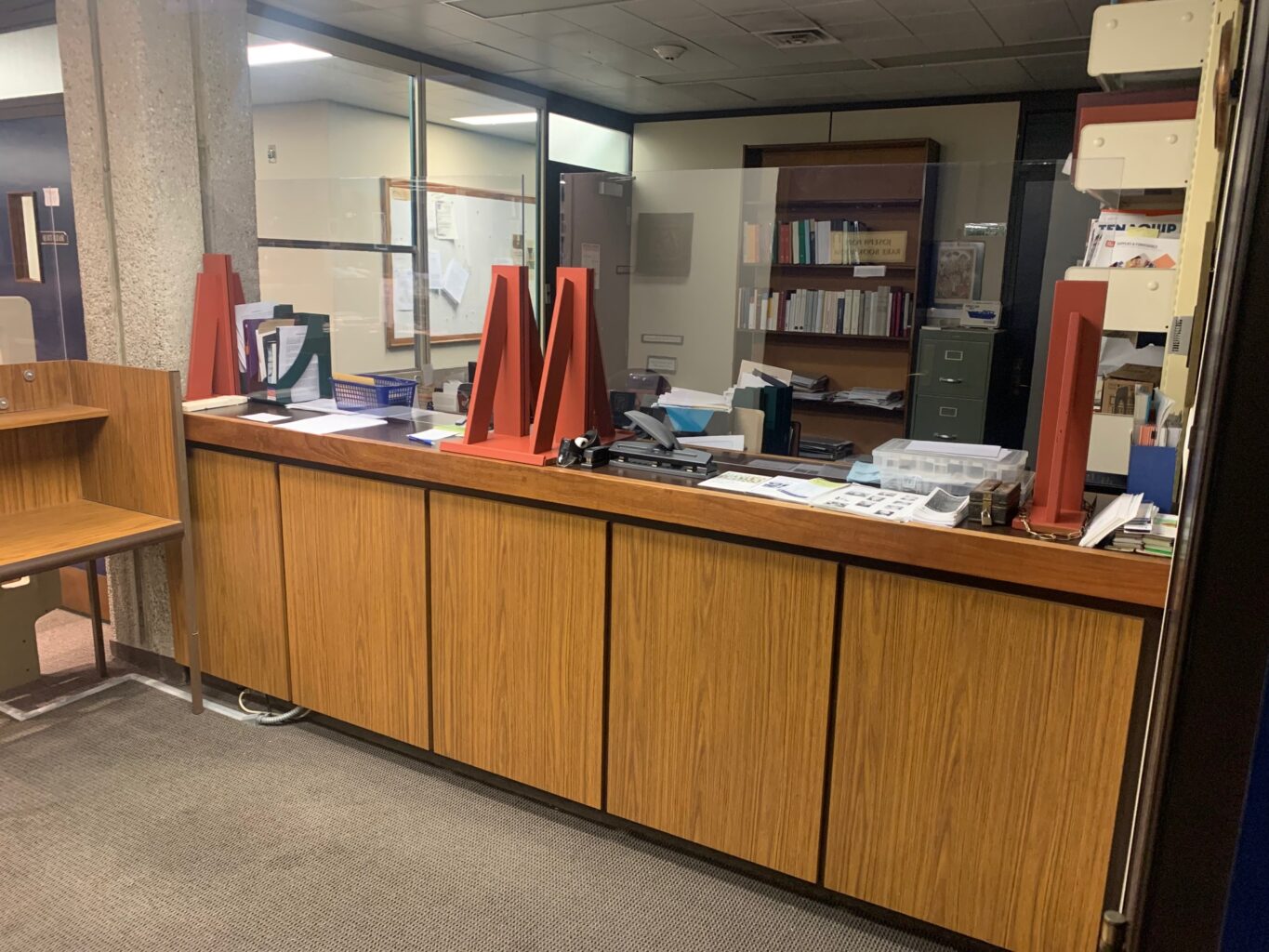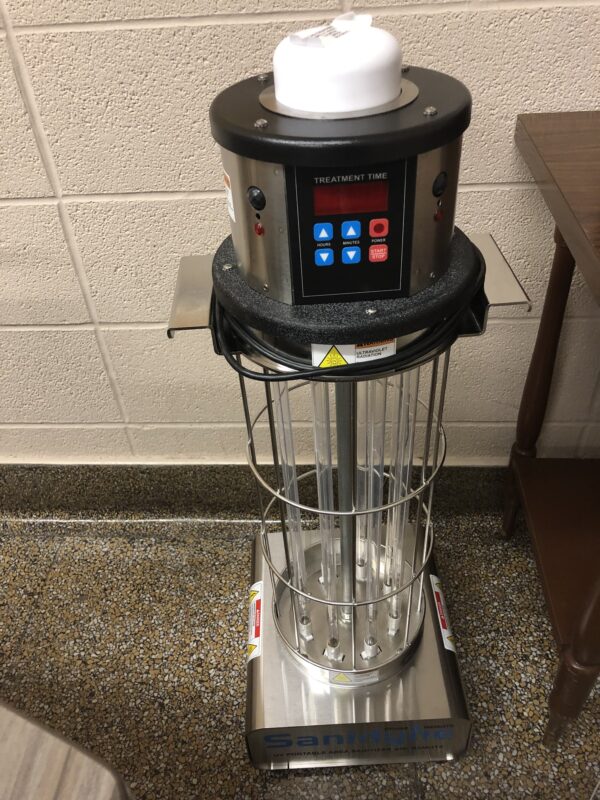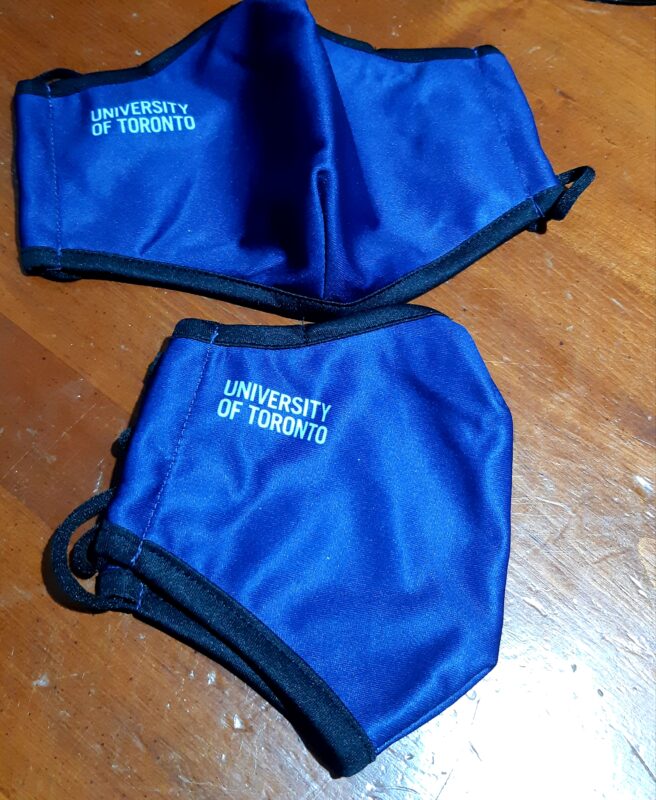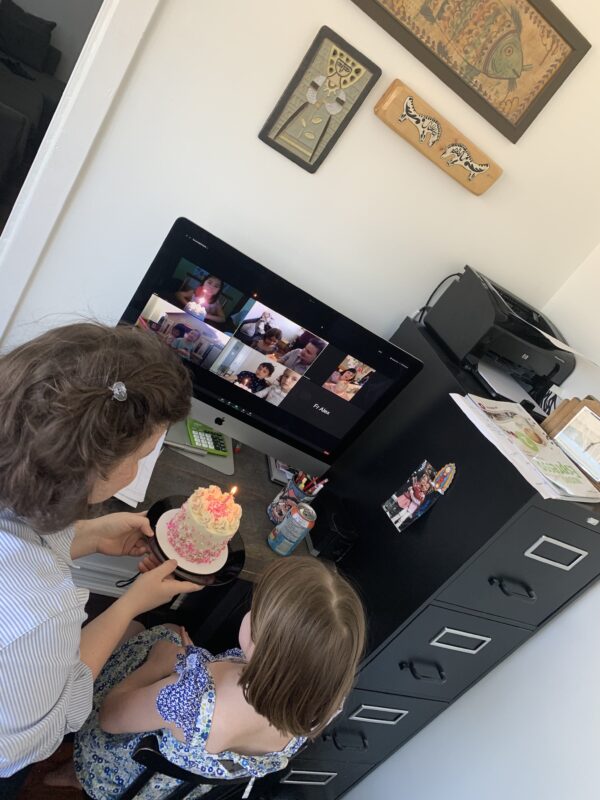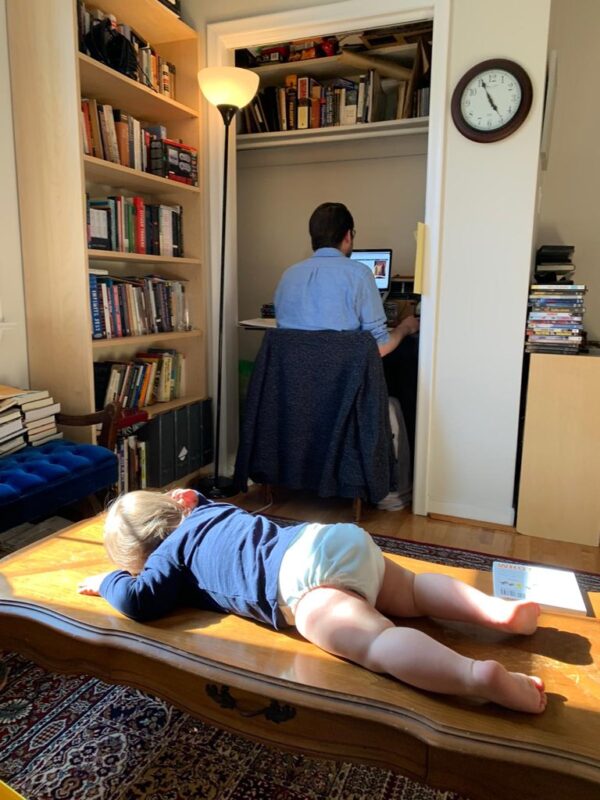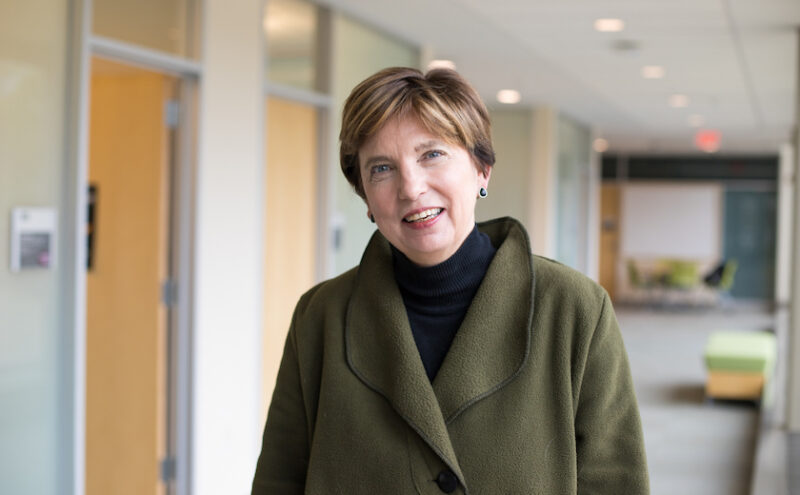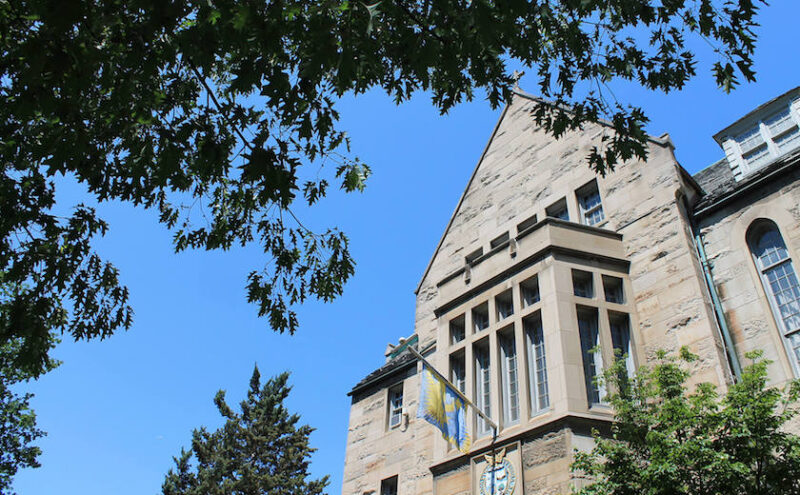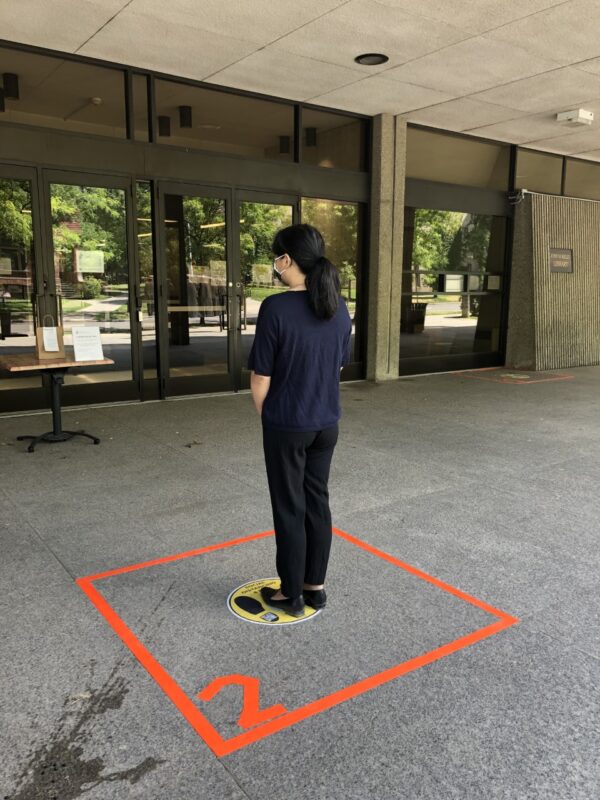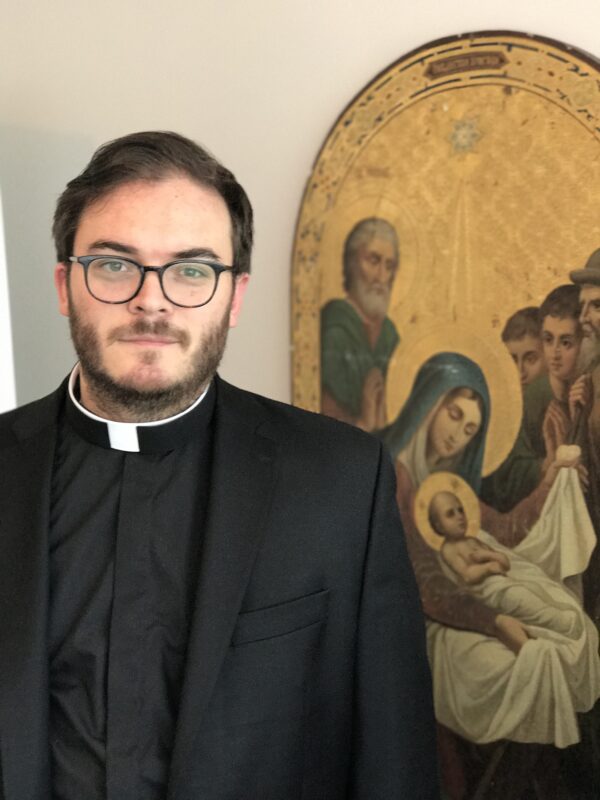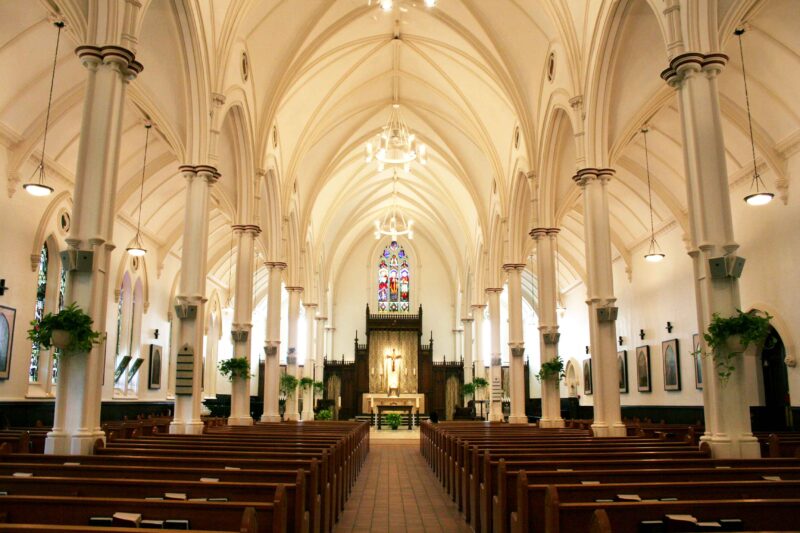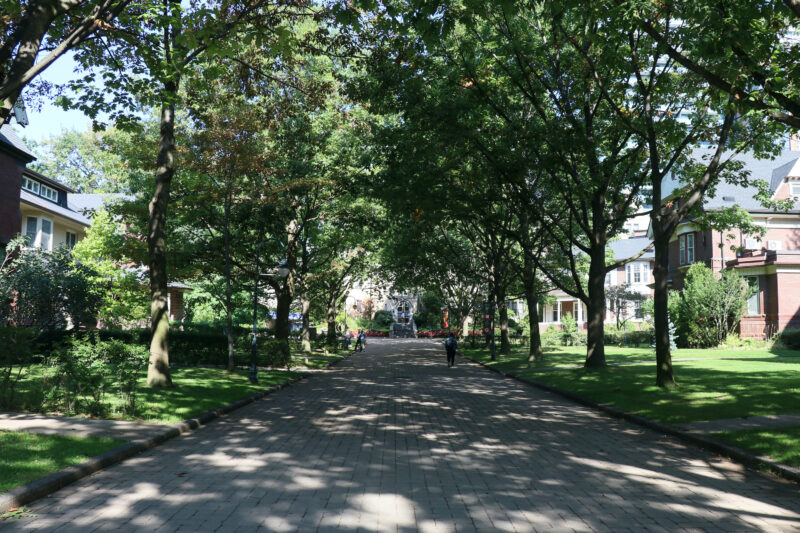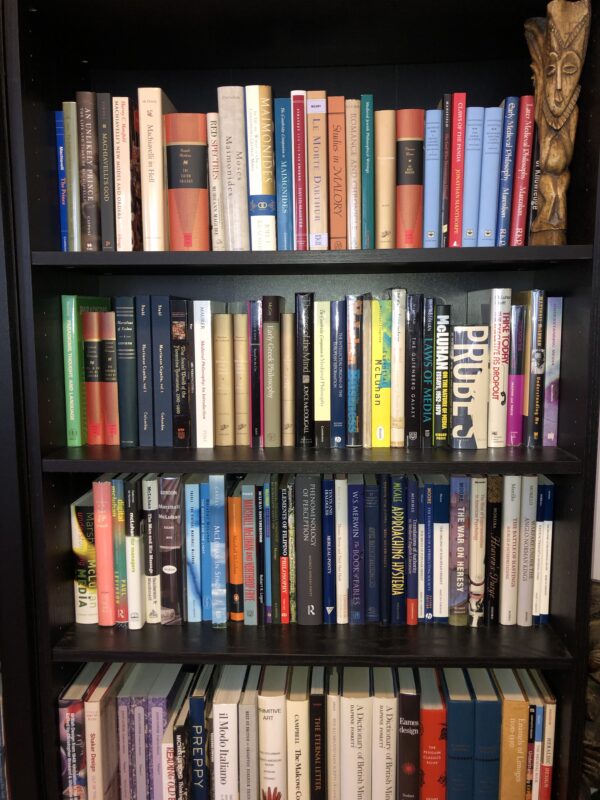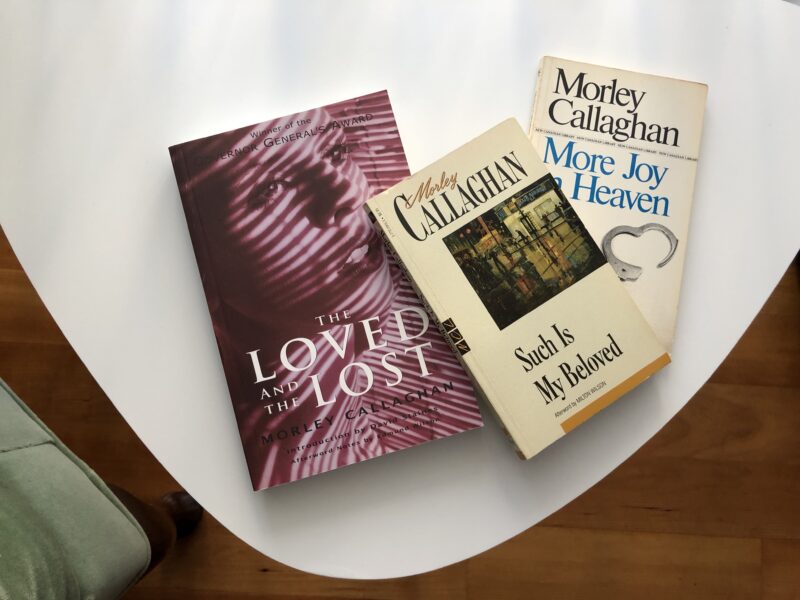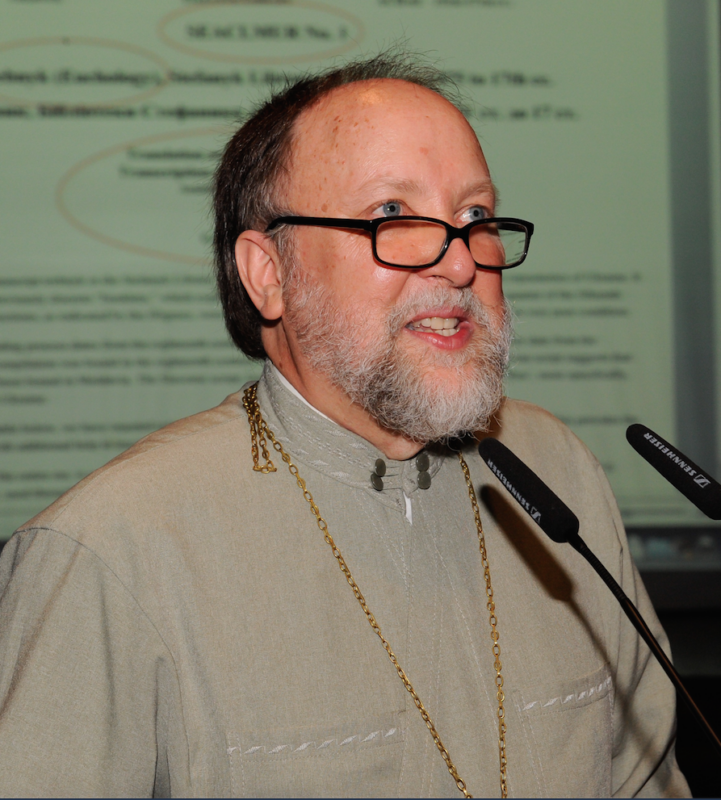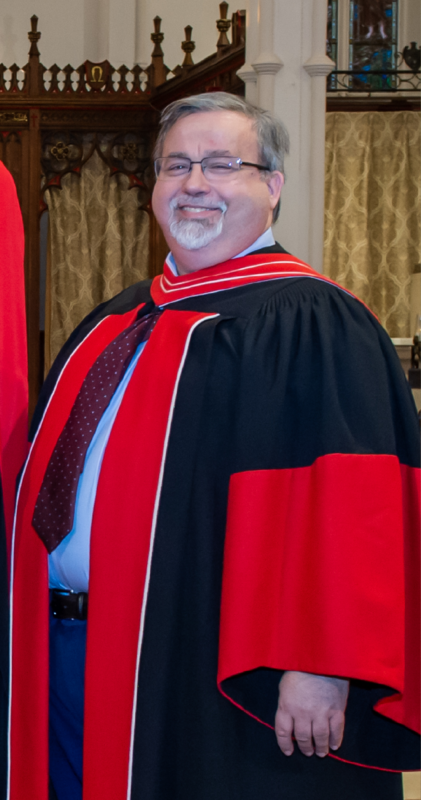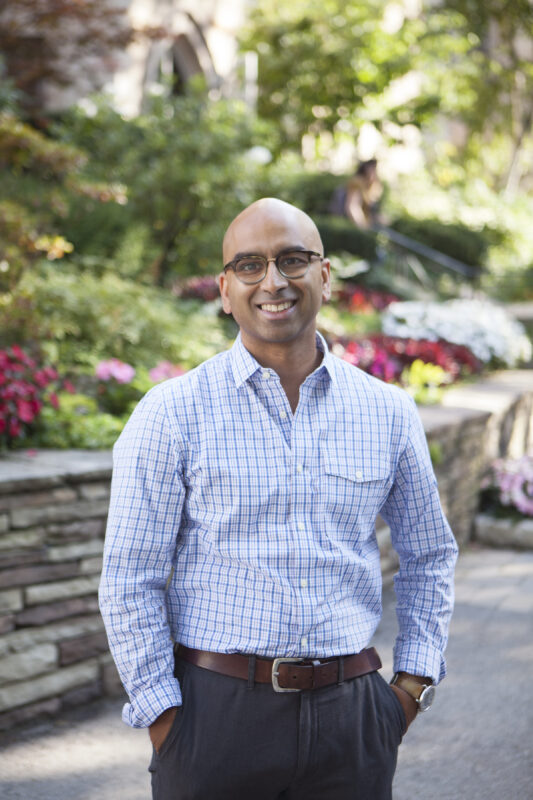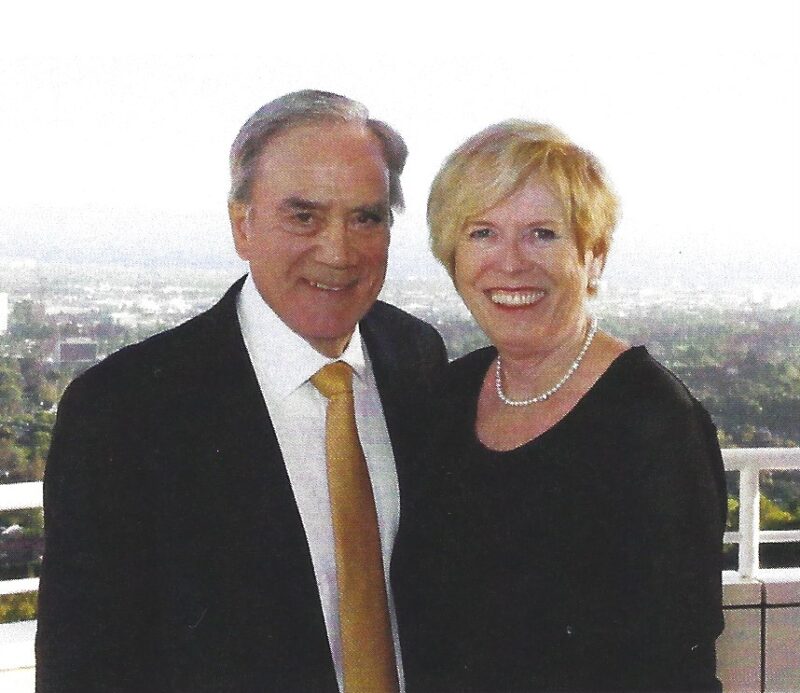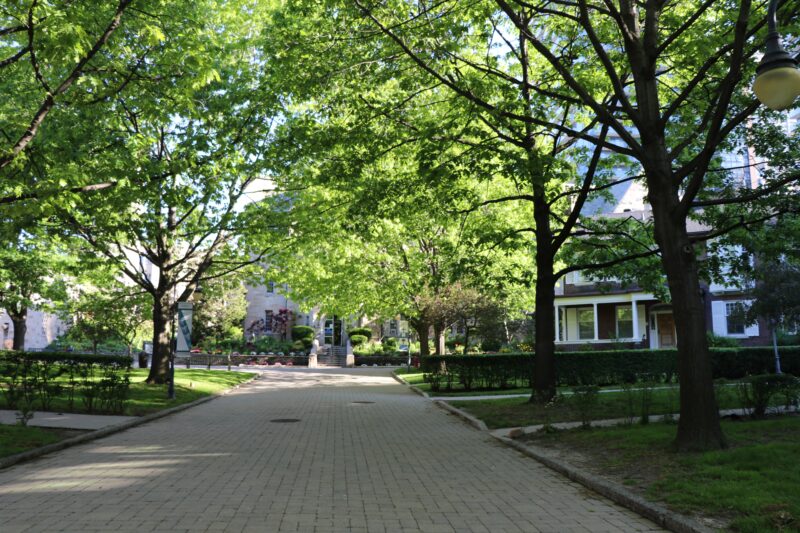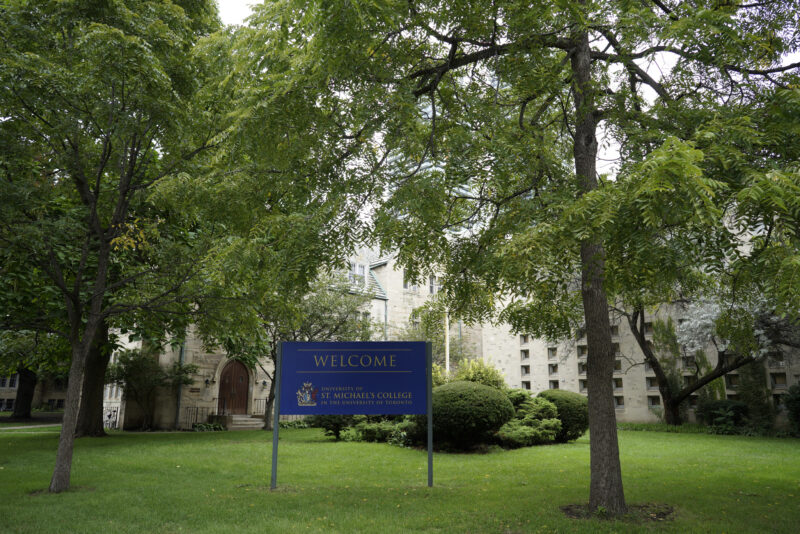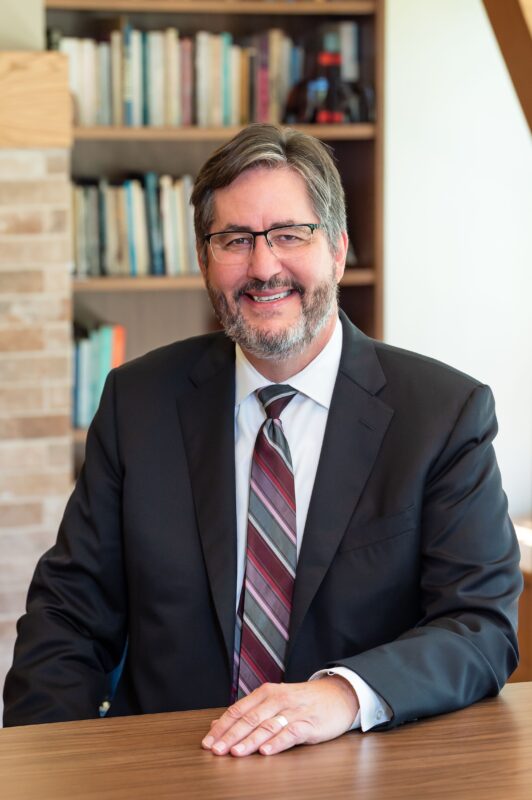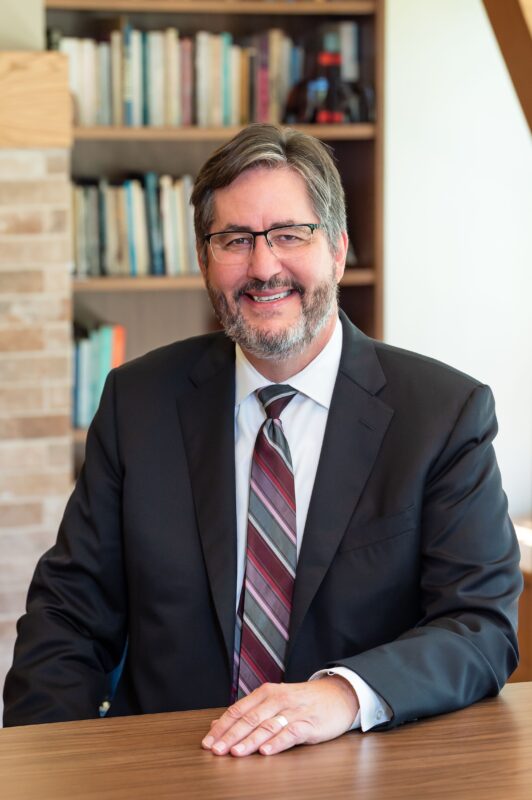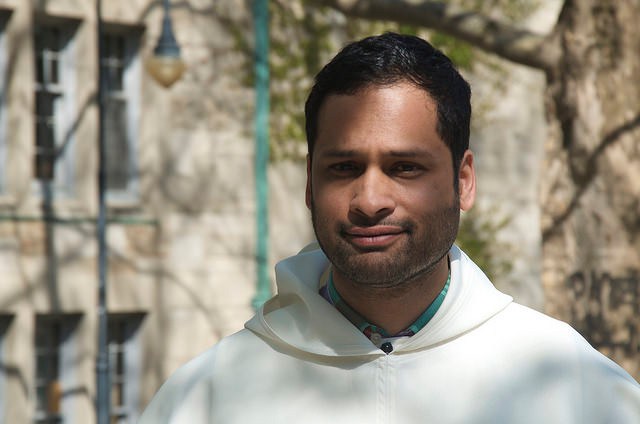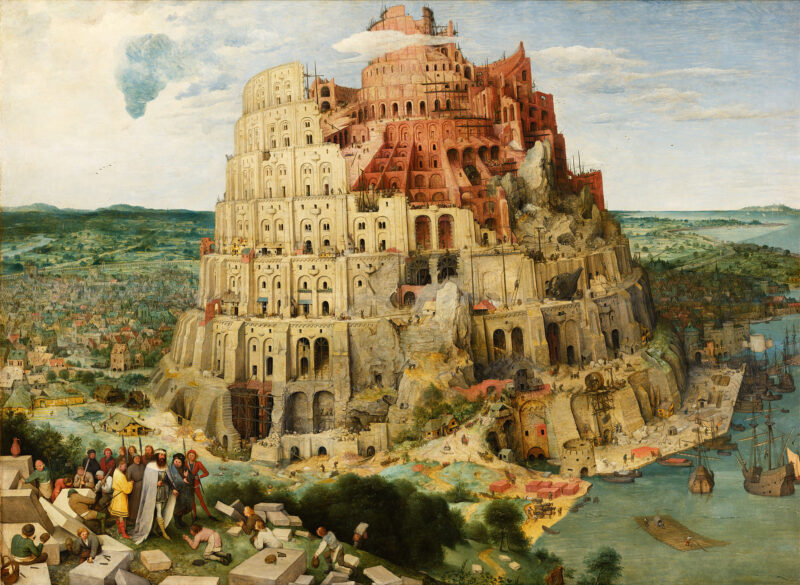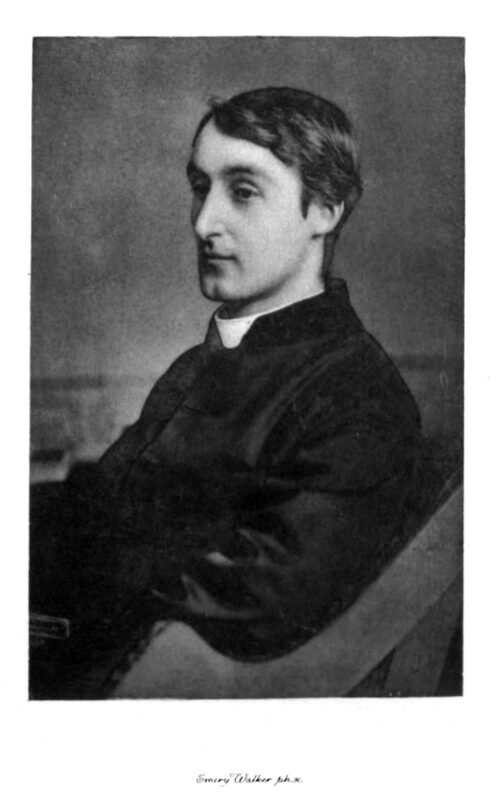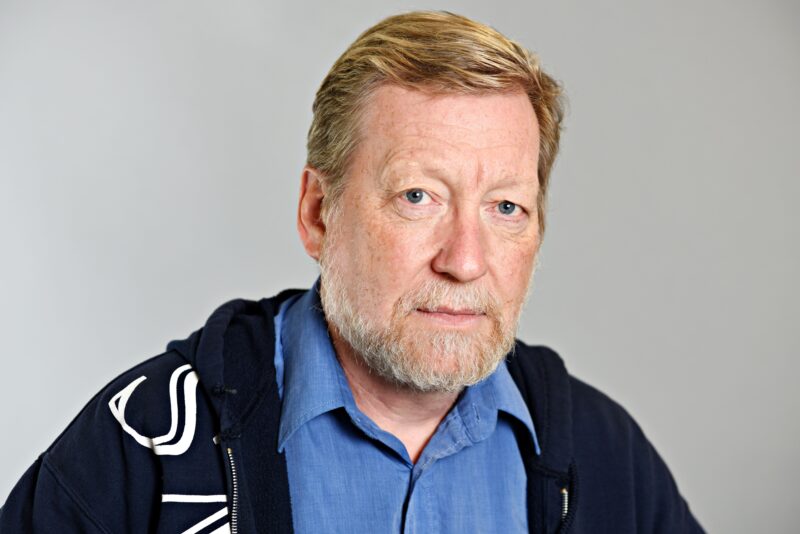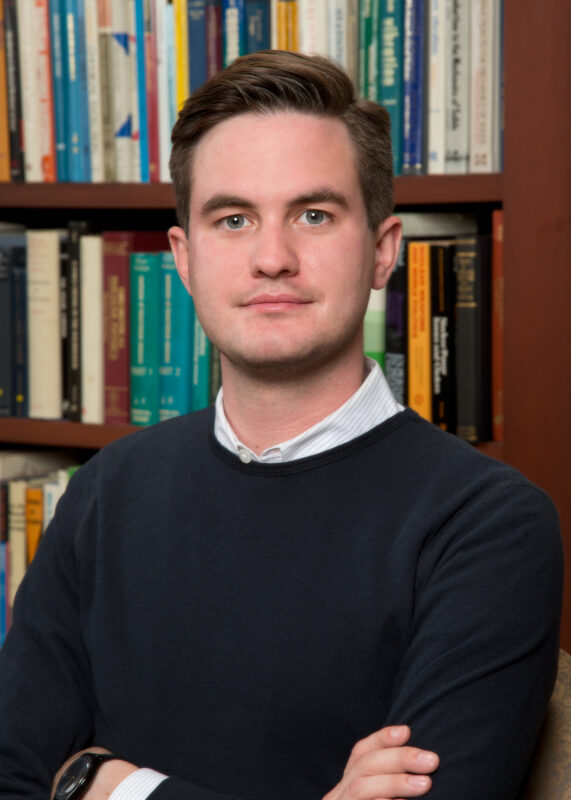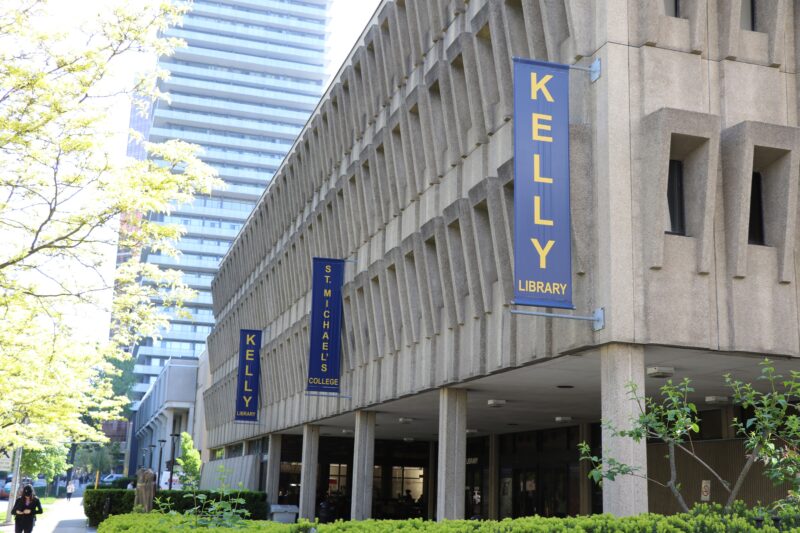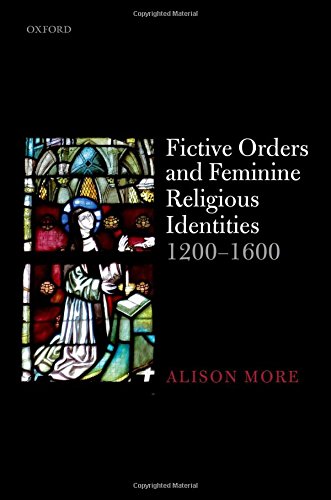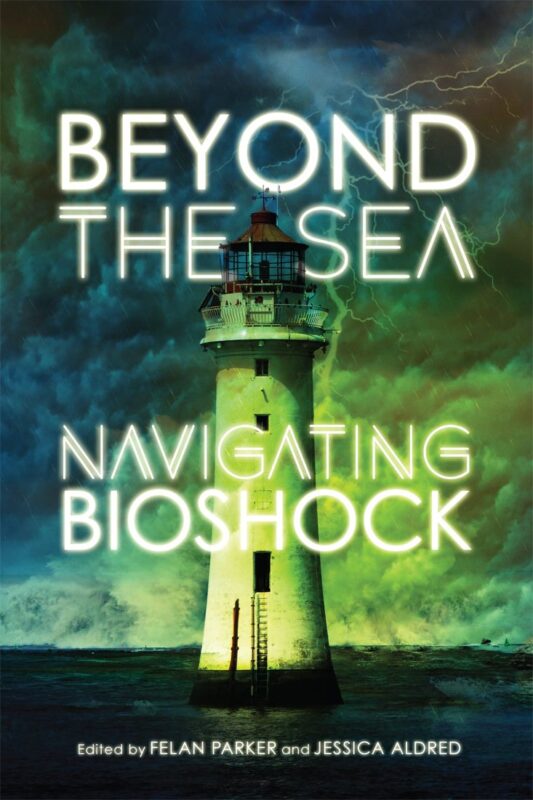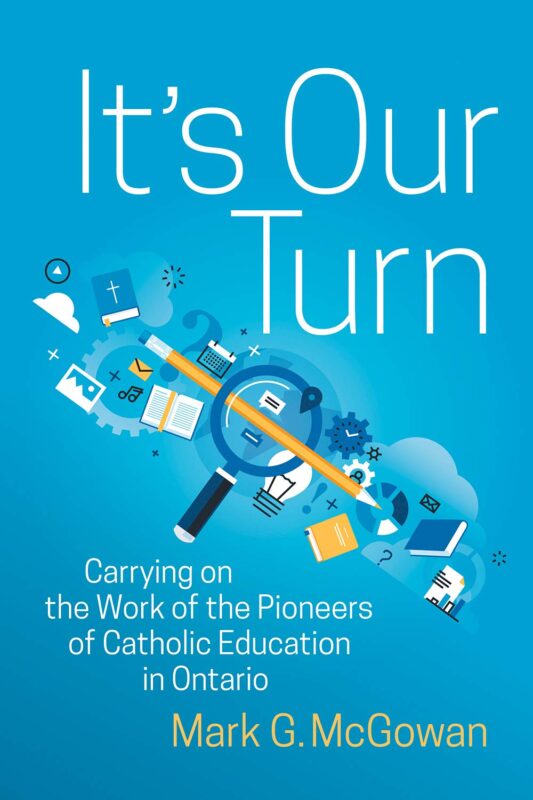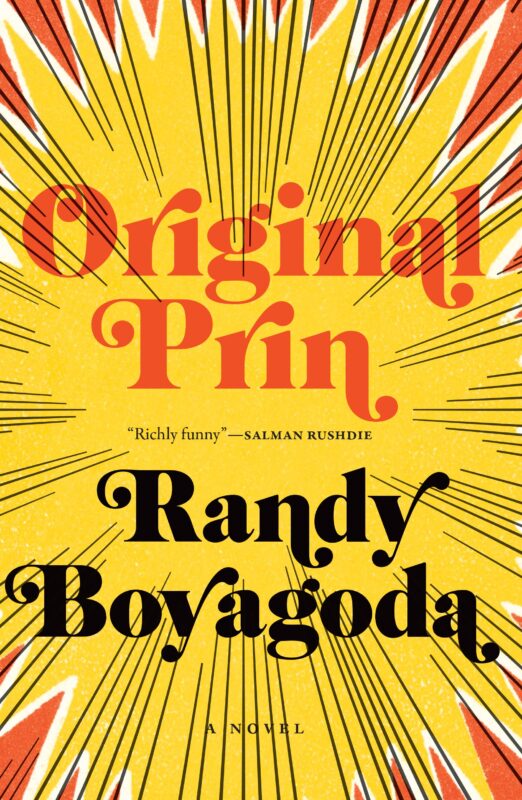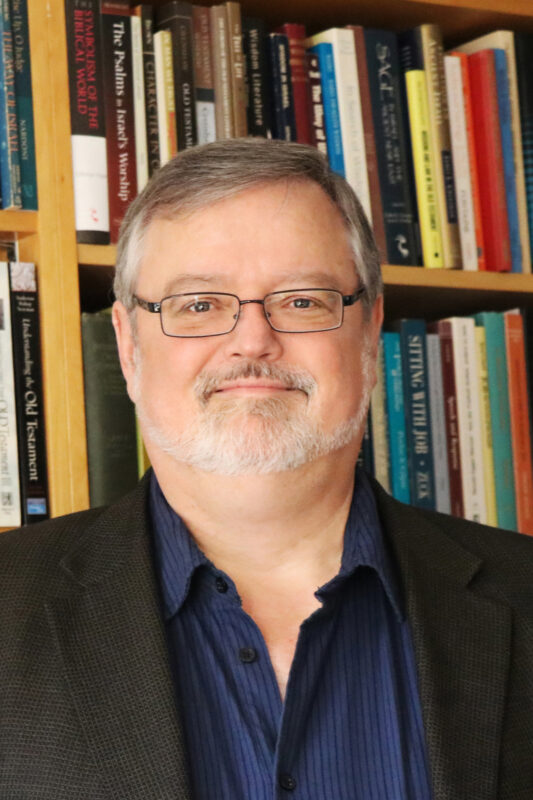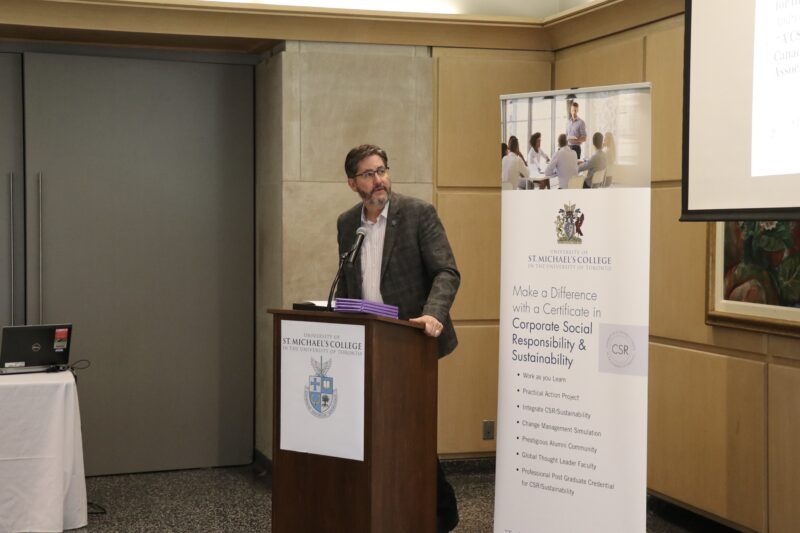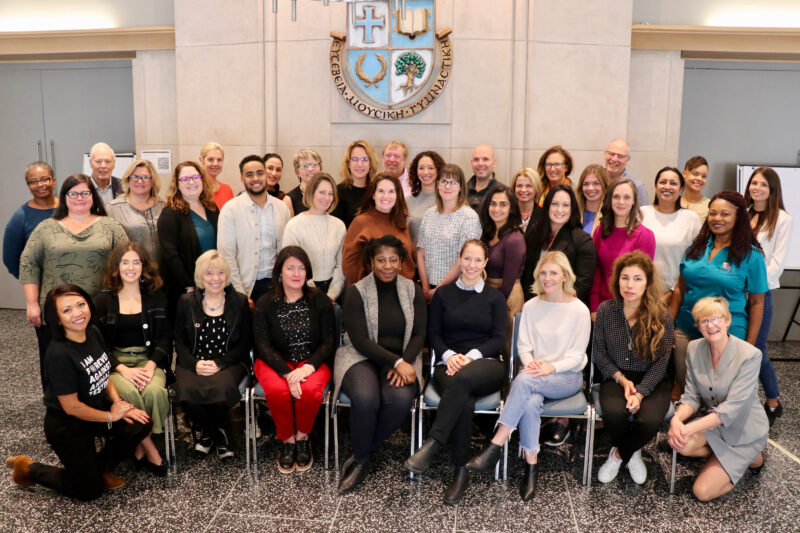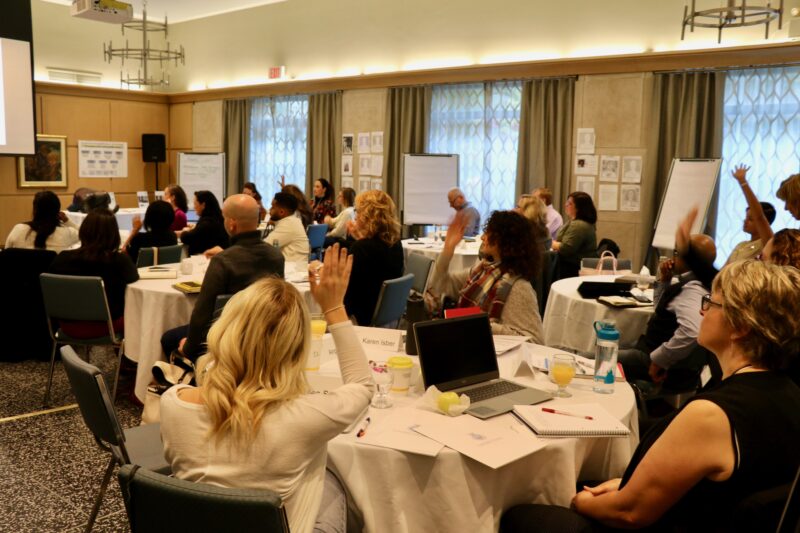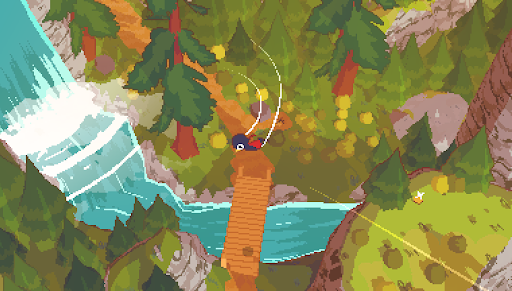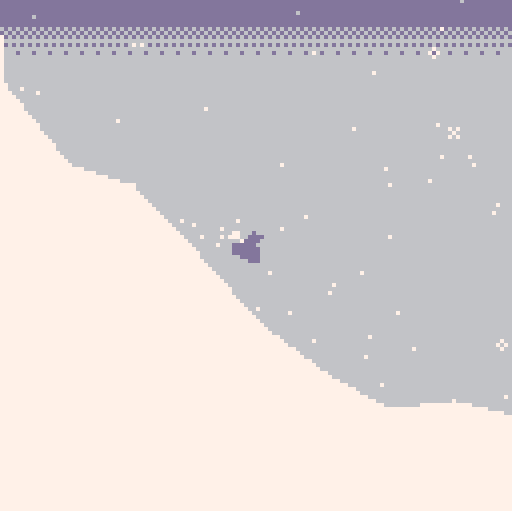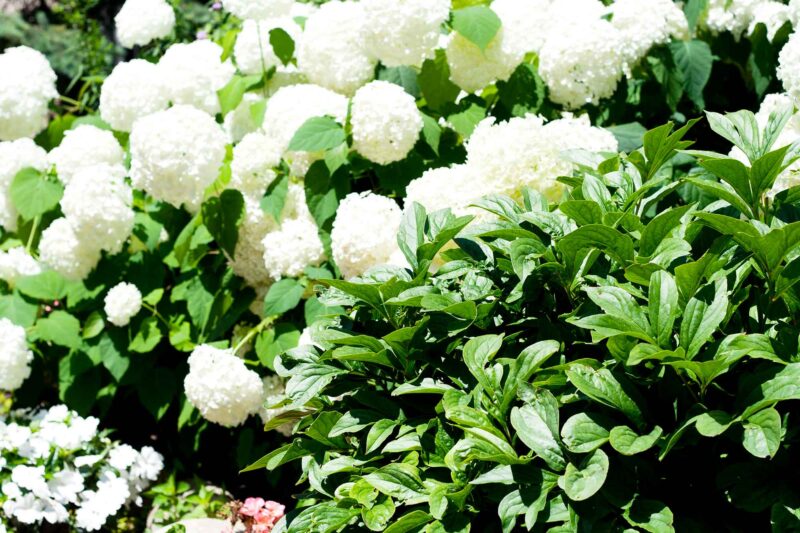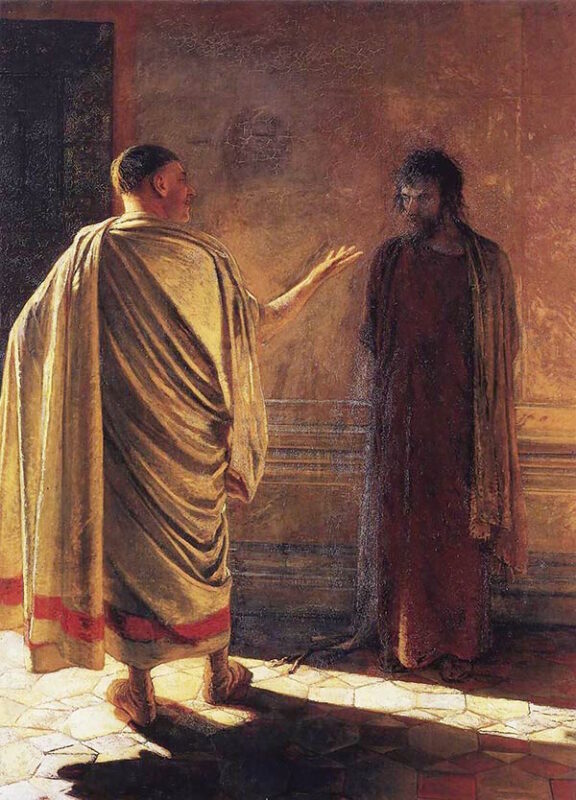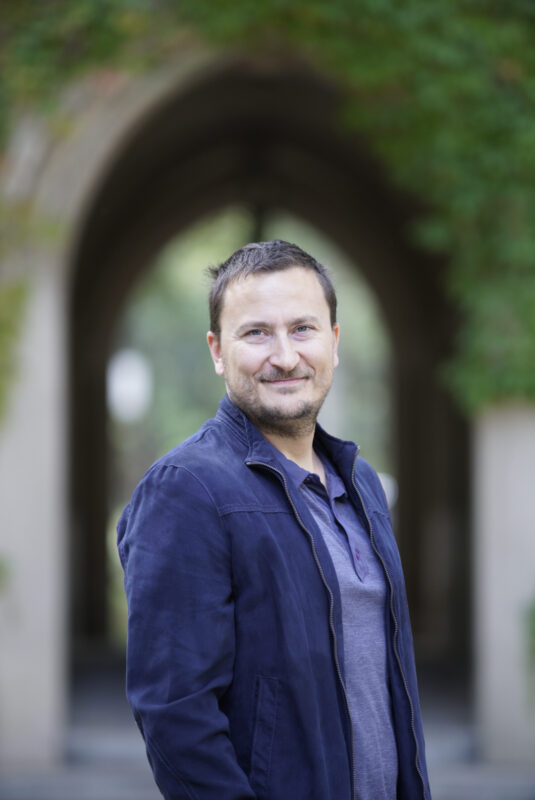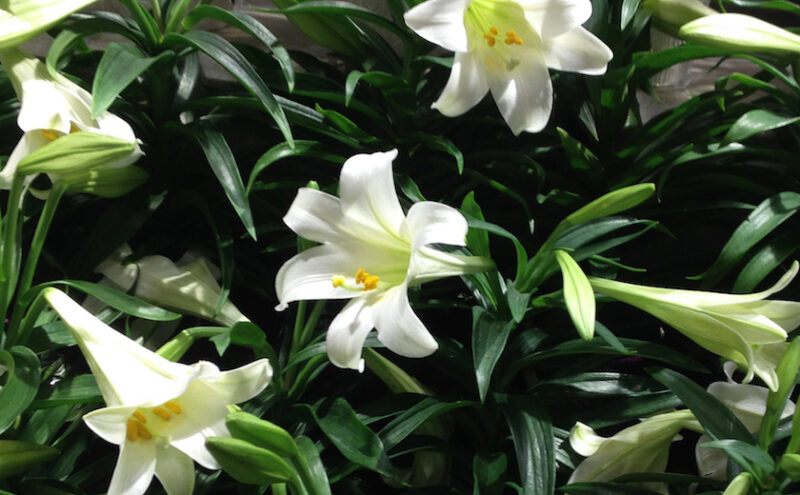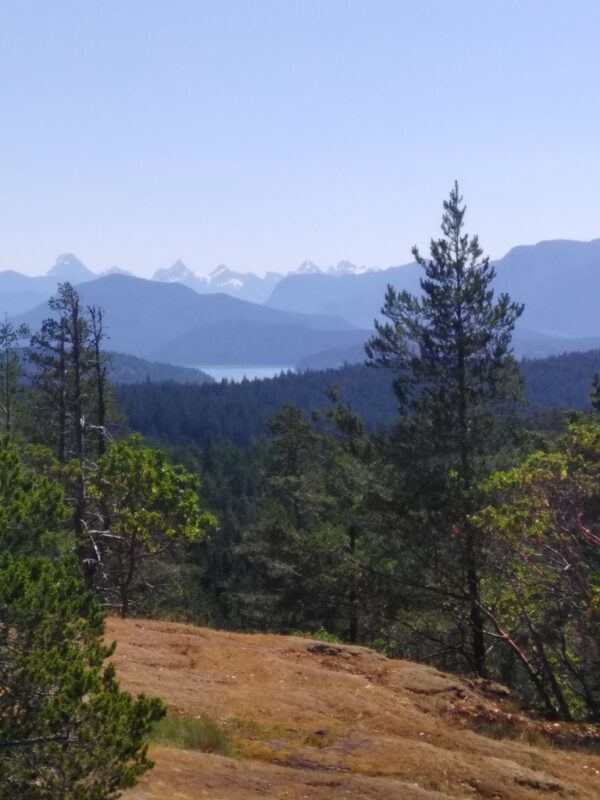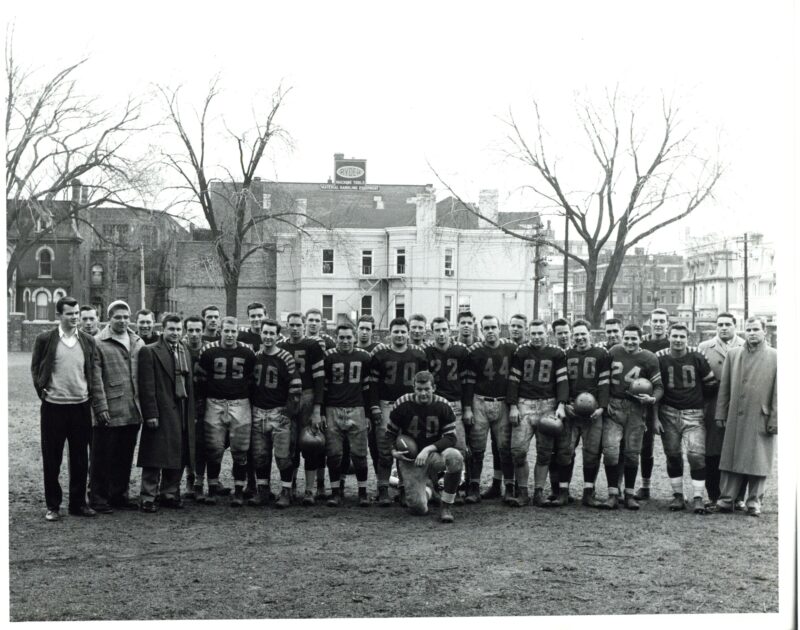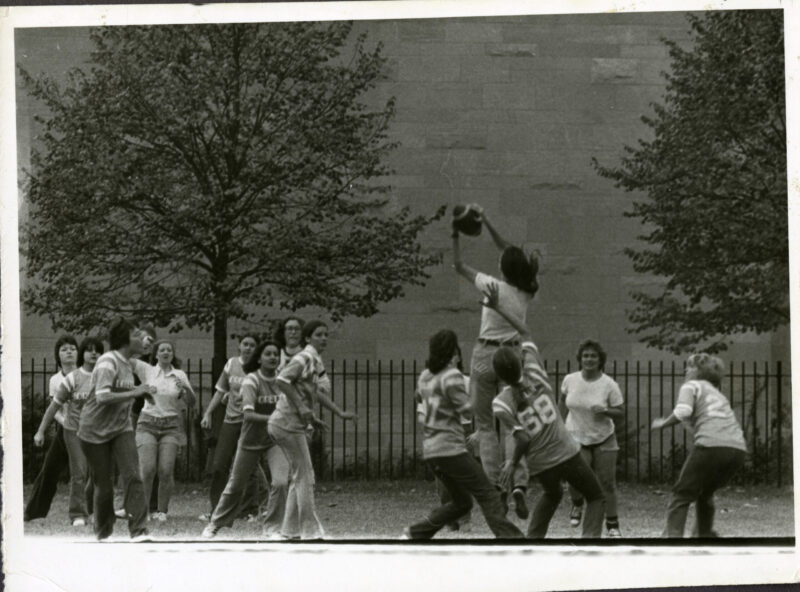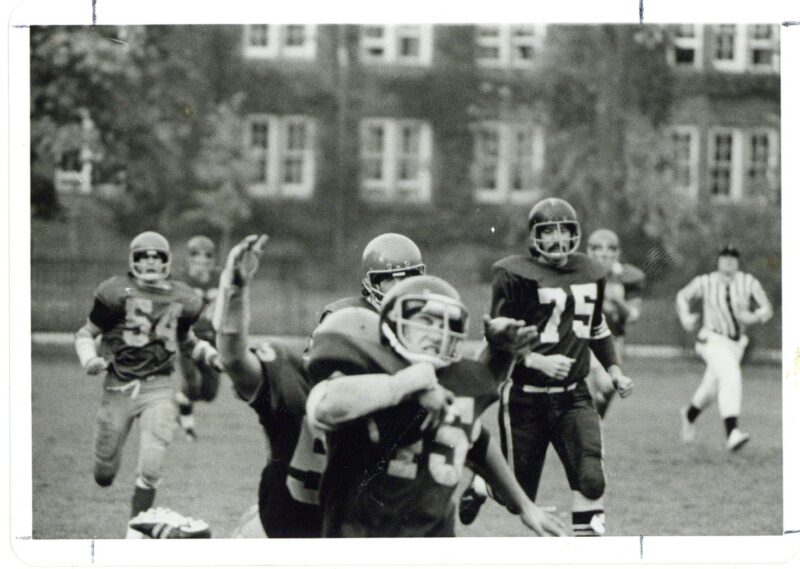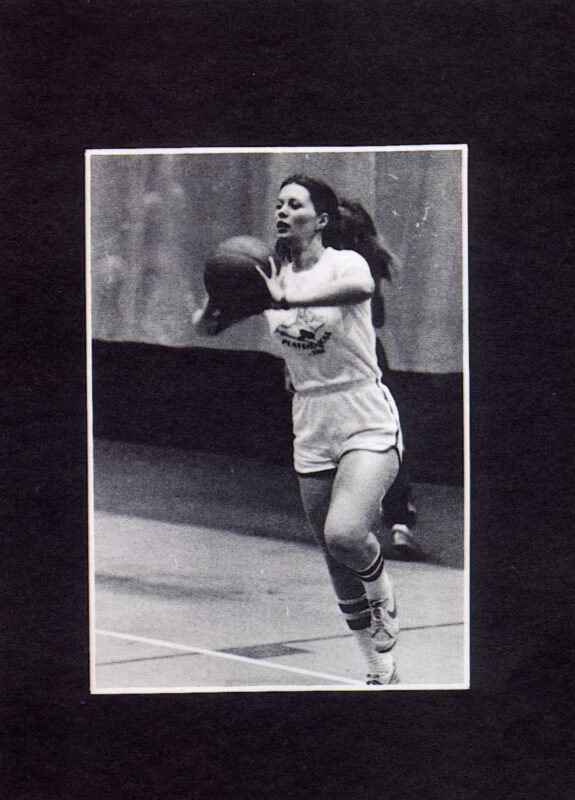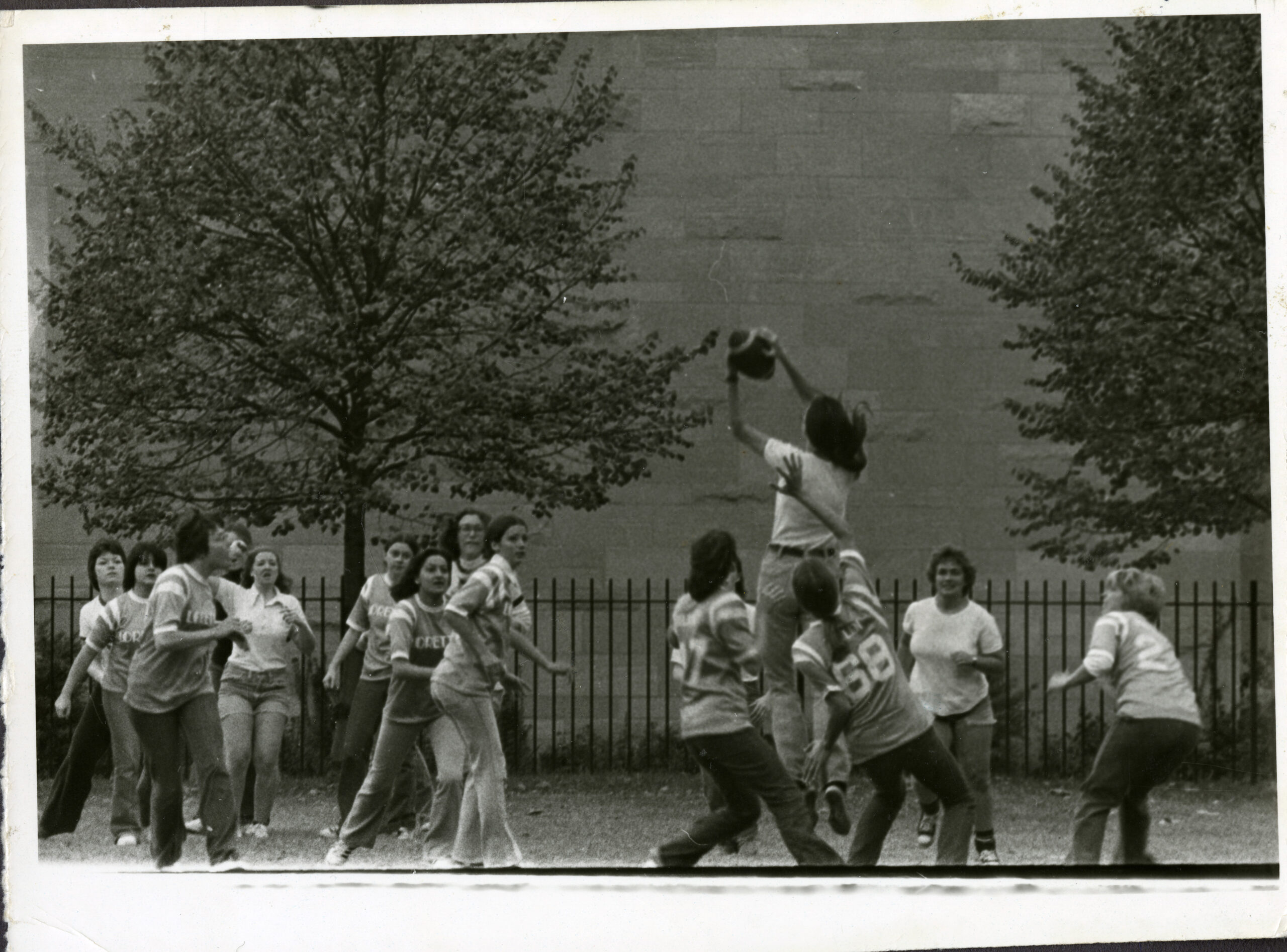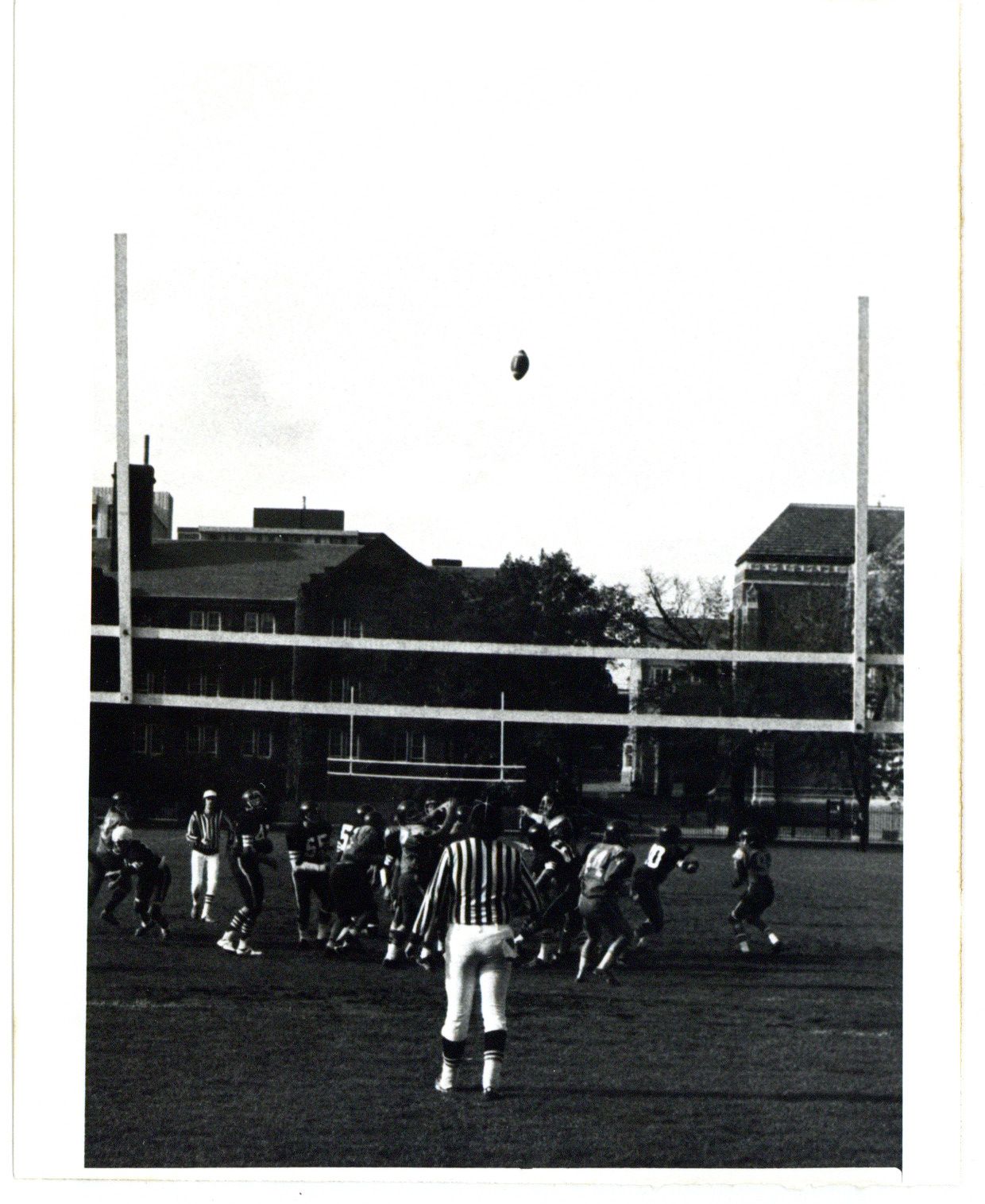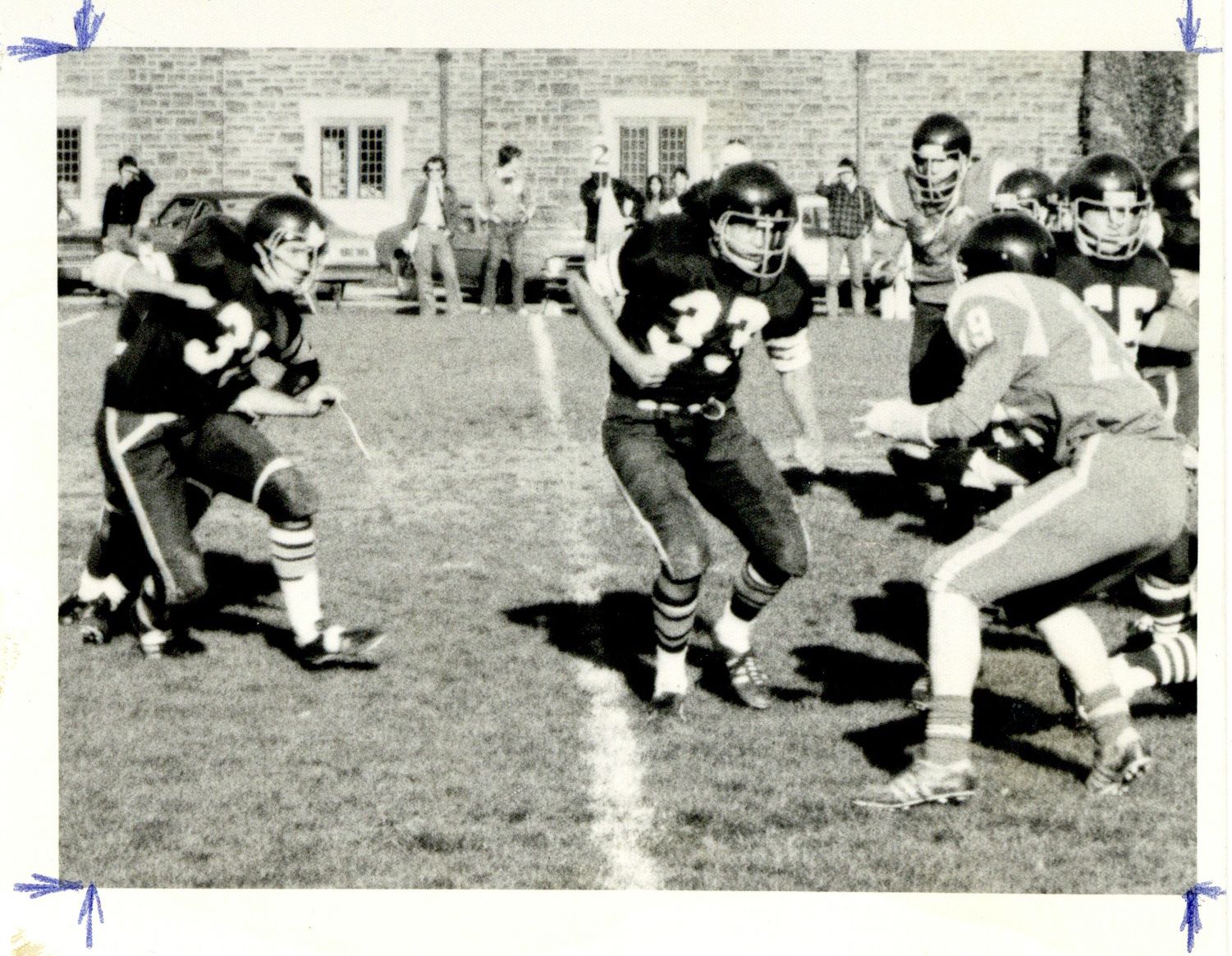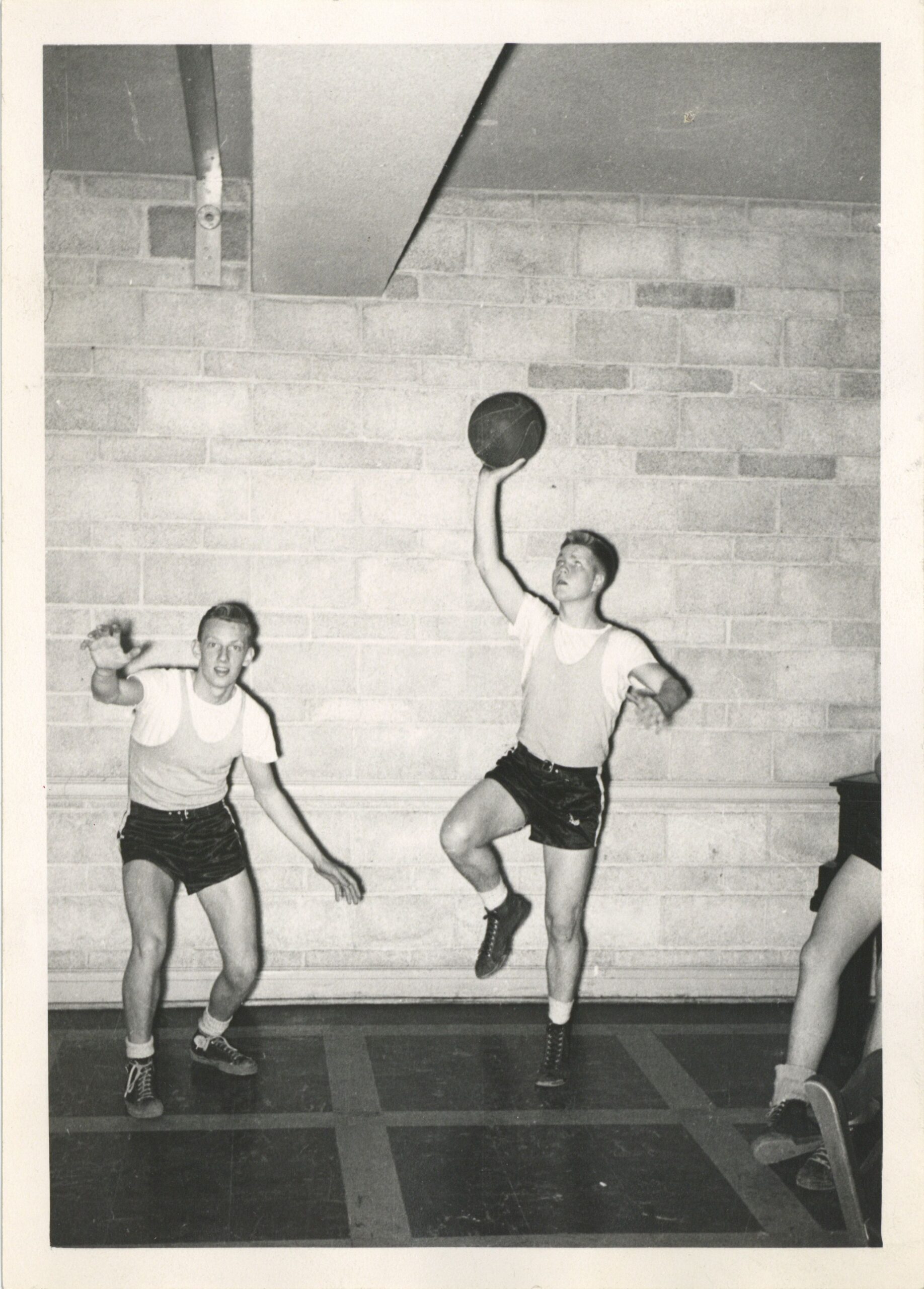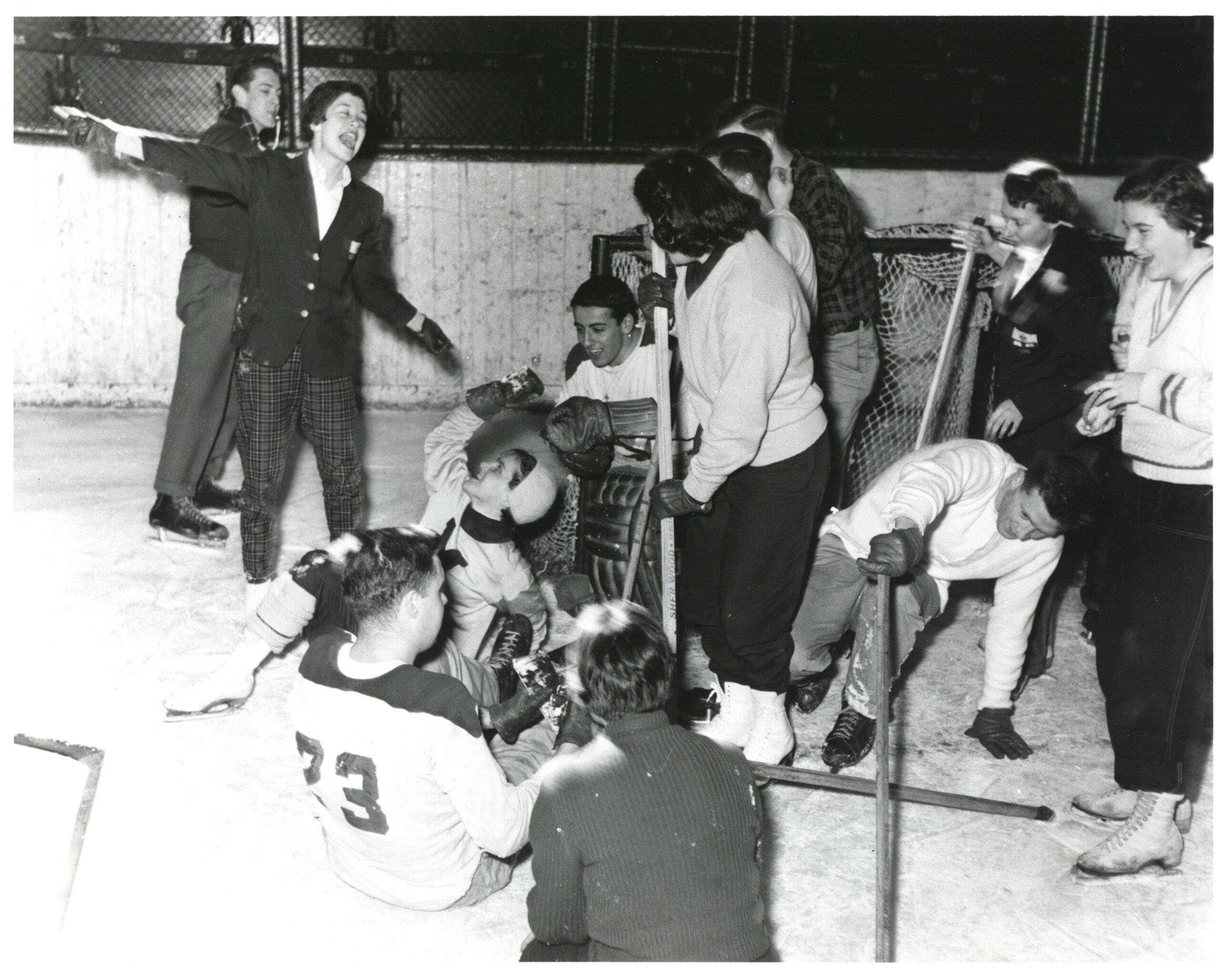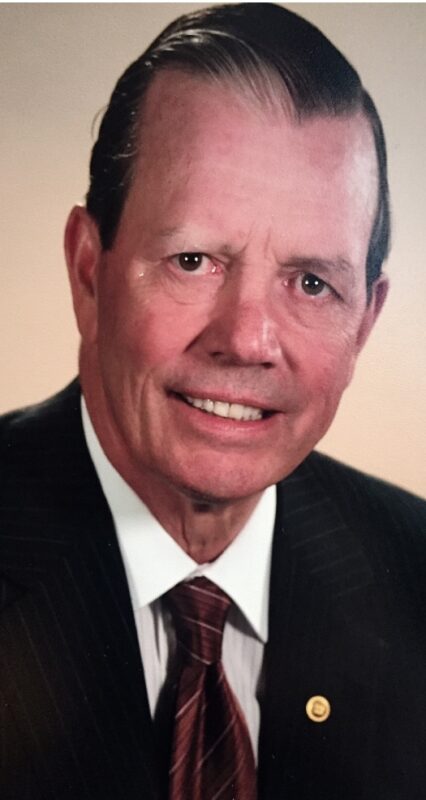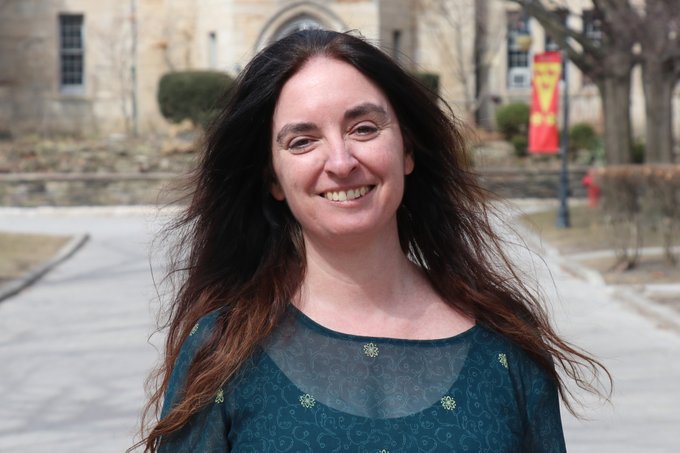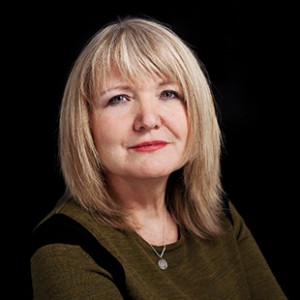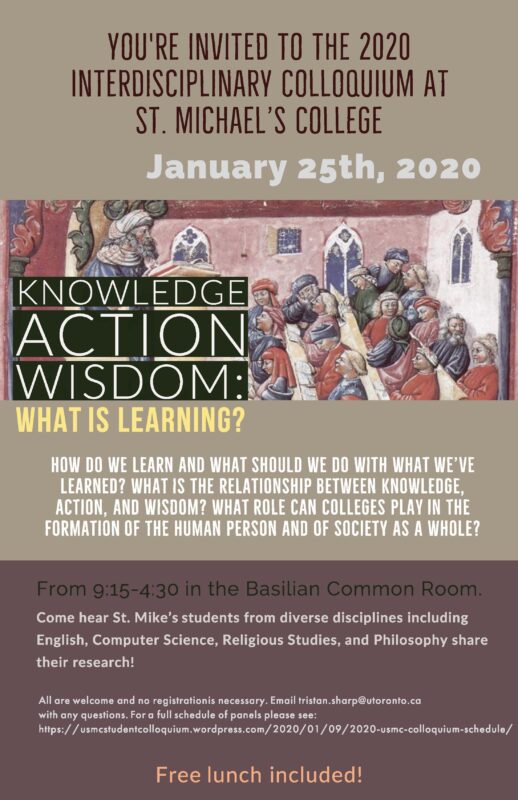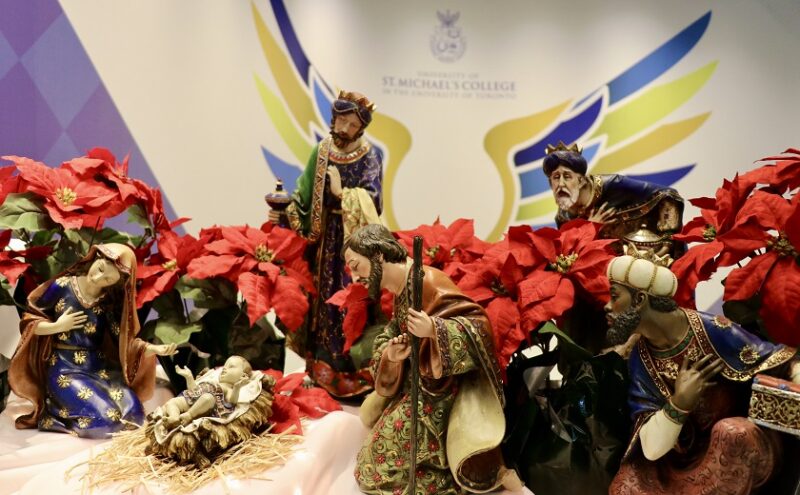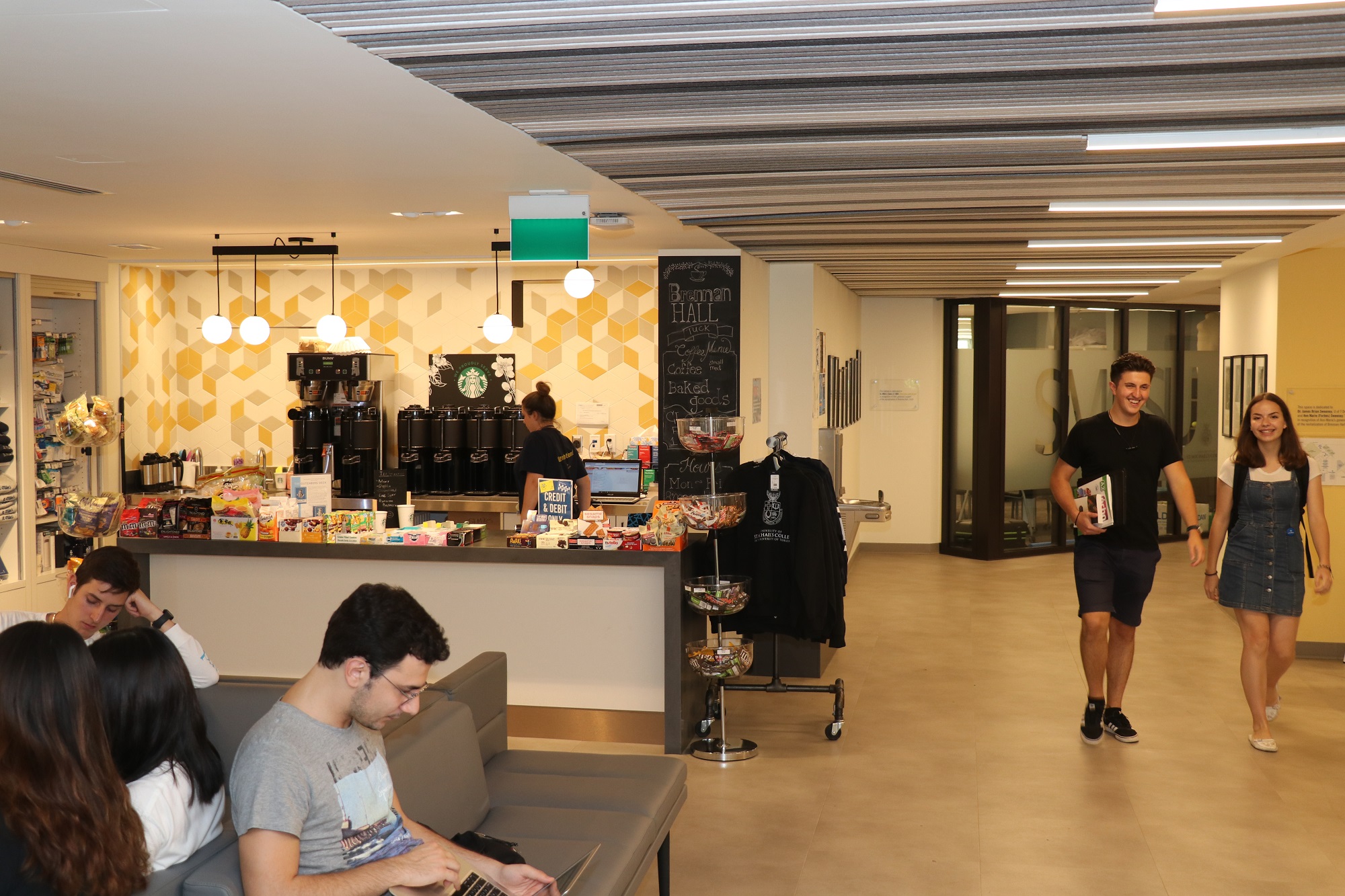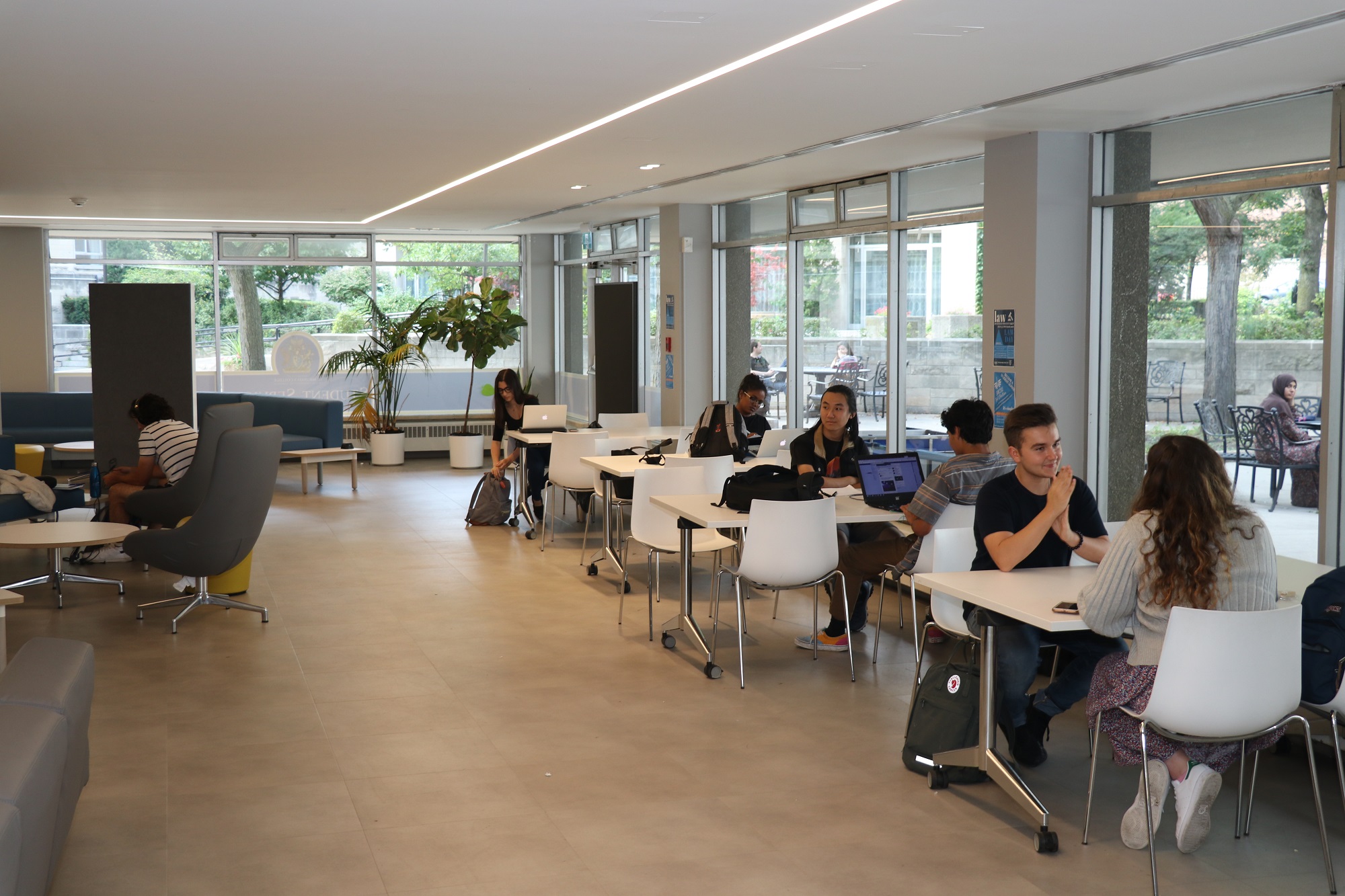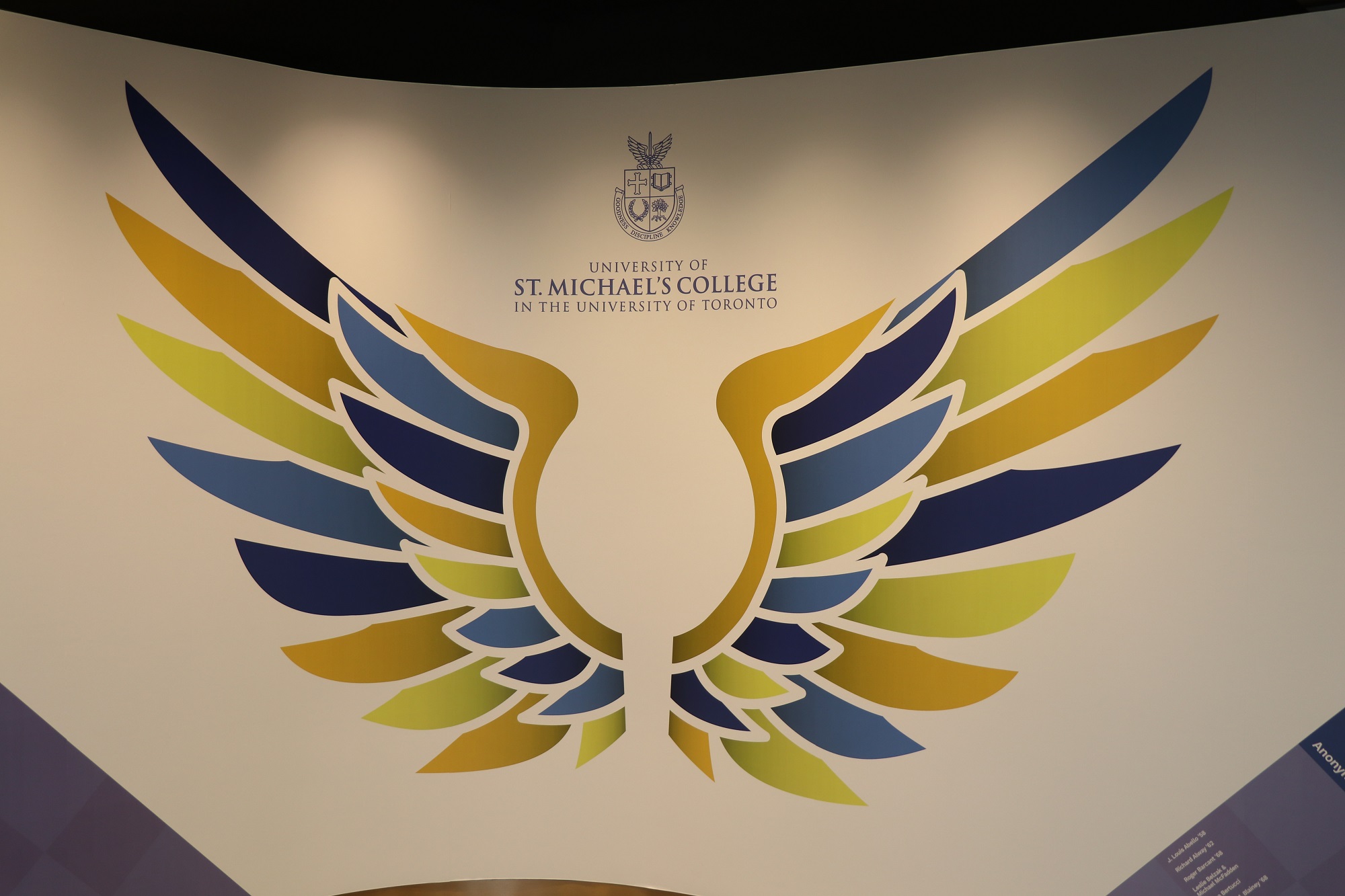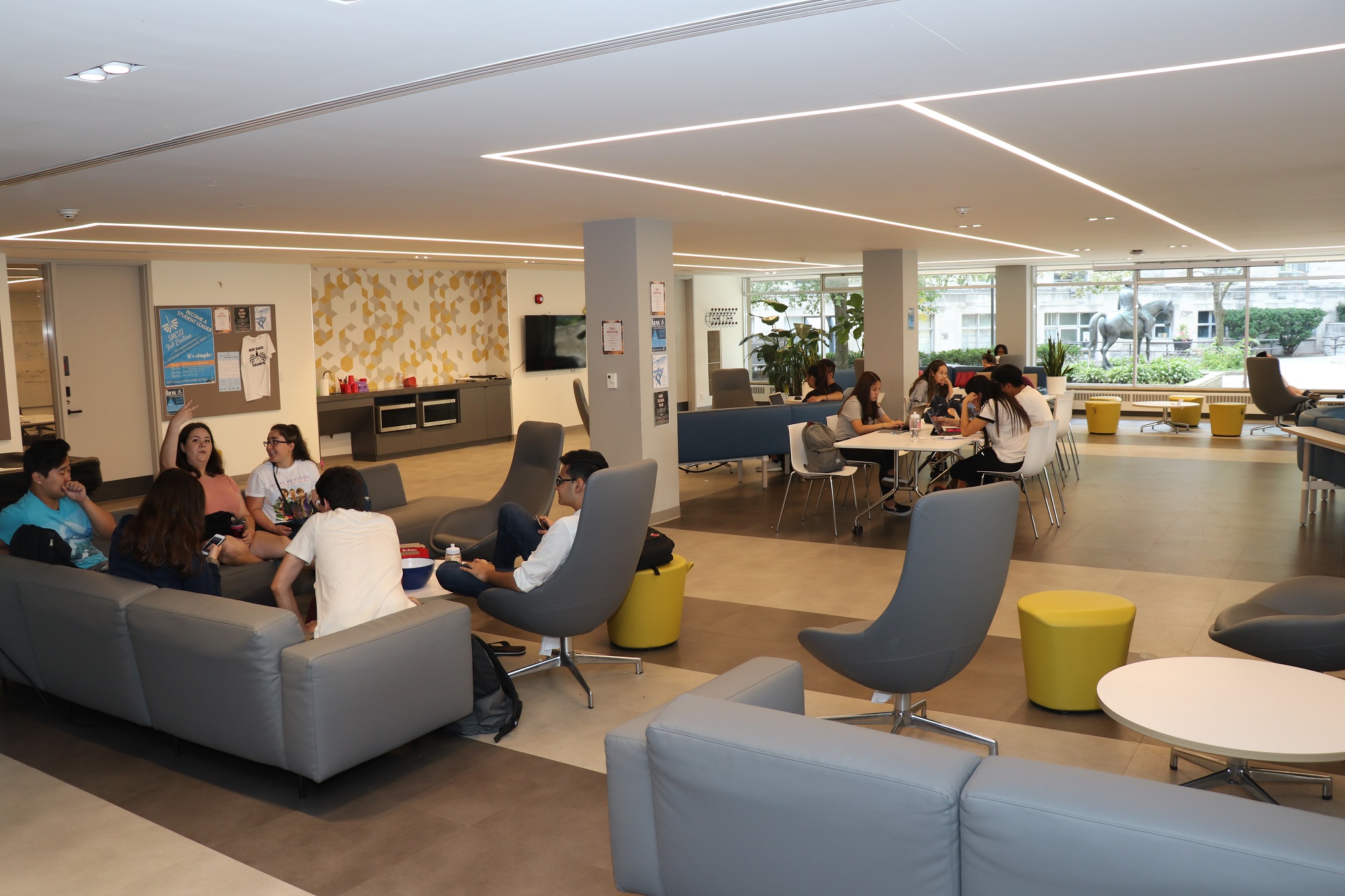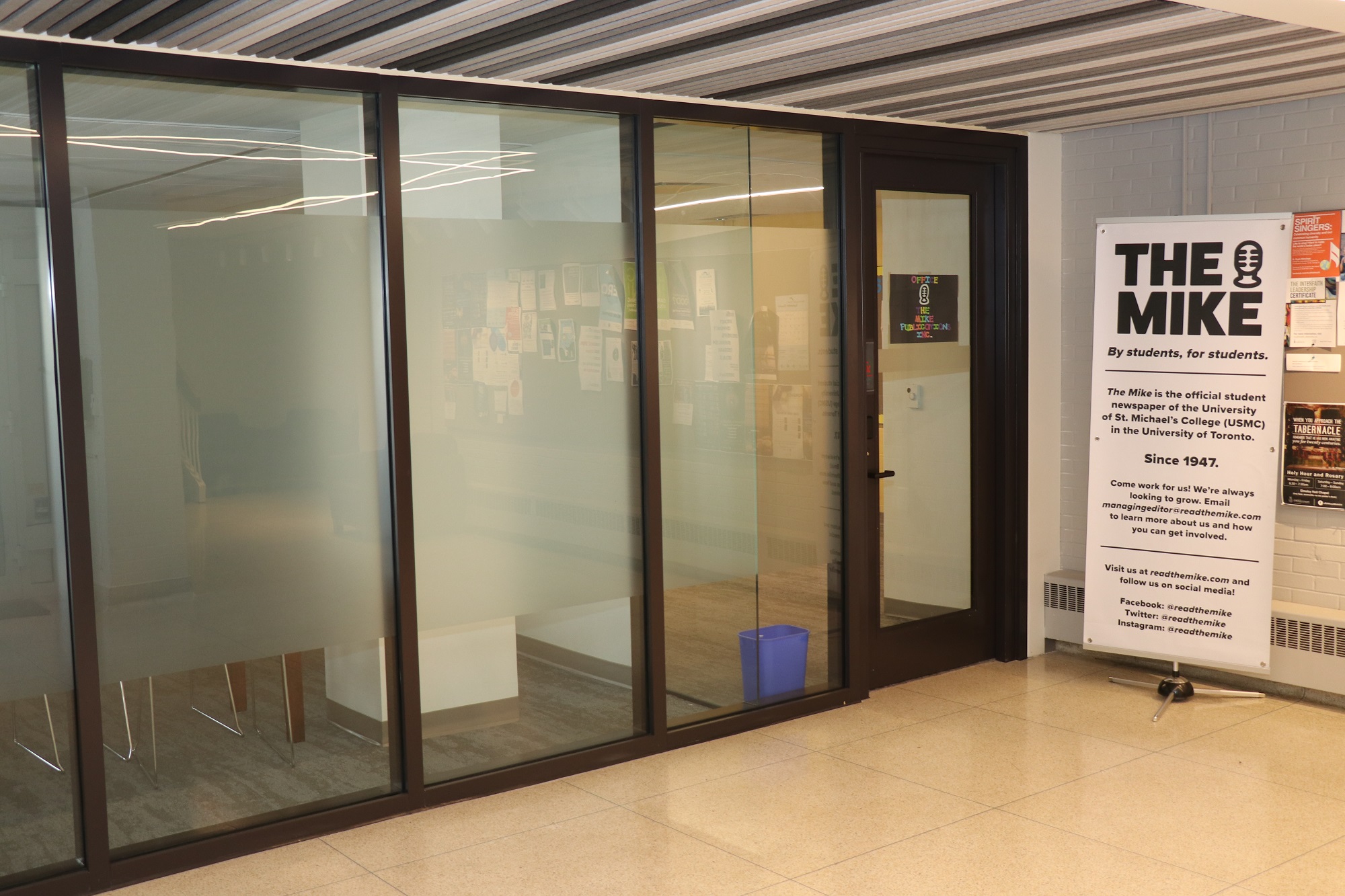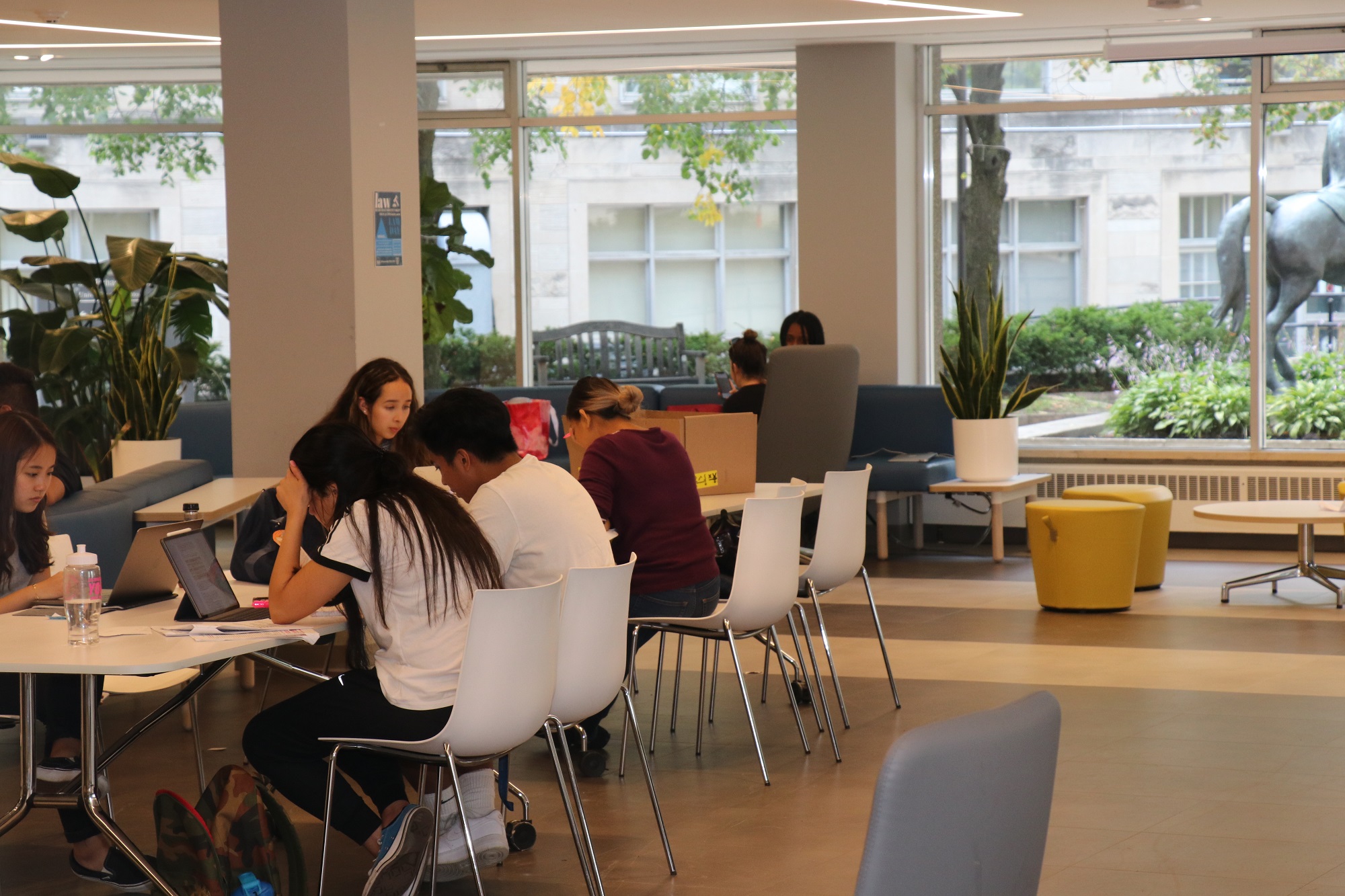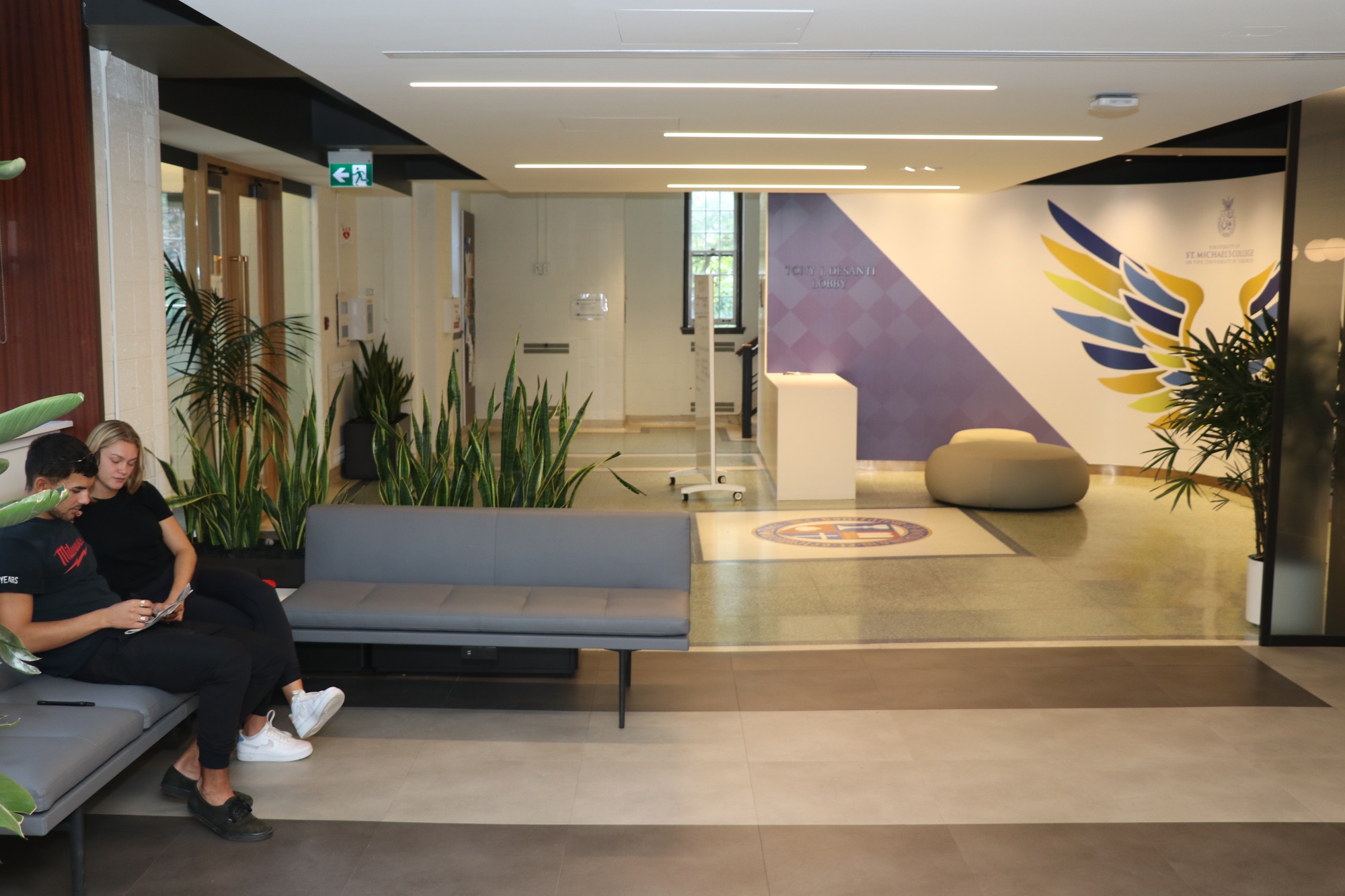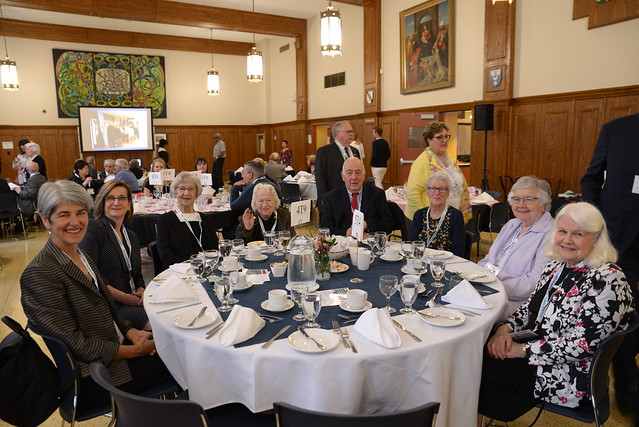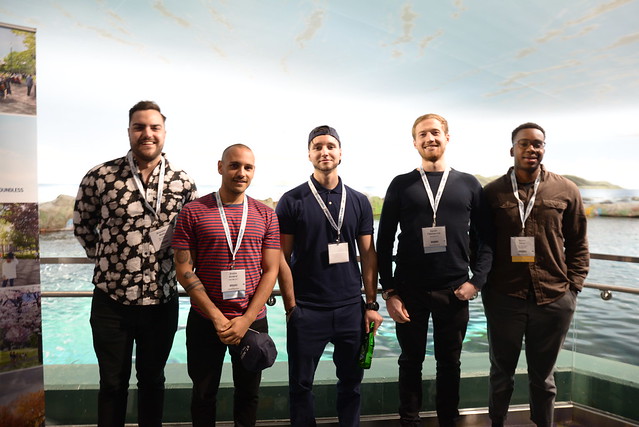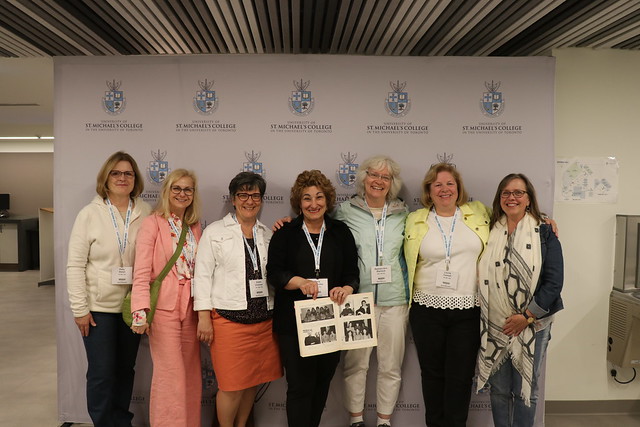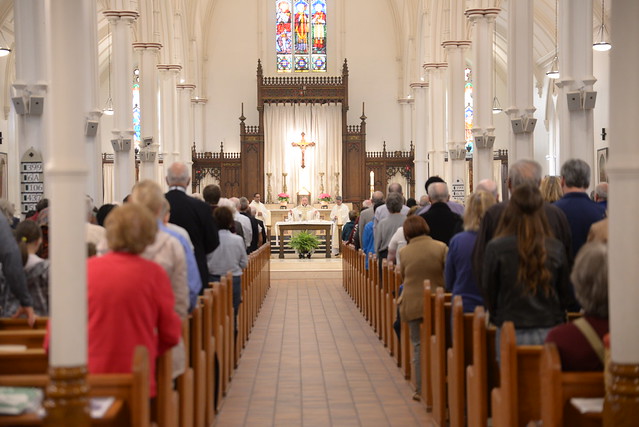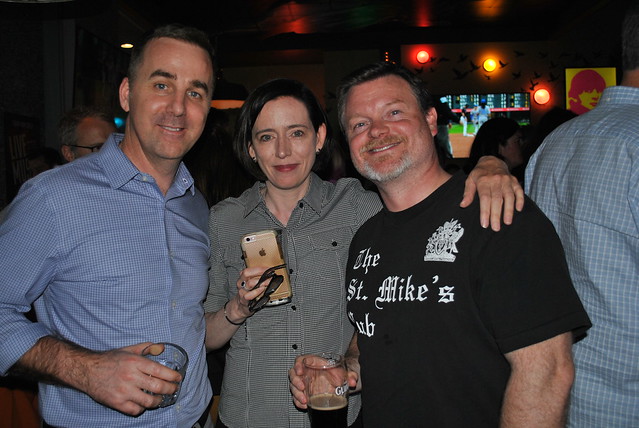The University of St. Michael’s College is pleased to congratulate Dean of Students Duane Rendle on his retirement in June 2025.
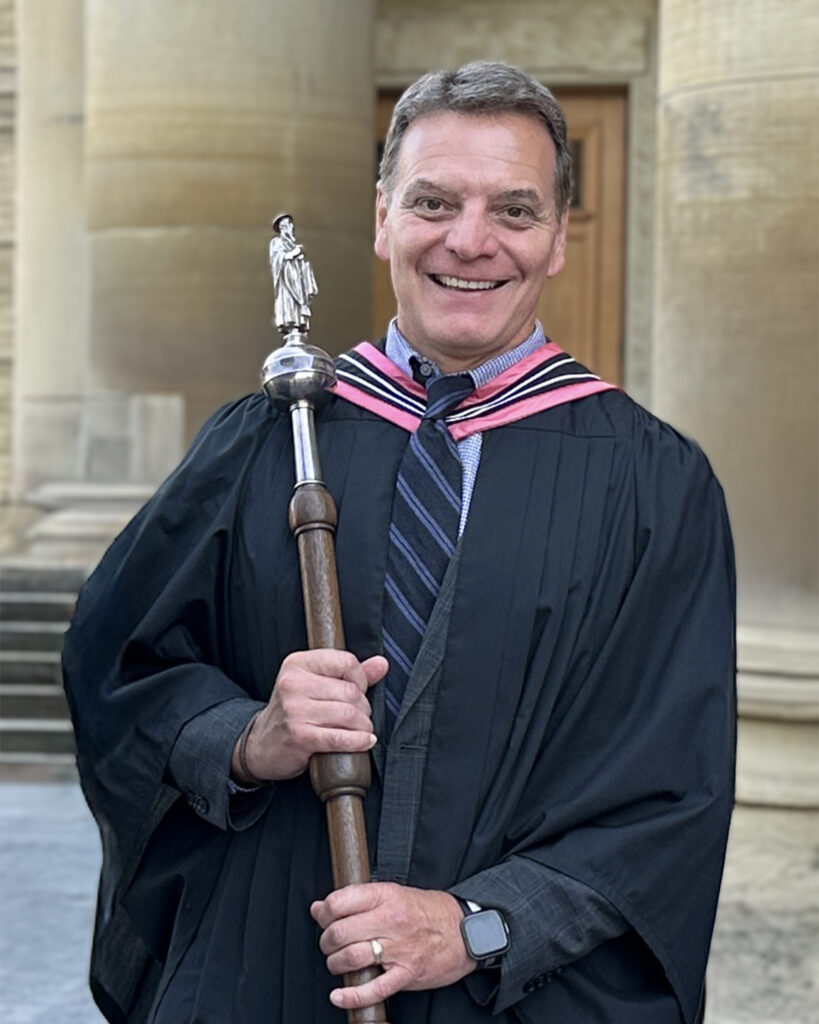
“Please join me in thanking Duane for his exceptional contributions to student life at St. Mike’s and wishing him the very best in his well-earned retirement,” University President David Sylvester says.
Rendle first joined the SMC community as a resident while completing an MA in Industrial Relations in the mid-1990’s. In 1998, after serving as a don for two years, he was hired as Dean of Men & Dean of College, overseeing St. Michael’s residence operation and serving as the main liaison between the student residence body and university administration.
During his nearly 28-year tenure, Rendle worked to animate and improve the part of a student’s university experience that takes place outside the classroom.
“Student life is about the clubs you join, the events you attend, the extra curriculars you engage in, and the leadership roles you assume – all of which help to make friends and memories that will last a lifetime,” he says. “It’s been an honour for me to foster those things at SMC.”
Over the years, Rendle worked to modernize the Dean of Men/College position into a true Dean of Students role. He oversaw the transition of the men’s residences into a coed operation and expanded the dean’s portfolio to include supervising Orientation, providing training and oversight to student clubs/leaders, and expanding supports for SMC’s commuter population. He also oversaw the college’s 24/7 on-call program, working with partners to expand mental health counselling, as well as supporting the creation of the Manager of Community Wellness position.
Passionate about intramural sports, Rendle took a special interest in promoting SMC’s rugby program, eventually watching the team compete in eight championship games and take home four Mulock Cup titles. He also led on student life education, creating an online course to promote safe drinking habits and address the intersection between alcohol use and sexual assault; Alcohol ABC’s (Always Be in Control) received an innovation award from the Canadian Association of College & University Student Services in 2015.
Rendle is very proud of the positive relationship his office fostered with SMC’s student union, SMCSU, and especially their collaboration on Student Improvement Fund projects, which invested more than $2 million to renovate residence halls, the Kelly Café and the Dodig Family Coop. The fund was also used to create the Wellness Studio, purchase a community ice rink and upgrade the equipment in the Alumni Hall gym.
He retires as the longest serving Dean of Students in St. Mike’s history, and one of the longest serving in the history of U of T.
Details for a farewell party, including date and time, will follow shortly.
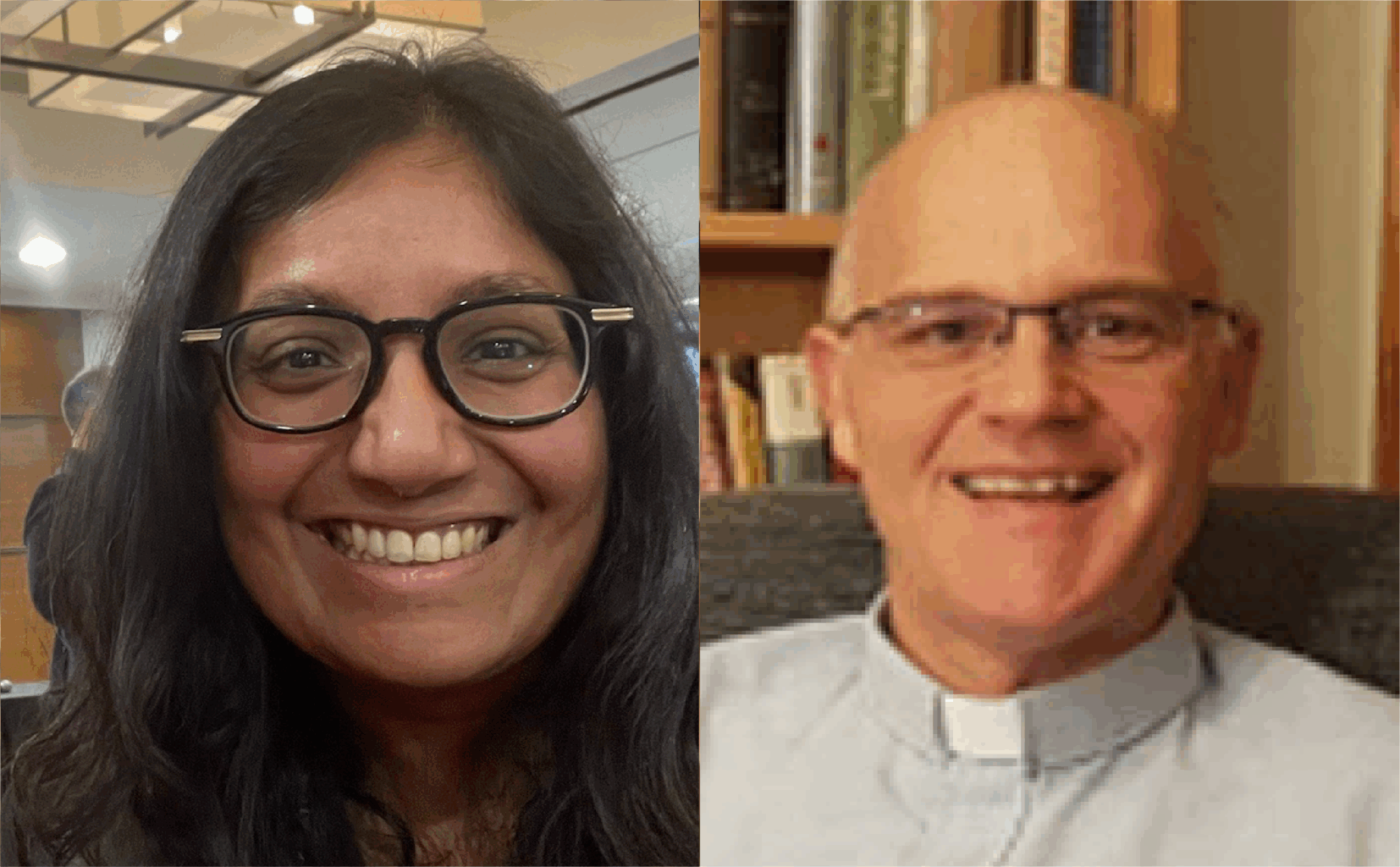
Fr. John Meehan has been named Interim Director of Mission and Ministry at the University of St. Michael’s College as current director Sonal Castelino prepares for her canonical novitiate year. Castelino, who is discerning a vocation with the Sisters of St. Joseph of Toronto, will spend a year at the order’s federated novitiate in Brentwood, New York before returning to her current role.
“This upcoming year will be a time dedicated to prayer and study to deepen my discernment and call to religious life with the Sisters of St. Joseph,” says Castelino. The novitiate year also offers time to live in community and learn more about the order’s charism. Castelino will begin her novitiate year in August.
“We wish Sonal a fruitful year as she enters the CSJs novitiate. Since her appointment to St. Mike’s in 2021, Sonal has led renewal of our campus ministry programming. As the inaugural Director of Mission, she has championed efforts to integrate mission into all aspects of our university. While she will be missed, we are pleased that John Meehan has agreed to serve as interim director. John is valued colleague, an experienced administrator and mission leader who will provide the continuity of programming that supports our university community,” says St. Michael’s President David Sylvester.
Fr. Meehan is looking forward to the interim role because mission and ministry “is one of the most important aspects” of life at a Catholic university. It is a ministry of presence, he notes, with the door kept open for students to drop by and ask the big questions of life, regardless of faith tradition.
“Students arrive at university with a childhood faith and university is a time for that faith to grow into adulthood,” Fr. Meehan adds. “Unless students grow spiritually they don’t see a purpose to faith.”
Therefore, he says, campus ministry should be a place to feel at home, to share a bowl of soup and to meet people from diverse backgrounds. It is also a place to develop leadership skills, citing St. Mike’s tradition of leadership retreats for students, emphasizing that leadership training is not just something to do for yourself but a way to learn about and better engage in servant leadership.
He also relishes the work he will be doing to further articulate the mission of St. Michael’s, hearing from students, faculty and staff while also building relationships that are important to the university.
“Campus ministry should be a place of dialogue, helping people who are different find common ground,” says Meehan, whose extensive career as an academic and university administrator includes time serving in campus ministry at Campion College in Regina and at the Newman Centre in Toronto, as well as in Montreal.
Perhaps the most important role campus ministry serves, he adds, is to foster hope.
“We see a lot of anxiety in students these days, with worries over everything from eco-anxiety to what they will do with their lives. Campus ministry is a place where you can have those conversation, in a friendly, supportive environment.”
The mission and ministry role “dovetails nicely” with his work as Director of the Bill Graham Centre for Contemporary International History at the University of Toronto’s Trinity College, with both roles sharing the goal of creating global citizens who are informed about, and engaged with, the world.
Dr. Meehan is an historian and the former president of the Jesuits’ Campion College and of the University of Sudbury. A graduate of McGill, Oxford, Johns Hopkins who holds a PhD from the University of Toronto, he is active in reconciliation work with Indigenous communities. He has worked in ministries with troubled youth in Mississippi, immigrants, prison inmates and people with disabilities. He is also a Visiting Fellow at St. Michael’s and Senior Fellow at Massey College.
The past few months have been marked by the pomp and circumstance of convocations, thought-provoking lectures and the merriment of the Christmas season. See what we celebrated at St. Michael’s in November and December.
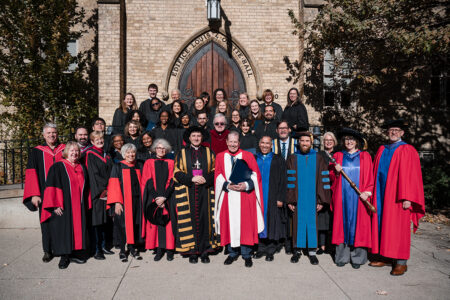
Congratulations Class of 2024
The convocation for St. Mike’s Theology and Continuing Education students took place on November 9 in St. Basil’s Parish. This year’s convocation ceremonies included 19 graduates from the Faculty of Theology, three graduates from the Diploma in Interfaith Dialogue and 28 graduates from Continuing Education’s Diploma in Social Responsibility and Sustainability program.
Capstone Awards
The President’s Capstone Awards are awarded to summative projects from the Diploma in Social Responsibility and Sustainability (SR&S). The projects are designed to create a positive social change and environmental impact in the larger community. This year’s winning projects focused on sustainable and just supply chains in Canada; a guide that places a systems lens on a sustainability reporting; and a business case and model comparison of municipal ESG reporting and materiality assessment.
Honorary Degrees
Two honorary degrees were conferred at the convocation ceremonies. Francis Anthony Comper, CM, an influential member of the USMC community, was granted a Doctorate of the University and Sister Nathalie Becquart, renowned for her work with the Synod in Rome, was granted a Doctor of Divinity. A luncheon followed the convocation ceremonies for the honorees and their guests.
While in town, Sr. Nathalie led a fireside chat with students on the Synod on Synodality.
Regis College Convocation
Twenty-four graduates celebrated their academic achievements at Regis College’s convocation on November 23. Dr. M. Shawn Copeland received an honorary doctorate for her outstanding research and advocacy for social justice issues, especially on those who are marginalized and oppressed.
The day before, Dr. Copeland delivered Regis College’s Chancellor’s Lecture on the topic of ‘The Political Vision of Jesus of Nazareth: Imagination, Mission, and the Reign of God’.
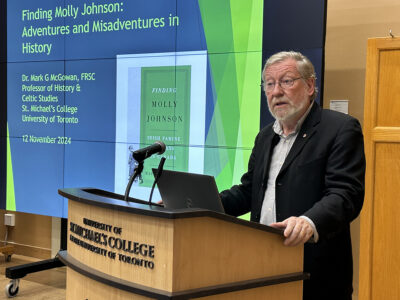
Book Launch for Professor McGowan’s Latest Book
History and Celtic Studies Professor Mark McGowan captivated an audience of students, faculty, alumni, and friends with his lecture and book launch of Finding Molly Johnson, which looks at the fate of Irish famine orphans.
Professor McGowan Inducted into Royal Society of Canada
In addition to the launch of his book, we’re also celebrating Professor McGowan’s induction into the Royal Society of Canada at its Celebration of Excellence and Engagement on November 9. The honour stems from his groundbreaking work on Irish migration and settlement in Canada.
The Honouring Indigenous Aid Exhibit
Regis College presented ‘The Honouring Indigenous Aid Exhibit’, which paid tribute to the Anishinaabe, Haudenosaunee, and Huron-Wendat First Nations in Canada West, now Ontario, who contributed to Irish Famine relief in 1847.
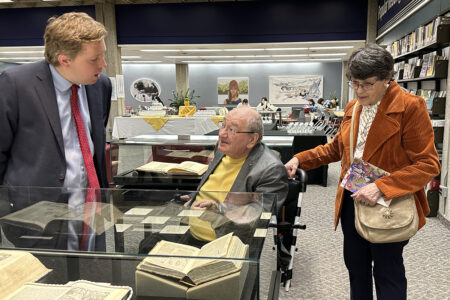
Dante Lecture
The annual Dante Lecture, established by Alberto Di Giovanni and Caroline Morgan Di Giovanni, was held on November 6. This year’s lecture, ‘Dante and Beatrice,’ was presented by Prof. George Corbett, Professor of Theology, School of Divinity, University of St. Andrews, U.K. He spoke about Dante’s Beatrice. The lecture was followed by a reception in the John M. Kelly Library where guests enjoyed an exhibit curated by Kelly Library’s Theology Librarian Noel McFerran. The exhibit focused on illustrations of Dante and Beatrice found in early manuscripts, 19th century engravings, and contemporary works.
A Poet Talks About Poetry
On November 7, the Friends of the Kelly Library hosted ‘A Poet Talks About Poetry,’ a chat with writer and SMC alumna Kate Marshall Flaherty. A graduate of St. Michael’s College and longtime facilitator for St. Michael’s Continuing Education programmes, Kate Marshall Flaherty has written seven poetry books, including Reaching V, published by Guernica Editions, and Digging, published by Aeolus House, and has won several awards. Caroline Morgan Di Giovanni, President Emerita of the Friends of the Kelly Library and fellow writer, was the evening’s host.
Lonergan Research Institute Lecture
The Lonergan Research Institute hosted a public lecture on November 14 by Dr. Karen Petersen Finch, of Montreal’s Presbyterian College on the ‘Applications of Lonergan’s Method: Questions for Reflection.’
Annual Elliott Allen Institute Lecture in Theology and Ecology
Noted Norwegian Theologian Dr. Jan-Olav Henriksen delivered the annual Elliott Allen Institute Lecture in Theology and Ecology on November 18. He spoke on the topic of ‘Allowing Grace to Work in the Anthropocene: Lessons from Nordic Creation Theology.’
Alumni Initiative 4 Women Conversations Series
The Alumni Initiative 4 Women held the latest instalment in its Conversations Series on ‘Landmark Changes from Papal Synod’ on November 8. It was a thought-provoking evening in response to the historic Synod on Synodality. Moderator Catherine Mulroney welcomed a dynamic panel of speakers: Christianity & Culture student Bridget Bowles, along with Regis St. Michael’s Faculty of Theology (RSM) doctoral students Sr. Carla Thomas, OP and Christine Way-Skinner shared their unique generational insights on this pivotal moment in the Catholic Church. The event explored the Synod’s far-reaching mandate to advise Pope Francis on ways to more fully include all members of the Church, especially women. Notably, this Synod made history with the inclusion of 54 women among 365 delegates, and for the first time, women were granted voting rights in a Synod of Bishops.
‘Listening to Women in Medieval Irish Literature’
Professor Joanne Findon, Professor Emerita of English Literature at Trent University offered a closer listen to the voices of medieval Irish women on November 26.
University Chancellor Named Cardinal
Archbishop of Toronto and Chancellor of St. Michael’s Cardinal Francis Leo was elevated to the College of Cardinals at the Papal Consistory in Rome on December 7. He was joined by President David Sylvester and other members of the USMC community and collegium to mark this momentous occasion. We wish His Eminence Cardinal Leo all the best in the work that lies ahead.
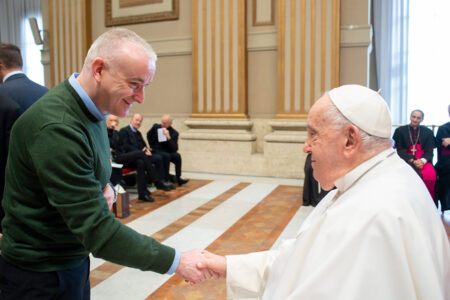
When in Rome
Regis St. Michael’s Dean Jaroslav Skira and Professor Gerard Ryan, SJ attended a conference on the ‘Future of Theology’ organized by the Vatican’s Dicastery for Culture & Education from December 9-10. In addition to meeting theologians from around the world, they were granted an audience with Pope Francis.
A New Four-Year Operating Agreement with U of T
The University of St. Michael’s College and the two other independent federated universities signed a new four-year operation agreement with the University of Toronto. The agreement outlines mutual commitments and responsibilities including the use of shared spaces, classrooms, offices and student facilities for each federated university and ensures a rich student experience.
Campus Ministry Hosts TCDSB Day of Service
Campus Ministry hosted students from nine TCDSB high schools and their teachers to meet with the school board’s Nurturing Our Faith Community office and Deacon Robert Kinghorn. After Mass and a talk by Deacon Kinghorn about his Church on the Street experience, students gathered for lunch and then made sandwiches to distribute to people in need and toured the inspiring sculptures on campus.
Continuing Education Hosts Learning Day for High School Students
On November 12, the Continuing Education Division facilitated an orientation and learning day for 55 senior students from the nearby St. Joseph College School. During the day, the students participated in a variety of activities to increase their knowledge of both USMC and a day in the life of an undergraduate student. The activities included two mini lectures led by faculty members, a tour of campus and a residence room, a student panel and a scavenger hunt in the Kelly Library.
City of Toronto Green Skills Workshop
Director of Continuing Education Michael Salvatori joined colleagues from other Continuing Education Divisions as well as industry and community partners at a Green Skills workshop hosted by the City of Toronto. The purpose of the day was to convene key stakeholders from the municipal government, industry and postsecondary institutions to address the workforce needs that are essential to achieve the City of Toronto’s Net Zero strategy goals. The day offered an opportunity to promote USMC’s Diploma in Sustainability & Social Responsibility as well as the new courses and programs developed to further sustainability goals.
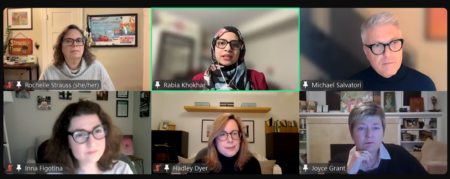
Panel Discussion on ‘It All Starts with a Story: Five Celebrated Children’s Authors on Talking to Young People About Social Change’
On November 28, Continuing Education hosted a virtual panel discussion with five Canadian children’s authors and educators to discuss challenges and strategies for holding meaningful discussions with young people about urgent and timely social issues in age-appropriate ways. The panel included Hadley Dyer, Joyce Grant, Rabia Khokhar, Inna Figotina and Rochelle Strauss and it was facilitated by Continuing Education Director Michael Salvatori. Over 40 participants joined online and contributed to the conversation. A recording can be viewed here.
World Digital Preservation Day
Students and staff dropped by the lobby of the Kelly Library on November 7 – World Digital Preservation Day, 2024 – to learn about digital preservation and find out what to consider for preserving their own born-digital materials. Over the course of the three-hour event, 37 people stopped by to learn something new about digital preservation.
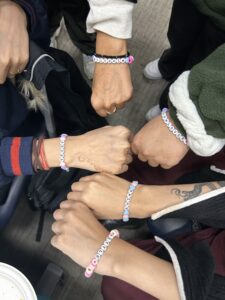
Friendship Bracelet Making De-Stressing Event
The Kelly Library held two very successful friendship bracelet making events on November 13 and November 20 in the Kelly Café. Whether you were a Swiftie preparing for the Toronto Eras Tour shows, making matching bracelets with your friends or a midterm-addled student needing a study break, all were welcome at this free event held for students, staff and faculty. We had so much fun being creative, making memories together, and seeing one another’s bracelets when they were finished.
Santa Claus Drops by St. Mike’s
The holiday season at St. Mike’s kicked off with a magical celebration where alumni and their families enjoyed delicious cookies, hot chocolate, and other treats. Little ones unleashed their creativity at the holiday arts and crafts corner, making their own Christmas masterpieces, as well as writing letters to Santa. Santa Claus made a special appearance, spreading early holiday cheer and magic before his big parade (The City of Toronto Santa Claus Parade) to make this a holiday season filled with love, laughter, and unforgettable memories.
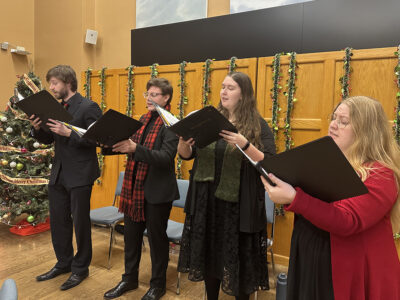
Christmas Tea
One of St. Michael’s favourite holiday traditions returned. The Office of Advancement was delighted to thank donors for their support by inviting them to the annual Christmas Tea on December 3. The afternoon was filled with warmth, caroling with the Gaudete Singers and festive cheer.
Christmas Market
St. Michael’s hosted its 3rd annual Christmas Market on December 3. A record number of vendors sold one-of-a-kind finds including baked goods, handmade items and jewelry. More than $1700 was raised in support of Romero House. View photos here.
Staff and Faculty Luncheon
Staff and faculty rang in the holiday season at a luncheon on December 5 in Brennan 200. Attendees were encouraged to embrace the spirit of fun by wearing their most outlandish ugly Christmas sweaters, adding a lighthearted touch to the event. The luncheon provided a warm and joyful atmosphere, where colleagues enjoyed good food, laughter, and the opportunity to connect with one another. It was a wonderful occasion that captured the holiday cheer and camaraderie of the St. Michael’s community.
Falala Formal
Student Life celebrated our student leaders at this year’s Falala Formal. More than 90 students enjoyed a dinner with the season’s festivities as a thank you for their contributions on campus. View photos from the event here.
Schola Cantorum Advent Concert
The St. Michael’s Schola Cantorum presented their Advent concert at St. Basil’s Church on December 9. The concert featured the Oratorio de Noël (Christmas Oratorio) by French composer Camille Saint-Saëns (1835-1921), a lush and lyrical meditation on Christ’s birth through musical settings of biblical passages for soloists and chorus. Thanks to the efforts of U of T Music Technologist Peter Olsen, we’re pleased to share a recording of the concert with you.
Faculty and Fellows Reception
On December 12, the Principal’s Office held a reception for faculty and fellows in Charbonnel Lounge.
New Issue of St. Michael’s Alumni Magazine
The latest issue of St. Michael’s Alumni Magazine is now available. The cover story features Alumna Eleanor McGrath on living in harmony with life’s seasons, as well as a look back on Professor Mark McGowan’s illustrious 34-year career at St. Mike’s. Read the magazine here.
On National Day for Truth and Reconciliation, we are sharing “Kindred Spirits in the North: Some Preliminary Notes on Indigenous Peoples in British North America and Their Donations to Irish Famine Relief”, research conducted by Prof. Mark McGowan. Since the preliminary findings were made known two years ago, the research has expanded vastly, recognizing numerous Nations donated funds from their annuities, recognizing that as a Treaty People, they were responsible to help others in their time of need.
The Irish Famine (1846-1852) was one of the most traumatic events in modern Irish history. With the repeated failure of the potato crop, upon which two-thirds of Ireland’s 8 million people depended, the social and economic fabric of Irish life was torn to pieces. By the early 1850s, one million people had perished from hunger or disease and another 1.5 million simply left Ireland.

One of the unsung episodes of the Famine was the donation of $170 (the figure is disputed) or about $6,300 USD in today’s currency, from the Choctaw Nation in the USA to Irish relief. There is much irony in this act of generosity from the Choctaw. They themselves were destitute having been forced to relocate from their traditional lands in the southeastern United States, to the designated “Indian Territory” in present day Oklahoma. From 1831-1833, this “Trail of Tears” initiated by President Andrew Jackson, himself of Irish descent, caused the deaths of thousands of Choctaws, Creeks, Cherokees, Chickasaws, and Seminoles. Yet only fifteen years later, the Choctaw, in their own poverty, recognized the plight of the Irish, identified with it, and scraped up what meagre resources they had, to share with their fellow human beings living an ocean away. According to Choctaw historian and writer LeAnne Howe: “buried deeply within the Choctaw body politic is a sense of giving shelter, food, and/or aid to our relatives, friends, and allies. Ima, giving, is a cultural lifeway.” The Irish in Ireland have not forgotten the gift and have erected a large monument, highlighted by a massive circle of eagle feathers, to the Choctaw gift, named “Kindred Spirits,” at Midleton, near Cork City.
What has gone virtually unheralded in Canadian history is similar gifts made by the Canada’s Indigenous peoples to Irish migrants who arrived in Canada, fleeing the famine. In 1847, the traditional Haudenosaune territory of Tiohtiake, then Montreal, was the scene of tremendous suffering and death. Afflicted with typhus and other serious infections, thousands of Irish migrants were herded into hastily built sheds at Point St. Charles, just east of the downtown area. The Mohawk Nation of Kahnawake, south of the city on the St. Lawrence River, immediately responded to the Irish, bringing food from their lands to the fever sheds. In addition, despite living in poverty themselves, former Chief Christine Zachary-Deom reported that the Mohawks took up a collection for Irish relief in Montreal, raising about $150, or just shy of $5,000 in today’s Canadian dollars. This was an enormous sacrifice for a people that had been marginalized and made sedentary near the great Island that once housed their council fires. At the time, Governor General, Lord Elgin, wrote to the Colonial Office indicating that “several Indian tribes expressed a desire to share in relieving the wants of their suffering white brethren.”
Little else was said and the great kindness of the Mohawks was virtually forgotten in Canada. In fact, Canada’s Irish soon became part of the vanguard of settler-colonial “nation building.” In Ireland, however, both the Lord Mayors of Dublin and Belfast have come to Canada to formally thank the Mohawk people for their great generosity in Ireland’s time of need. For her part Mohawk Chief Zachary-Deom, remarked during a Famine commemoration in Montreal, that the Haudenosaune and the Irish shared many qualities—they are “resilient, determined, and tough people.” The generosity of the Haudenosaune of Montreal was but the tip of a much larger iceberg of donations that have been left unrecognized by historians.
Other Indigenous peoples, sometimes prompted by colonial authorities, made similar, if not greater donations. In Montreal, in February 1847, local Irish and Scottish citizens established the Fund for the Relief of the Destitute Poor in Ireland and Scotland. In addition to prominent subscribers such as Governor General Elgin, and ordinary Irish working-class donors, the Indigenous peoples of Canada West (now Ontario) gave generously to the fund. On St. Patrick’s Day, 1847, Thomas Gummersall Anderson, the Chief Superintendent of the “Indian Department” in Canada West issued an invitation to the Indigenous nations within his jurisdiction to donate to the Fund. At least 16 bands answered the call and requested that donations be deducted from their government annuities, added to the Fund, and then sent to “our suffering fellow subjects and Christian brethren in Ireland and Scotland.”
Each Indigenous band, however, admitted that they themselves were in poverty and wished that they could do more. Chief Brant of the Mohawks of Quinte explained to Anderson that “We feel we have too many poor among ourselves to give much but we beg you will accept our sum of twelve pounds ten shillings as a small proof of our sympathy with them.” By the middle of May, the Mohawks, Haudenosaunee of the Six Nations of Grand River, Chippewa (Ojibwa), Delaware, Wyandotte, and Mississauga peoples had donated £115 to the Fund. By early June with further donations from the Saugeen, Ojibwa of Lake Huron, and Moravian Ojibwa, the total Indigenous gift to the Relief Fund was £172, or over $19,000 in today’s Canadian currency.
While many of the donation letters were dictated by Council Chiefs to the local missionary or school master, who translated the local Indigenous language into English, (in which seemed like common “boiler plate” testimonies), two letters stand out. Missives written for the chiefs of the Mississaugas of Chemong (Curve Lake) and the Mohawks of Quinte, were longer and more detailed in their commentary than the other letters. At Chemong, Chief Nogy conceded, like Chief Brant at Quinte, that his community was poor and would have liked to have given more. He added this urge to help, however, arose from “the friendships we have received from them [British settlers] in former times.” No doubt Chief Nogy was referring to the settlers, many of whom were Irish from the Peter Robinson migration scheme, who had populated several townships of Peterborough County, within traditional Mississauga lands, since 1825.
Similarly, Chief Brant at Quinte would have had frequent contact with the large Irish settlement in Tyendinaga Township in Hastings County, which bordered Mohawk reserve lands. In at least these two cases, in which the bands donated £12 10s each, their offerings reflected both a concern for the starving in Ireland and Scotland, but also familiarity with the Irish settler/colonists who had been their neighbours for over two decades.
The surviving documents of these gifts, however, reveal a deeper meaning behind the Indigenous donations. Most of the letters from the Anishinaabeg peoples are signed with the doodem of the signatory band chief. This is not a personal signature, as was assumed by the settler administrators who received them. According to scholar Heidi Bohaker, the doodem informs “respective understanding of time, space, history, law, philosophy, ethics, and most significantly, the foundational relationship between human beings and the world in which human beings live. Anishinaabeg leaders wrote these images on documents pertaining to their lands, at councils held on those lands, reflecting the discussions of those councils. These images are expressions of Anishinaabe law.” When a doodem was assigned to a document or treaty it was an expression of communal consent, arrived at in council, and then expressed by a symbol that was integral to Anishinaabe notions of personhood. Thus, the appearance of doodemag on these letters, was far more than assent to a “one off” donation; instead, it was an expression of how the Anishinaabe understood themselves as treaty people in their relationship with the British. Their treaties with the Crown, signed with doodemag, bound them in a reciprocal relationship with their treaty partners. These donations were manifestations of the responsibilities that treaty partners had to one another. Although they had never seen those who were in need, thousands of kilometers away, they acknowledged their responsibilities to assist “our destitute white brethren” who were children of the Crown. While the Haudensaunee peoples at Quinte and Grand River no longer used their Otara to sign the donation letters, their historical alliances with the Crown were no less significant in this act of giving.
When viewed through an Indigenous lens, the offerings of relief to the starving Irish were part of the way in which First Peoples viewed their treaty responsibilities when called upon. Their gift was an obligation to their ally. This generosity was well expressed by Chief John Aissane of Beausoleil, when he informed Anderson: “Your brother has read your letter to his brother chiefs, who express great pity for their White Brethren and have unanimously agreed to place at the disposal of their Great Father in Montreal [Lord Elgin] for the relief of our White Friends who are suffering of hunger the sum of ten pounds currency … The sum is small compared with the large sums that we are told has been sent to our white friends by their brethren but we are poor and give the best of our ability with willingness.” (29 March 1847)
As historians, it is time that we look less to the “nation building” motifs that have so typified the writing of Canadian history and seek moments where “Kindred Spirits” prevailed. This might be one other way of seeking truth and affecting reconciliation. Such spirit was evident in 2020, when the Irish national lacrosse team gave up their place at the coming World Games, so that the Iroquois Nationals could play in their place in Birmingham, Alabama. The Nationals had been denied a place because they, according to the World Games administrators, were not a sovereign nation. The need for generosity of spirit is ongoing.
When St. Mike’s Professor David A. Wilson completed his two-volume biography of the Irish Canadian Father of Confederation Thomas D’Arcy McGee, he was planning to continue teaching in the College’s Celtic Studies Program for the rest of his career. Instead, in 2013 he was appointed General Editor of the Dictionary of Canadian Biography, and has been there ever since – while still retaining a connection with the Program.

“I love working with such a talented team of editors and translators,” he says, “and having the opportunity to bring our biographies to the widest possible audience,” he says. With over 9,000 biographies published and more coming out each week, the Dictionary is the largest bilingual project in Canadian humanities. “Drawing mainly on primary sources, our biographies range from prime ministers to public hangmen, cardinals to cult leaders, bureaucrats to bootleggers,” Wilson notes. “From the story of a young Indigenous boy who froze to death while on the run from a residential school, to that of a mentally ill woman trapped in an Asylum for the Insane, they reflect a wide variety of Canadian experiences.”
Now, thanks to a new website developed by the teams at the University of Toronto and Université Laval in Quebec and launched this July, it will be possible for even more readers and researchers to learn about the women and men who helped make the country what it is today.
“Almost all Google searches are by theme rather than by name,” Wilson explains; “by linking individual biographies to broader themes, the new website will make our biographies much more accessible. At the same time, the links enable our readers to learn more about themes related to a particular biography.” For example, if someone Googles “Enslaved Black people in the Maritimes,” they will be directed to more than 40 related biographies, can read an essay outlining their historical context, and will have access to other sources on the subject.
Individual biographies are starting to get a new look as well. More of them now begin with a 100-word summary of the entry so that readers can quickly assess their significance, and they have headings and subheadings that highlight particular sections.
Until recently, the Dictionary had been organized chronologically by death date, with the new entries focusing entirely on the 1940s. Now, half of the biographies are drawn from all periods, enabling the Dictionary to draw on new research from earlier periods and to move forward into more recent times.
“Everyone in our Toronto and Quebec offices is excited by these changes,” says Wilson. “We have much more flexibility, and can include even more biographies of Indigenous peoples, racialized minorities, women and members of the working classes.”
All the biographies are subjected to a thorough editorial process. As General Editor, Wilson is the final set of eyes, reading each piece before it is posted to the website. “By the time the biographies land on my desk,” he says, “they need very little work. This is probably the most rigorously researched dictionary of national biography in the world.”
Unlike many other biographical dictionaries, the Dictionary of Canadian Biography remains free to readers, thanks to the support of the federal government, as well as of donors. Wilson is currently engaged in a fundraising campaign to ensure the Dictionary can continue its current level of activity and its contributions to the history of Canada.
“It is such an honour to be in both the Celtic Studies Program and the Dictionary of Canadian Biography,” says Wilson, “and to contribute in different ways to the intellectual life of the country.”
You can check out the website at www.biographi.ca
An ambitious new research project shepherded by University of St. Michael’s College Professor Reid B. Locklin aims to re-examine the life and work of the Jesuit theologian Bernard Lonergan (1904-1984) through the lens of his connection to the Indian Residential School System, the first such study conducted of the renowned Canadian philosopher and theologian.
“The goal of this project is to approach Lonergan as a kind of case study for all theologians who conduct our research in the context of settler colonialism, and who continue to benefit from it,” Locklin explained. “As it happens, Lonergan’s life and public career corresponded closely to the darkest period of the Residential Schools, and he was implicated in this system through a number of institutional connections. Our project asks a simple question: what happens if we make these facts of history more central to the ongoing reception and interpretation of his intellectual legacy?”

Locklin’s co-applicants on the two-year project, which has been awarded a prestigious Insight Development Grant from the Social Science and Human Research Council (SSHRC), are Professor Darren Dias, OP, who is a member of the Regis St. Michael’s Faculty of Theology (RSM) and the Executive Director of the Toronto School of Theology, and Concordia University’s Prof. Christine Jamieson.
The project, entitled Transcendental Method, Spiritual Violence & Genocide: “Turning to the Person” of Bernard Lonergan in the Context of Settler Colonialism, will also be supported by a team of eight Indigenous and non-Indigenous collaborators from Canada and the United States, including Professors John Meehan, S.J. and Gordon Rixon, S.J., who is President of Regis College. Students from RSM and undergraduate students from St. Michael’s Christianity & Culture program will also lend research support.
Together, the group will meld traditional disciplinary research with Indigenous learning circles and connections with the land to subject Lonergan to a new form of criticism, while also unearthing unexpected points of convergence and conversation.
One of Canada’s best-known thinkers of the 20th century, Lonergan was a member of the Order of Canada and the British Academy who taught at Regis College in Toronto, Boston College, and the Gregorian University in Rome. A member of the Society of Jesus, popularly known as the Jesuits, his work and teaching took place during an era when thousands of Indigenous children were sent to residential schools, including schools run by his own religious community, notes Locklin.
The Truth and Reconciliation Commission of Canada’s report released in 2015 described these institutions as places of “spiritual violence” engaged in “cultural genocide” by Canada’s federal government and the Christian churches and religious communities who operated them.

Transcendental Method, Spiritual Violence & Genocide will look specifically at any historical ties Lonergan had to two Jesuit-run schools: one in Spanish, ON, which closed in 1958, and the other in Pine Ridge, South Dakota, which saw all its dormitories closed between the 1960s and 1980s. It will also examine the wider network of Residential Schools.
“The Jesuits walked away from Spanish but looked at Red Cloud (in South Dakota) and said, ‘Let’s try something different,” notes Locklin. Today, Red Cloud Indian School has been re-thought and run by the Jesuits with a mandate to emphasize Indigenous language and culture. Locklin himself taught at Red Cloud as a Jesuit volunteer in the early 1990s and, while there, discovered that some of the Jesuits at the school had studied with Lonergan at Regis College.
“The first question becomes: who knew what about the Residential Schools?” says Locklin, suggesting that even though Lonergan probably did not experience Residential Schools first-hand, living as a member of a religious community that sponsored them may well have exposed him to information about life in the schools, and the treatment of the students who attended them.
Project researchers, divided into three teams, will also conduct an analysis of colonialization and anti-colonialism in Lonergan’s writing on method, epistemology, Christian mission and the philosophy of education, and then take the findings and examine them in light of selected Indigenous philosophies and theologies.
Lonergan, the project’s proposal notes, embraced Enlightenment thought’s desire to turn to the subject. Citing an approach embraced by Boston College theologian and Lonergan scholar M. Shawn Copeland, Locklin says this project “will turn to the person rather than turning to the subject” in an attempt to examine the impact, if any, settler colonialism had on Lonergan’s life and work. People and their experience will ground the project and have a major impact on the findings.
The team hopes to break new ground in the field of Lonergan Studies as well as to “make a modest contribution” to ongoing efforts to engage in reconciliation in the academy and in the Catholic Church, Locklin says.
Findings will be shared via two public lectures, conference presentations, a collection of essays, and a series of online reports hosted on Locklin’s resource site, Teaching and Learning as Treaty Peoples (https://treatylearning.ca/).
Father Andrew Summerson has been appointed a full-time, tenure stream member of Regis St. Michael’s Faculty of Theology, where he will serve as an Assistant Professor of Greek Patristics. Prior to the appointment he had held a Contractually Limited Term Appointment with the Faculty for three years.

“I am happy to continue my work with the Faculty, the Sheptytsky Institute, and the University of St Michael’s College to deepen pathways of collaboration on campus with colleagues and the wider constituencies around campus,” he says.
Summerson holds an S.Th.D. in Patristic Theology from the Pontifical Patristic Institute Augustinianum in Rome. His book, Divine Scripture and Human Emotion in Maximus the Confessor: Exegesis of the Human Heart, was published by Brill.
“Professor Summerson brings many talents to this new position, from his wide-ranging scholarship in Patristics and the Eastern Churches to being a great community builder and fostering international networks of collaboration and research,” says RSM Dean Jaroslav Skira. “All of this will continue to raise the profile of an invaluable part of our Faculty of Theology, namely, the Metropolitan Andrey Sheptytsky Institute of Eastern Christian studies.”
Summerson will continue to teach History of Christianity 1 as well as the courses in Patristics and Eastern Christian Theology.
“The University of St. Michael’s College boasts a proud history of historical studies while engaging the contemporary world,” says Summerson. “I see my own work with Sheptytsky aligned with St. Michael’s heritage: engaging the touchstones of the Eastern Christian past for the life of the world we live in today.”
He looks forward to continuing his work with theology students,
“Early Christian texts aren’t meant to be sipped like wine; they must be chugged like beer,” he says. “I like to read primary sources with my students and treat them not like delicate artifacts, but living voices that speak true statements about God and the Church today.”
The University of St. Michael’s College salutes Professor Emerita Ann Dooley, who has been named the inaugural recipient of the Ireland Funds Canada Distinguished Leadership Award.

Dooley, one of the founders of St. Michael’s Celtic Studies program, has been inspiring students and working as a tireless ambassador since the program’s inception. She was presented the award – a custom book box containing a first-edition, signed copy of works by the renowned Irish poet Seamus Heaney– at the Ireland Funds Canada’s St. Patrick’s Day luncheon, held March 8 at the Arcadian Court in Toronto. Proceeds from the event will benefit the Celtic Studies program.
In 1975, while Dooley was a graduate student at Toronto’s Centre for Medieval Studies, she was approached by Fr. John Kelly, CSB, then St. Michael’s President, and the English Department’s Prof. Robert O’Driscoll to discuss creating an introductory course in Celtic Studies.
An instant success, the class quickly led to more courses being added, with Mairin Nic Dhiarmada teaching Irish Language, and then Prof. David Wilson joining to teach history. Over the years, numerous graduate students and graduates of the program have come back to teach as sessional instructors, and you’ll find others teaching at such schools as Harvard, Trinity College Dublin, and at the National University of Ireland Galway.
The 2024 Distinguished Leadership Award was presented jointly by Oliver Murray, Chair of the Ireland Funds Canada, and long-time St. Michael’s friend Eithne Heffernan, who serves as Vice-Chair.
While the Global Ireland Funds has long honoured exceptional community members, Dooley’s award is the first time that the Ireland Funds Canada has chosen to honour a local recipient, Heffernan noted during the presentation.
Describing Dooley as “a leading light in Celtic and Mediaeval Studies,” Murray said the award was made “with great affection and appreciation for her tireless efforts supporting and promoting Celtic Studies in Toronto and Canada.”
Heffernan agreed, noting that Dooley “has spent a lifetime nurturing and educating students whom she inspired to great academic heights. She instilled in them a love of learning and of all things Irish from language to literature,” adding that she continues to be greatly loved, respected, and admired at the University by students and faculty, and by the Irish Community in Toronto.
Always generous to her colleagues, Dooley attempted to convince her program seatmates to rise with her and approach the stage to accept the award.
“It was so good of them,” Dooley says of the Ireland Funds, but she is quick to add that “the real story is the whole team, whose wonderful work is now the real story of the program, not me,” noting the ‘great contributions of Profs. Mark McGowan, David Wilson, Brent Miles, Pa Sheehan, and those who teach in the program thanks to the Ireland Canada University Foundation (ICUF).
“As many members of the local and international community know, Ann Dooley has been the defining heart and soul of the Celtic Studies program,” says St. Michael’s Principal Irene Morra. “She is, moreover, an extraordinary scholar and linguist. Her work encompasses and speaks to the breadth, rigour, and uniqueness of the program at St Michael’s College: it has ranged from Celtic mythology through to literary, cultural, and linguistic traditions from the medieval period well into the contemporary age. She is, as scholars, colleagues, and former students can attest, an absolute model of academic curiosity, knowledge, and advocacy.”
The Ireland Funds Canada has a long tradition of advancing non-political, non-sectarian, causes throughout Ireland and in Canada. The organization connects people of Irish heritage to bring positive change within Canada and Ireland, shaping culture, reconciliation, and enhancing education.
Read more on the Ireland Funds website.
For a country with a population about equal to that of the Greater Toronto Area, Ireland continues to hold a powerful fascination for people around the world, including the St. Michael’s community.
It’s a reality that Emer Maguire, who lives in Ireland’s County Louth, discovered soon after arriving at St. Mike’s as this year’s Ireland Canada University Foundation (ICUF) scholar.
The ICUF scholars have a mandate to teach the Irish language as well as to engage in various cultural events, including offering free Irish classes on a continuing education basis.

“There’s a great demand for the beginner courses,” says Maguire of the free instruction, adding that this year’s classes had to be capped at 35, and a waiting list established that stands at 50 more.
And as delighted as she is to be in Toronto sharing an appreciation for her homeland’s first official language, she says that the interest shown both by her university students and her lifelong learners will serve her well when she returns to Ireland this summer.
Having encountered some skeptics at home who question whether there’s a market for teaching Irish, she says the interest she is encountering, as well as the level of skill she’s seeing in her university students, will be good news to many.
“Some of the university students I’ve met speak a brilliant level of Irish — better than some at home,” she says, adding that Ireland’s membership in the European Union has resulted in a significant increase in the number of jobs requiring the ability to speak Irish.
Coming from a rural community, Maguire is intrigued by the sheer size of Toronto, the ease of getting around on the subway, and the number of tall buildings. But the diversity of backgrounds she sees in her classes is something she is also beginning to see in her teaching job in Ireland.
“There’s a great variety of students in my classes. Some are of Irish descent but most are from places around the world, and are simply interested in Irish culture,” she says.
At home, where she teaches primary- classes, her students, mostly Irish-born, increasingly include the children of people from Ukraine, Poland and a variety of international locations.
After a two-year sabbatical that began with a year in Massachusetts teaching as a Fulbright scholar, Maguire return home this summer, where she plans to head to the west coast of the country to teach in a Gaeltacht community, a district where Irish is the primary language in everyday use.
“It’ll be a way to get the calmness back before I return to my job,” she smiles.
Come the fall, she will be back in County Louth teaching in her local school. And while she has loved her experience in North America, she will be glad to get home to the vistas of the countryside, and to a place where she is connected to family and friends in a community small enough for almost everybody to have some form of connection.
On March 8, the world celebrates International Women’s Day. This year’s theme is “Inspire Inclusion.” Regis St. Michael’s female faculty members are contributing to this by hosting a luncheon on Friday for RSM female studies. In recognition of intersectionality and that female students tend to be the minority in theological studies, especially in the Advanced Degree level, Friday’s gathering hopes to help foster a sense of belonging and empowerment.
Regis College is working to “Inspire Inclusion” through raising the profile of RSM’s female
faculty members and other female theologians from historically marginalized groups, such as M. Shawn Copeland and Cristina Lledo-Gomez.
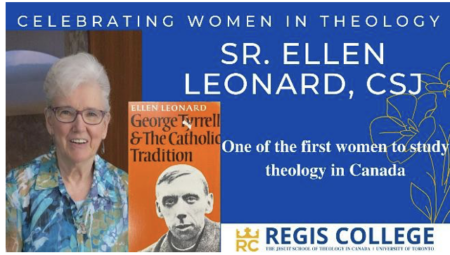
Each of these distinguished scholars are publicly recognized on our welcome slides at the South
Atrium Doors (facing Wellesley), and throughout the month, we will be sharing these slides on social media and thanking each individual for their contribution to theology. Among those recognized are Margaret Brennan, the first female theology professor at Regis College, and Ellen Leonard, one of the first women to study theology in Canada and to teach at the University of St. Michael’s College Faculty of Theology.
We are committed to inspiring and practicing inclusion. Let us journey in the synodal way with women of all walks of life and work towards a just society.
Fr. James Kelsey McConica, CSB, a world-renowned scholar who served as President of the University of St. Michael’s College from 1984 to 1990 and then as Praeses of the Pontifical Institute of Mediaeval Studies (PIMS) from 1996 to 2008, has died at the age of 93.
“St. Michael’s has lost a dear friend whose leadership both at the University and at PIMS was extraordinary,” said St. Michael’s President David Sylvester. “A gifted administrator and academic, Fr. McConica’s research and teaching on Erasmus and Thomas More drew international attention and acclaim. His impact continues to be felt in the Office of the President and his vision for the University remains an influence.”
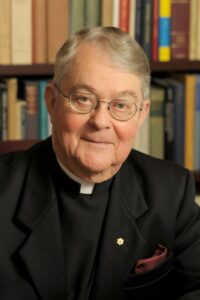
Born in Saskatchewan in 1930, James McConica graduated from the University of Saskatchewan before traveling to Oxford as a Rhodes Scholar. He then pursued studies at Princeton before returning to the University of Saskatchewan to teach. In 1967 he was made a Junior Fellow – and then a Senior Fellow– at PIMS, a role he held until 1991.
He was appointed President of St. Michael’s in 1984, succeeding Fr. Peter Swan, CSB. A research fellow at All Souls College, Oxford from 1990 to 1997, Fr. McConica was appointed Praeses, or President, of PIMS in 1996.
With more than 50 publications to his name, Fr. McConica’s interests included Erasmus, More, northern humanism to 1550, intellectual history, and historical theology.
The list of honours and accomplishments earned in his lifetime was lengthy and impressive. Fr. McConica was the first Roman Catholic priest since the English Reformation to be named a fellow of All Souls College. He was named an Officer of the Order of Canada, with his citation noting his editing and interpretation on the Collected Works of Erasmus, as well as The History of the University of Oxford. A Fellow of the Royal Society of Canada, and a Corresponding Fellow of the British Academy, he also served as a Member of the International Commission on English in the Liturgy.
During his time at St. Michael’s, Fr. McConica demonstrated a strong talent for fundraising. He also was known for his desire for the University to serve as a venue where multiple voices and viewpoints could be heard. Perhaps the most famous example was inviting Cardinal Josef Ratzinger, then the controversial Prefect for the Congregation for the Doctrine of the Faith, to speak on campus in 1985. The event was so over-subscribed it had to be moved off campus to Varsity Arena. Twenty years later, Cardinal Ratzinger was elected Pope Benedict XVI.
Friends and colleagues remember Fr. McConica fondly. Sr. Anne Anderson, CSJ, who served as St. Michael’s President from 2008 to 2015, described him as “a scholar and a gentleman.”
Dr. Richard Alway, who succeeded Fr. McConica in his roles at both St. Michael’s and PIMS, echoed Sr. Anne, noting that his colleague was “a man of culture and refinement.”
Describing Fr. McConica as one of his dearest friends and a colleague of more than 30 years, Dr. Alway said that while he was a scholar of great standing, “Fr. McConica was always a priest first.
“He came to his faith later in life and he was a late vocation,” Dr. Alway added, explaining that, after years of teaching, Fr. McConica was in Montreal visiting a friend who was a priest, and that friend suggested he spend a summer discerning with the Basilians in Toronto. He entered the order shortly thereafter.
While President, Fr. McConica recognized that one of St. Michael’s many assets was its impressive green space in the heart of the city, and so he worked hard to ensure that the grounds including the rock gardens, were well maintained, recalled Alway, adding that Fr. McConica was responsible for planting the rows of oak tress that line Elmsley Place today.
The Order of Canada citation describing Fr. McConica as “a classic humanist whose influence resonated through academic circles and beyond.”
Fr. McConica’s funeral Mass will be held at Presentation Manor, 61 Fairfax Crescent, Scarborough, on Friday, December 29 at 10:30 a.m., with visitation at 9:30.
The University of St. Michael’s College extends its condolences to the Basilian Fathers, and to Fr. McConica’s many friends and colleagues in the academy and around the world.
Read Fr. McConica’s obituary as published in the Globe & Mail.
The University of St. Michael’s College community is remembering Fr. William Irwin CSB as a gifted professor, an inspiring homilist, and a man of extraordinary pastoral skills who cared deeply for his students.
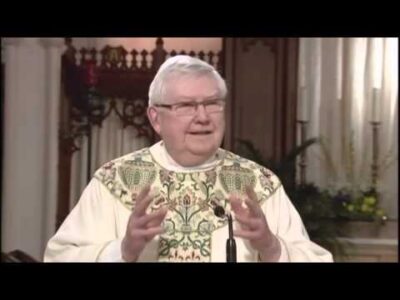
Fr. Irwin, who died on Dec. 6 at the age of 91, was a biblical scholar who specialized in in the Book of Isaiah and the Book of Psalms. He taught at St. Michael’s Faculty of Theology for decades, serving as Dean of the Faculty from 1981-1985. From 2001-2004 he was President of Assumption University in Windsor, On.
Born in Houston, Texas, Fr. Irwin earned a BA and an MA from the University of Toronto and a Baccalaureate in Sacred Theology from St. Michael’s before going on to further studies at the Angelicum and the Pontifical Biblical Institute in Rome. Ordained a priest in 1959, he joined the Faculty in 1965 and continued teaching part-time into his 80s, well past his formal retirement date.
“Fr. Irwin is one more example of the tremendous debt St. Michael’s owes to the Basilian Fathers,” said Prof. Jaroslav Skira, Dean of the Regis St. Michael’s Faculty of Theology. “I am particularly grateful for his dedication as Dean of the Faculty of Theology, for his scholarship in the Hebrew Scriptures, and for helping educate numerous graduates–some of whom we count as members of the Regis St. Michael’s Faculty of Theology.”
In an address to the Faculty of Theology convocation in 1985, Fr. Irwin spoke to those assembled about the importance of balancing study with lived experience, noting that “the Gospel not only enlightens but transforms,” and urging all to become engaged with the world, using their gifts to teach a message of hope. It is a model his former students recall well.
Doctoral candidate Sr. Carla Thomas O.P. who studied the Psalms with Fr. Irwin, remembers him as “a kind and gentle instructor. Fr. Bill taught by his personal presence as much as by his lecture,” she said. “I was struck that in his retirement years he still continued to teach students, in spite of all the demands that it must necessarily have made on him in so many ways. I remember him telling us that his favorite psalm was Psalm 73, and that God does not punish. Rather, God leaves people to their own counsel.”
Long-time Faculty Professor John L. McLaughlin also studied under Fr. Irwin.
“Bill Irwin was my Doktorvater, directing my Ph.D. dissertation, later was my colleague, and in both roles I considered him my friend,” recalled McLaughlin. “Bill combined insightful biblical scholarship with a deep pastoral sensitivity, both inside the classroom and outside. He was one of the best, if not the best, homilist I have ever heard from a number of religious traditions. In his teaching he combined careful detailed scholarly treatment of biblical texts with the relevance of the results for the Church and the world.”
But, adds McLaughlin, Fr. Irwin “was also attentive to what students were going through. Partway through an individual Reading and Research course in the first year of my doctoral studies, I lamented that I was feeling run down, not sleeping and feeling overwhelmed, ending with ‘I don’t think I can handle a Ph.D.’ He responded that most students felt that way in the first year, then told me not to read anything new for our next meeting, just review what I had read, and told me to take at least one day and sleep. When I walked into his office two weeks later, before I could say anything he asked, “Did you sleep?” He truly cared as much for the person as he did for the project.”
In 2015, Fr. Irwin delivered the Meagher Lecture at St. Michael’s, offering a talk entitled Between Church and Theology: The St. Michael’s Faculty of Theology at 60, to mark the Faculty’s six decades of granting degrees.
He also touched the lives of students he had never taught by endowing scholarships for dozens of students in the Faculty.
Visitation will be held in the chapel of Presentation Manor, 61 Fairfax Cres. in Scarborough, on Friday, December 15 from 9:30 a.m.-10:30 a.m., with a funeral immediately following.
Extended deadline: January 19, 2024, at 4 p.m.
From May 28 to May 30, 2024, St. Michael’s College, in the University of Toronto, in partnership with the Department of Foreign Affairs of Ireland, will be hosting a conference titled: “Canada, Ireland, and Transatlantic Colonialism: Historical Perspectives.“
The themes of the conference include– Ireland and the Colonial Apparatus of British North America; Irish Religious Mission and Colonization; Transatlantic Technology and Migrant Communities; and Post-Colonial Nationalism in Canada and Ireland. There will also be a special session on Indigenous-Irish Settler Engagement.
Keynotes include Christopher Morash (Trinity College Dublin), Deirdre Raftery (UCD), Donald H Akenson (Queen’s University, Kingston), Heidi Bohaker (University of Toronto), and S. Karly Kehoe (St. Mary’s University, Halifax).
Proposals for papers can be sent to Professor Mark G McGowan, Program Chair, at mark.mcgowan@utoronto.ca, by Friday, January 19, 2024, at 4pm
TORONTO – Who best to teach a course on AI literacy than AI itself?
Fall 2023 brings class at the University of St. Michael’s College that will be taught almost entirely with artificial intelligence tools. “AI as a Classroom” is an advanced fourth-year seminar that will be offered as part of the Book and Media Studies Program (BMS) at St. Michael’s College, in the University of Toronto.
“AI as a Classroom” will address a variety of issues concerning AI and its influence on society, including the ethics of AI and the impact AI has on cultural and media landscapes. It will also engage with provocative questions about the role of the professor in the creation and curation of the learning experience and in the potential of AI to enhance learning and promote proactive thought. Using the most advanced technologies in the field, including generative AI and LLMs, the course will feature a customized version of ChatGPT that has been expressly trained on course research questions. Throughout the course, students will develop skills in the use of AI in order to develop cutting-edge critical analyses of AI from a variety of ethical, practical, and philosophical perspectives.
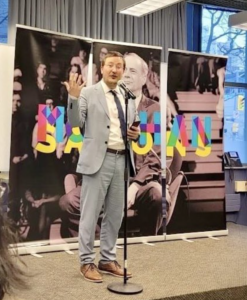
The course is the brainchild of Associate Professor Paolo Granata, (left,) who has a history of engaging in experimental pedagogy. During the pandemic, Granata used virtual reality (VR) technologies to foster experiential learning. He sees this course as a way of expanding these explorations of new media and the learning space.
“This is an exciting opportunity for students to explore the cutting edge of AI and its potential for education,” says Professor Granata. “By experimenting with AI tools in the classroom, we hope to provide our students with a unique and enriching learning experience that will prepare them for the challenges of the 21st century, where AI literacy is key.”
Inspired by the legacy of Canadian philosopher Marshall McLuhan, the Book and Media Studies Program at St. Michael’s College has been at the forefront of experimentation in media education and digital literacy. Based on Marshall McLuhan’s adage “The Medium is the Message”, this course will provide an innovative context through which to investigate the potential for AI to enhance human agency in previously unimaginable ways.
For information about the course, contact usmc.communications@utoronto.ca.
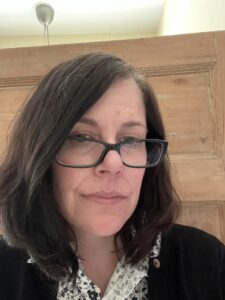
Dr. Callie Callon has joined the Principal’s Office as SMC’s Research Officer. In this role, Callie will provide a range of research resource services for faculty members and for professional librarians. Callie holds a PhD in Christian Origins from the Department for the Study of Religion at the University of Toronto. She is thrilled to be rejoining the St. Mike’s community.
Callon has previously taught courses on the New Testament and Women in the Church at the Faculty of Theology and in the St. Mike’s Christianity and Culture program. She has a strong track record of writing successful academic grants and is looking forward to helping her colleagues further contribute to St. Mike’s already robust reputation for academic excellence. Dr. Callon take up her new role on April 10, 2023.
Dr. Irene Morra cites St. Mike’s academic heritage, its intellectual goals, and its emphasis on community as among the reasons she has agreed to serve as the University’s next Principal, the first woman to hold the position. The undergraduate division of USMC, St. Michael’s College is one of seven colleges within the U of T’s Faculty of Arts & Science.
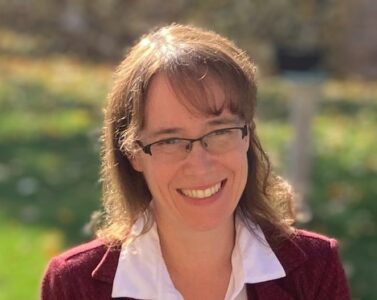
Morra, a long-time Faculty member in English Literature at Cardiff University, is currently a Visiting Professor of English Literature at the University of Toronto. Dr. Morra will assume her role as Principal and will also be appointed to the UTSC (University of Toronto Scarborough) Department of English on December 1, 2022.
“I’m drawn to St. Michael’s because it epitomizes, for me, the very ideal of a university experience,” says Morra, a St. Michael’s alumna who graduated from the University of Toronto with a B.A. in English Literature, Musicology, and French Literature in 1997. After earning an M.A. from Queen’s University’s Department of English in 1998, she returned to the University of Toronto, earning her PhD from the Department of English, in the Faculty of Arts and Science, in 2002.
“Academically, (St. Michael’s is) characterized by an exciting heritage and ever-developing culture of intellectual ambition and persistent, interdisciplinary enquiry,” she observes. “This emphasis is inextricable from the commitment of St Michael’s to creating an environment that helps to develop, foster, and support the overall well-being of every individual within its community and beyond: as the very motto over Brennan Hall reminds us — mousike, gymastike, and eusebeia.”
Morra’s academic and teaching interests are extensive and interdisciplinary. Much of her scholarship encourages new ways of thinking about the ways in which the arts (particularly literature, drama, music, film, and television) engage culturally and aesthetically with each other. It also explores and critiques the wide-ranging artistic, social, and political implications of cultural nationalism, with a particular emphasis on Britain from the nineteenth century to the present day. These various interests have resulted in the publication of four books and a number of scholarly articles on subjects as diverse as Greek and modern drama; intertextuality in the Victorian novel; opera and modernism; British popular music; and the legacy of Shakespeare in contemporary drama, film, and political rhetoric.
Her current book project is Through a Fog Darkly: Britain Noir, a history and analysis of a distinct British noir aesthetic in literature, drama, film, and the visual arts between the 1920s and late 1950s. She is also working on Britain, Canada, and the Arts: Cultural Exchange as Postwar Renewal, a collaborative study of the origins, strength, and legacy of a hitherto overlooked moment of inter-cultural and cross-national exchange.
Morra’s teaching and administrative experience is equally broad. She has taught across every year of undergraduate and graduate study and designed over thirty courses on subjects including Shakespeare’s Comedies, Modern Drama, Twentieth-Century American Literature, Reading and Writing Homosexuality in Postwar Britain, and The Film Musical. As Director of Studies for English Literature at Cardiff University, she oversaw the implementation of new degree programs and undertook full oversight and planning of yearly curriculum offerings. She implemented new structures for students and faculty to come together to discuss course design, student well-being, and the management of student physical and mental health across University structures. Beyond Cardiff University, she has organized major collaborative and interdisciplinary events in London (England) that have brought together academics, creative artists, and major cultural institutions from Britain and North America.
“I find it exciting to be coming to work at a University that is centred on an ideal of community shaped by the diverse gifts and experiences of its individuals and a collective sense of larger social responsibility,” she says. “I don’t see my career goals at St. Mike’s in terms of personal ambition, therefore, but as working to serve this ideal in the midst of ever-changing challenges and opportunities.”
University President David Sylvester cites Morra as an ideal candidate for the Odette Hall office, to lead the College, and work with Dean Melanie Woodin and other colleagues in the Faculty of Arts & Science to provide students with transformational educational opportunities.
“Dr. Morra’s academic interests, her administrative talents, and her appreciation for the unique nature of St. Michael’s will serve the University well,” Sylvester says. “As a leader she brings to the role the experience, the insights, and the imagination to further enhance St. Michael’s standing as Canada’s leading Catholic University.”
Dr. Sylvester also offers thanks to Dr. Nicholas Terpstra for serving as the Interim Principal for the past several months, noting that his presence ensured a smooth and seamless period while the search for the new Principal was conducted.
About the University of St. Michael’s College
The University of St. Michael’s College is a Catholic institution of higher learning that is federated with the University of Toronto, one of the world’s leading research universities. St. Michael’s College is the undergraduate division of the USMC, and one of seven colleges within the U of T’s Faculty of Arts and Science.
Noted public intellectual Dr. Michael W. Higgins is to be the inaugural Basilian Distinguished Fellow of Contemporary Catholic Thought at the University of St. Michael’s College, University President David Sylvester announced today.

The three-year appointment, which begins this month, will see the esteemed academic, writer, and university administrator conducting research for books and articles, including a coming book on Pope Francis, as well as delivering an annual lecture.
“I am delighted that Professor Higgins is joining us at St. Michael’s and look forward to the many contributions he will make to the life of the university,” says Sylvester. “He is a powerful voice articulating the role of Catholic thought in society and the Church, here in Canada and around the world. We are privileged to have him share his vast knowledge and insights with our students, our faculty, and the broader St. Michael’s community. It is most appropriate that Michael will hold this distinguished fellowship named for the Basilian Fathers, founders of St. Michael’s and educational leaders in Canada for almost to two centuries.”
For Higgins, the appointment marks a return to St. Michael’s.
“What a special joy and sweet symmetry to return to the university setting where it all began: St. Mike’s,” Higgins says. “In the late 1970s I was designated a Special Sessional Lecturer and commenced my fruitful—for me, at least—association with the faculty of Theology and the Christianity and Culture Program. I welcome the generous offer to return, have many projects on hand—foremost of which is a book on Pope Francis for House of Anansi Press—and look forward to being part of the life of our national leader in Catholic higher education.”
Higgins is Distinguished Professor of Catholic Thought Emeritus, Sacred Heart University (CT), Senior Fellow of Massey College, author of numerous academic studies and biographies, many award-winning and several translated into French, Italian, German and Norwegian, and a regular contributor to The Tablet (London), Commonweal (US) and The Globe and Mail. He is an award-winning CBC documentarian, has a doctorate in English and is an Affiliate Professor in the Oblate School of Theology (San Antonio). He is a past president of three Canadian Catholic universities and has been awarded two honorary doctorates.
Systematic theologian Sr. Ellen Leonard, CSJ, is being remembered by the St. Michael’s community as a groundbreaking theologian of “irrepressible joy” who cared deeply for the Church, her students, the role of women, and her religious community.

Sr. Ellen died Thursday, August 18 at the age of 88, in her 71st year of religious life. Entering the Sisters of St. Joseph at the age of 17, she taught elementary school for many years before becoming one of the first women in Canada to study theology, earning her doctorate from St. Michael’s Faculty of Theology in 1978. Having served as a lecturer during the last year of her doctoral studies, Sr. Ellen became an assistant professor in 1978, an associate professor in 1982, and a full professor in 1991. She would remain a fulltime member of the Faculty of Theology until her retirement in 1999, at which time she became an emerita professor.
Her teaching and research focused on Roman Catholic modernism, and feminist and ecological Christologies. Her many publications include three books focusing on the modernist movement of the early 20th century: George Tyrrell and the Catholic Tradition; Unresting Transformation: The Theology and Spirituality of Maude Petre; and Creative Tension: The Spiritual Legacy of Friedrich von Hugel.
“Sr. Ellen Leonard was a great woman in many ways–in her teaching and leadership at the Faculty of Theology, and in her advocacy for greater inclusivity of women in the Church,” says Regis-St. Michael’s Dean Jaroslav Skira. “She was also a deeply kind person and I feel very privileged to have known her.”
Former student Mary Ellen Chown, who has written a chapter on Sr. Ellen in the work Claiming Notability for Women Activists in Religion, says, “I had the privilege of being a student in Ellen’s course on ‘Feminist Approaches to Systematic Theology’ in the fall of 2000. What stays with me is Ellen’s deep respect for each of her students and her enthusiasm in sharing the rich diversity of global voices in feminist theology. Ellen’s teaching methodology encouraged us to reflect on our own life experience as a source of theology while integrating an academically rigorous feminist critique into our understanding.”
Sr. Ellen’s colleague, eco-theologian Dr. Dennis O’Hara, wrote the citation when the University of St. Michael’s College awarded her an Honorary Doctorate of Sacred Letters in 2014.
“For me, Ellen was an outstanding and compassionate educator, a skillful and kind mentor, a thoughtful and experienced colleague, and a dear and valued friend,” O’Hara recalls. “She was an extraordinary positive influence in so many lives.”
Former University president Dr. Anne Anderson, CSJ, says it was “a pleasure and a privilege” while serving as the Faculty of Theology’s Dean to have Leonard as a member of the Faculty.
“Ellen coupled her studies in Modernism with the teachings of Vatican Two and began to write and publish in the area of ‘Experience as a Source for Theology.’ The injunction of Vatican Two to “read the signs of the times” supported her life-long interest in the development of feminist theology as well as the scholarship of those who were writing and researching in this area,” Sr. Anne says. “Ellen also viewed ecological issues as one of the signs of the times that required careful attention. As a colleague, Ellen was an unfailingly generous supporter of the Faculty of Theology and its mission. Her many students received her full attention and support as well as the benefit of her continued scholarship.”
Sr. Ellen’s efforts will continue to inspire those who knew her and her work, says Chown.
“Ellen’s prophetic wisdom abides in her significant body of work, in her ongoing inspiration in the lives of her students and in the work of the Catholic Network for Women’s Equality (CNWE), which she founded in 1981, and for which she remained a lifelong mentor and supporter,” she says. “I will remember Ellen as a woman of transforming faith and grace who embodied hope for a renewing, inclusive Catholic Church, for justice in the world and for the flourishing of all creation – a woman who engaged this sacred work with integrity and an irrepressible joy.”
In lieu of flowers, donations may be made to Fontbonne Ministries and you can click here for more information.
The Toronto School of Theology (TST) is pleased to announce the appointment of Rev. Dr. Darren Dias, O.P. as the new Executive Director of TST. A long-time member of the University of St. Michael’s College community where he has served in its Faculty of Theology since 2008, Dr. Dias will assume his duties as Executive Director on September 1, 2022, while continuing his research and teaching as an Associate Professor of Systematic Theology in the newly formed Regis St. Michael’s Faculty of Theology.

“Dr. Dias is a firm believer in the ecumenical mandate of the Toronto School of Theology and will offer strong leadership to our unique consortium of theologates,” says Rev. Dr. George Smith, CSB, who is Chair of TST’s Board of Trustees. “The board was unanimous in its decision and I am pleased to welcome him to TST.”
The first Faculty member from St. Michael’s to hold the position, Dr. Dias’s appointment to TST comes just as the theological faculties of USMC and Regis College are brought together, an exciting new venture in TST’s 52-year history, notes Regis St. Michael’s Dean, Jaroslav Skira.
“This is a positive development for all,” says Skira.
Dr. Dias earned his doctorate under the supervision of Prof. Robert M. Doran, S.J., where he received the Governor General’s Gold Medal for Academic Excellence. Dr. Dias’ current research and publications revolve around interreligious dialogue, relations and decoloniality.
Currently the President of the Canadian Theological Society, he is also now working on a project with Dr. Stephan Van Erp, funded by a Templeton Foundation grant, entitled Metaphysics of Contemplation: Religious Life and Form of Thought.
As a member of St. Michael’s Faculty, Dr. Dias took on numerous administrative roles. At TST, he has served on the Basic Degree Council and the Graduate Studies Council. He also serves on the University of Toronto Faculty Association’s Gender and Equity Committee. In addition, Dr. Dias serves in various ecclesial leadership roles and committees, nationally and internationally.
Dias succeeds Dr. Pamela Couture, the Jane and Geoffrey Martin Chair in Church and Community at Emmanuel College, who assumed the role of TST’s Executive Director in 2020. Among her leadership accomplishments, Dr. Couture led the TST members through the rigorous UTQAP review process during her tenure.
“I would like to extend my sincere thanks to Dr. Pamela Couture, who served TST so well during the extraordinary circumstances created by the COVID-19 pandemic,” says Dr. Smith. “We are grateful for all she has brought to the position.”
The Toronto School of Theology, founded in 1970, is a consortium of seven theological schools, each accredited by the Association of Theological Schools in the United States and Canada. Academic standards are consistent with those of the University of Toronto, which is regularly ranked among the top 25 research universities in the world.
TST’s seven member colleges are: Emmanuel College (United Church of Canada), Knox College (Presbyterian Church in Canada), Regis College (Roman Catholic: Jesuit), St. Augustine’s Seminary (Roman Catholic: Diocesan), University of St. Michael’s College, Faculty of Theology (Roman Catholic: Basilian), University of Trinity College, Faculty of Divinity (Anglican), and Wycliffe College (Anglican, Evangelical).
In addition, TST has connections with three affiliated member institutions: Conrad Grebel University College (Mennonite) at the University of Waterloo, the Institute of Christian Studies (Christian Reformed) in Toronto, and NAIITS: An Indigenous Learning Community, based from Prince Edward Island.
The TST consortium offers a full range of professional and academic degrees. Some are primarily professional while others are oriented to general theological studies or research. All degree programs operate at the post-baccalaureate level, and a number of degrees are conferred conjointly by the University of Toronto.
“The most important part of SMC Orientation is showing students that they belong here.”
-Alessia Baptista and Sophia Poulimenakos, Orientation Coordinators 2022
Alessia Baptista and Sophia Poulimenakos are this year’s Orientation Coordinators. Alessia is a fourth-year student studying English with minors in French and Anthropology, while Sophia is a fifth year studying Political Science with minors in Sociology and Music History. Orientation holds a special place in their hearts as they both have been a part of orientation since their first day at SMC.
When we were told we’d been given the green light to have a fully in-person Orientation this year you could not contain our excitement. Both of us were orientees in the pre-pandemic Orientations (in 2018 for Sophia and 2019 for Alessia) but neither of us knew that this amazing event that changed our lives would be held in an entirely different way when we chose to get involved. When we signed up as leaders in 2020, the world turned upside down, and the need to find community became even greater. Orientation is special: we would argue it’s the most special and important event any university has to offer. It presents an opportunity like no other to show our new students that SMC is their corner of the campus: a corner that belongs to them and will always be there for them. In times like these, when community building is more valuable than ever, we did not take the responsibility of planning the first in-person Orientation in two years lightly.
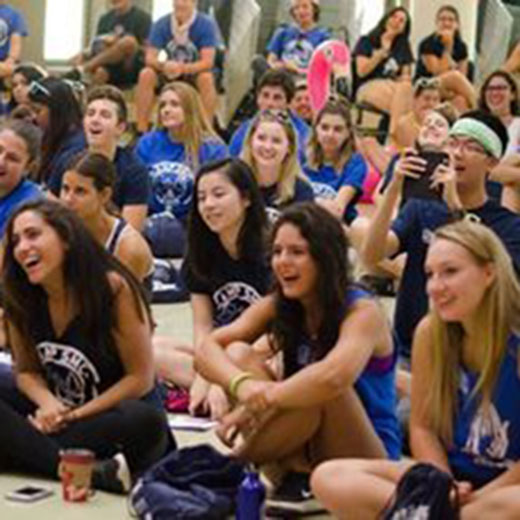
If you asked each of us what the most important part of Orientation is, we wouldn’t say the countless nights planning our events schedule, calling numerous vendors, or even the days we spend contemplating the smallest things (we’re overthinkers; what can we say?). The most important part of Orientation is ensuring each student knows that they belong here. No matter where they come from or who they are, SMC has a place for them.
But it’s only so much to make such a bold statement; we had already found our places within this community, so this year we made it a top priority to implement everything we could to ensure everyone can see themselves reflected in this community.
We started small, right down to our team. Our main concern became who would be the first people welcoming our students to SMC, and we wanted everyone to see themselves reflected in student leadership. We took a lot into consideration, from our younger staff taking on larger roles to ensuring not only those willing to scream at the top of their lungs in front of a crowd would apply for roles, and even encouraging first-time student leaders into our team. Our first step in creating a community where students feel they belong is representing them at the onset. When a team looks and acts like the people they are leading, others feel like leadership not only welcomes them, but needs them to function to their fullest capacity.
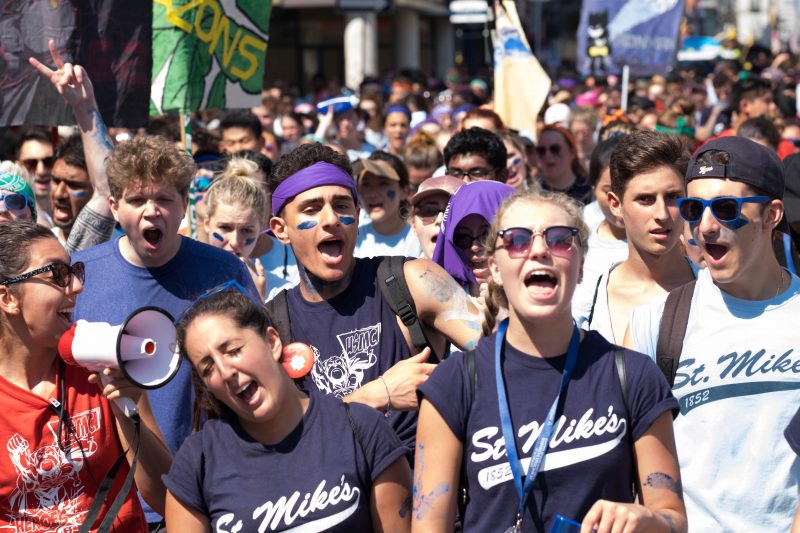
Our next step became looking wider than our own community, even wider than our own country. With both of us being domestic and commuter students, Toronto life came more naturally to us, but that wasn’t the case for many of our international friends. We started holding debriefing sessions with our staff, mainly targeting our international staff members, asking them what we could do better and, honestly, what we weren’t considering, having always lived in Ontario. Resources were huge, from small things such as where to buy groceries or “what even is Presto card?” to much larger things like buying an apartment in the city, applying for a SIN number, or finding mental health and community resources in the city when students felt alone.
We came to the collective conclusion that SMC Orientation was not doing enough to highlight how hard it is to move your whole life to a new country many incoming students had never seen before. The solution was to implement tours of Toronto, international student workshops built right into our Orientation programming, and a Cultural Club Showcase exceeding what SMC can provide. Designed by international students for international students, we granted our team the ability to take the lead on creating the programming they knew would have helped them. With this, our hope was that it would give our international population the chance to even have just a little more ease in their transition.
Of course, Orientation is not without tradition, and the green light to have everything in person meant we got to bring not only new ideas to the forefront but also old ones that our older staff had come to miss. With our theme this year being SMC: Treasure Island, the opportunity to bring back events became even easier. With campus tours disguised as campus-wide scavenger hunts, Zumba parties in the Quad encouraging exercise for their treasure hunt adventure ahead of them, and a Formal at the Hockey Hall of Fame showcasing operation “find the crowned gem” – in this case finding the Stanley Cup and taking a picture with it. All this work to find the most important treasure of them all – friendship! Okay, not just friendship, but the chance to be crowned the winner of the O-Cup and have their team’s name immortalized at SMC forever. This year’s theme is reflective of the very thing we wanted to portray for this year’s Orientation, on a treasure hunt you may feel like you’re on your own towards the goal of finding “treasure” – but what you find along the way is people who want to help you and support you and your goals.
SMC Orientation has always been about team building and finding community, but this year we wanted to make sure that we understand that a community is only as strong as each individual within it. The art of planning the first fully in-person Orientation in two years comes down to combining the new with the old–much like our staff and students–and it becomes our job to ensure everyone finds their place within the place where we found ours.
Read other InsightOut posts.
Dr. Nicholas Terpstra has been appointed Interim Principal of St. Michael’s College effective July 1, 2022. A distinguished scholar of the Renaissance period, Terpstra is a Professor of History at the University of Toronto who has previously served as chair of both the departments of History and Italian Studies. He will hold the position while the President and the Principal’s Search Committee conclude their work in the appointment of the next Principal of the College.
Terpstra, whose research examines the intersection of politics, religion, gender, and charity in Renaissance Italy, has taught at the University of Toronto since 1998. His current research is focused on two main areas: a digital mapping project based around Renaissance Florence, and a study of of how different social, cultural, and religious groups used spatial and sensory boundaries to navigate their relations with each other in 16th-century Tuscany.
“We are delighted to welcome Nick Terpstra to Odette Hall,” says St. Michael’s President David Sylvester. “He is an internationally recognized scholar, a seasoned administrator, and a wonderful colleague known to many here at St. Mike’s.”
In 2017, he received an honorary Doctor of Sacred Letters degree from Regis College.
Terpstra will take on the interim post as Professor Mark McGowan completes a two-year appointment in the position this month.
McGowan, who was previously St. Michael’s Principal from 2002 to 2011, will be on research leave from July 1, 2022 to June 30, 2023. He will continue to serve as Senior Advisor to the President, Catholic Education, and will return to Celtic Studies and the History Department following his leave.
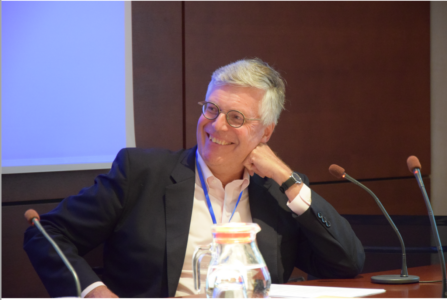
In advance of National Indigenous Peoples Day on June 21, Dr. Mark McGowan, Professor of History and Celtic Studies and the Interim Principal of the University of St. Michael’s College for the 2020-2022 academic years, celebrates the value of a gift made by the Haudenosaune peoples to Irish migrants who arrived in Canada, fleeing the famine.
The Irish Famine (1846-1852) was one of the most traumatic events in modern Irish history. With the repeated failure of the potato crop, upon which two-thirds of Ireland’s 8 million people depended, the social and economic fabric of Irish life was torn to pieces. By the early 1850s, one million people had perished from hunger and disease and another 1.5 million simply left Ireland. One of the unsung episodes of the Famine was the donation of $179 (the figure is disputed) or just over $6,300 USD in todays currency, from the Choctaw Nation in the USA to Irish relief. There is much irony in this act of generosity from the Choctaw. They themselves were destitute having been forced to relocate from their traditional lands in the southeastern United States, to the designated “Indian Territory” in present day Oklahoma. From 1831-1833, this “Trail of Tears” initiated by President Andrew Jackson, himself of Irish descent, caused the deaths of thousands of Choctaw, Creek, Cherokee, and Seminole First Nations. Yet only fifteen years later, the Choctaw, in their own poverty, recognized the plight of the Irish, identified with it, and scraped up what meagre resources they had, to share with their fellow human beings living an ocean away. According to Choctaw historian and writer LeAnne Howe: “buried deeply within the Choctaw body politic is a sense of giving shelter, food, and/or aid to our relatives, friends, and allies. Ima, giving, is a cultural lifeway.” The Irish in Ireland have not forgotten the gift and have erected a large monument, highlighted by a massive circle of eagle feathers, to the Choctaw gift, named Kindred Spirits, near Cork.

What has gone virtually unsung in Canadian history is a similar gift, made by the Haudenosaune peoples to Irish migrants who arrived in Canada, fleeing the famine. In 1847, the traditional Mohawk territory of Hochelaga, then Montreal, was the scene of tremendous suffering and death. Afflicted with typhus and other serious infections, thousands of Irish migrants were herded into hastily built sheds at Point St. Charles, just east of the downtown area. The Mohawk Nation of Kahnawake, south of the city on the St. Lawrence River, immediately responded to the Irish, bringing food from their lands to the sheds. In addition, despite living in poverty themselves, the Mohawks took up a collection for Irish relief in Montreal, raising about $150, or just shy of $5,000 in today’s dollars. This was an enormous sacrifice for a people that had been marginalized and made sedentary near the great Island that once housed their council fires. At the time, Governor General, Lord Elgin, wrote to the Colonial Office indicating that “several Indian tribes expressed a desire to share in relieving the wants of their suffering white brethren.” Little else was said and the great kindness of the Mohawks was virtually forgotten in Canada. In fact, Canada’s Irish soon became part of the vanguard of settler-Colonial “nation building.” In Ireland, however, both the Lord Mayors of Dublin and Belfast have come to Canada to formally thank the Mohawk people for their great generosity in Ireland’s time of need. For her part Mohawk chief Christine Zachary-Deom, remarked during a Famine commemoration in Montreal, that the Haudenosaune and the Irish shared many qualities—they are “resilient, determined, and tough people.”
It is time that we look less to the “nation building” motifs that have so typified the writing of our history, and look for moments where “Kindred Spirits” prevailed. This might be one other way of seeking truth and affecting reconciliation. Such spirit was evident in 2020, when the Irish national lacrosse team gave up their place at the coming World Games, so that the Iroquois Nationals could play in their place this coming year in Birmingham, Alabama. The Nationals had been denied a place because they, according to the World Games administrators, were not a sovereign nation.
The need for generosity of spirit is ongoing.
St. Michael’s Principal from 2002–2011, Dr. McGowan is an historian renowned for his work on the Catholic Church in Canada and the Great Irish Famine, as well as the lasting impact that the Famine’s mass migration had on Canada.
Dr. Jaroslav Skira, a seasoned academic with extensive administrative experience, has been appointed inaugural Dean of the new Regis-St. Michael’s Faculty of Theology.
Dr. Skira, whose research interests and expertise include modern Eastern Christian theology, Catholic and Eastern Orthodox ecumenical relations and the Second Vatican Council, has been appointed for a five-year term. He assumes his duties on July 1, 2022, when the federation is formally launched.
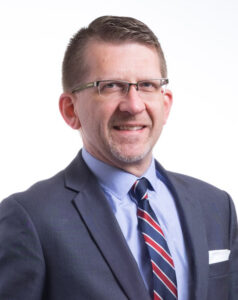
Currently a member of the Regis College Faculty, he has also taught at St. Michael’s, including in the undergraduate Christianity and Culture program, the Metropolitan Andrey Sheptytsky Institute of Eastern Christian Studies (MASI), and the L’viv Theological Academy, precursor to today’s Ukrainian Catholic University, Ukraine.
From 2011 to 2018 he also served as the Founding Director of the Graduate Centre for Theological Studies at the Toronto School of Theology, the ecumenical federation of Christian theological schools to which both St. Michael’s Faculty of Theology and Regis College belong.
“I am really delighted to be part of this new chapter in the life of both Regis and St. Michael’s, of further advancing the close collaboration that has been going on for years between these two leading Catholic academic institutions,” says Dr. Skira. “I have great confidence that the new federation will more fruitfully contribute to the theological academy, and that it will enhance student experience and excellence in the various vocations and ministries that our students pursue in the church and in the world.”
Dr. Skira, who served as interim director of MASI in 2018, will both teach at and supervise some of the institute’s Advanced Degree students.
His appointment comes following a “strong recommendation from the search committee,” says St. Michael’s President David Sylvester. “The committee was particularly struck by Dr. Skira’s administrative experience and felt he will offer strong leadership as Regis-St. Michael’s is launched. I am delighted to be working with him as we begin this exciting new era.”
Regis President Thomas Worcester, SJ, agrees.
“The search committee that sought the right person to serve as the inaugural dean of the Regis-St. Michael’s federation merits gratitude for its astute choice,” says Dr. Worcester. “These are exciting times for Regis and St. Michael’s. With Professor Skira as its dean, our federation can now move ahead in achieving its goals.”
A Memorandum of Agreement was signed in October, 2021 which provides for the federation of Regis College and the University of St. Michael’s College for the purpose of “forging a world-class centre of excellence in Catholic theological study, whose mission is to promote teaching, research and formation to serve the needs of the Church and society, in Canada and globally.”
Dr. David Sylvester is the 8th President and Vice-Chancellor of the University of St. Michael’s College in the University of Toronto. A professor of medieval social and economic history, he holds an M.A. and a Ph.D. from Fordham University, New York City and has taught for three decades in universities in Canada and the United States.
Finding Hope When the Rains Come

The academic term is at an end. We are heading into the holidays. Christmas is but a week away, and this has been a year like no other…except for, well, maybe last year.
Yes, it’s been another long year of starts and stops, another year of disappointments, another year of, “we had so many plans, what happened?”
Or, as the Nobel laureate Seamus Heaney complains in his poem Holly, “we went looking for Christmas holly and it poured rain, and we got really soaked”:
it should have snowed.
But here we are in the fourth week of Advent, preparing to celebrate the coming holidays. And, our hope is not diminished. This year, like last, St. Mike’s found new ways to work, to study and to live together. I am most grateful for my colleagues, our students, our trustees, and our alumni for the love, kindness, and creativity that made this such a successful year on Clover Hill. The fruits of their labours are many.
Or, if I may return to Seamus Heaney again, as he always has the best words:
Now here I am, in a room that is decked
With the red-berried, waxy-leafed stuff.
And I almost forgot what it’s like
To be wet to the skin or longing for snow.
May all of you enjoy a safe and happy holiday, and may you and your family enjoy many blessings together in the New Year.
From all of us here at the University of St. Michael’s College.

David Sylvester
Read other InsightOut posts.
St. Michael’s and University of Toronto Professor Emeritus Gino Matteo passed away this week. A member of the SMC Class of 1959 and Director of the Alumni Association at SMC from 1966 to 1968, Prof. Matteo was heavily involved at St. Mike’s throughout his life. Below, Interim Principal Mark McGowan remembers Prof. Matteo’s legacy.
Professor Gino Matteo spent much of his life at St. Michaels College. He was in the SMC class of 5T9, and then undertook graduate work in English. He returned to the SMC Department of English, where he taught alongside one of his mentors, Marshall McLuhan. A specialist in Shakespeare, and in 1974 he published Shakespeare’s Othello: The Study and the Stage, 1604-1904, which was based on his doctoral dissertation. His interests in English literature were not restricted to the Elizabethan period, but his fascination with Nell Gwyn, longtime mistress of King Charles II, inspired him to write a stage play which earned him top honours for a playwright at the Moon Dance Festival in Boulder Colorado. Gino also was interested in film and media and was one of the directors of the Cinema Studies program, then based out of Innis College. Despite this secondment across campus, he always kept his office in Elmsley Hall. Gino and I met when I first arrived at St. Mike’s in 1991. When he discovered I lived in Whitby, he wanted to know if I had ever visited Dom’s Auto Wreckers in Oshawa—Gino, I discovered, was an antique car buff and made frequent pilgrimages there for parts for the classic cars he was rebuilding.
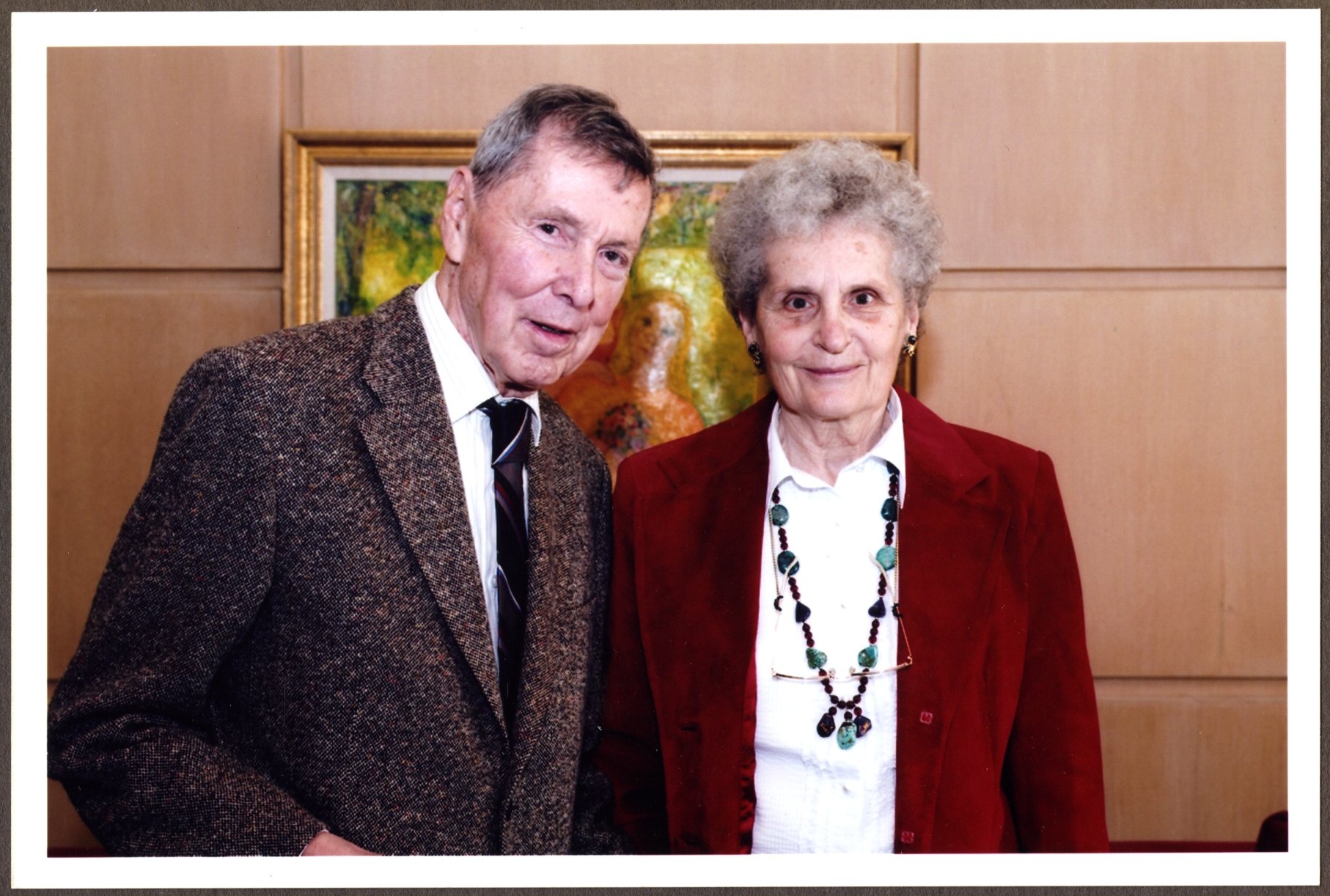
Friends, colleagues, and former students are remembering Professor Emerita Janine Langan as a woman deeply devoted to her faith, family, academics, and students. Dr. Langan, who founded St. Michael’s Christianity and Culture Program, died suddenly on Saturday, December 11, 2021 in Toronto. She was 88.
A native of France, Dr. Langan received her first degree at Smith College in the United States, followed by further studies in France, and then a PhD in Comparative Literature from the University of Toronto. She was particularly noted for her course on the Book of Job and the question of why innocents suffer.
“She was indefatigable in her work to promote the study of Christianity from a variety of academic perspectives and in 1979 she lobbied SMC and founded the Christianity and Culture Program,” recalls Interim Principal Mark McGowan, who met Langan when he arrived at St. Michael’s in 1991 to teach. Dr. Langan served as the program’s coordinator from 1979 to 1987.
“She gathered a multidisciplinary teaching cadre which included her husband Thomas, who was in the SMC/UofT Philosophy Department, and Dr. Kenneth Schmitz, a fellow philosopher from Trinity College,” says McGowan.
Describing Langan as possessing “a forceful but charming personality” he says that she “laboured tirelessly for her fledgling program.
“Above all she was dedicated to her students and founded a club called the St. John Scholars, where students could deepen their studies in Christianity through service, retreats, and travel (to Rome,)” he notes. “Janine particularly loved for her students to access Christianity through art, and I remember her long conversations with Henri Nouwen, with whom she shared a love of Van Gogh. She invited Nouwen to teach several guest lectures in the program.”
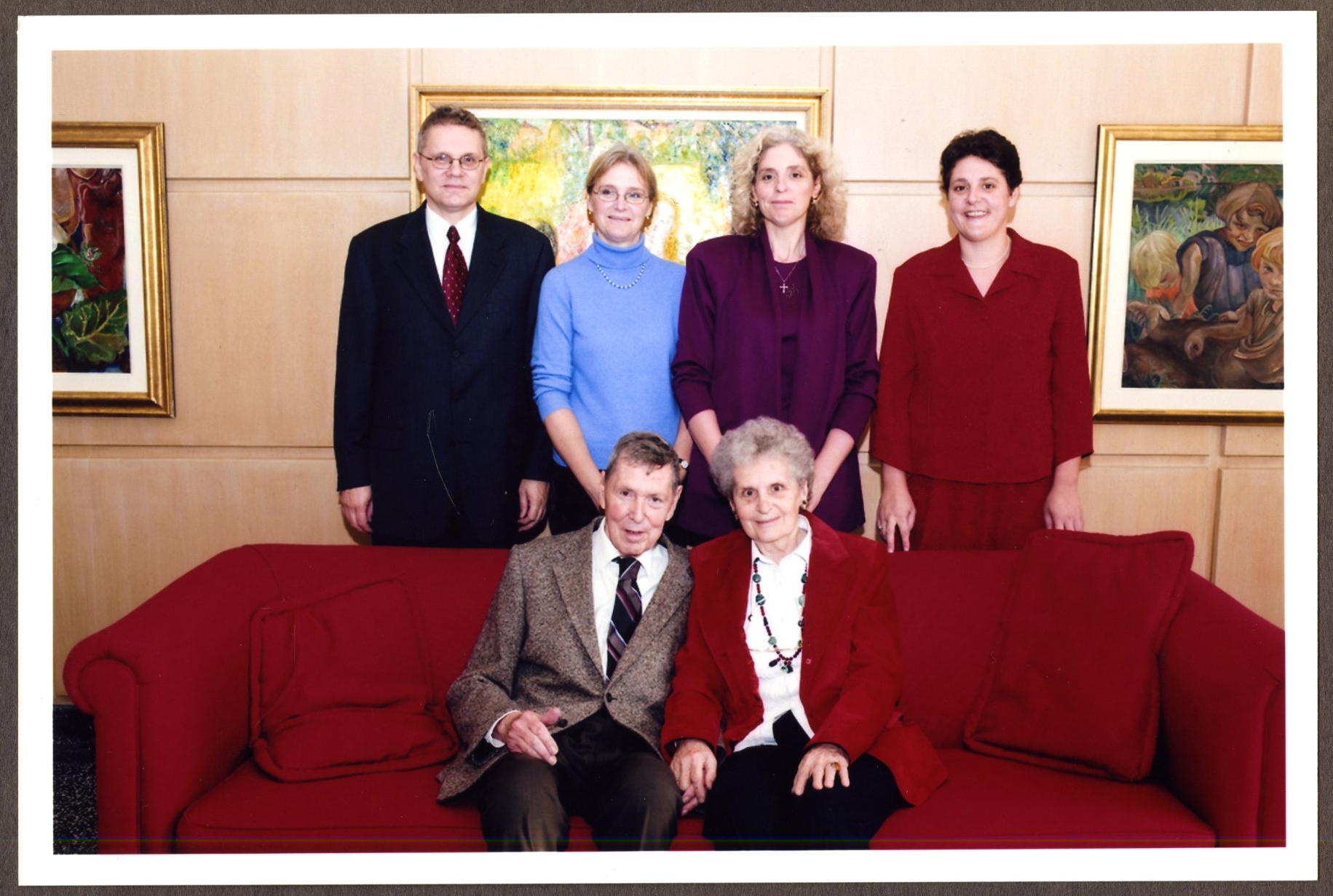
For colleague Dr. Giulio Silano, who taught alongside Langan in the Christianity and Culture Program, “what remains is the irreducible originality of her vision for C&C.
“Against the dominant trends in Catholic institutions of higher learning of programs that presented lay people with dumbed down versions of programs meant for clerics, Janine devised a program that took seriously the call of the laity to holiness and so began with the requirements of the lay state,” he says. “Her insistence that the artistic, literary and historical dimensions trumped the easy theological option so often taken by other institutions has proven difficult to maintain in its integrity against the easier option, but it retains its intrinsic originality and fascination.”
Daughter Claire Langan describes her mother’s approach to teaching as “a true vocation, and one that went beyond the traditional four walls of the classroom.”
Adding that her mother’s students weren’t just those enrolled at St. Michael’s but pretty much anyone she encountered, from priests and seminarians to lay people of all ages, Claire recalls her mother regularly opening the family home to discussion groups for a variety of people.
“It was wonderful that St. Mike’s facilitated the creation of this program. My mother was dedicated to passing on God to the next generation,” she says.
Alumna Joe-Anne Boyle, a Christianity and Culture graduate from the early 1990s, describes the program as “introducing people to the treasures of the Church. It awakened the spirit of the Church for people.”
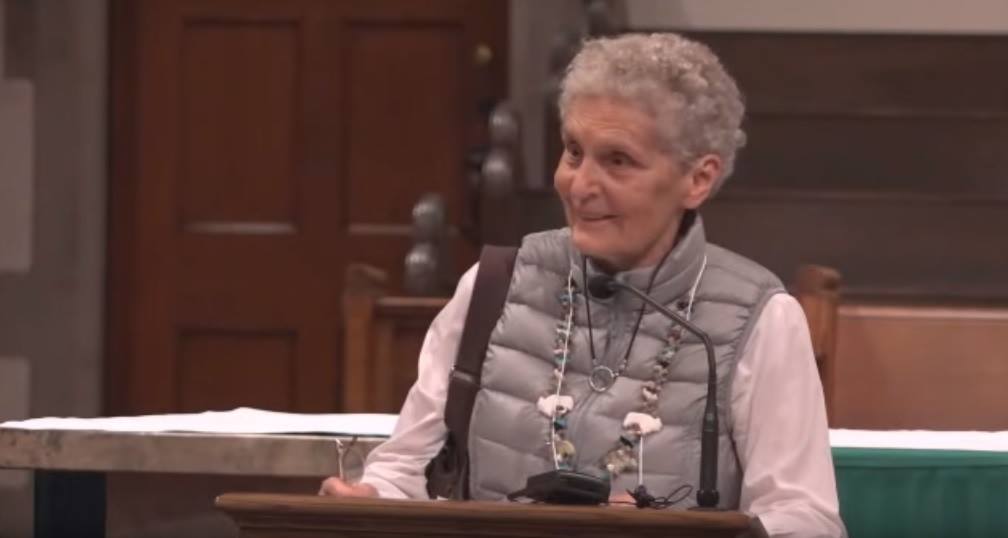
Boyle, who remained friends with Langan over the years, remains particularly grateful for her mentor’s firm belief in experiential learning, calling her a groundbreaker, and says she received far more than she expected from the program.
“I entered St. Mike’s thinking I was going to have a great professor but I also discovered a great friend.”
For Boyle, Langan was someone who took firm stands but had respect for all, someone with impressive “moral fibre.”
Today Boyle is a high school teacher and remains particularly impressed by the new Christianity & Culture graduates she meets as colleagues.
“They are mature and well versed in the history of the teachings of the Church, as well as appreciative of the Church’s beauty.”
Collegium Member Msgr. Sam Bianco knew Dr. Langan from his time as rector of St. Michael’s Cathedral and then as pastor of Corpus Christi Parish in east-end Toronto.
“We would often chat about things theological after Mass,” he recalls. “She spoke of teaching students about ‘critical fidelity’ to their faith and cared not only about the intellectual wellbeing of her students but also about them personally and what was happening in their lives. She was a true woman leader in the Catholic Church.”
Over the years, Dr. Langan was honoured numerous times. In 2006, she and her husband Thomas received papal honours for their contributions to the Church. She was named a Lady of St. Sylvester for her work in the Christianity & Culture Program, as well as for her adjunct work at St. Augstine’s Seminary, while her husband Thomas was made a Knight of St. Sylvester for his work in Catholic education.
In 2016, she was presented with the Catholic Teachers’ Guild Jean-Baptiste de la Salle Award for her work in Catholic education.
The year 2017 saw the introduction in the annual Langan Lecture in Christianity and Culture at St. Michael’s.
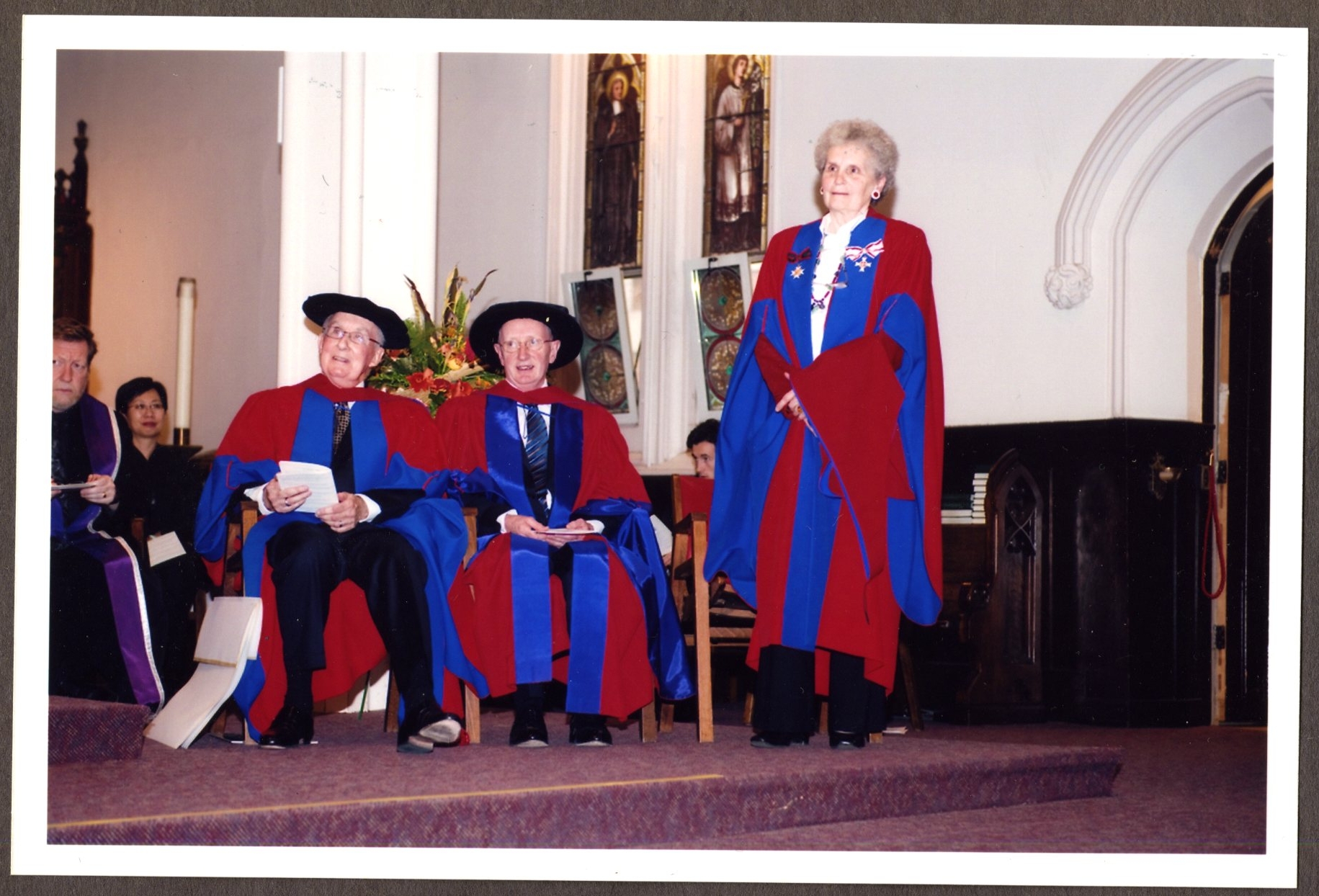
Recently, Dr. Langan noted in a public address that “…at university, you can learn to expand your community from family and friends … to all of mankind.”
Daughter Claire notes that her mother taught right up until her death, serving on the faculty of Mary, Mother of God School in Toronto, an independent Catholic school.
Silano echoes the notion of Langan’s life remaining full.
“Janine…was still volunteering four days a week to teach high school kids at Mary Mother of God school…With one of her book clubs, she had just finished a multi-year reading of the Divine Comedy. People who had been her students four or five decades ago were still on her prayer list and in steady contact with her, seeking her wisdom as they tried to make sense of their mid-life (or later) circumstances.”
Predeceased by Thomas in 2012, Langan leaves five children and 11 grandchildren.
A funeral Mass is to be celebrated on Monday, Dec. 27 at 10 a.m. at St. Basil’s Church.
University President David Sylvester says the University is considering ways to honour Dr. Langan when COVID restrictions ease. Plans will be announced in the coming months.
A key priority of St. Michael’s 180 strategic plan is providing a supportive community for all its members.
The Varsity talked to Felan Parker, an assistant professor in the department of Book and Media Studies at St. Michael’s College, about why he didn’t have late penalties for any assignments in his courses this year.
“To me, it felt like a moral imperative to not penalize students during such a difficult time,” Parker said. Learn more about how Prof. Parker prioritizes student mental health and wellness in the article.
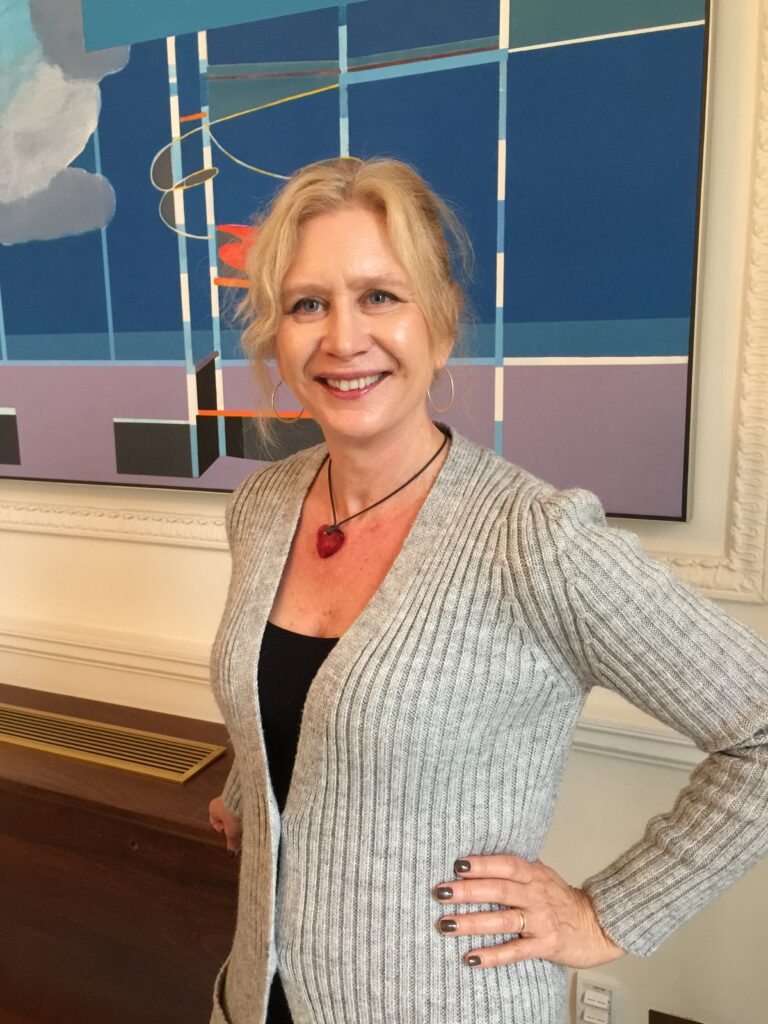
St. Michael’s new Executive Director of Advancement brings extensive fundraising experience at one of the country’s top universities to her new role.
Lisa Gleva, who begins her duties at the University of St. Michael’s College on December 13, has worked in York University’s Division of Advancement since 2005, most recently as the Executive Director of Principal Giving, Donor Relationships and Stewardship.
“Lisa is a talented addition to our team and will offer our Department of Advancement and Alumni Affairs strong leadership and a depth of expertise,” says University President David Sylvester. “With her clear understanding of the unique issues and opportunities of university life Lisa will serve St. Mike’s well.”
Gleva says she is honoured to be taking up her new position, calling St. Michael’s an exceptional university dedicated to providing students with an extraordinary education within a welcoming, diverse community.
“I focus both professionally and personally on our collective wellbeing as a community, and I’m excited to engage with students, alumni, faculty, staff and donors as we work together as a powerful voice for social and environmental justice and the advancement of the common good,” she says.
“Investing in the student experience has incredible returns,” Gleva adds. “With a degree from one of the top-ranked universities in the world, infused with compassion and bolstered by a vibrant, tight-knit community and lifelong relationships, our graduates will be successful leaders whose commitment to service sets them apart.”
Prior to York University, she worked at United Way and focused on building resilience within the social services sector in York Region.
Gleva also has an extensive volunteer life. She currently serves on the board of Cedar Centre, a charity that provides therapy for people who have experienced childhood trauma, and spent three years as a member of the Ethics Resources Committee of the AFP Greater Toronto Chapter.
She also serves on the board of Friends of Killarney Park, enjoying the provincial park as a place to hike and reflect.
Fr. Andrew Summerson, S.Th.D., is an Assistant Professor of Greek Patristics with the Sheptytsky Institute of Eastern Christian Studies in the Faculty of Theology in the University of St. Michael’s College.
History and Theology as Contemporary Wisdom from the Ancient Desert
In Athanasius of Alexandria’s 4th century “best seller,” Life of Anthony, we are told that upon his parents’ death, he begins soul-searching. An interior inquietude overtakes him and he starts to wonder about the writings of the New Testament. He ponders the apostles’ single-hearted mission to leave everything and follow Christ. He also considers the life of the early Church documented in Acts, where the company of believers laid everything at the apostles’ feet and put it in service of others (Acts 4:35). Anthony’s mental ruminations are confirmed one day in church, when he hears the proclamation of the Lord’s words to the rich man in the Gospel: “Sell everything you have and give to the poor” (Mt 19:21). With this, Anthony offloads his inheritance and takes to the desert. He learns from elder ascetics, practices prayer unceasingly, wrestles with the devil, keeps vigil in caves, heals the sick, and confutes philosophers.
Athanasius explains that Anthony, “a man in the flesh,” is assisted in all these efforts by the “Lord who for our sakes became flesh.” This is a rather loaded statement that needs untangling. Athanasius, the writer of the Life of Anthony, is also one of the greatest theological minds of the early Church, who forcefully defended the faith articulated at Nicaea in 325. The council aimed to narrate precisely who is this “Lord who for our sakes became flesh.” This Lord is of one substance (homoousios) with the Father, a detail still recited every Sunday in the Nicene Creed today, or in the Byzantine tradition, to which I belong, it is sung at every Divine Liturgy.
What is at stake for Athanasius in this doctrinal battle is not simply an ethereal philosophical dispute about the nature of God but rather the accurate reception of God’s revelation to us “according to the Scriptures.” Nicaea means the difference between worshiping a false idol or worshiping the living God, who providentially connects the dots between Anthony’s initial interior stirrings and the public proclamation of the Gospel. The Life of Anthony details the process of the ascetic’s transformation from a quiet kid to a heroic saint, “initiated in the mysteries and filled with the spirit of God.”
Nicene theology creates the conditions for more Anthonys to spring forth in this world. Anthony has internalized Nicaea and proclaims it in his own flesh. If Jesus is a human creature, he is no more than a model to imitate. On the other hand, if Jesus is God who takes on a human nature, he offers human nature a new possibility: to bear “all the fullness of God” (Eph 3:19).
Perhaps Athanasius’ greatest contribution as a theologian is his ability to bridge the gap between the heights of doctrinal controversy and grassroots spirituality. As a historical theologian, I specialize in gaps, particularly gaps between the past and the present. My principal sources are figures from the first millennium. I engage them precisely because it is here, in the cauldron of the first millennium, the language for naming God’s activity in Scripture is formulated for ages to come. These writers developed a grammar that Christians are heirs to. Truthfully, one can speak a language without knowing the grammar. Infants surely begin to formulate sentences long before they can diagram the contents of their principal parts. But learning grammar shows us the sheer power of language, exposing the heights and depths of what words can do when used to their full potential. For us, the grammar of the Nicene Creed may just be a common place prayer that is muttered through Mass. For Athanasius, the creed is the very condition that provides a way for saints to emerge in this world, charged with the power that comes from “the Lord who was made flesh.”
We are continually tempted to forget how we learned Christian language. In our own speaking, we lean on clichés, phrases coined by others so often repeated they have lost their meaning. Such repetition excuses us from the burden of thinking. One must not forget that clichés come about in the first place because they are powerful statements that conjure up popular agreement and therefore are worth repeating. Studying the sources of Christian language ensures that the truths of the faith do not become vacuous statements but remain powerful and transformative. When properly interrogated, reading the texts of the ancient dead ensures that we can hear them as clearly as Anthony did the Scriptures. Historical theology aims at the same results. Without access to these sources, we cut the Christian tradition short. We miss the power of its language, capable of cultivating Anthonys, whose life captivated a 4th century crowd and is worth the hard work of making sense of in the 21st.
Read other InsightOut posts.
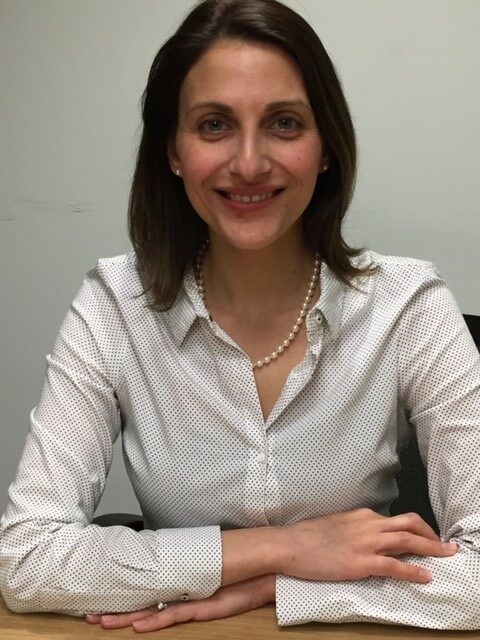
The new Director of the President’s Office at the University of St. Michael’s College brings with her a decade of experience working at the University of Toronto, as well as time spent with the City of Toronto.
Melodie Buhagiar, who holds a degree from Carleton University’s School of Journalism, begins her duties at St. Michael’s on November 29, 2021.
Buhagiar joined the University of Toronto in 2011 as the Office Manager and Executive Assistant in the Dean’s Office, Dalla Lana School of Public Health, where her duties included providing operational management of the Dean’s Office, leading a variety of special projects, rolling out major initiatives, and providing support to academic recruitment, tenure, promotion and retention processes at the School.
Most recently, she worked in U of T’s Office of the Vice-Provost, Faculty and Academic Life, as Project Support and Faculty and Academic Life Consultant, where she provided service on a full range of academic human resources matters to academic divisions across the University of Toronto.
Before joining the U of T in 2011, Buhagiar worked for the City of Toronto, including time as a political staffer.
“I am honoured to join the University of St. Michael’s College in this capacity, and look forward to the opportunity of contributing to the St. Mike’s community,” says Buhagiar. Her duties will also include serving as secretary of the University’s Collegium.
University President David Sylvester describes Buhagiar as a valuable addition to his staff, particularly given her broad experience at U of T.
“Melodie handled a vast range of issues in the 10 years she worked at U of T and her understanding of the workings of the University, as well as her extensive experience with post-secondary needs and concerns, will serve St. Michael’s well. I am very pleased that Melodie will be joining our team.”
The following was written by University of St. Michael’s College Interim Principal Mark McGowan as part of his weekly message to his staff.
Each Name was a Life
This missive comes a few days earlier than usual… Normally I would not disturb you during Reading Week, but Remembrance Day is this week, and I could not let it pass without some thoughts about the College and the students and alumni who lost their lives in the major wars of the 20th century. Each year I try to attend our ceremonies of remembrance at the Slype, the walkway between More and Fisher Houses, which is where the names of those who “fell” are inscribed. I regret that I am unable to be on campus tomorrow but would like to leave you with a few thoughts about the “last names.”
The last name on the list of young men commemorated for their service in World War I is Fred Webster. Early in my teaching career at SMC, I had a mature student in my history of Christianity class who offered me a story about his mother’s favourite uncle, this same Fred Webster, who coincidentally was part of a much larger research project in which I was engaged. Fred was a student at St. Michael’s College who suffered from a debilitating heart condition. When he tried to enlist locally in the Canadian Expeditionary Force, he was refused on medical grounds. He tried many times to join his classmates overseas, but every time the refrain from recruiters was the same: rejection. On the streets of Toronto, Fred was berated by passersby as a young man who was a shirker, not doing his bit for “King and Country.” They had no idea of the story of his repeated attempts to enlist and his repeated rejections. In January 1918, however, when the Allies were desperate for reinforcements in a war that was not going very well, Fred was accepted and was sent to the military training camp near the Toronto Exhibition grounds. As a well-educated recruit who worked in banking, Fred was promoted to Acting Sergeant in March. During the mandatory swim near Hanlan’s Point, however, Fred had a massive heart attack and drowned. At age 24, his war ended in Canada.
When I arrived at St. Michael’s in 1991, I attended my first Remembrance Day ceremony at the Slype. Among the group of students and Faculty I noticed a woman standing at attention close to the opening of the Memorial. She remained for some time after the ceremony had ended. In the months to come I saw her from a distance, from time to time, in Alumni Hall. The following year, on November 11, she was at the Slype again. I asked my colleague, Mimi Marrocco, who this older lady was, standing at a distance from the group. Mimi told me her name was Sister Mary Zimmerman, CSJ. She had been the Executive Director of St. Michael’s Hospital (1963–85) and was currently assisting Father Bob Madden in Alumni Affairs. Then Mimi added that she came here every year to remember her husband, Maurice Dier Zimmerman, the last name on the World War II list. An alumna of SMC, Bernice Veronica Lannan (Sr. Mary) met Maurice at St. Basil’s Parish, where she was actively engaged in parish activities. They were married in 1943 at St. Basil’s, just before Maurice shipped out with the RCAF. He never returned; his squadron was stationed in the Middle East, and he was declared missing, later killed in action, when his plane crashed during a raid over Greece in July 1944. Four years later, after having worked in the pharmacy at St. Michael’s Hospital, the widowed Bernice (Sr. Mary) decided to join the Sisters of St. Joseph where she had a distinguished career, including an associate professorship in U of T’s Faculty of Medicine. She insisted on keeping her married name in religious life. Each year she ventured to the Slype to honour her Maurice. She died in 1994, faithful to a love that never ceased.
Every time I pass through the Slype, I remind myself: Each name was a life. Each life was a story. Lest we forget.
Read other InsightOut posts.
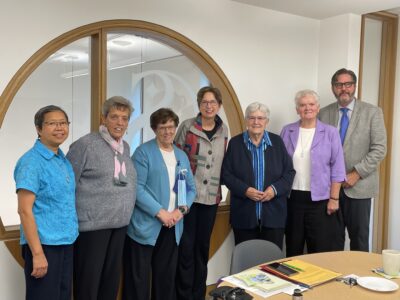
Dr. Hilda Koster, a professor of feminist theology and ecotheology, has been named the new holder of the Sisters of St. Joseph of Toronto Chair in Theology. Dr. Koster joined the University of St. Michael’s College’s Faculty of Theology in July 2020 and was appointed head of the Elliott Allen Institute for Theology and Ecology (EAITE) earlier this year.
“We welcome Dr. Hilda P. Koster to the Chair for 2022 onward and look forward to how her eco-feminist perspective will enrich theological studies for students and faculty,” says Sister Georgette Gregory, who is Congregational Leader for the Sisters of St. Joseph of Toronto.
Calling it “a great honour and pleasure” to be named Chair, Dr. Koster says she is grateful for the Sisters’ support for her work, and for that of the Faculty overall, noting that “this Chair reflects the Congregation’s longstanding commitment to theological education in feminist and ecological theology.
“The fact that this important Chair is now attached to the Faculty position in ecological theology offers important recognition of the leadership in the field of ecological theology that the Faculty of Theology, through the Elliott Allen Institute for Theology and Ecology, has provided for the past 30 years,” Dr. Koster says. “I look forward to a closer collaboration with the Sisters of St. Joseph of Toronto and hope to create opportunities for our students to learn from and get involved with the Congregation’s important eco-justice ministry and its advocacy work on clean drinking water.”
The Sisters of St. Joseph of Toronto established a Chair in Systematic Theology at St. Michael’s Faculty of Theology in 2007. Dr. Koster is the third person to hold the Chair, previously held by Dr. Margaret O’Gara and then Dr. James Ginther.
“We welcome this opportunity to support the Faculty of Theology, to commit to the advancement of theological education, and to honour the legacy of our Sisters at St. Michael’s College,” Sister Georgette says. “For 110 years we have contributed to St. Michael’s College as students and as educators in undergraduate and graduate studies. This includes opening St. Joseph’s College (1911 – 2006), a Catholic women’s college and residence. The Sisters and the University of St. Michael’s College will be forever linked by a shared dedication to Catholic education,” she says.
University President David Sylvester describes the Chair in Theology as yet another way the Sisters of St. Joseph of Toronto have offered invaluable service and inspiration to St. Michael’s.
“From teaching and administrative work to their mentoring and residence for students, the Sisters of St. Joseph of Toronto have shown extraordinary leadership at St. Mike’s for over a century,” he says.
“Dr. Koster’s work in ecotheology and feminist theology speaks to issues of critical importance to our world, echoing themes raised in papal documents such as Fratelli Tutti and Laudato si’. We are profoundly grateful for the Sisters’ support, which will help our students as they find ways to respond positively and productively to the concerns and challenges of the modern world,” he says.
Dr. Koster, whose courses this academic year include Our Common Home: The Origins, Theology and Implications of Laudato si’, will be hosting her first St. Michael’s conference in November. The online event, Doing Theology Amid a Changing Climate: Crossing Divides, takes place November 11 and 12 and includes keynote speaker Dr. Ilia Delio’s leture, “Earth’s Fragility and the Crisis of Transcendence: Why Science and Religion Must be Reconciled.”
Joanne Granata is a Writing Instructor in the University of St. Michael’s College Writing Centre and a University of St. Michael’s College graduate.
A Flicker of Hope in the Darkness
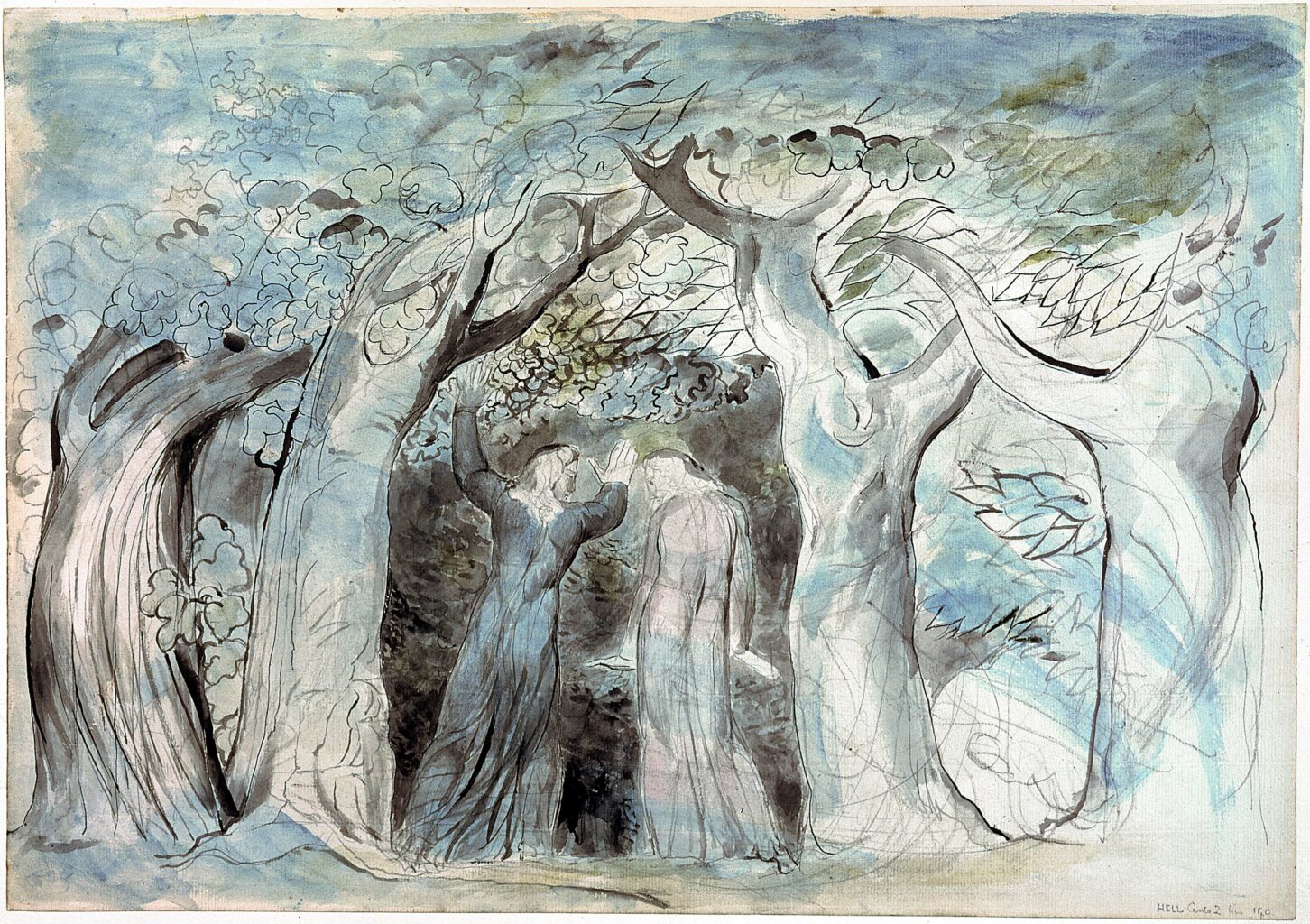
September 14 of this year marked the 700th anniversary of the death of Italy’s “sommo poeta”— Dante Alighieri. As an Italian Studies instructor, and with this week being the International Week of Italian Language and Culture, I would be remiss not to mention or reflect upon this important anniversary. When I was a St. Michael’s student, I studied Dante in many of my undergraduate Italian Studies courses, and, later, he became the topic of some of my own articles and presentations as a graduate student. Now, many years later, Dante’s seminal text on the journey from Hell to Heaven takes on a new meaning for me as a Writing Instructor in the USMC Writing Centre.
Although the central motif in Dante’s Commedia is man’s pilgrimage to God, allow me some poetic license as I reflect on my experiences as a Writing Instructor through the lens of Dante’s Commedia. Dante begins by expressing a sentiment of being lost in a “shadowed forest” (Inf.1.2), a “savage forest, dense and difficult” (Inf.1.5). Often, as a writer, we too can be just like Dante, feeling overwhelmed by the prospect of an assignment, lost in the dense forest of our thoughts. While writing this piece, I found myself reminiscing about my own undergraduate days, spending many late nights with my peers in the Kelly Library, lost, so to speak, in the mountain of books and notes and papers strewn across my favourite table, writing research papers, trying to find my way back to the “path that does not stray” (Inf. 1.3). Now, as a Writing Instructor in this same building, I assist students with some of these same difficulties, some of whom are taking the same courses I took as an undergrad. The irony is not lost on me. I can’t help but smile and think, ‘funny how life works sometimes’.
As a Writing Instructor, I have the privilege of meeting many exceptional students with great minds, who, like all of us, have different approaches to research and writing, to their education, and to life in general. Many come to the Writing Centre and are often unsure of what to do, fearful to make a mistake or to do “poorly”. They are, in a sense, like Dante: faced with a long and difficult journey, and afraid, “hindered in [their] path along that lonely hillside” (Inf. 2.63), but still eager and willing to make that journey up the mountain to reach their desired destination.
Like Dante, the students I see slowly begin to find a way out of the “savage forest, dense and difficult” (Inf.1.5); they begin to recognize the “error of their ways”, so to speak, and, with a little gentle nudge here and there by their Virgilian guides, begin to see a path through to the light. Many receive the reassurance they were seeking or are gently prompted into a successful brainstorming session that leaves them filled with satisfaction. After an appointment perhaps their understanding of an assignment isn’t as black-and-white as they had liked; perhaps it is more grey than when they arrived, but, much like Dante, they “[grow] to be as one who, while he wants what is not his, is satisfied with hope” (Par. 23.13). That hope, that “certain expectation/of future glory […] the result/of God’s grace and of merit we have earned” (Par. 25.67–69) often instills a sense of confidence within our students. They leave their appointment having learned a new skill or having worked out a major problem in their writing. More importantly, they leave with the knowledge that they can succeed, that they can exit that dark forest and reach the top of Dante’s sunlit mountain.
What is so interesting is that of course the sense of satisfaction or hope does not remain solely with the student, but spreads throughout the community; our students impart it onto their colleagues, and onto us, their Writing Instructors. I am often amazed and inspired by the perseverance and dedication of many of our students; although they come to me for help, it is often they who help me. They share their newfound hope and energy with me, and then I am able to take that hope and that sense of having helped and guided someone along the “right path” into my next appointment and into the next. After such a long struggle with our global pandemic, this flicker of hope, in the most unexpected of places, becomes a reminder that, just like Dante’s journey, there is always light in the darkness.
Read other InsightOut posts.
Hiring Announcement
The Office of the Registrar and Student Services is happy to welcome two new Assistant Registrars to their team:

Alyssa Ficaccio
Assistant Registrar
Alyssa Ficaccio has a Bachelor of Arts in Communications and Economics and Master of Educational Research in Adult, Community and Higher Education from the University of Calgary. Prior to joining USMC, Alyssa has held roles in academic advising, media relations, curriculum development and program planning at institutions in Alberta. Alyssa (she/her) has focused her educational research on inclusive, diverse, accessible and innovative ways of thinking in a post-secondary environment to best suit the needs of all types of learners. Coming from Mount Royal University in Calgary, Alberta, Alyssa is excited to now call Toronto home and join the University of St. Michael’s College community.
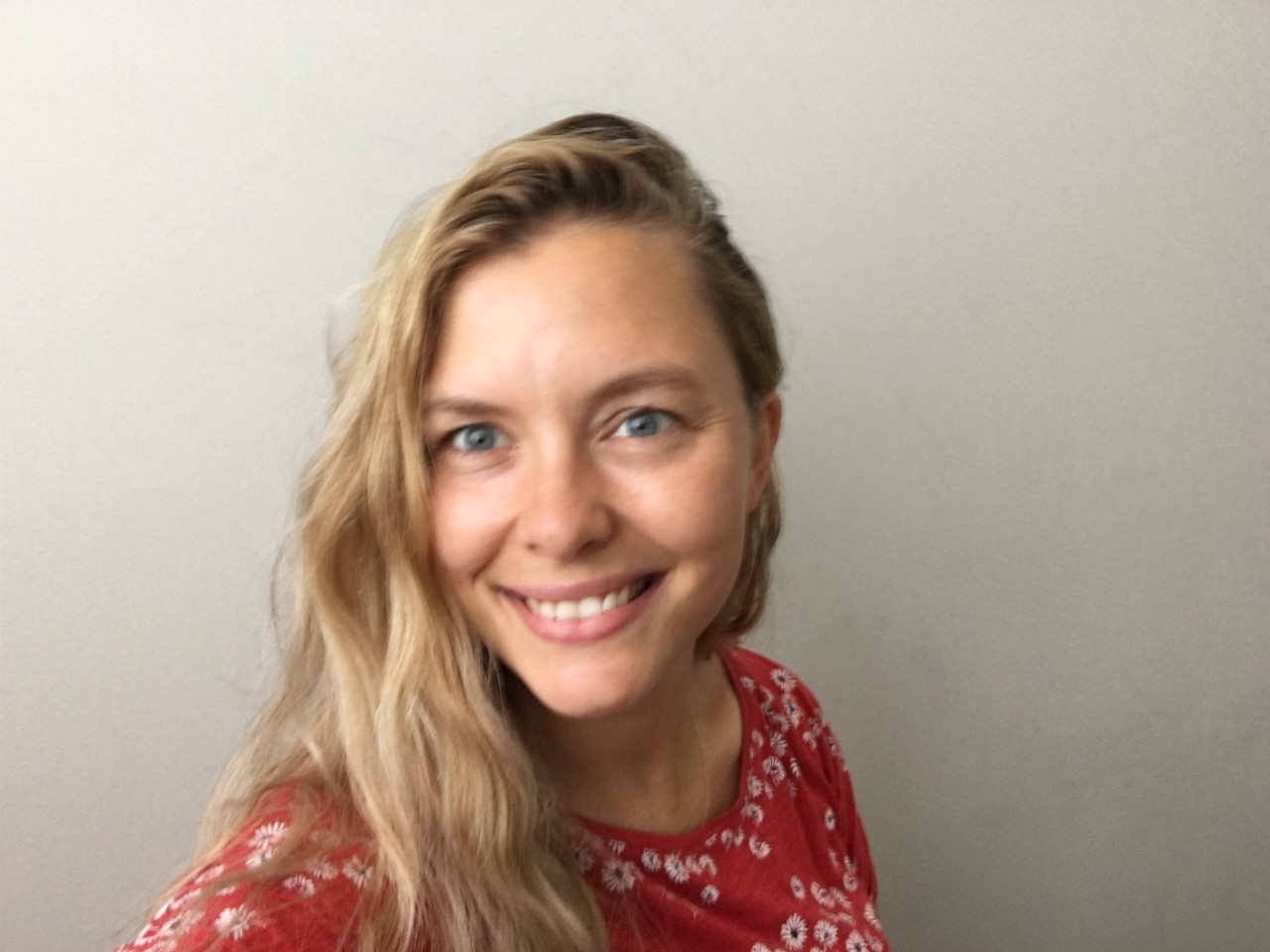
Kaitlyn Lubniewski
Assistant Registrar
Kaitlyn Lubniewski joins St. Mike’s with a background in registrarial work. She completed her Bachelor of Arts in Arts and Contemporary Studies at Ryerson (X) University. Kaitlyn (she/her) brings positive energy, adaptability, and attention to the student experience to all her roles. She arrives from Knox College at the University of Toronto, where she developed and ran community events with an eye to making students, faculty, and staff feel engaged. Kaitlyn is excited to continue her journey in the post-secondary education space at the University of St. Michael’s College.
Please join us in welcoming Alyssa and Kaitlyn!
To all members of the St. Michael’s community:
October 15 was the deadline for you to receive your second/final COVID-19 vaccination in order to meet the terms outlined in the Joint Provostial and Human Resources Guideline on Vaccinations.
- Please seeCOVID-19 vaccinationsfor information regarding vaccine clinics including on-campus clinics.
- Medical Exemption Requests and Religion/Creed Exemption Requests may be submitted to hr.stmikes@utoronto.ca.
Further to the October 1, 2021 message regarding vaccination progress at the University, this is a reminder to upload proof of full vaccination via UCheck by October 29 (two weeks following the October 15 deadline to receive a final shot), or prior to your first visit to campus, whichever occurs first.
- Paper screening form — must be filled out by visitors to the St. Michael’s campus who do not have access to UCheck.
- UofT contractor form — must be filled out by contractors on the St. Michael’s campus.
You are required to upload proof of vaccination, even if you are currently working remotely. As an employee of the University, you may be asked to attend and perform duties on University premises, and uploading proof of vaccination will ensure that you can be on premises if and when required.
After October 29, you will be required to be fully vaccinated in order to be involved in any in-person activities on University premises, which includes St. Basil’s.
As stated in the Joint Provostial and Human Resources Guideline on Vaccinations:
“…the University will educate the community about the benefits of being fully vaccinated against COVID-19. Consequences for a violation of this Vaccination Guideline will depend on the individual’s relationship with the University and the relevant circumstances but may include, in the case of:
- “Employees: prohibition from attending University premises and discipline up to and including termination of employment for cause, in accordance with the applicable University policies and procedures, guidelines, employment agreement or memoranda of agreement or collective agreement, if any.”
Those awaiting the conclusion of the 14-day period after their second vaccination or who have a University-approved exemption must participate in the University’s rapid screening program and may be subject to additional safety measures.
- If you have specific questions about uploading proof of vaccination and the University’s COVID response, please visit our Frequently Asked Questions.
- If you are experiencing technical issues with UCheck or have a question, please submit an enquiry. If your problem is UTORid related, please visit utorid.utoronto.ca, or email hr.stmikes@utoronto.ca.
- For more information, please refer to the Joint Provostial and Human Resources Guideline on Vaccinations and visit utoronto.ca/utogether/vaccines.
Additional information about Fall 2021 plans at St. Michael’s is available online.
St. Michael’s Assistant Professor Stephen Tardif offers a preview of his new course Dante and the Christian Imagination in this Mediaeval Minute:
Laurie Morris is Communications Director at the University of St. Michael’s College. She holds a B.A. in English from U of T and a certificate in Corporate Social Responsibility from St. Michael’s. Laurie lived in New York from 1998 until 2014.
Twenty Years Since that Terrible Rainy Day
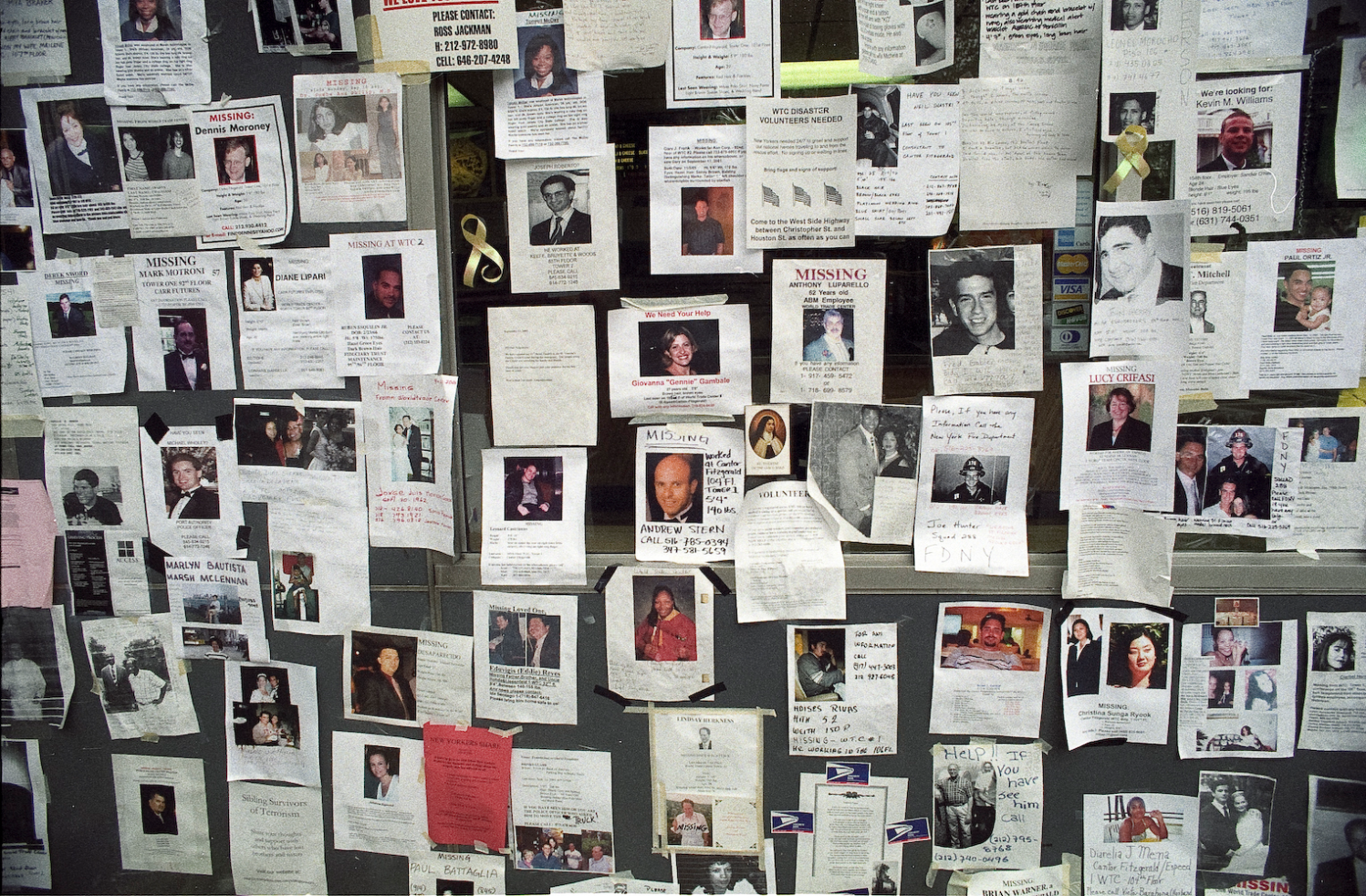
Saturday, September 11 marked 20 years since the terror attacks on the World Trade Centre in Manhattan. Living at that time in the West Village and working for the Associated Press (AP), I was a first-hand witness to the devastating story as it unfolded.
I’m also someone who didn’t know anyone who died or lost someone that day. But even 20 years later I remember small details that bring back a feeling of loss.
There were obvious losses that Tuesday. I heard the first plane hit the Towers as I was leaving my apartment to catch the subway to Rockefeller Center where the AP office was located. I thought it was a huge car crash and glanced down Hudson St. but saw nothing. By the time I got to the subway station at 6th Avenue, people were standing in the street. I joined them, again looking for the crash I’d heard minutes earlier. It was only when I looked up instead of down that I saw flames coming out of the World Trade Centre. I knew enough to call my dad to share the news with my family, and to let them know I was well out of harm’s way.
Inside the offices at AP, we watched the breaking news “A-wire” stories tracking missing planes while the local news wire ran reports of ambulances with body bags being stationed along the West Side highway. At the same time, like everyone else, we watched events play out on television, complete with audio from phone calls made by people from inside the towers.
As unbelievable as it may seem, when the first tower fell, I felt a slight wave of relief. The unimaginable had happened, signaling that the worst was over. We didn’t know what we didn’t know.
After the second tower fell, we were told to evacuate our building since it was unclear if there were other landmark buildings that might be targets. The journalists on the news floor stayed put. I walked a long, hot 60 blocks home, crossing through an eerily empty Times Square where the jumbo screens were filled by fires and the smouldering wreckage.
Closer to home, people started gathering at St. Vincent’s Hospital to post photos and photocopies of those who had gone missing.
Over the next 48 hours, there were enough posters to fill an entire brick wall outside the hospital. And in the details on those posters, there was a deep sense of loss—the clothes people were wearing, the company they worked for or the WTC floor they worked on, the time of last contact or sighting—and the best number to call when they were found or identified. There still seemed to be possibility.
On Friday, September 14, it was no longer sunny and hot in New York. I remember waking up to the sound of pouring rain and flipping on the news to see the latest from Ground Zero. The rain was good for the fires, which continued to burn, but for me, it evoked a sense of loss that was beyond any I’d felt to that point. The shock and adrenaline brought on by the crisis was waning and the magnitude of the tragedy was settling in. Three days since the attacks, there was no longer possibility.
Tuesday, September 14, 2021 marks 20 years since that terrible rainy day. My heart still goes out to people I never knew—the first responders, the family and friends of the 2,977 people who died and the many others around the world who experienced their own sense of loss.
Read other InsightOut posts.
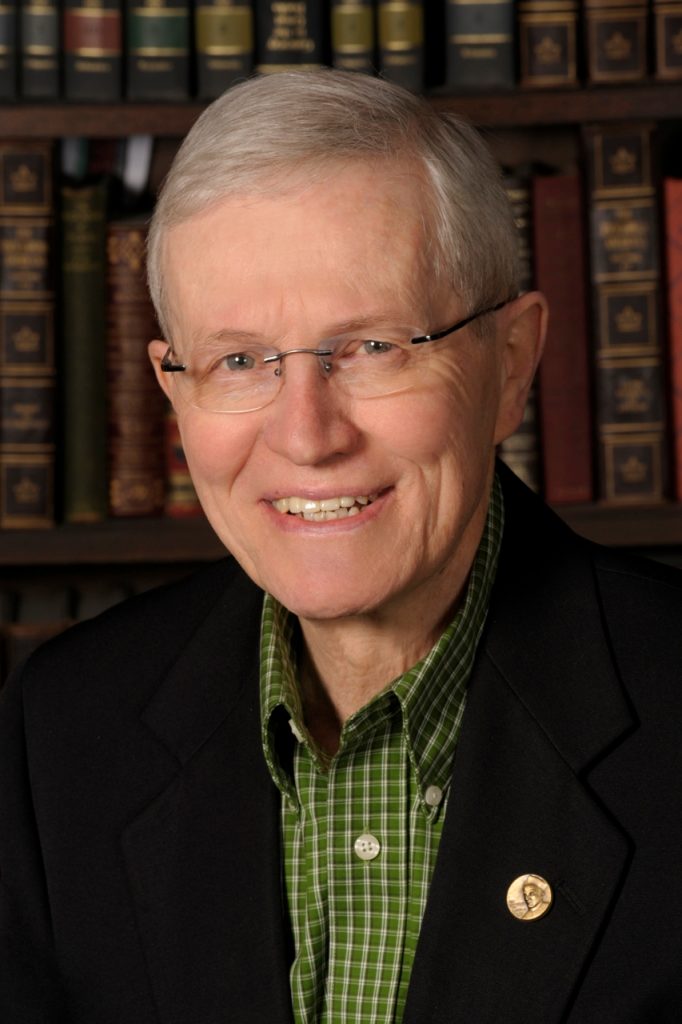
The following reflection was written by St. Michael’s Interim Principal Dr. Mark McGowan.
Though born in Syracuse, NY, Terry Fay had a Canadian heart and served the Catholic community in Canada with grace, dignity, and sensitivity. His parents Hugh Fay and Susan Dunne were from County Cavan, Ireland, and emigrated to the United States from London, England, in 1926. Terry, the only boy among three sisters, was named after his uncle Terry, who had died in a work-related accident in Florida. His early education in Syracuse’s public schools was followed by university studies at Le Moyne College (1949-1953). It was at LeMoyne where he made two important choices: he switched his program of study from Engineering to History and, inspired by his Jesuit professors, decided to join the Society of Jesus.
Terry’s unsuccessful attempt to join the Jesuit Province of New York, after what he described as a “disaster” of an interview, prompted him to take the Provincial’s advice and seek admission to the Jesuit Province of Upper Canada. In 1954, he entered the Jesuit novitiate in Guelph, and the rest is history. He acquired a BA in Philosophy at Gonzaga University in Spokane (1961) and a doctorate at Georgetown University (1971), where he completed a dissertation on the Rush-Bagot Agreement of 1818. He spent the next fourteen years teaching history at the Jesuit-run St. Paul’s College at the University of Manitoba, in Winnipeg. In 1985, the Provincial invited him to Toronto to undertake the research for the planned Dictionary of Jesuit Biography. He soldiered away at research using his office at St. Mary Street as a home base, while teaching part time at St. Augustine’s Seminary. He joined the Canadian Catholic Historical Association in 1986, and for the next thirty-five years served the Association in many executive capacities, including over a decade as Treasurer. He became very good friends with the late Father Ed Jackman, OP, with whom he shared many adventures as they drove to Ottawa annually for meetings of the Historia Ecclesiae Catholicae Canadensis. Earlier this morning, former CCHA President, Dr. Peter Meehan, wrote that “I also have so many happy memories of Terry and Ed [Jackman] together – there is something poetic about them passing within months of each other.”
When the dictionary of biography was completed, Terry continued part-time teaching at the Seminary and at the University of St. Michael’s College, in both its undergraduate and graduate divisions. It was his new teaching experiences in Church History at USMC that prompted him to write a survey history of the Catholic Church in Canada, A History of Canadian Catholics: Gallicanism, Romanism, and Canadianism. Published by McGill-Queen’s University Press in 2002, the book remains the standard narrative of the Canadian Church, and a necessary read for all students of religious history in Canada. Terry was not finished. He realized that there were great gaps in his own book, particularly regarding Catholic immigrants to Canada who had recently arrived in Canada. This lacuna prompted Terry to visit the Filipino, Chinese, Korean, Tamil, and Vietnamese communities across Canada and then travel to Asia to research the Catholic origins of these many new Catholic Canadians. The result of Terry’s labours was The New Faces of Canadian Catholics: The Asians, published by Novalis in 2009. In addition to his many articles published in CCHA Historical Studies, Terry completed his third monograph, Canadian Catholic Spirituality: Saints and Sinners over 400 Years, published by Tellwell (Victoria) in 2021. In 2014, at its annual meeting at Brock University, the CCHA awarded Terry its highest honour, the George Edward Clerk Medallion, for distinguished contributions to the writing of the history of the Catholic Church in Canada.
His passing on Sunday, September 5, in Pickering, Ontario, has come as a shock to many who knew and loved him, particularly parishioners at Our Lady of Lourdes Parish in Toronto and its Jesuit community, members of Canada’s Filipino and Chinese communities, his extended family members to whom he was unofficial chaplain, and to his colleagues in the CCHA.
This past spring, during the pandemic, Terry wrote his short memoires and, as had been his practice, gave it to me for editing and suggestions. I was deeply moved by his life story, and his writing confirmed in me his gentleness, empathy, and personal humility. He wrote: “These memoires do not necessarily document the Jesuit ideal of the ‘magis,’ always seeking the highest good in the service of God but explain the service of God in an ordinary way.” Terry was far from ordinary, although his personal humility would not let him see himself otherwise. May he rest in peace; we have lost an “extraordinary” friend and colleague.
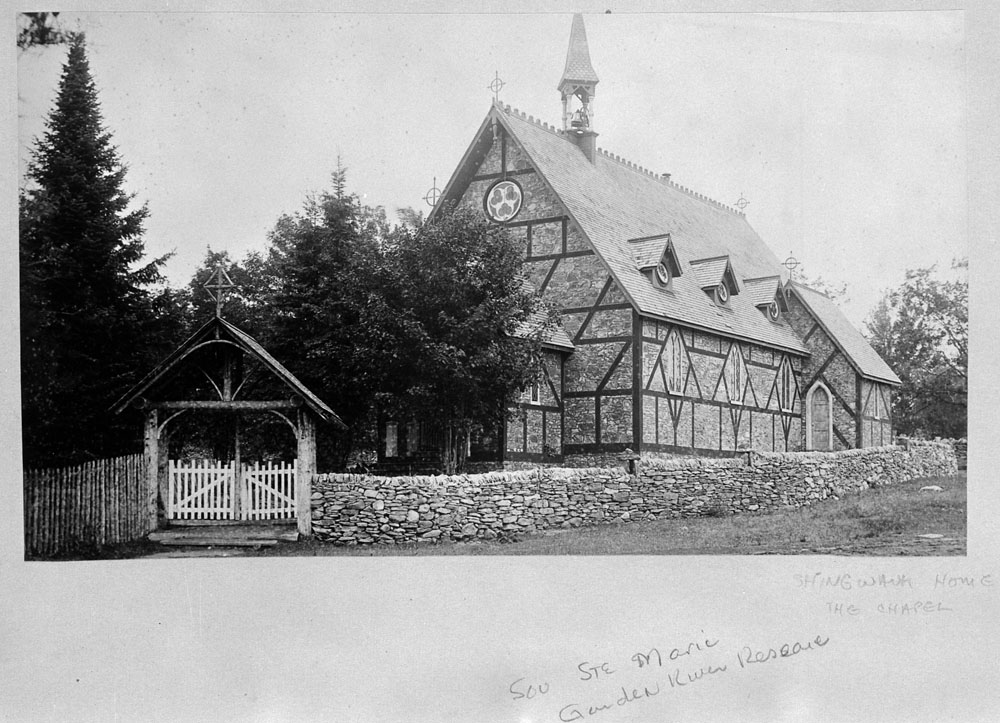
A new course at St. Michael’s will take a deep look at the history and legacy of residential schools in Canada. Christianity, Truth and Reconciliation is offered as a First-Year Foundations Seminar and is open to all first-year students in the Faculty of Arts & Science in the University of Toronto.
A significant portion of the course will be the presentation of parallel histories: invitations to collaboration and mutual listening on the part of Indigenous leaders, and the all too frequent, tragic rejection of these amicable overtures by both church and state officials.
“My hope is that students come out of the course with the clear-eyed understanding of the way that European Christianity collaborated with the Canadian state to implement this program of cultural genocide—a clear-eyed view of the complicity in this project—but also a clear sense of other possibilities of relationship,” says course creator and Associate Professor Dr. Reid Locklin. The latter half of the course will also present ways that Indigenous Christians and Indigenous partners in conversation with Christians seek a creative rethinking of the Christian tradition on Turtle Island, the name many Indigenous communities call North America.
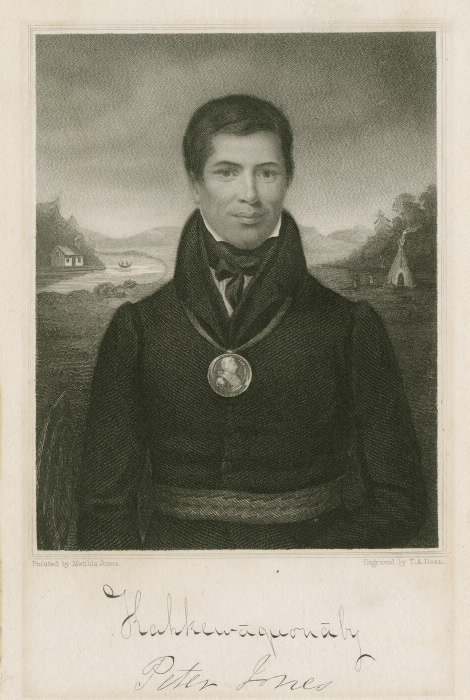
Locklin uses the term “cultural genocide” to describe the “total program” of the Canadian government to “exterminate Indigenous persons as Indigenous persons [and] remake them in the image of white Canadians,” a program in which Canadian churches were complicit. Because St. Michael’s is a Catholic university, the course responds to Calls-to-Action from the Truth and Reconciliation Commission report directed at both churches and educational institutions.
“We think about—one—do we have a place for looking at this history, particularly as a Catholic school, but also—two—how do this history and the rich traditions of knowledge in Indigenous nations and peoples have an impact on how we teach everything?” Locklin says. This second theme of the course opens a “less well told history of creative engagement of Indigenous persons and nations with Christianity,” including Sacred Feathers (Peter Jones), a Methodist minister and leader of the Mississaugas, and Louis Riel, a Catholic Métis who played an important role in the formation of Manitoba and Canadian confederation.
Bringing one of the course’s themes directly into its pedagogy, a key piece of Locklin’s course is a partnership with the Shingwauk Residential Schools Centre. Located at Algoma University, the centre maintains an archive of records related to residential schools across Canada, including both an Anglican-run residential school that operated on its grounds and a nearby Spanish Catholic residential school. The centre will make these archives available to students for research and exploration.
“The Shingwauk school was used by the state for cultural genocide, but when Anishinaabe leaders originally initiated the school they had a different, creative vision for what that school should be,” Locklin says, and that vision combined their own knowledge traditions with elements of European learning. The state’s dismissal of this opportunity for partnership is one of the “lost opportunities” he wants students to learn about in order to be able to see “the possibility of alternative pasts and alternate futures.”
Shingwauk itself is built on a model of partnerships with the Garden River Reserve and the Anishinaabe Nation, and when the centre was formed it established an advisory committee of residential school survivors. As part of Lockin’s final unit on apologies and reparations, students will have an opportunity to hear from a survivor panel. Locklin hopes that future students will be able to visit Shingwauk as part of the course.
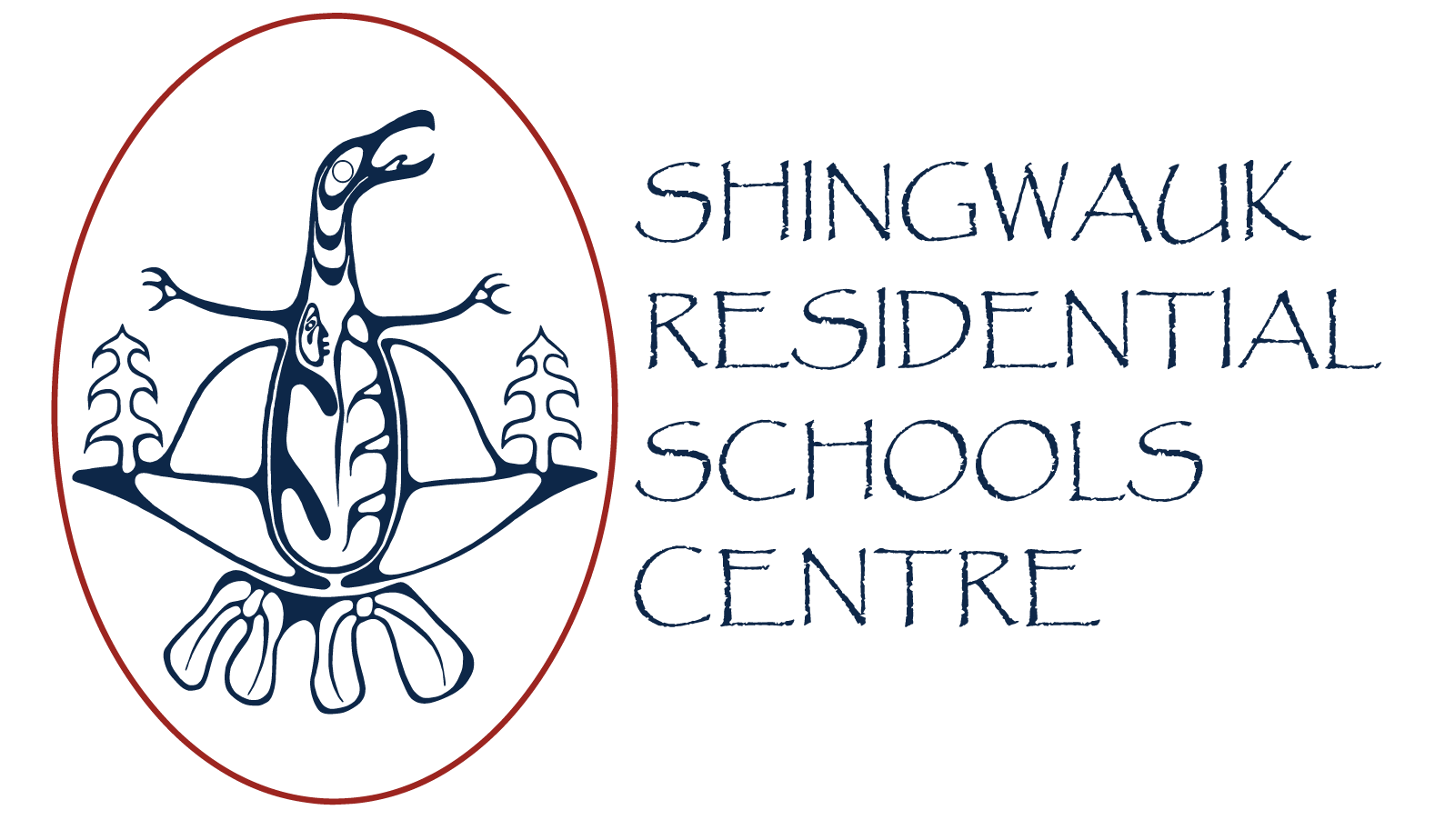
There are lessons about this past available in the very ground on which St. Michael’s campus stands, and the course itself is one part of the University’s larger engagement with the Calls-to-Action of the Truth and Reconciliation Commission. Locklin received a grant from Arts & Science to create treatylearning.ca, a website that offers a non-Eurocentric revisionist history of the land.
Uncovering untold stories about the land St. Michael’s operates on is one aspect of a larger effort to accept rather than ignore an invitation to partnership, allowing Indigenous histories and traditions to reframe the University’s story. Other past related initiatives at St. Michael’s have included round table and blanket exercise events at the Faculty of Theology, reading collections in the Kelly Library, and reading groups for staff and faculty on Indigenous histories and issues.
“It is very important that a Catholic University address the Church’s engagement with Indigenous peoples in a meaningful way as a means of uncovering the truth, which is a necessary step to reconciliation,” says St. Michael’s Interim Principal and Vice-President Mark McGowan. “This seminar engages the students with primary sources relating to this Christian-Indigenous encounter and addresses the tough questions that have arisen from this history in Canada. A seminar of this nature is long overdue.”
August 18, 2021
The University of St. Michael’s College is pleased to announce that Sonal Castelino has been appointed the University’s new Director of Campus Ministry. Castelino began her duties remotely from France in mid-August, and will arrive on campus for the start of the fall semester.
“Sonal is a perfect fit for St. Michael’s as we continue to revitalize our Campus Ministry to reach out to the needs of all students, faculty, staff and alumni,” says University President David Sylvester. “She appreciates how important a time the university years are for spiritual development and she is keen to offer her support and guidance to students of all faiths as they encounter life’s big questions. Though her work will be on the front lines (look for her new office next to the COOP), Sonal will also be a member of the senior leadership team of St. Mike’s, helping to move our community forward on the strategic initiatives identified in St. Mike’s 180. We are delighted she will be working with us.”
It was while a commerce student at the University of Toronto’s Mississauga campus that Castelino first became involved in campus ministry, asking questions about her Catholic faith. As her questions and desire to grow deeper in her faith increased, she enrolled in the Master of Divinity (MDiv) program at Regis College, also earning a certificate in pastoral competence.
After graduation, she worked at the Newman Centre as Associate Director of Formation, where her duties included creating the Faith and Reason Lecture series and developing a Rite of Christian Initiation of Adult (RCIA) program. The experience helped her establish key connections, including the Archdiocese of Toronto and Canadian Catholic Campus Ministry.
More recently, Castelino worked as the Recruiter and Student Life Coordinator at Regis College, where she created a mentorship program, helped with campus visits, worked with students to form reading groups, and co-handled the College’s social media platforms. She also served as co-Chair of the board of the Jesuit Volunteers. She recently completed her first vows with La Xavière Missionnaire du Christ Jésus.
Describing herself as a “relational” person with an open-door policy, Castelino is keen to work with students who are making the transition from an adolescent approach to faith to a more mature adult faith.
“The university experience is a human experience. I want to create a space where people can name their needs,” she explains. “The experience of encounter is important in my life, and I want to create a space that is inclusive rather than exclusive.”
Castelino envisions many ways to make this happen, ranging from working with MDiv students who are engaged in field placements to broaden the scope of Campus Ministry and earn the practical experience they need for their degrees, to arranging a lecture series based on a dialogue between disciplines, in keeping with St. Michael’s commitment to innovative interdisciplinary academic programming.
Fr. Morgan Rice, CSB, pastor of St. Basil’s Parish and a member of the search committee that selected Castelino, notes that “St. Mike’s has been blessed with contributions from members of various religious communities throughout its long history. Having recently made first vows with La Xavière Missionnaire du Christ Jésus’ Sonal will bring her particular experience of community life and prayer as well as her community’s charism into her ministry at St. Mike’s. I look forward to seeing how the community life of students, faculty, and staff will be enriched as a result.”
Campus Ministry programming at St. Michael’s is funded, in part, by endowments established by the Basilian Fathers of the University of St. Michael’s College and the McGovern family, and by generous donations from alumni and friends.
Mary E. Hess is Professor of Educational Leadership at Luther Seminary in St. Paul, MN. During the 2016-2017 academic year she held the Patrick and Barbara Keenan Visiting Chair in Religious Education at the University of St. Michael’s College, in the University of Toronto. Her most recent book, co-authored with Stephen S. Brookfield, is Becoming a White Antiracist: A Practical Guide for Educators, Leaders, and Activists (Stylus Publications, 2021).
Living into the Light
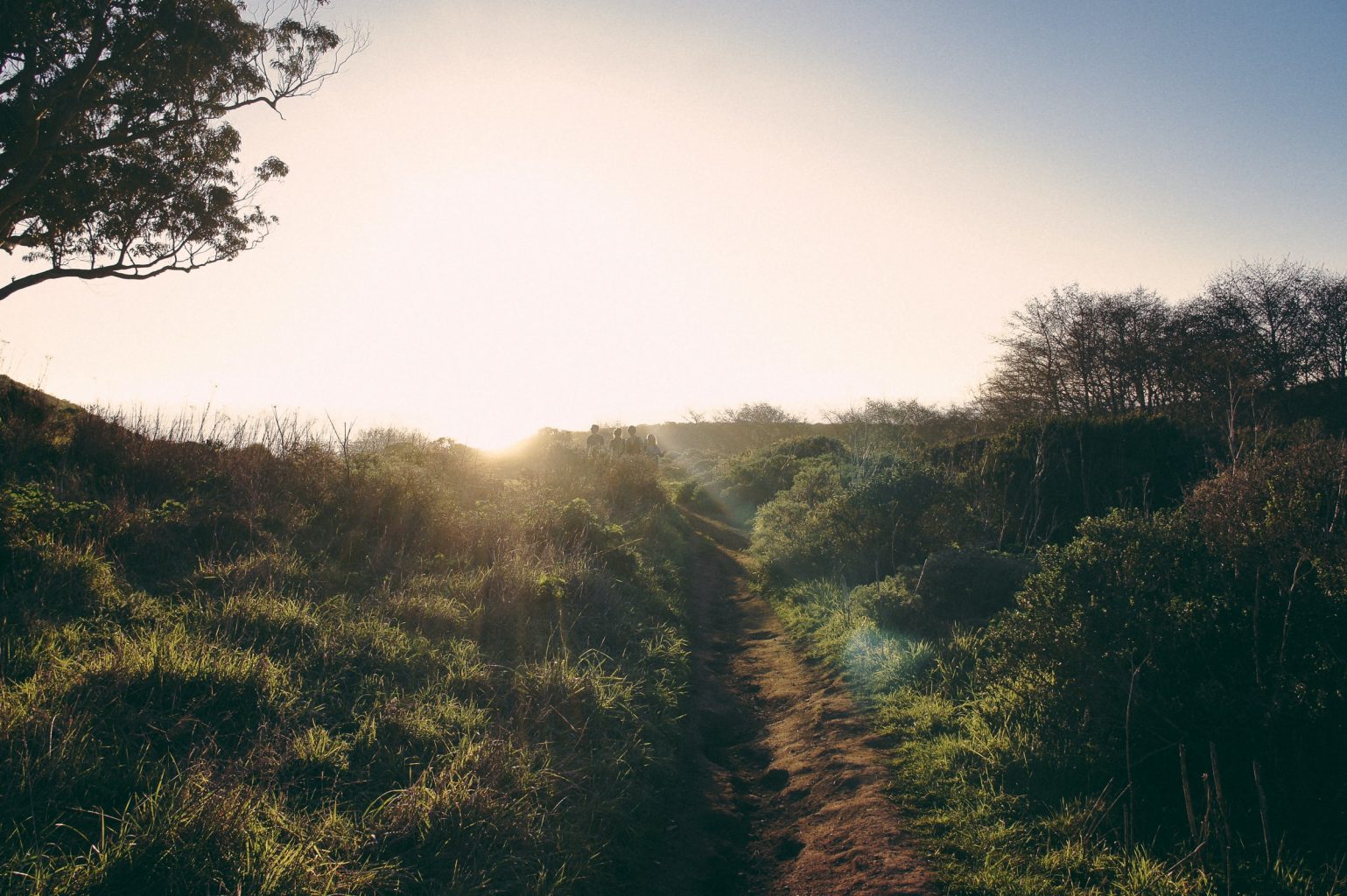
I’ve lived in St. Paul, Minnesota for more than two decades. St. Paul is a deeply Catholic city, and I live in a parochial space that has a vibrant K12 school, as well as many, many Catholic organizations which have long been active.
The last five years, however, have been a time of great urgency and anguish, as those of us who are white and middle class have finally begun to listen deeply to our neighbors who do not resemble us. The world joined us in that listening in May of 2020, when a video recording of George Floyd being murdered in the city next door to us, by a Minneapolis police officer, was shared around the globe.
That new awareness brought along with it a deep recognition of how blindly we—and here I mean to speak only of my white and middle-class neighbors—how blindly we accepted the dominant stories of a zero-sum world in which racism was only a personal attitude, and justice meant being “color blind.” I share that now, to offer context for the rest of what I want to say here.
Pope Francis wrote in Laudato ‘Si that a key conviction of our faith is that we have: “an awareness that each creature reflects something of God and has a message to convey to us, and the security that Christ has taken unto himself this material world and now, risen, is intimately present to each being, surrounding it with his affection and penetrating it with his light (221)”.
What can it mean to live into that awareness and that light—in all the rich meanings of those words? And how might persons who look white, and thus benefit from racialization, participate deeply in the kind of communion to which our faith witnesses?
I have come to believe that doing so requires being actively involved with learning how to dismantle racism, learning what it means to inhabit an anti-racist stance in the world. I don’t think this is a place I can ever fully come to, a stance that I ever fully achieve, but rather it is something into which I am always growing, always seeking, always yearning towards, always becoming.
Much of the learning I have done in the past decades in this journey has to do with recognizing a few key insights.
First, whether I want to or not, whether I understand this or not, whether I choose to draw on it or not, I live within a world defined by white privilege. That doesn’t mean that various other aspects of who I am might not be challenged or oppressed, but it means that my whiteness prevents me from seeing, from experiencing, much of what my neighbors who do not resemble me, live with in daily ways. Rather than seeking to deny that I participate in racism, I need to stop, take a deep breath, and learn what that means. A really good book that spells this out is Heather McGhee’s Sum of Us: What Racism Costs Everyone and How We Can Prosper Together. While her book was written in the US context, I believe it has resonance for the broader North American continent.
Second, doing this work never ends, and I have grown to understand that as a white person, I have two choices: I can do it imperfectly, or not at all. And so I choose to try, and to realize that I will often fall down, mess up, make mistakes, and need to start again. Here is where my faith is a crucial resource, because I have learned what it means to repent, to seek forgiveness, to accept God’s grace, and to take the next step. There is much to lament about how the Catholic hierarchy has engaged with racism, but there is also much to draw upon—and here the many documents, sermons, hymns, and catechetical resources offer us so much! I start with the work of theologians Fr. Bryan Massengale and Dr. Shawn Copeland, but many dioceses have also put together excellent materials.
Third, this is collective, systemic work. It is never only personal and individual. Here again, my faith sustains me because it invites me to see all of the many ways in which human brokenness—human sin—puts stumbling blocks in my path. Yet it also invites me to see all of the ways in which God has created us in deep interdependence. We are created for each other; we are drawn into relationship. When one hurts, we all hurt. We need to be open to seeing and hearing and feeling that hurt. There is deep wisdom in our tradition, wisdom forged through centuries of pain and anguish, wisdom that invites us into lament, and from lament into remembering whose we are, to whom we belong. We are a communal people, and “re-membering”—putting back together the Body of Christ —that communion means that we can look to collective action, to practices that challenge systemic and structural forms of racism. Humans have created racism, and humans can deconstruct it and live into God’s light.
Fourth, breath matters. I often remind my students that we can live for many days without food, and even a day or two without water, but we cannot live for even 10 minutes without breath. In an era in which “I can’t breathe” resonates not only due to police brutality, but also through a COVID-19 pandemic, and in the midst of climate catastrophe, remembering to breathe, to slow down, to feel God’s love in our lives in the midst of trauma – that is an essential practice. It is also an ancient form of contemplative prayer. Whenever I feel particularly anxious or defensive or even despairing, I stop, I slow down my breath, and I pray this short prayer based on one verse from Psalm 46: “Be still and know that I am God (inhale/exhale slowly), Be still and know that I am (inhale/exhale slowly), Be still and know (inhale/exhale slowly), Be still (inhale/exhale slowly), Be.”
Fifth, and finally (at least for this moment), learning to be anti-racist as a person who looks white means leaning into relationships of accountability. To whom am I looking for leadership? Am I hearing the voices of communities which have been oppressed? One of the glimpses of hope I draw, as a US person, from the Canadian context, is that acknowledging the painful history of residential schools can open up new avenues of relationship and hope. Here in Minnesota we have a Lieutenant Governor who is a member of the White Earth Band of Ojibwe, and she is leading us in the hard work of truth and reconciliation. I draw comfort from the years long work of Canada’s TRC, and I try to live in a posture of learning and humility. I have been startled by how energizing and hope-filled that work can be, even in the midst of the deep pain and anguish to which I need to be present.
I return, now, to the reminder from Pope Francis with which I began, that a key conviction of our faith is: “an awareness that each creature reflects something of God and has a message to convey to us, and the security that Christ has taken unto himself this material world and now, risen, is intimately present to each being, surrounding it with his affection and penetrating it with his light (221)”.
May Christ’s light continue to illumine our anguish, and draw us ever more deeply into God’s love.
Read other InsightOut posts.

Father Andrew Summerson has joined St. Michael’s Faculty of Theology as Assistant Professor of Greek Patristics. Describing his work in Patristics as a vocation, Summerson says that, as a Byzantine Catholic priest and a scholar of the tradition, his goal is “to be a responsible interpreter for its members and for the scholarly and ecumenical community of theologians. As Eastern Catholics, our theological grammar is that of the Fathers. In order to be properly fluent in my own tradition, I went about learning their language.”
Summerson holds an S.Th.D. in Patristic Theology from the Pontifical Patristic Institute “Augustinianum” in Rome. His book, Divine Scripture and Human Emotion in Maximus the Confessor: Exegesis of the Human Heart, was published by Brill earlier this year.
His most recent teaching appointment was at Calumet College of St. Joseph, in Indiana.
“Andrew’s passion for, and dedication to, Patristics will serve our students well. We have pleased to have such a strong addition to the Faculty” says Interim Dean John L. McLaughlin.
“The University of St. Michael’s College has a proud history in its concern for historical studies while engaging the contemporary world,” says Summerson. I see my own work for St. Michael’s with the Metropolitan Andrey Sheptytsky Insititute of Eastern Christian Studies as aligned with St. Michael’s heritage: engaging the touchstones of the Eastern Christian past for the life of the world we live in today.”
In the fall semester, Summerson will teach History of Christianity I and Foundations to Eastern Ethics, while in the winter semester he will teach Contemporary Issues in Eastern Christian Moral Theology and The Three-Personed God: Eastern Christian Perspectives.
Early Christian texts aren’t meant to be sipped like wine; they must be chugged like beer,” he says. “I like to read primary sources with my students and treat them not like delicate artifacts, but living voices that speak true statements about God and the Church today.”
Summerson’s position is a Contractually Limited Term Appointment. The position, which is renewable twice to a maximum of three years, is held in conjunction with the Metropolitan Andrey Sheptytsky Institute of Eastern Christian Studies.
The University of St. Michael’s College is pleased to welcome two postdoctoral fellows for 2021-22. Mehmet Cifti joins the College as a Gilson Seminar Postdoctoral Fellow and Dr. Adam Pugen joins as the St. Michael’s College McLuhan Seminar Postdoctoral Fellow.
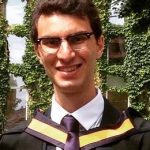
Mehmet Ciftci is from the small town of Cheltenham in the UK, and previously studied philosophy and politics at the University of Manchester (2015), before studying a PGDip (2016) and MPhil (2018) in theology, specialising in Christian ethics, at the University of Oxford. He will soon complete his PhD at Oxford under the direction of Prof. Joshua Hordern. His dissertation is a study and critique of the Catholic Church’s teachings on church-state relations at the Second Vatican Council. He hopes it will be published in the future as an overpriced monograph. He has written articles for journals, including New Blackfriars and the Scottish Journal of Theology, on various subjects, such as liberation theology, the Qur’an, the critique of political ideologies, and Mariology, although his research interests are mainly in political theology. He has never been to Canada before, but he is reportedly excited to find out what Timbits are.

Adam Pugen is a communication and digital media scholar, who draws on the traditions of medium theory and phenomenology. He received his PhD from the University of Toronto’s Faculty of Information. His dissertation, “The Intellective Touch: A Phenomenology of Digital Modernism,” develops a theory of phenomenological aesthetics, which, following the philosopher Edmund Husserl and the media scholar Marshall McLuhan, is meant to function as an “anti-environment” to reveal the psychic and sensory biases engendered by digital media environments. Adam has taught courses on contemporary communication technologies and communication and advertising at the Institute for Communication, Culture, and Information Technology at the University of Toronto. He is a fellow at the Centre for the Study of Digital Life and co-editor of the New Explorations Weblog. He continues to research the foundations of digital media cultures through examining the intersection between contemporary mediated behaviors and the psychological structures pertaining to modes of alphabetic literacy and mechanization.
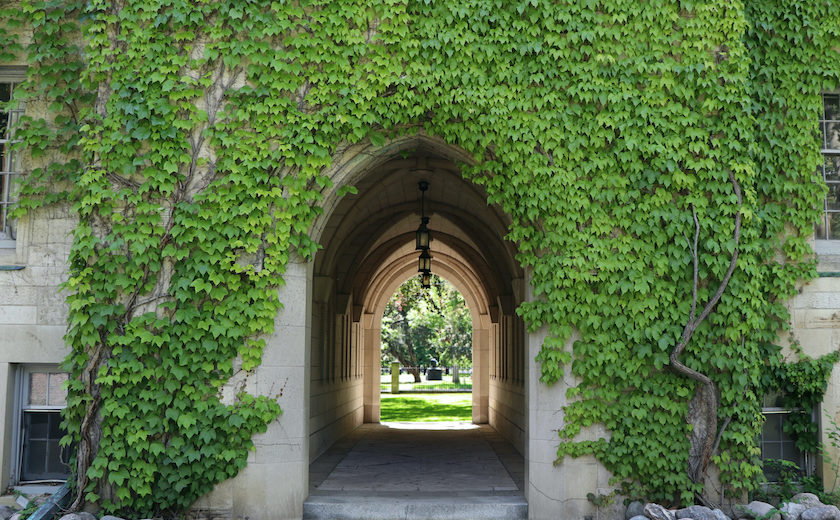
A new initiative will bring young scholars into the St. Michael’s community this fall, fostering their research and building their professional connections while enriching the campus with their expertise and enthusiasm.
The St. Michael’s College Junior Fellowship Program is designed for professional students (including those who study law and medicine), graduate students, and advanced-degree graduates who have a connection to the University of Toronto and an interest in participating in, and contributing to, the life of St. Michael’s. Junior Fellows will propose their own unique contributions, which can range from creating and facilitating topical reading groups and working groups, to participating in programming for St. Michael’s students and students enrolled in St. Michael’s sponsored programs, to creating new opportunities to enhance collegiate life in other areas. Perks include an annual research stipend, full library privileges, faculty mentorship and professional development opportunities, and access to the Faculty Dining Room and common rooms.
“I think this will foster a thriving, vibrant community of young scholars who are going to connect with each other and with members of the college—its students, faculty, and senior fellows—in ways that are distinctive to the intellectual interests and values of St. Michael’s as an institution,” says Dr. Stephen Tardif, Assistant Professor, Teaching Stream, of the Christianity and Culture Program.
Tardif says that the new program is comparable to junior fellowship programs at other U of T Colleges such as Victoria College, which in a typical year will host 10 to 20 participants. He expects a similar number of fellows in St. Michael’s program.
In addition to fostering community among young scholars, Tardif expects the program to fuel exciting research in subject areas that are distinctive to the intellectual interests and values of St. Michael’s as an institution. “Gathering together will be a process of intellectual discovery. We’re very excited to see how these kinds of connections can facilitate [the junior fellows’] own research, and how our own faculty and fellows might offer them mentorship and intellectual community,” he says.
Taking an active, shaping role in the development of the next generation of scholars is a particular benefit for current faculty in St. Michael’s sponsored programs because their teaching and mentorship is usually focused on undergraduate students. Providing mentorship to and fostering the research of graduate students creates opportunities to “shape the next generation of scholars,” Tardif says.
The deadline for applications to the St. Michael’s College Junior Fellowship Program for the 2021-2022 academic year is August 1, 2021.
Dr. Cynthia Cameron is the newly appointed Keenan Chair of Religious Education and Assistant Professor of Religious Education in the Faculty of Theology. Prior to coming to St. Mike’s, she taught undergraduate students at Rivier University and graduate students at Boston College and Loyola University New Orleans. Her research focuses on adolescence, particularly female adolescence, and the history and mission of Catholic schools.
Pandemic Safety and the Classroom
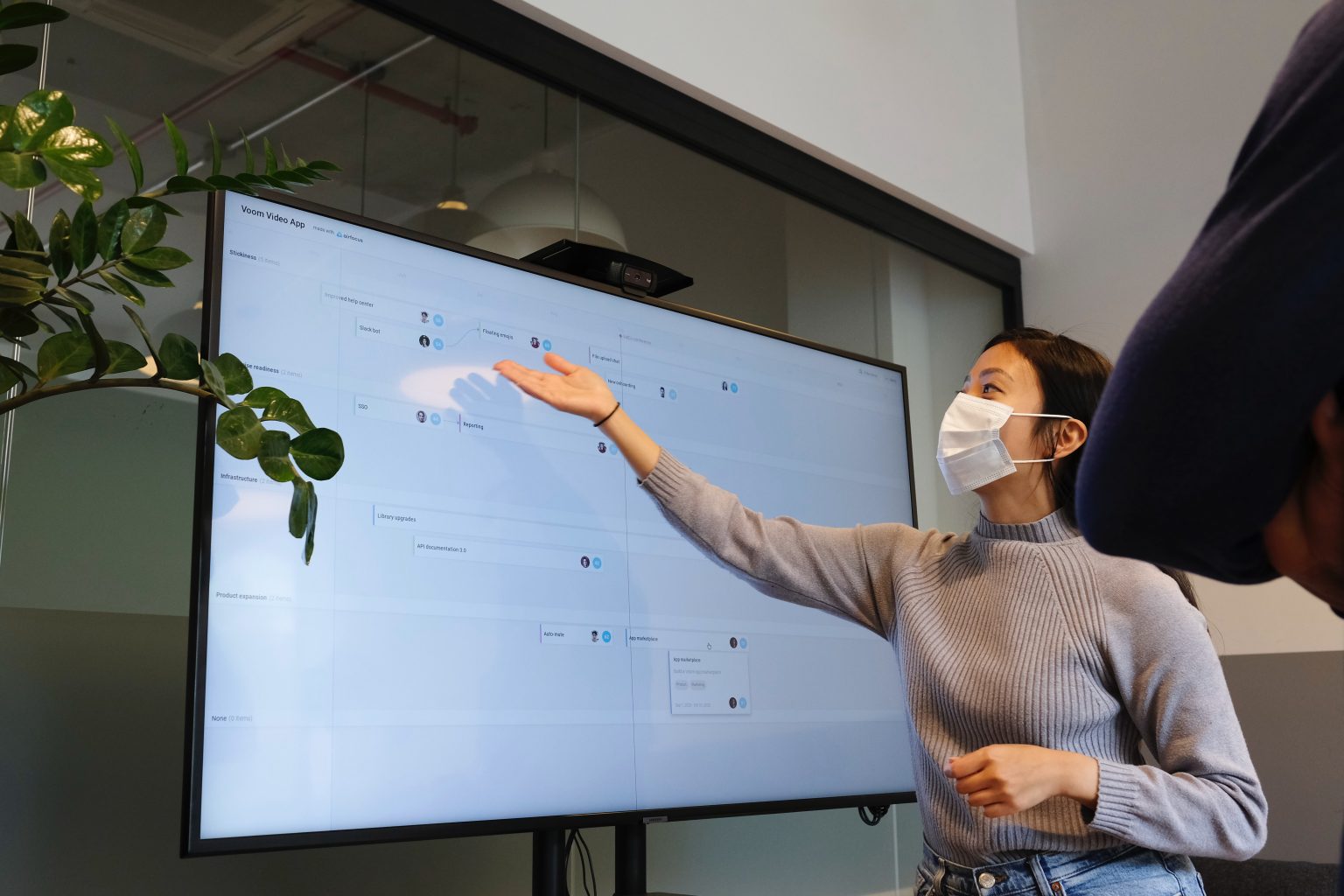
“I don’t want to see my students as threats.”
This was the anguished comment from a Catholic high school theology teacher in a graduate religious education course last summer, in the midst of the COVID-19 pandemic. We were discussing the challenges and opportunities presented by teaching during the pandemic and, in particular, the possibility of Catholic high schools returning to face-to-face instruction in the fall of 2021. This student’s entreaty struck a chord with the class.
On some level, this reflects a common problem in schools. The busyness of planning for in-person teaching leads to a tendency to treat students as pieces in a complex puzzle. The task for educators is to figure out how to arrange the pieces so that students can be in classrooms efficiently and, now, safely. A rather de-humanizing perspective on the young people in our classrooms.
But, more importantly, these teachers were reflecting on how the push to in-person instruction— often decided on without much input from the teachers themselves—made them feel unsafe. The students, as potential carriers of the coronavirus, were threats to the physical safety of teachers. At this point in the pandemic, at least in the United States, it seemed that children and adolescents contracted the virus at lower rates and tended to suffer milder cases of COVID when infected. Which was, of course, good news. However, teachers are adults and, as such, were at greater risk from the virus. And, teachers were being asked to take on this significant risk in order to teach in a face-to-face environment. All over the US, some teachers decided the risk was too great, that their students were a threat, and some even left their jobs.
For the students in my class—all dedicated, but relatively novice, Catholic high school teachers—this led to a fascinating conversation about how we think about, talk about, and treat the adolescent students in our classrooms in a time of pandemic. What happens when we think about our students as threats? How can this not change the ways that we relate to them? And how can Catholic theological anthropology guide us in resisting this kind of thinking?
Theological anthropology is the branch of theology that wonders about what it means to be a human person created by God and in relationship with God and others. This is where the Church reflects on the meaning of our humanity. The two doctrines that most often come up in contemporary Catholic theological anthropology are that we are created in God’s image and that God took on human form in the person of Jesus. The first of these doctrines—that we are created in God’s image (Genesis 2:26-27)—suggests to us that there is something about humanity that reflects the reality of the divine, that we are like God in some way, that humans reveal in some small and imperfect way what God might be like. And, importantly, since God created humanity in God’s own image, humanity is fundamentally good. The second doctrine—that God became human in Jesus (John 1:14)—also points to this fundamental goodness in humanity. For God to take on the human condition suggests that God thinks highly enough of the human condition to be concerned for humanity. In Jesus, God is telling us that humanity is taken on by God, loved by God, and saved by God. So, drawing from these two doctrines, we can be comfortable saying that humans are created by God and loved by God and that there is goodness in our humanity.
But humans have historically struggled to act as if we are fundamentally good. We don’t always treat one another and ourselves in ways that reflect our theological commitments to the fundamental goodness of humanity. And, since teachers, even Catholic school teachers, can fall into this trap just as easily as anyone else, I often ask them to reflect on this question: “Are your students basically good or basically bad? Are they good kids who occasionally mess up or are they little monsters who need to be whipped into shape?” How a teacher answers this question reveals a great deal about how they will relate to their students. And, in my experience, the vast majority of teachers view their students as fundamentally good human beings, even when they are difficult or annoying.
But, how is this positive vision of the human person disrupted when the students become unintentional threats to the lives of the teacher? How are we to maintain and live out a conviction that they are fundamentally good if we are afraid of them? Does our conviction that they are fundamentally good mean that we have to ignore the threat that they may pose?
I don’t have any answers for my student or for any of us who found ourselves fearing our fellow human beings and the risk that they posed to us simply by existing alongside of us. On the one hand, the gradual reopening of things that has accompanied increasing vaccination rates in 2021 has started to lessen the need to think of my fellow human beings as a threat to my health and safety. On the other hand, as it has done with so many other issues, the pandemic has revealed to us the ways that we fail to live up to our theological ideals. The fact that we did think of our fellow human beings as threats is a challenge to all of us to think about what it means to love our fellow human beings, who are created by and loved by God, who are fundamentally good.
Read other InsightOut posts.
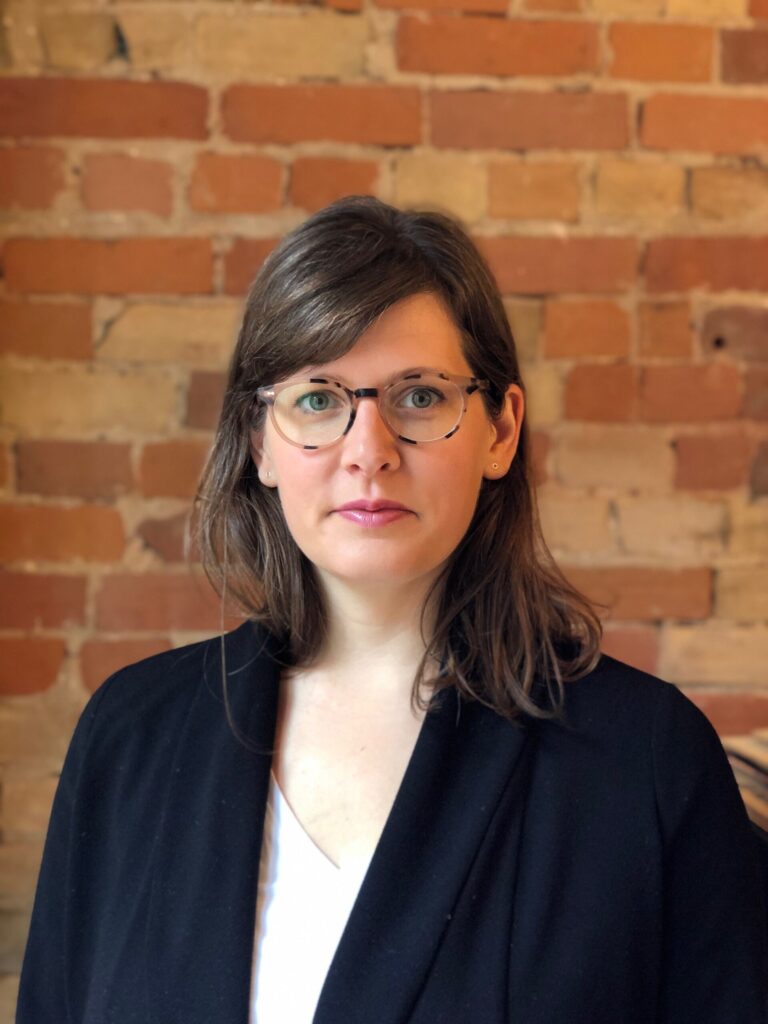
The University of St. Michael’s College offers its best wishes to Lisa Rae, who is leaving the University to accept a position with Addictions & Mental Health Ontario (AMHO).
Rae, who currently serves as Director of St. Michael’s Office of the President and Secretary to Collegium, will begin her new role as AMHO’s Director of Public Affairs in early August.
“We are, of course, very sorry to see Lisa leave St. Michael’s, but it is exciting to think that such a gifted person will fill this crucially important role in our community and have an impact provincially,” says President David Sylvester. “Lisa’s ability to lead on complex policy initiatives has served St. Michael’s very well. Her leadership role on bringing the St. Mike’s 180 strategic plan to life and the ongoing renewal of university governance policies and procedures means she leaves St. Michael’s in a stronger place than when she came. It is great to know that AMHO will have such an asset at a time when we are all increasingly challenged by the issues surrounding mental health and addiction.”
“This truly is bittersweet for me.” says Rae. “I have truly enjoyed my time at St. Michael’s and getting to know the people that make this community so resilient. I am genuinely excited for the campus reopening this fall, and the university’s path of renewal.”
Rae’s input in Collegium matters has been invaluable, notes Paul Harris, who serves as Chair of the University’s governing board.
“Lisa’s appreciation for process and her understanding of governance issues have been influential in making the Collegium more efficient, and we are especially appreciative of her efforts to introduce ongoing board education. We are grateful for all her work,” Harris says.
Rae joined the University in 2019 with an extensive background in strategic leadership and stakeholder engagement in the post-secondary field. Her role included overseeing the operations of the President’s Office and supporting in identifying priority issues, facilitating planning, and driving project-based initiatives across the University.
AMHO represents more than 200 mental health and addiction organizations across Ontario, with a goal of building a comprehensive, accessible system of addiction and mental health care in communities across the province.
A search will be launched in the coming weeks.
Reid B. Locklin is Associate Professor of Christianity and the Intellectual Tradition, a joint appointment at St. Michael’s College and the University of Toronto Department of Religion. His research and writing focus mainly on Hindu-Christian Studies and Catholic theologies of interreligious dialogue. He lives on the Rouge Tract of Williams Treaty Territory, which is the subject of a specific land claim submitted by the Mississaugas of the Credit First Nation.
Re-Remembering the Land
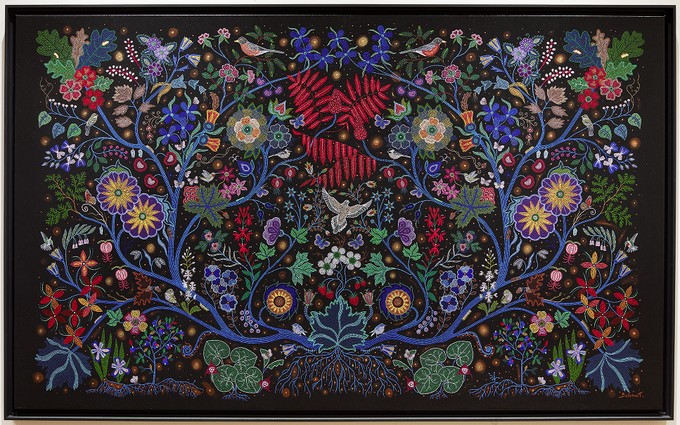
I was hired to teach in St. Mike’s interdisciplinary Christianity and Culture programme in 2004. At least since that time, the story of the University has always been told in a fairly straightforward way:
St. Michael’s was founded in 1852 by Bishop Armande de Charbonnel, the second Bishop of Toronto, who entrusted the school to his childhood teachers—the Basilian Fathers of Annonay, France—in 1853. The University would continue to grow, becoming a leading centre of international scholarship within a century of its founding.
When asked about the particular tract of land—Clover Hill—on which the University sits, presidents and chancellors will push the story back one frame, praising the prominent Catholic convert, John Elmsley (1801–1863). Elmsley gifted Clover Hill to the Sisters of St. Joseph and the Basilians for the specific purpose of responding to de Charbonnel’s request. And there, at least in its usual telling, our story ends. In our collective memory, the University and the land it occupies more or less spring into being from the heart of the Church, aptly symbolised by Elmsley’s own heart, now lodged in the walls of our collegiate parish. It’s a beautiful, inspiring story for me, as a Catholic convert myself and as a member of the college faculty.
The story is also, regrettably, a pernicious lie.
I am being deliberately provocative here. I don’t actually doubt that Elmsley transferred a piece of paper he had acquired for these lands to our founding religious congregations in 1851. The lie is not in what our collective memory affirms; it is in what it presumes or, worse, deliberately hides from view. The lie is in the unspoken assumption that the land was Elmsley’s to give.
How might we remember our story more truthfully? A couple of years ago, as part of a larger project, I asked a talented Ph.D. student at the Department for the Study of Religion to research this question. She wrote a new history of the land, one that begins in the year 900, rather than 1851. Here is a selection from her executive summary:
People have lived on this land for thousands of years according to Anishinaabe oral traditions. First Nations such as the Haudenosaunee, Wendat, Anishinaabek, and Tionnontati, traveled and made homes in this part of Turtle Island for centuries. More recently the Mississaugas of the Credit have belonged here, when they migrated south via the Carrying Place trail in the late 17th century.
Europeans began arriving in Turtle Island in the 1600’s. In 1805 the British Crown illegally claimed the land north of Lake Ontario for the city of York—what is now Toronto—in order to establish a capital for Upper Canada . . . The first Lieutenant-Governor of Upper Canada, John Graves Simcoe, nonetheless established York in 1793, 12 years before the Crown deemed the Toronto Purchase official, and despite protests from the Mississaugas. He divided the land into Park Lots: long rectangular-shaped sections of land that ran between what are now Queen and Bloor streets.
The University of St. Michael’s College lies on what was originally Park Lots 9 & 10. These lots were owned by John Elmsley, a Chief Justice of Upper Canada. When his son—also John Elmsley—inherited the land, he donated two acres of Clover Hill to the Sisters of St. Joseph in 1851 and then four lots to the Basilian Fathers for a new St. Michael’s College site.
—Sarina Annis, “This Land.”
The full narrative is definitely worth your time. It includes references, archival images of relevant treaties and other legal documents, and links to First Nation and Canadian government web sources on the history of Tkoronto.
Now, I want to be clear that I do not think that this longer history is “the truth.” Haudenosaunee colleagues in particular might question some of its claims. But I have reason to believe such colleagues would also view it as a vast improvement over the story we have been telling ourselves so far—precisely because it draws attention to our collective lie about the land.
What significance might a new narrative have for St. Mike’s as a university community? We cannot undo the past. We can, however, choose to remember that past more truthfully and to begin taking real steps to (re)build relationships. Consider the financial settlement reached between the Mississaugas of the Credit and the Government of Canada in 2010. This settlement does not resolve all outstanding differences or redress most specific harms of the Toronto Purchase. It does mean that, a full six years after I settled into my new job and office in Odette Hall, the University’s claim to set that building on that land attained some degree of moral legitimacy. Beyond this, through a partnership with SHARE, the USMC administration is exploring ways to deploy its financial assets—a primary fruit of the illegitimate acquisition of land—to advance initiatives related to (Re)Conciliation.
We are an academic institution, of course, and the main fruit of re-remembering this land will be in our teaching and research. There are tentative signs of movement on this front. The Faculty of Theology and the College division have introduced new courses responsive to the Truth and Reconciliation Commission of Canada. Along with our academic partners in the wider University of Toronto community, we have begun to include a land acknowledgement at the beginning of major events and many of our classes—and also on our website. I was relieved to learn that, in the wake of the horrific discovery of 215 unmarked graves at Kamloops, St. Mike’s joined other members of the Association of Catholic Colleges and Universities in Canada in calling for greater accountability on the part of the global Catholic Church and our own academic institutions. Some St. Mike’s staff, faculty, alumnae, administrators, board members and benefactors have also raised their own voices in grief and protest.
These are initial steps, of mainly symbolic value. In the coming months and years, we will learn whether and to what extent we are committed to translating them into substantive action. If we do make such a commitment, I believe, it will follow at least in part from our willingness to re-remember our own history, and the longer story of this land.
This post was amended on June 24, 2021 to note that the Kamloops discovery was of graves rather than bodies.
Read other InsightOut posts.
Laurie Morris is communications director at the University of St. Michael’s College and the proud owner of a Conklin Carnival t-shirt. She holds a B.A. in English from U of T and a certificate in Corporate Social Responsibility from St. Michael’s.
Appreciating the Gifts of Dad
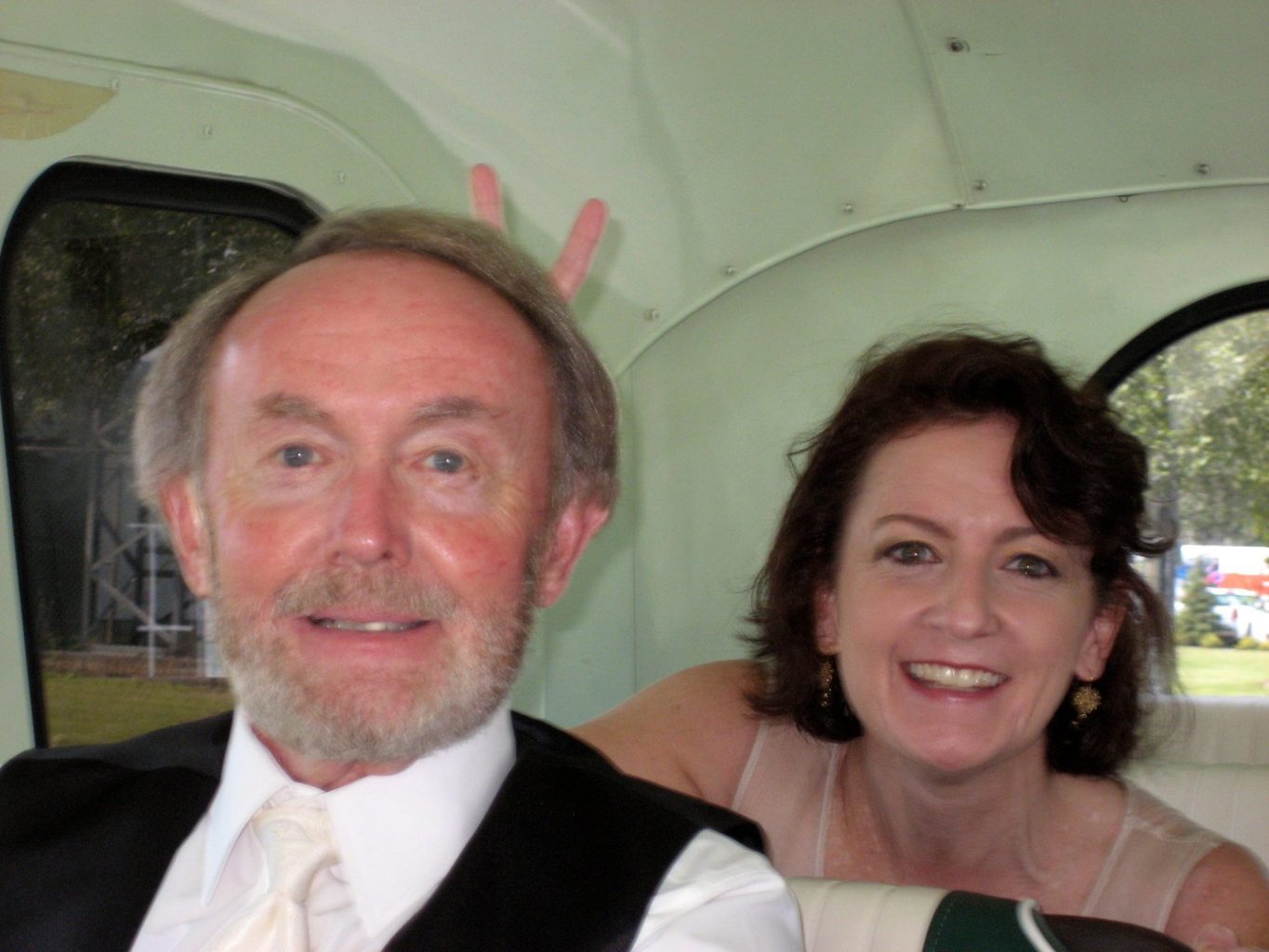
As Father’s Day approaches, I’m thinking about my late father more than usual. He wasn’t a prodigy, but he definitely had a record of doing things at a young age.
My dad married at a young age. He was 19, and my mother had just turned 20. They met in September at teacher’s college, went to the Royal Winter Fair on their first date, and got married that summer after graduation. My mum got a job at St. John Fisher teaching Grade 4 while my dad found himself at what was then called John Newman Catholic School, teaching Grade 8, which made him about six years older than his students.
Both my parents were very committed to education. Once I came along, the only way for my dad to complete his Bachelors’ Degree and go on to get his MEd was to do it outside of his actual teaching job, going to school nights, weekends, and throughout the summer—shout-out to Woodward (7T4). I didn’t see much of his day job, but I do remember him coming home after night courses and greeting him with a hearty “Hi, Dave!” much the way my mother did.
The earliest memories I have of my dad “at work” are of his summer job. He worked at a service station fixing cars, pumping gas and—most impressive to my five-year-old self—he got to feed the guard dogs that lived out back in the junk car lot. He would sometimes bring home monarch butterflies that had found themselves on the wrong side of the front grill of a car. Although dead, they remained fascinatingly beautiful. As far as I was concerned, my dad had the coolest job in the world. It was only later toward the end of that same summer, as the days got shorter and the nights began to cool down, I found out that my dad was actually a teacher, and that he would be heading back to school in September. I was shocked and not just a little disappointed. I was also very suspicious about what else my parents had been keeping from me. It was soon after that my sister Lisa was born.
My dad became a principal at a young age. He had very strong views about education—and everything else for that matter—but as an educator and an administrator he was very focused on meeting the needs of every type of learner. He and my mother ended up at the same school, Dad as principal and Mom as resource teacher (fortunately I was at a school a few miles away) and there they had the opportunity to pilot a number of teaching approaches for children on the autism spectrum, as well as increasing support services for children with learning disabilities and expanding literacy programs.
As I became a sullen teen, I frequently challenged his desire to “work for the man” that was the Catholic school board, which at the time—at least at my high school—shied away from teaching evolution and characterized anything non-Catholic as “other religions.”
We often argued it out at the dinner table. He’d listen, I’d rant—he’d listen again and then say: “Laurie, if you want to make change, you have to get in there and make change. You have to co-opt the system to change the system.”
My dad died at a young age, in 2013. He was 67, and as much as his students benefited from teaching innovations in his elementary schools, he also benefited from a U of T teaching hospital where his unique health issues were finally diagnosed. Later, the complexities of his condition became the topic of many white papers. While dying, he became a case study that advanced learning in research and health care.
I miss my dad at least once a day. I miss the way he could laugh so hard that he’d lose breath. I miss his ability to fix pretty much anything with WD-40 and epoxy glue. I even miss arguing with him. I appreciate the gifts he shared and the things he taught us. Father’s Day and every day, I’m encouraged to be more like him.
Read other InsightOut posts.
Sarah Figueiredo is a Humber Post-Graduate Public Relations student on internship with the St. Mike’s communication team. Previously, she completed her Honours Bachelor of Arts in Economics at McMaster University, where she took an active role is student life on campus, finding a passion for improving the post-secondary student experience. Sarah currently resides in Cambridge, ON.
The Ethernet Connection: Starting a Digital Internship at St. Mike’s
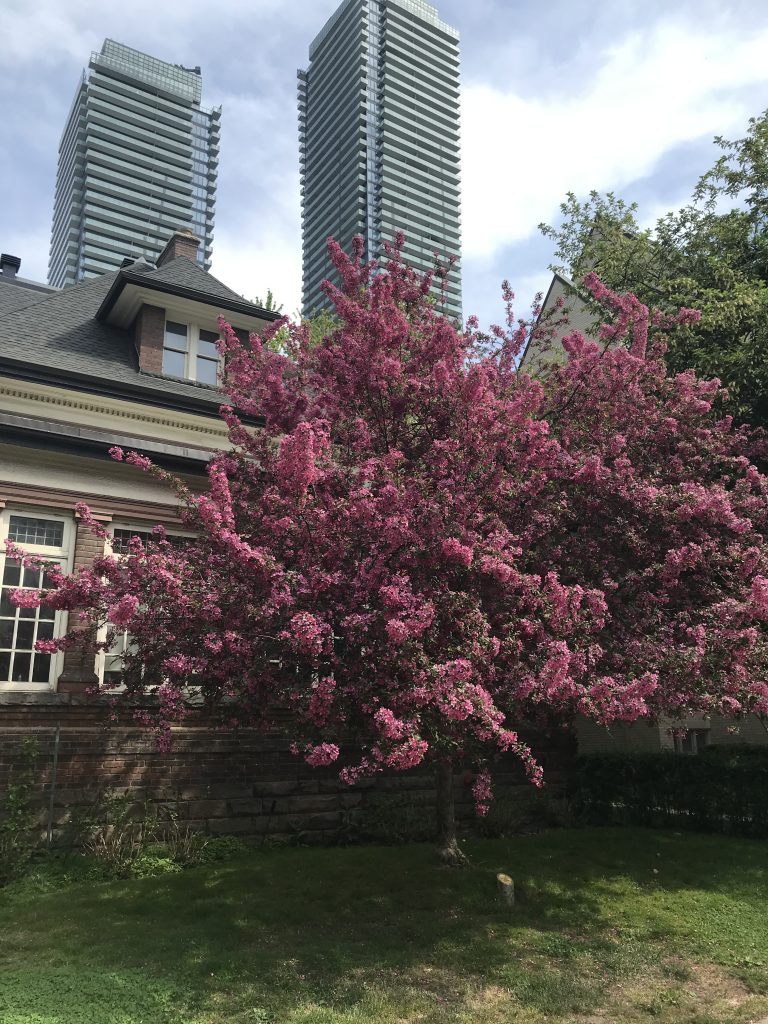
Typically, I imagine parents aren’t such a present part of an internship’s first day.
Truthfully, as my commute to the office was a short 15 steps from my bed to my computer, I should have expected 2021’s unusualness extended to internships.
Starting an internship in a pandemic is both a standard and a unique experience. Contradictory, I know.
On the one hand, I had my parents popping their heads into my “office”—a somewhat quiet corner of the house where I stationed my laptop and ring light—to say good luck and offer snacks. On the other, I have a group chat full of program peers who were carefully monitoring their mute buttons as well.
Venturing on this journey with the rest of my cohort helped make this COVID internship feel somewhat normal. Two days before my official start with the St. Michael’s team, I met with my classmates. Naturally, the conversation progressed to impending internships.
Those who already started spoke of awkward Zoom hellos or introduction emails with a generous amount of exclamation points. Others who were waiting to start listened eagerly, taking mental notes. Finally, we fell into the comfortable pattern of sharing fears, fumbles, and fulfillments.
The sense of place I felt in my program was a constant in a changing world. Taking a step outside the virtual classroom and away from my peers felt like ripping away the security blanket we’d knit together the past eight months.
But, I’ve been told a little rain will make the flowers grow. As St. Mike’s is a place where physical flowers and the bloom of knowledge thrive, I knew a bed of support would cushion my next scary step. Unfortunately, though, that didn’t make it less intimidating.
I assume the first day of an internship typically starts with stopping by your supervisor’s office to say hello and possibly setting up a desk or computer. My supervisor was currently on the other side of the country. My bubble-wrapped computer was delivered to me fully configured to take on the day.
So instead, I started my internship doing what any student is so naturally inclined to do—I researched. Beginning with the St. Michael’s 180 strategic plan, I reviewed the college’s priorities, scrolled through official Twitter pages and dug deep into the Google abyss.
I’m also not above admitting I spent maybe a bit too much time stressing how to Zoom-introduce myself. Should I say a fun fact about myself? Do I even have fun facts about myself? What camera angle looks the friendliest yet professional? Wait, maybe it will be a camera-off meeting?
I’m happy to report that my overthinking was unwarranted, as my first day started with my new coworkers projecting warmth and welcome through their webcams. The format wasn’t unique in any way, a simple introduction with an explanation of your role. I nervously forwent the fun facts. But, the team’s smiles paired with their genuine interest in my story differentiated this Zoom call for those my peers spoke of.
This atmosphere was evident in all encounters I had that week. Whether it be through hello emails or individuals reaching out to offer help, it was clear the USMC team took fostering community seriously.
Later in the week, I enjoyed attending my first virtual work lunch soiree, and I genuinely mean it was a pleasure. The group seemed to make the simple game of virtual two truths and a lie evoke genuine laughter instead of awkward Zoom talk my peers have talked so much about.
From stories of past jobs to celebrity run-ins, the group welcomed me into their pasts with no hesitation. I was honoured with the trust they bestowed on me, having been a part of the team for a mere 72 hours.
I felt a sense of place in the openness and camaraderie as I sat alone, 110 kilometres away. I did not need to trek to St. Mary Street to feel a community.
Looking back on my first week, my only regret is not sharing an exciting insight or fact about myself during that first welcome meeting. I was lucky as St. Mike’s is where the community is encouraged to reach out first; I had many chances to let the team get to know me. Though had it not, I’m not sure how long I would have spent finding the courage to build more than an ethernet connection with my new community.
So, to my fellow digital interns, I have a dare for you—I dare you to be open and authentically yourself every moment of your next adventure. I assure you, especially if you find yourself in the (digital) halls of St. Mike’s, it will be worth the risk.
Read other InsightOut posts.
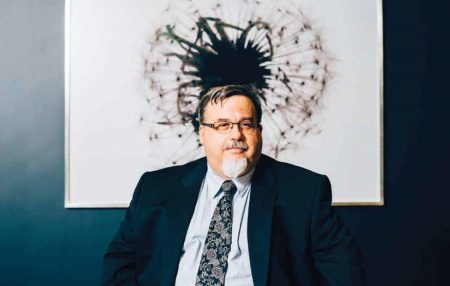
Dr. James Ginther, former Dean of the Faculty of Theology, has been appointed Associate Director of the Centre for Medieval Studies (CMS) at the University of Toronto, effective July 1, 2021. A mediaeval historian and professor of Church history, Dr. Ginther will continue to teach at St. Michael’s during his three-year appointment to the Centre.
“This appointment speaks to the close ties we have both to CMS and to the Pontifical Institute of Mediaeval Studies (PIMS),” says St. Michael’s President Dr. David Sylvester. “Jim, who is also an Associate Fellow at PIMS, will be a valuable asset to the Centre.”
Noting that Dr. Ginther will take over the role from St. Michael’s professor Dr. Alexander Andrée, Dr. John Magee, the Centre’s Director, says he is “very grateful for his willingness to take this on, and for USMC’s and the Faculty of Theology’s cooperation in making it possible. Jim brings excellent administrative experience to the position and, perhaps most importantly, will form an important part of the connective tissue between the Centre for Medieval Studies, St. Michael’s College, and the Pontifical Institute of Mediaeval Studies.”
Dr. Ginther describes his responsibilities at CMS as primarily student focused.
“I will be overseeing recruitment and admissions of new MA and PhD students and will serve as the faculty advisor to all MA students. I’ll also be responsible for developing funding packages, including assigning teaching assistant and research assistant positions to incoming and returning students.
“This is what excites me about the position: supporting students so that they can excel in the program, and providing opportunities for professional development where the Centre can.”
Dr. Ginther, who earned his doctorate at CMS, was named Dean of the Faculty of Theology in July 2015. His research is primarily focused on 12th- and 13th-century European theology. He is currently leading a SSHRC-funded project that will produce an edition of Stephen Langton’s lectures on Genesis. He teaches courses in medieval church history, Anselm of Canterbury, the medieval theology of creation, and methods in historical theology.
For the past 20 years Dr. Ginther has also worked in digital humanities, collaborating on several large projects, including the digital tool T-PEN (Transcription for Paleographical and Editorial Notation, www.t-pen.org). While at CMS, he will also work on enhancing its existing programs in digital humanities. One possibility, he notes, would be finding ways to connect the Global Classroom project at St. Michael’s with the mediaevalists who teach in the digital humanities minor.
In 2020, St. Michael’s signed a five-year memorandum of understanding with the University of Toronto and the Pontifical Institute of Mediaeval Studies to focus on new possibilities for cooperation and partnerships for CMS, PIMS and St. Michael’s via research, teaching, and publication. While each party remains distinct, the agreement suggests possibilities such as joint academic seminars or colloquia, as well as less formal scholarly collaboration. It also notes that the PIMS library collection will continue to be housed in the John M. Kelly Library.
“I am pleased that Jim has this exciting opportunity to continue using the leadership skills he displayed during his term as Dean of the Faculty of Theology,” says Interim Dean Dr. John L. McLaughlin. “I know that CMS will benefit greatly from his service as Associate Director during this partial secondment, and I look forward to an enhanced relationship between CMS and the Faculty of Theology.”
Dr. Darren Dias teaches in St. Michael’s Faculty of Theology, specializing in Trinity, Religious Diversity, and teaching methods. He is currently working of a SSHRC funded project with colleagues Gilles Routhier (Laval) and Michael Attridge (St Michael’s) entitled: “One Canada, Two Catholicisms: Divergent Evolutions in the Catholic Church in Quebec And Ontario, 1965–1985.”
Burning up Privilege
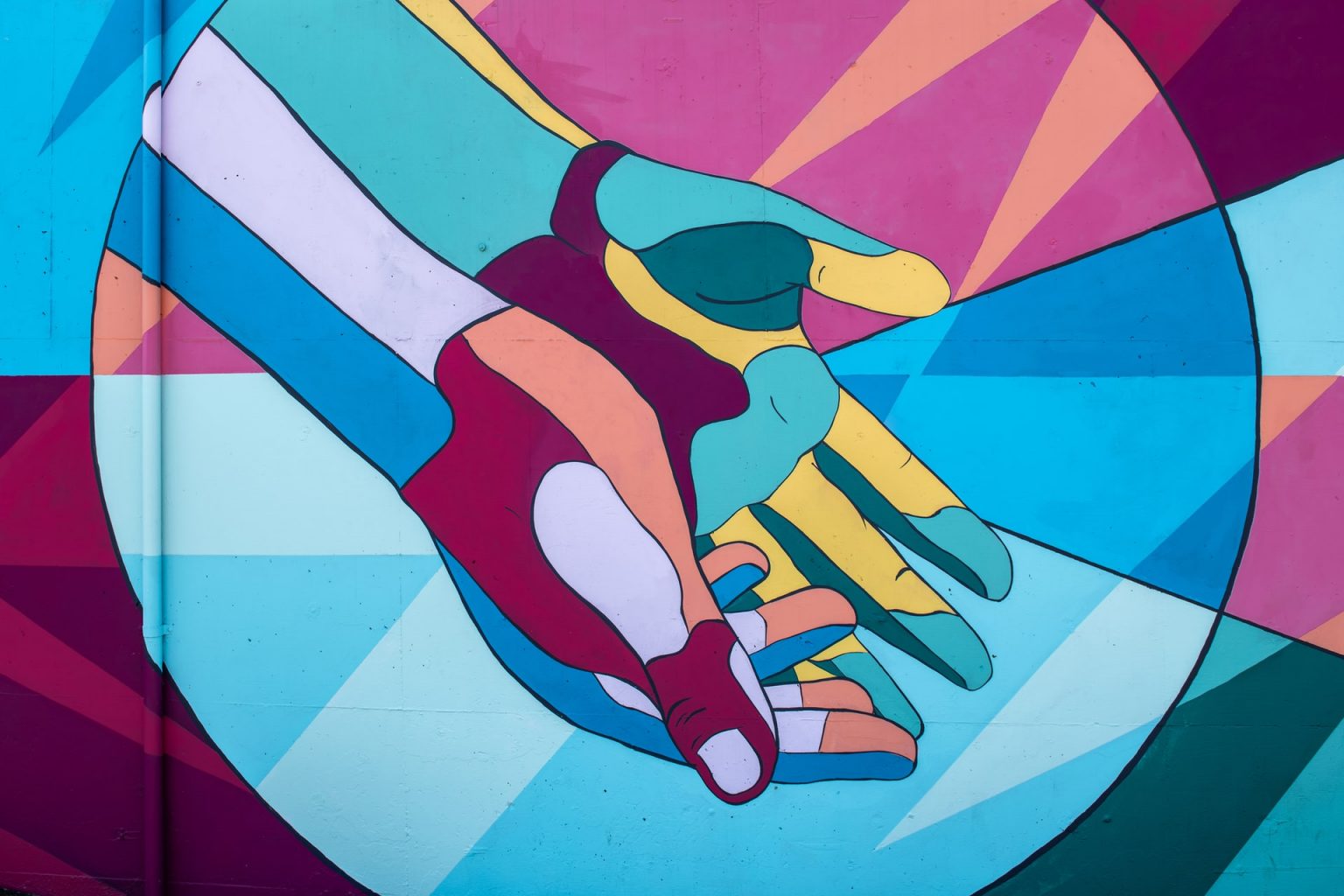
On May 10 the University of St. Michael’s College hosted a colloquium on the role of the Catholic university in the 21st Century. A statement was made by one of my co-panelists and colleagues that “racists should be welcome here [St. Mike’s] in love and in truth.” If the statement itself was surprising, perhaps the silence with which it was met was even more so. Not one participant, me included, no one from among the faculty, staff, or leadership challenged that statement.
Perhaps there were reasons for not responding. Zoom is not the most conducive medium to discuss difficult topics. It’s likely that some people were simply not paying attention behind their faceless Zoom screens. People may not have wanted to draw attention to a remark that might have drawn us away from what they thought were more important foci of the colloquium. Or else there may still be a certain amount of discomfort talking about issues such as racism, sexism, homophobia, etc., even in an open academic forum, whether on Zoom or in person. But as the days passed after the colloquium, I thought about what the statement “racists should be welcome here in love and in truth” and the idea that a “discussion group for racists” could be established at St. Mike’s sounded like for the few racialized students and staff participating in the colloquium. And then I thought about the effects of our silence. Increasingly, I felt that not saying anything was irresponsible of me.
As astounding as it might seem in 2021, to my knowledge, I am the only racialized member of the teaching faculty at St. Mike’s. As such, it is has become both my privilege and responsibility to speak to racism and to try to advocate for those who are underrepresented in the academy whenever I can. My seemingly broken record interventions are authentically welcomed by my colleagues. There is no small amount of irony that I do what is expected of me, performing my own racialized identity in my interventions. A few years ago, my then only female colleague in my faculty and I lamented the conventional roles we played in faculty meetings and discussions. She found herself gently but firmly drawing our attention to sexist language and micro-aggressions as though this had become her responsibility instead of a shared responsibility of all community members. Maybe that’s why I didn’t say anything at the time; maybe I hoped someone else would.
If indeed silence is consent, then such statements should not be met with silence. The statement “racists should be welcome here in love and in truth” is provocative and merits response, especially for the sake of the few racialized participants in that colloquium as much as for the wider St. Mike’s community. I’d like to now say what I should have said then: racists should not be welcome at St. Mike’s.
A Catholic university is not a parish, or pious association, or a catechetical institute. Like any university, it is a place for serious, critical, and rigorous academic dialogue and debate. These dialogues and debates are based on accepted facts and not opinions. Racist beliefs and theories are predicated on theories of white supremacy. While these theories may have been taken seriously many years ago in disciplines like phrenology, biology, philosophy, and theology, they have since been debunked based on evidence (or lack thereof) and uncovered for what they truly are. No academic discipline holds even a remote possibility that theories of white supremacy are true or worthy of debate. Further, they are not only false but exceedingly dangerous. Having a discussion group for racists would be akin to inviting people who contend that the earth is flat to an academic discussion with members of the astronomy department or asking biologists to debate the merits of spontaneous generation.
The idea that racists should be welcomed or a discussion group for racists be established on campus seems to be predicated on the questionable claim that catholicity means a Derridean form of “pure” or “absolute” hospitality. Absolute hospitality “welcomes whomever or whatever arrives, without calculation or limit, without concern for self-protection… [it] entails the surrender of one’s home, one’s identity, even one’s life.”[1] This contrasts “conditional” hospitality as the gracious and willing “reception of a guest into safe and friendly space.”[2] All hospitality, in reality and practise, is conditional with “thresholds of possibility, limits and conditions that allow hospitality to be what it is.”[3]
For St. Benedict, all guests, strangers and pilgrims, should be welcomed as if they were potentially Christ. Chapter 53 of the Rule of St. Benedict instructs the monks, however, that before the stranger can be welcomed into the community, the superior and brothers must first meet the stranger in charity and pray together for peace, before exchanging the kiss of peace (the sign of welcome). The wise and prudent Benedict warns his monks that the kiss of peace should not be exchanged until it can be established that the stranger brings peace and not “the devil’s deceptions” into the community. Even for Western Christianity’s great proponent of welcome, hospitality has its limits when it poses a threat to the wellbeing of the community. Racism is not just a bad idea but an embodied practice that threatens the psychic, psychological, spiritual, and physical well-being of members of the university community. Racialized members already find themselves at risk in so many ways outside of the aspirational safe and friendly space of the Catholic university. Thus, racists should not be welcome into the space of the Catholic university.
One of my colleagues once offhandedly used the term “burning up privilege.” It has stuck with me ever since. He was referring to ways in which he used up his own acknowledged privilege as a white male university professor to empower others—something he does intentionally and regularly. We “burn up” the privilege that we have not earned to draw others into safe and friendly spaces for exchange, rigorous and critical debate. I think this is what a popular rabbi and itinerant preacher from Nazareth did about 2,000 years ago when he “burned up” his privilege to touch lepers, allowed himself to be touched by prostitutes, ate with sinners and tax collectors, and spoke publicly against religious and social structures that dehumanized. He burned up his privilege, sharing it with those without in order to empower them. Eventually he burned it all up. And we know where that got him. No one was willing to burn up their privilege for him: neither his elite followers nor his most intimate friends would speak up for him. In fact, they denied him into silence. He threw his lot in with the likes of Colten Boushie, Alana Cardinal, Breonna Taylor, Joyce Echaquan and the countless other victims of racism today.
[1] Jessica Wrobleski, The Limits of Hospitality (Collegeville: Liturgical Press, 2012) 22.
[2] Wrobleski, xi.
[3] Wrobleski, xi.
Read other InsightOut posts.
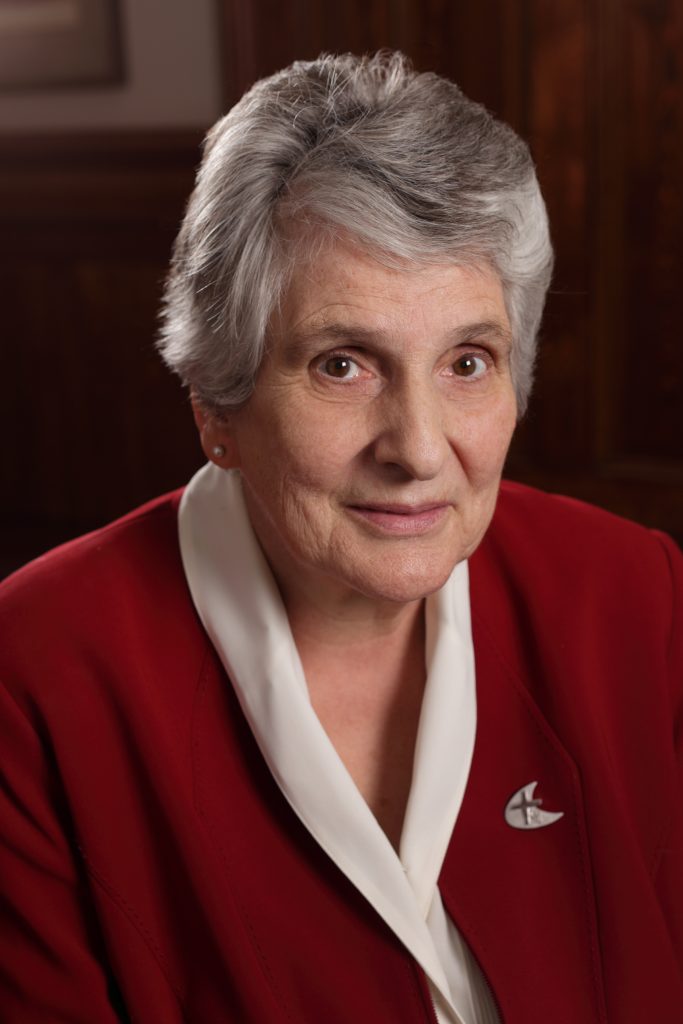
The University of St. Michael’s College offers heartfelt congratulations to Sr. Anne Anderson, C.S.J., on being named this year’s recipient of the Lifetime Achievement Award from the Catholic Health Alliance of Canada.
“Sr. Anne’s dedication and contributions to both health care and higher education in Ontario have been boundless,” says University President David Sylvester. “She has brought the same passion to health care that she has provided to St. Michael’s in her lengthy career here. We remain grateful for her insights and energy.”
Chair of the St. Joseph Health System Board of Directors, Sister Anne has been a past President of the Catholic Health Association of Ontario and member of the Board of Directors of the Catholic Health Association of Canada.
She was appointed President and Vice Chancellor of the University of St. Michael’s College in Toronto in January 2009, having previously served there as Interim President as of July 2008, in addition to her duties as the Dean of the Faculty of Theology. Sister Anne has been a member of the Sisters of St. Joseph of Hamilton since 1958, and served the Congregation as General Councillor and General Treasurer from 1999-2009.
The Lifetime Achievement award was made at the CHAS annual conference, taking place virtually May 6 and 7. The alliance states that “Catholic Health Care in Canada has been blessed with a legacy of faithful leaders whose dedication throughout their careers has built the ministry and ultimately brought healing to persons and communities.”
Sr. Anne, it notes, it notes, is one such leader, a person who has “inspired and mentored numerous others in Catholic health care and whose accomplishments, over the course of a career, have strengthened the ministry.”
“Whether it’s encouraging and supporting students or safeguarding—and advocating for—patient-focussed healthcare, Sr. Anne is a powerful ally. This honour is well deserved,” says Faculty of Theology Interim Dean John L. McLaughlin.
Martyn Jones is a content specialist in St. Mike’s Office of Communications. On a freelance basis, he also writes reported features, essays, and criticism for online and print outlets. He and his wife Melanie are the parents of two boys.
The Hidden Life of Moms

My wife and I welcomed our second child into the world on March 17 of this year. Bauer Timothy Jones has been a quiet baby so far, but it’s unclear to us whether that’s because of a personality difference between him and our older boy Fox, or because we have been better able to meet his physical needs before they foment emotional crises.
Because of the ongoing pandemic, my wife’s maternity leave so far has mostly taken place within view, or within hearing distance, of where I work during the day. Often, I need only to look up from my screen to be able to see her and the baby. It’s a major improvement over my reliance on texted photos and videos during our last-go-round. Being present for these earliest days of Bauer’s life is one of the great unsought gifts of this era in our lives.
Melanie demonstrates an easy, unselfconscious care with the baby that two years ago she and I would have regarded with envy and admiration. The philosopher Søren Kierkegaard has a passage in his most famous book, Fear and Trembling, about how a person learns to swim by attempting with each stroke to make the ideal or infinite gesture—to imitate their idea of the “form” of swimming. However, once the swimmer has internalized the form, they can swim freely, making each stroke without reference to anything but how fast they want to go and the conditions of the water.
Fox, our first child, almost overwhelmed us at this stage in his life. To continue Kierkegaard’s metaphor, with every wave we struggled anew to figure out how to stay afloat. Innocent of experience and sleep-shocked, we were left to rely on things we’d read or watched, the half-remembered examples of our own parents, and decades of media representations of parenthood. We hadn’t yet internalized the form.
Things are different now. My wife acts from years of constant and very physical practice, with a level of dedication that goes beyond that of professional athletes or musicians because there isn’t a time of day when she isn’t a mom. To see her expertly remove Bauer from harm’s way when our toddler Fox wobbles on top of his climbing frame, or to observe the balletic grace with which she scoops the baby out of his bassinet while cradling the back of his head, is to catch sight of a kind of pure human excellence it’s easy to miss without the frame of a television camera or an announcer’s hyped commentary.
Mother’s Day is often an occasion for celebrating feelings—love, compassion, and all the other things we associate with moms, especially our own. Mel and I are both fortunate to have been raised in loving and supportive homes, and I in no way mean to discount the emotional dimension of the holiday. But what I see and find remarkable to reflect on now is the myriad of physical activities that give love its meaning, and the domain of learned competencies with a huge variety of tasks that, while unexciting on their own, add up to the work of love itself.
Love is a verb, after all, as the CCM band DC Talk emphasized repeatedly in an energetic hit single by that name that came out during my childhood. While I used to enjoy late-night conversations in the dorm about love’s many possible meanings and aspects, and about the theological and philosophical frameworks that can give it even more meanings and aspects, at this point in my life nothing is so interesting to me as the simple acts and gestures that convey love without announcing it.
Mel is downstairs with Bauer right now coaxing him to sleep, as my own mother did with me, and her mother did with her. Mother’s Day is an occasion for celebrating all these tiny and unsung acts of love that make whole lives possible. As George Eliot writes in the novel Middlemarch, “But the effect of her being on those around her was incalculably diffusive: for the growing good of the world is partly dependent on unhistoric acts; and that things are not so ill with you and me as they might have been, is half owing to the number who lived faithfully a hidden life.”
Read other InsightOut posts.
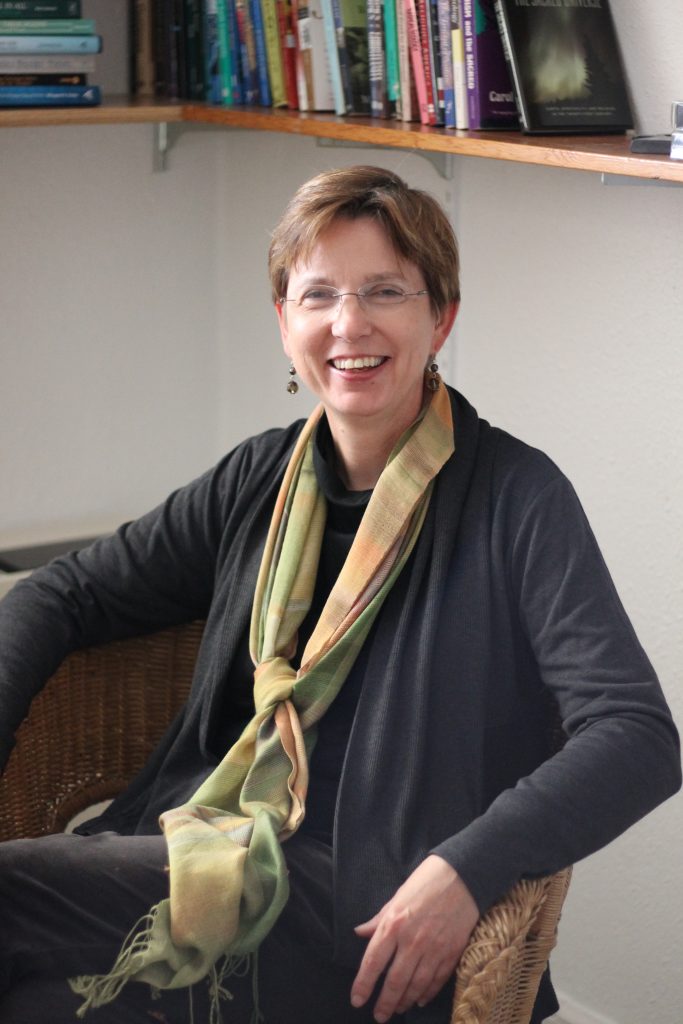
The new director of the Elliott Allen Institute for Theology and Ecology, Dr. Hilda Koster, sees the EAITE moving forward in the spirit of Laudato Si’, with particular attention to the needs and concerns of women, minorities and Indigenous communities.
The Institute, celebrating its 30th anniversary this year, was created by Fr. Stephen Dunn to address growing interest in the intersection between faith and the natural world.
“It is a great honour to be appointed Director of the Elliott Allen Institute, which has played such a prominent role in the development of ecological theology in Canada, especially by way of its sustained attention for the work of the visionary theologian Thomas Berry,” says Dr. Koster. “I am very grateful for the important work of the Institute’s founder Fr. Stephen Dunn, C.P., and his successor Dr. Dennis O’Hara. It is a privilege to carry their legacy forward.”
Strong leadership of the EAITE reflects the university’s core values expressed in St. Michael’s 180 strategic plan, says University President Dr. David Sylvester.
“We place great importance on our mandate to promote respectful dialogue on care for each other and for our common home. The work of the Institute helps to further St. Michael’s core values, and Dr. Koster will be an invaluable addition,” Dr. Sylvester says.
The Faculty of Theology is especially pleased to have found someone so well equipped to run a centre known around the world for its groundbreaking research and training, says Interim Dean Dr. John L. McLaughlin.
“Dr. Koster’s appointment as Director of the Elliot Allen Institute is good news not only for St. Michael’s but for anyone who cares about ecological theology as well as environmental and social justice,” Dr. McLaughlin says. “Since the EAITE was founded by Fr. Stephen Dunn in 1991 it has been shining a light on the kinds of issues Pope Francis addressed in his 2015 encyclical Laudato Si’: to recover our relationship with the natural world while also working for environmental justice.”
The need to examine ecological concerns in a theological light has never been greater, Dr. Koster says.
“Historically Christianity has not paid much attention to humanity’s relationship to the natural world but in light of climate change, overconsumption and species extinction this has become an essential area of theological reflection,” she says.
“Studying Theology and Ecology allows students to make connections between their faith traditions with knowledge of and appreciation for the more-than-human world. Yet ecotheology also will allow students to think deep and hard about the spiritual and moral challenges that result from our human caused destruction of precious ecosystems, and the suffering this is causing to vulnerable human communities.
“The Elliott Allen Institute therefore takes its lead from Pope Francis’ insight that ‘a true ecological approach always becomes a social approach; it must integrate questions of justice in debates on the environment, so as to hear both the cry of the earth and the cry of the poor (Laudato Si’, 49)’. We need educators, chaplains, social workers and scholars who have the competency to work with others to realize a more just and sustainable future for all, especially the poor.”
Born in the Netherlands, Dr. Koster received her Bachelor of Arts and Master of Divinity degrees from the University of Groningen. After further study at Princeton Theological Seminary and the Candler School of Theology at Emory University in Atlanta, she earned her doctorate at the University of Chicago. She joined St. Michael’s Faculty of Theology in July 2020, with teaching areas of ecotheology, feminist theology, and ethics. She assumes the directorship of the EAITE on July 1, 2021.
Describing the new Director as a “wonderful addition” to the Faculty, Rosemary Boissonneau, Dr. Koster’s research assistant, says Dr. Koster “challenges her students to look deeper and investigate theologically the conceptual frameworks and structures of domination underlying the socio-ecological crises of our times. I am confident that under her directorship, the Elliott Allen Institute for Theology and Ecology will be reinvigorated to continue its legacy as a vital centre of ecotheological learning and research.”
The EAITE is a collaborative teaching and research institute which offers a certificate of specialization in Theology and Ecology, as well as stand-alone Graduate Diploma in Theology and Ecology. Its interdisciplinary, collaborative nature brings a range of academic voices from the sciences and humanities into conversation on matters of the day.
The 10-course diploma is aimed at professionals and students who wish to integrate the study of environmental issues and theology in their professional careers, as well as for those who wish to study the theological and ethical dimension of environmental problems. It includes five foundational courses, one in-depth course, two ecology and theology-specifics courses, one experiential course, and one capstone course.
The newly revised certificate is open to anyone enrolled in any of the graduate programs at the Toronto School of Theology seeking to specialize in Theology and Ecology. Certificate requirements vary depending on the program being completed.
“The Elliott Allen Institute will continue to be a place for innovative theological education and scholarship, with attention to the voices of women, minorities and Indigenous communities,” says Dr. Koster.
For more information on the Elliott Allen Institute’s offerings, please contact Programs Coordinator Anthony De Feo or Dr. Koster directly.
The University of St. Michael’s College is pleased to announce it has ratified agreements with both the University of Toronto Faculty Association (UTFA), which represents Faculty and Librarians, and the United Steelworkers’ union, which represents administrative, facilities and services staff.
Following ratification votes from the union membership, the University’s Collegium Executive Committee ratified both agreements at its meeting on March 17th, 2021. The signed Memoranda of Settlement are posted on the USMC HR webpage (https://stmikes.utoronto.ca/human-resources). The term of the UTFA contract is from July 1, 2020 to June 30, 2023.
The renewal agreement with USW is for a one-year period, running from July 1, 2020 to June 30, 2021
The University thanks the members of both bargaining teams for their hard work, commitment and dedication throughout the bargaining process.
Negotiations with CUPE, the union representing sessional instructors, teaching assistants and writing instructors, are expected to begin in the upcoming months.
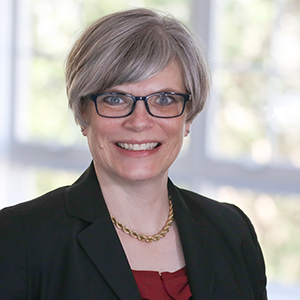
The University of St. Michael’s College is celebrating the appointment of Dr. Cynthia Cameron to the Patrick and Barbara Keenan Chair in Religious Education as a crucial step in renewing the vital relationship the University has with Catholic educators.
“The appointment of Dr. Cameron embodies St. Mike’s commitment to honour and build upon these historic partnerships in Catholic education through teaching and research, serving teachers and administrators not only here in Toronto but also across the province and, indeed, the country,” says University President Dr. David Sylvester.
Cameron, who has a special interest in the development of Catholic adolescents and the impact of ministry in schools, is currently an assistant professor of Religious Studies at Rivier University in New Hampshire. She will join St. Michael’s Faculty of Theology on July 1, 2021. She has also taught at Boston College, Loyola University New Orleans and Sacred Heart University in Connecticut.
“I am delighted to be joining St. Michael’s because it is an extraordinary opportunity to work in a world-class faculty and to think theologically about Catholic education with colleagues and students who are as passionate about it as I am,” says Cameron, who earned her doctorate in Theology and Education from Boston College. “It is also an honour to be the next Keenan Chair and to be a part of important conversations about Catholic religious education in Ontario.”
Cameron’s research focuses primarily on the intersection of Catholic theological anthropology and questions of age—and particularly in regard to adolescents. Her work responds to the question of how age affects the ways we think about what it means to be human.
The question is of particular importance to how ministry is carried out in the Church, and especially in school settings with adolescents, she says.
“My current project involves bringing one age and gender—female adolescence— into conversation with both theological anthropology and developmental psychology in order to think about the mission of all-girls’ Catholic high schools. In it, I suggest that the all-girls’ Catholic high school is a particular place where adolescent girls can fully flourish in a culture that often marginalizes and even damages them,” she says.
Cameron’s research and specialization will be of particular interest to the many Master of Religious Education (MRE) students studying at St. Michael’s who work at the high school level, says the Faculty’s Interim Dean, John L. McLaughlin.
“We are delighted to have Dr. Cameron join the Faculty,” McLaughlin says. “A key component of our institutional mission as a Faculty is to provide educators with a strong theological base to help their students take on life’s big questions. Dr. Cameron’s area of expertise will offer our MRE students invaluable insight and direction.”
Cameron will teach courses within the MRE program, including the Philosophy of Catholic Education, Faith Development Across the Lifespan, and Religious Education in Multifaith Contexts, as well as courses for the MTS and MDiv programs. She will also teach and supervise graduate students through the Graduate Centre in the Toronto School of Theology.
The Keenan Chair was established in 2002 thanks to the generosity of Patrick and Barbara Keenan , launching a major graduate teaching initiative in religious education in Canada’s largest English-speaking Catholic university. Each spring, the University also hosts the Patrick and Barbara Keenan Lecture.
St. Michael’s is a Roman Catholic Faculty of Theology in the Toronto School of Theology, an ecumenical federation of seven theological schools affiliated with the University of Toronto. The Faculty is committed to theological teaching and research that is interdisciplinary, ecumenical and sensitive to multi-faith and multicultural contexts. We seek to form students for service in Church and society through faithful and rigorous scholarship grounded in the Catholic intellectual tradition.
April 19, 2021
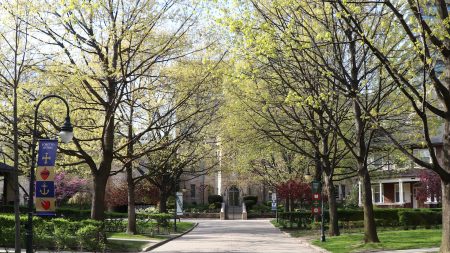
Like most of the St. Michael’s community, the past few months have presented a number of challenges and opportunities for the Comms team. Our ability to work across departments, platforms and institutions is an essential part of telling the St. Mike’s story. As we close out the academic year and begin planning for the fall, I’m delighted to announce a number of departmental changes that will strengthen our ability to raise awareness of the community, education and sustainability themes and goals outlined in St. Mike’s 180.
Catherine Mulroney has been promoted to Editorial Manager. In this expanded role, Catherine will lead the efforts of our newly-formed, cross-university content committee to develop stories that will advance the St. Michael’s narrative across a variety of channels, and she’ll further expand our reach by representing St. Mike’s at the UofT News planning meetings. The University’s biannual Alumni magazine, InsightOut blog and other content associated with the 180 priorities will continue to benefit from her institutional knowledge and deft journalistic hand. As part of our plan to ensure consistent messaging and develop an authentic brand voice, Emma Hambly will report to Catherine, and be responsible for the internal newsletter and a variety of graphic material for social media.
Sheila Eaton has joined Communications as Digital & Graphic Design Manager. Working with Catherine, Sheila has reinvigorated the design of the Alumni magazine and extended that strong visual identity to the St. Mike’s 180 material in print and online. In this new role, Sheila will continue to design material to support St. Mike’s academic programs and the Kelly Library. Her creativity and photographic talent will strengthen our communications material and ensure that it continues to reflect the natural beauty of the campus and represent the diversity of the St. Mike’s community. Sheila will report to me and I’m grateful to the Principal’s office for the opportunity to make her part of the Comms team.
Martyn Jones, the founding – and once ONLY – member of the Comms team will focus his time and talent on the build out of the St. Mike’s website. As the Theology revamp gets underway, Martyn will take the lead on managing the relationship between our internal stakeholders and the vendor. He’ll be able to share what we learn from this process with other departments as he works with you and your departments to enhance your pages. Martyn will also continue to manage institutional social media channels and produce content for the website, working with Catherine.
As the small-but-mighty Communications team continues to evolve, I hope you share my appreciation for everything the team has accomplished and like UofT, look forward with optimism to our return to campus in the Fall. #onward!
Laurie Morris
Director of Communications
Angela MacAloney-Mueller is St. Mike’s Physical Plant Coordinator. She’s been a part of the USMC community since August 1994, and notes that the comfort of students and staff are her top priority. She is, you’ll see, an avid birder.
Bird Nerd on Campus
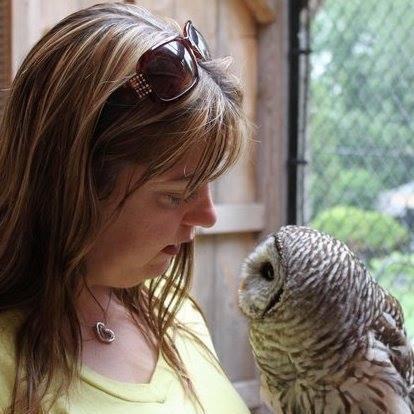
I still remember the first time I visited the campus of the University of St. Michael’s College. It was for a job interview in July of 1994. With the luscious greenery, the full-grown trees and beautiful flowers, the grounds took my breath away. I thought to myself as I was leaving the campus, “Yes, I would like to work here.” Social media accounts for the university often use the hashtag #oasisinthecity and, as it turns out, we humans are not the only species who think so.
Some migratory birds travel thousands of miles twice a year during spring and fall migration. Toronto is on a major migratory flyway, and every spring the nighttime skies are filled with thousands of birds coming north for the summer to set up territory, find a mate and raise young, all before the long journey home. The city, and the campus grounds themselves, with their close proximity to Lake Ontario, are a perfect resting spot for those birds after a long night of travel.
I was working at the Pontifical Institute of Medieval Studies when I started birding more than 20 years ago. I’ve had a couple of lifers at work (a lifer is what it’s called when you see a bird for the first time). The campus gave me my first Oven Bird and Yellow-bellied Sapsucker. The spring offers a chance to see a wide variety of summer migrants, including Baltimore Orioles, Indigo Buntings, Scarlett Tanagers, and so many others. Many of the migratory birds will continue further north to the boreal forest, but a few do stay in and around the Toronto area, like the feisty red-winged blackbird.
Every spring I get work orders regarding the “attack bird” on campus. It seems the last few years a pair of red-winged blackbirds have thought the grounds lovely enough to build a home and raise young. The male is a fierce protector and will often swoop at people if they get too close to their nest—or, in this case just walk along the path. It is illegal to tamper with a migratory bird or its nest, but we have posted signs to warn people of what may happen. I have a lot of respect for the males: I’ve seen one swoop at a bald eagle! Fortunately, the nesting season is short, only about two weeks, and then peace and harmony return to the grounds.
Over the years I have been able to share a little of my knowledge regarding birds on campus. A couple of our yearlong resident bird species come to mind. A former co-worker came to my office one spring morning to let me know that a baby sparrow had fallen from its nest and asked what should we do. He was flabbergasted when I said, “Put it back.” The old myth that a momma bird won’t take care of its young if it’s been touched by a human is alive and well. Birds have no sense of smell, so it is very safe to put them back in their nest if you are able, which we did that day. The chick’s eyes were not yet open, but as soon as we lifted it close to its nest under the Elmsley Hall walkway, it instinctively crawled back into its nest.
Another time, a don in Elmsley Hall called to let me know a student had a baby robin in her room because it couldn’t fly and wanted to know if I could help. We went to the student’s room, where I discovered she had a fledgling. When a baby bird first leaves the nest, it is called a fledgling and is unable to fly for a few days. The mother robin will hide her fledglings in shrubbery, where she we will return and feed them throughout the day. After explaining this to the student, we took the baby robin back outside where she had found it. It wasn’t long before momma robin was there to check on her baby, much to the relief of the student.
The St. Michael’s grounds play hosts to a variety of birds and wildlife year-round. When enjoying the flower gardens during the summer months around Brennan Hall you may see a ruby-throated hummingbird or monarch butterfly. The fall and winter months always bring the hawks to campus, where they help with pigeon control. Spring is the real star of the year though, with the many colourful songbirds and warblers passing through. The chorus of birds singing at dawn and dusk this time is joyful to hear, and I am sure wakes many of our students in residence.
I believe the variety of birds and wildlife add to the campus. Many times, I have seen the delight on a student’s face who has never seen a squirrel before. I’ve pointed out American goldfinches and downy woodpeckers to coworkers when walking from building to building. And it doesn’t matter how many times you see a northern cardinal, you are going to stop and stare at his brilliant red colouring.
Birding for me, as always been a source of stress relief. How lucky we are when on campus, that we can leave our office to walk to a meeting in another building or just to enjoy the grounds and surround ourselves in nature. The St. Michael’s campus truly is an oasis in the city.
Read other InsightOut posts.
Emma Hambly is a communications coordinator at the University of St. Michael’s College. She has a B.A. in English Literature and Classics from McGill University, and an M.A. in Literatures of Modernity from Ryerson University. In her spare time, she sews, makes collages, designs zines, writes comics, and looks for more hobbies.
A year of friendship at a distance

In September 2019, my best friend travelled almost 14,000 kilometres to New Zealand on a work/study visa. We kept in touch the best we could, video chatting each other at those rare moments when the 18-hour time difference worked for both of us. Once she called while she was halfway through a mountain hike and had to yell over the high winds.
In March 2020, she caught one of the last flights back to Canada before New Zealand went into full lockdown, so that she could be with her family as everyone sheltered out the surging pandemic. I never imagined that I’d be video calling her just as much when she lived only 20 minutes from me as I did when she was half a world away.
Somehow, suddenly, we’ve marked a full year since everything changed. A year since the World Health Organization classified COVID-19 as a pandemic. A little less than a year since we all realized the whole staying-at-home-thing wasn’t going to blow over in two weeks.
One of the many, many things that we’ve had to adapt to during this time is friendship at a distance. Figuring out how to stay in touch with anyone outside our quarantine bubbles has taken resourcefulness, perseverance, and so, so much patience. Thank goodness I have friends who are always willing to put in the effort.
It started with trivia. A month into the pandemic and tired already of group Zoom calls with nothing real to update one another on, my friends and I started creating and hosting trivia nights. They’re silly and fun and a great distraction, but also a surprising lens into my friends’ personalities. Our American expat got us all into Texan history, and who knew that her husband had an encyclopedic knowledge of world flags? My best friend asks questions about cooking and wonderfully evocative Yiddish words. A usually laid-back friend puts on a blazer and gives his best cheesy game show host impression whenever it’s his turn.
We keep coming up with creative ways to spend time with each other and push through the quarantine fatigue. Playing video games and board games online, synchronizing our watches or counting down so that we can watch movies at the same time, celebrating the strange creature that is the pandemic birthday.
A year of quarantine feels like a concrete signpost in what has otherwise been a shapeless span of time. I don’t need to tell you how much everyone has lost. And I know how lucky and privileged I am that my loved ones are still safe and healthy and employed.
But I hope it’s fair to say that I’m missing the little things, like going to the movies, making tea for my friends, staying up too late dancing, even being able to sit in companionable silence without having to say no, my screen isn’t frozen.
This feeling of wistfulness has made me want to focus on what I could make of quarantine, rather than on what I was lacking. It ended up leading to the best thing to come out of my personal experience with this year: pen pals.
I love writing and have always thought exchanging letters with someone, sounded wonderful. Why not try it now, with all this time at home? It turns out many people had the same idea.
I posted on a “seeking pen pals” message board and described myself and interests a little—hoping to find one or two people to connect with. Long story short, I received way more responses than I expected, and I now have more than 20 pen pals. I had to make a spreadsheet to keep track of them all.
So, for the past few months, I’ve been sending letters to places all over the world: a spread across Canada, six different American states, three cities in the UK, even two spots in New Zealand.
Alongside letters, I’ve received stationery, stickers, Polaroid photos, tea bags, and a hand-drawn comic. I get to see all the care and creativity people put into their letters, and there’s something heartwarming and personal about seeing someone else’s handwriting.
I’ve been learning what life is like for people in different countries—almost like travelling without travelling. A primary school teacher from Dublin sent me a list of Gaelic phrases and a handmade St. Brigid’s cross—a traditional Irish symbol of protection. A grad student in Singapore sent me a nengajou (Lunar New Year card)she painted herself, and wrote about eating mandarin oranges and pineapple tarts during the holiday.
Despite how far flung we are, there’s so much we have in common. I’ve connected with my pen pals over our shared love of reading, making art, playing Dungeons and Dragons, and watching bad movies. I get to learn how other people have been coping with the pandemic, and share in their joy when vaccine supplies get announced.
One day, when it’s safe to fly again, I’ll have friends in other countries I can meet for the first time.
It’s been a hard year. Something that keeps bringing me comfort is people proving, again and again, that they want to stay connected. That they want to keep friendships going, no matter the odd shapes they take these days.
As we look forward, tentatively, to warmer days and vaccines, I hope we can take pride in our bonds with other people, knowing how much harder we had to work for them.
Read other InsightOut posts.
Fr. Alexander M. Laschuk, PhD has been appointed to a three-year term as Executive Director of the Metropolitan Andrey Sheptytsky Institute of Eastern Christian Studies (MASI). His appointment follows a yearlong appointment as interim director that saw the institute shift its instruction and lecture offerings into an online context while emphasizing collaboration with other institutions.
“In the past eight months as Interim Executive Director, Fr. Laschuk has enhanced the position of the Sheptytsky Institute as an autonomous academic unit of the Faculty of Theology,” said Dr. John L. McLaughlin, Interim Dean of the Faculty of Theology at St. Michael’s. “His willingness to continue providing this outstanding leadership at MASI holds great promise for the Sheptytsky Institute’s ongoing development as a centre of academic excellence in Eastern Christian Studies.”
Fr. Laschuk has civil and ecclesiastical doctorates in canon law from Saint Paul University and the University of Ottawa. His research interests include ecclesiology, penal law, and procedural law and he regularly publishes in these areas in addition to canonical consultancy and advocacy work with dioceses and clients across North America. He has taught regularly with the Sheptytsky Institute since 2010.
During Fr. Laschuk’s term as interim director over the past academic year, the Sheptytsky Institute has both shifted its instruction to remote delivery to accommodate pandemic restrictions and introduced multiple new lecture series to expand its offerings to the larger community. In addition to monthly series focused on hospital ministry during COVID and on campus ministry, MASI has launched a Friday Lenten lecture series on the Church Fathers. Presented by scholars from a variety of institutions, the Lenten series was specifically designed to support the needs of priests, 75 of whom are registered for the course.
“We see a need to provide continuing education in an accessible manner to clergy,” Fr. Laschuk says of the initiative, adding that the Ukrainian Eparchy of Toronto has encouraged the institute in this direction.
The shift to a predominantly online context as a result of the pandemic has also made new kinds of collaboration possible between MASI and other institutions. Seminarians in the past year have joined MASI courses from places as far away as England and Edmonton as a result of these connections.
Going into the future, Fr. Laschuk sees MASI as having a unique role to play in the life of the University. “St. Mike’s is a top-tier Catholic university, and we want to be comprehensive in our presentation of the Catholic faith, including attention to the Catholic East,” he says. Graduates of the St. Michael’s Faculty of Theology are bound for contexts in which they will encounter and work with Eastern Christians, and he considers it essential for those grads to understand the essentials of their faith and traditions.
This preparation goes beyond the classroom, as MASI has always emphasized the liturgies and practices that define the life of Eastern Christian communities. “Our chapel is open to anyone who wants to come, and can provide an experience in Eastern Christianity for anyone who attends,” Fr. Laschuk says.
Martyn Jones is a content specialist in St. Mike’s Office of Communications. On a freelance basis, he also writes reported features, essays, and criticism for online and print outlets. He and his wife’s toddler Fox has just turned two years old.
Reading Out Loud or, The Whale
When Herman Melville died in September of 1891, his novels were out of print. He had by then spent several decades writing poetry no one seemed to enjoy, least of all his long-suffering wife. The success and fame he earned early in life writing semi-autobiographical novels about seafaring—those stores had all been depleted long ago. His obituary in the Times even misspelled the title of his greatest book, still decades from being recognized for what it was.
1851 is the year Melville published Moby-Dick or, the Whale. It is the story of Ishmael, a man who, to rid himself of his depression and see the world, joins the crew of a Nantucket whaling ship called the Pequod. Captain Ahab presides over the vessel, emerging from his cabin to clomp across the deck with one leg made of whalebone. In a violent encounter with an albino sperm whale on an earlier voyage, Ahab was “dismasted,” and after recovering from the loss of his leg he developed a diabolical obsession with the perpetrator. His mission of revenge against the whale will, in the end, cost the lives of every man aboard the ship but one.
While this summary makes Moby-Dick sound like one more adventure story written from Melville’s experiences as a young sailor, the book departed from its predecessors in containing a huge amount of musing about—well, everything: life, the universe, the whaling industry, fate, democracy, table manners, civilization, the taxonomy of whales, and the human situation in the midst of it all.
Moby-Dick was first reviewed in England by critics whose three-volume copies were both censored in various places and misprinted to exclude the epilogue. The latter would have been a minor error had that last page not explained how Ishmael, the book’s narrator, survived the cataclysmic wreck of the Pequod at the climax of the book. Imagining their simple-minded American cousins capable of accidentally writing a story narrated by someone who does not survive the events being narrated, the critics attacked Melville, and American reviewers, cowed by their sophisticated English peers, adopted their posture. Moby-Dick sold poorly, as would everything else Melville wrote from then on.
Moby-Dick has a claim to being the great American novel; if it isn’t that, it may at least be the greatest American novel so far. Ahab’s vengefulness against an animal foe develops a superlatively powerful expression of the theme of humanity’s struggle with nature. Vivid metaphors in every chapter suggest meanings beneath meanings and other meanings under those, giving the story a feeling of infinite depth. The many voices and registers, the occasional stage directions, the scenes of comedy, the stately rhythm, and the exclamation points—he uses them unsparingly!—all make the book an absolute blast to read out loud.
This is just what my wife and I have been doing to conclude the day. After our toddler is asleep, our chores are done, and we’ve closed the laptop after a last episode of whatever show, I bring out my heavy and heavily dog-eared paperback copy of Moby-Dick and start to read. We’re over a quarter of the way through, having just witnessed Ahab’s dark speech to the crew about their voyage’s singular objective, and the toast the crew makes to the death of the whale.
Melville’s complex and semicolon-laden sentences sometimes flow too hard to shape them with the right intonation or verbal emphasis, but this is all part of the fun—as is sounding out unfamiliar words, or laughing in spite of yourself. (The Pequod’s third mate, Flask, is unable to help himself to butter while dining with the captain for reasons of psychology and decorum, which Melville explains at length before saying, “however it was, Flask, alas! was a butterless man!” I laugh every time I read this passage and still couldn’t tell you why.)
Shakespeare’s plays—themselves meant to be spoken and heard rather than read—were Melville’s literary obsession before composing Moby-Dick, and their rhythms provide the book with its line-level tempo. There are whole passages that would scan as perfect blank verse with the addition of a handful of line breaks. Like a steam engine, the rhythm of iambic pentameter creates momentum, and when you start to hear that rhythm and match it with your own voice, it can carry you away.
It’s easy to get carried away, of course: to use silly voices, to read too loudly or forcefully, or even for your voice to crack or give out. In my experience, this adds to the enjoyment for the reader and the listener. When you give voice to someone else’s words, you put your own stamp on them, and through the processes of your memory, they leave an imprint on you as well. The quiet chuckles and pauses to sort out some obscure meaning add something to the experience of the book: a quality of communal enjoyment.
Melville’s spotty career and tumultuous personal history are relevant, too: as they created the conditions that gave rise to his great book, so might there be a kind of perfection in the awkward or unsteady voice of a parent, partner or friend reading Moby-Dick out loud, especially if they’re reading through the imperfect medium of a video call. Even in this scenario, far from ideal, reading aloud transforms art into shared experience. When stuck at home—or “whenever it is a damp, drizzly November in my soul,” as Ishmael says—there are few things as needful as that.
Read other InsightOut posts.
Maxine Webster serves as Advancement Officer, Alumni Engagement at St. Mike’s. She holds a B.A. in Media, Culture, and the Arts from The King’s College in New York City.
Virtual Connections with St. Mike’s Alumni
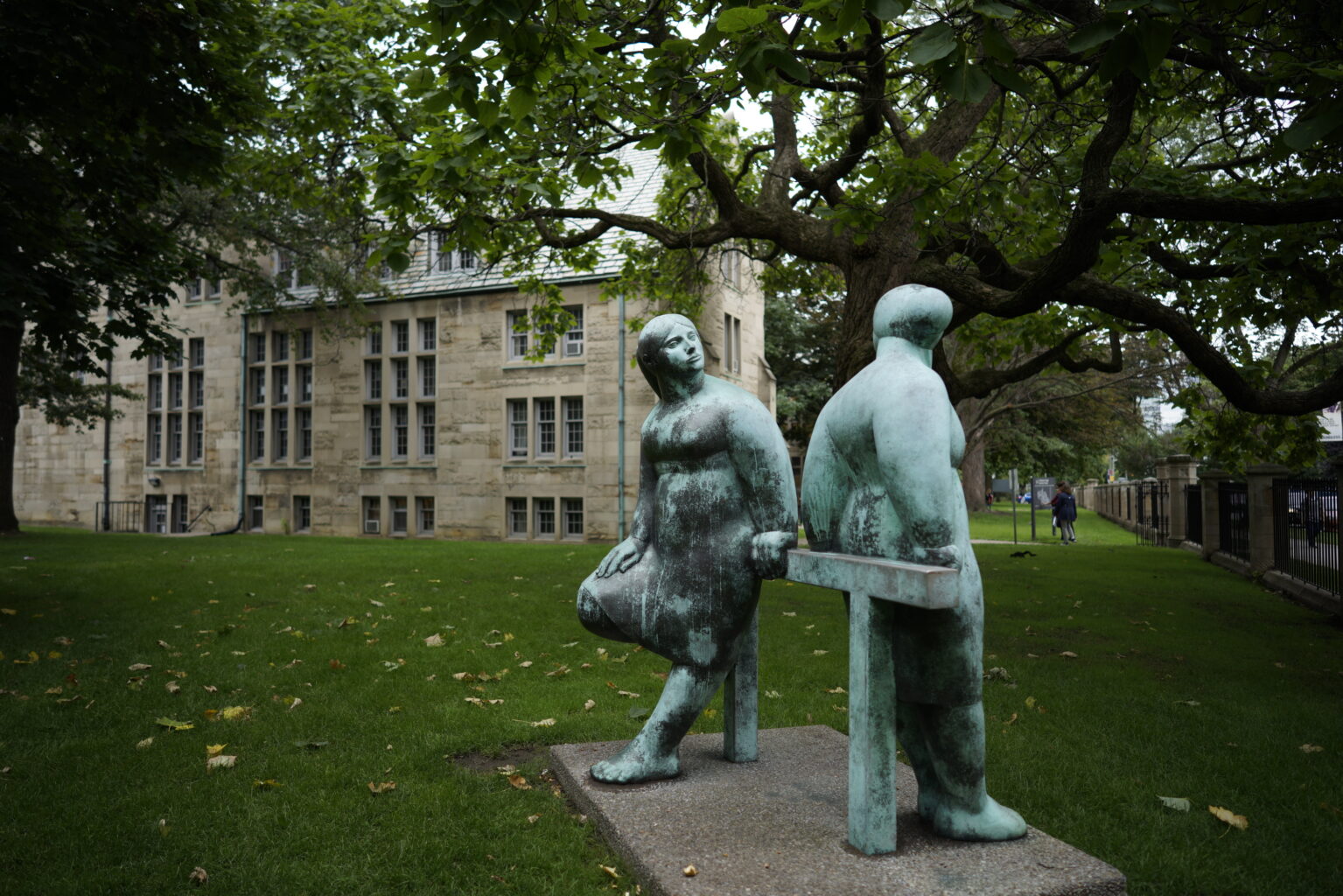
Since starting work within the Advancement team two months ago I’ve come to appreciate the special nature of St. Mike’s.
I was initially drawn to the role based on the understanding that the College is supported by a loyal and generous community of alumni. And as someone who graduated from a small liberal arts college in a big city, I appreciate the juxtaposition of being part of a safe, tight-knit community while simultaneously being surrounded by the resources and opportunities a bustling city—and one of the world’s leading research universities—affords.
This is an interesting time to be working in university alumni relations, as so many things have shifted in the last several months due to COVID-19. Traditionally, St. Mike’s alumni would be looking forward to various in-person social events. On the flip side, alumni who may not have been able to access a local event in the past can now tune in, a unique opportunity to connecting with one another virtually.
So, while we all wait to return to “normal” when it is safe to do so, it is my job to engage and support the alumni community throughout this time—and I think we can all agree it is more important than ever to stay as connected to one another as we can.
Alumni volunteer activity is a critical asset to any university, and I am particularly grateful for the Alumni Association Board and Young Alumni Committee. These groups provide invaluable perspectives and insight as the mouthpiece for St. Mike’s alumni at large. Their contributions and ideas support the relationships between St. Mike’s and alumni, as well as within the alumni community, through alumni programming. They have a direct impact on the future of St. Mike’s. Right now, there is an opportunity and a priority to grow these groups to further represent the diversity and various backgrounds of the alumni body.
There are a couple of new virtual programs coming up. I am really looking forward to the St. Mike’s Alumni Workshop Series in partnership with the Office of the Dean of Students, where alumni who represent varying industries and experiences are meeting with a small group of current students over Zoom throughout February and into March. Each session is focused on a particular theme, such as “Finding a Job in a Difficult Market” and “Entrepreneurship.”
Another program in the works is a Faculty Speaker Series, a way to highlight and share St. Mike’s fantastic faculty and programming with all University of Toronto alumni through virtual presentations. We also look forward to traditional programming—the Lenten Retreat, Alumni Reunion, and Spring Convocation—done in new ways, for now.
Furthermore, I have been inspired by ideas alumni bring forth—from social media initiatives to thematic virtual events—and I am honoured to witness the progress that continues to take place at St. Mike’s, through St. Mike’s 180 strategic plan. I look forward to continuing to spend time in conversation with alumni in an effort to connect, learn, share ideas, and make plans.
More than anything, I realize time and time again what a special place St. Mike’s is. Stories of Catholic services and religious pursuits, campus life and community involvement, stimulating classes and academic advisors, all remind me that St. Mike’s is a place where some of life’s fondest memories have happened, and continue to happen. Even in the midst of a challenging season, I am constantly reminded that a strong alumni community makes for a stronger St. Mike’s.
If you would like to introduce yourself or get in touch with me about any of the things above (I really enjoy hearing from alumni!), you can reach out via email or phone (416.926.7260 ext: 67260).
Read other InsightOut posts.
Kathryn Elton joined the University of St. Michael’s College in 2016, as Chief Advancement Officer, overseeing fundraising and alumni programming. One of the best parts of her work, she explains, is meeting and getting to know St. Mike’s incredible alumni community.
Remembering Long-time St. Mike’s Alumna Gloria (Chisholm) Buckley
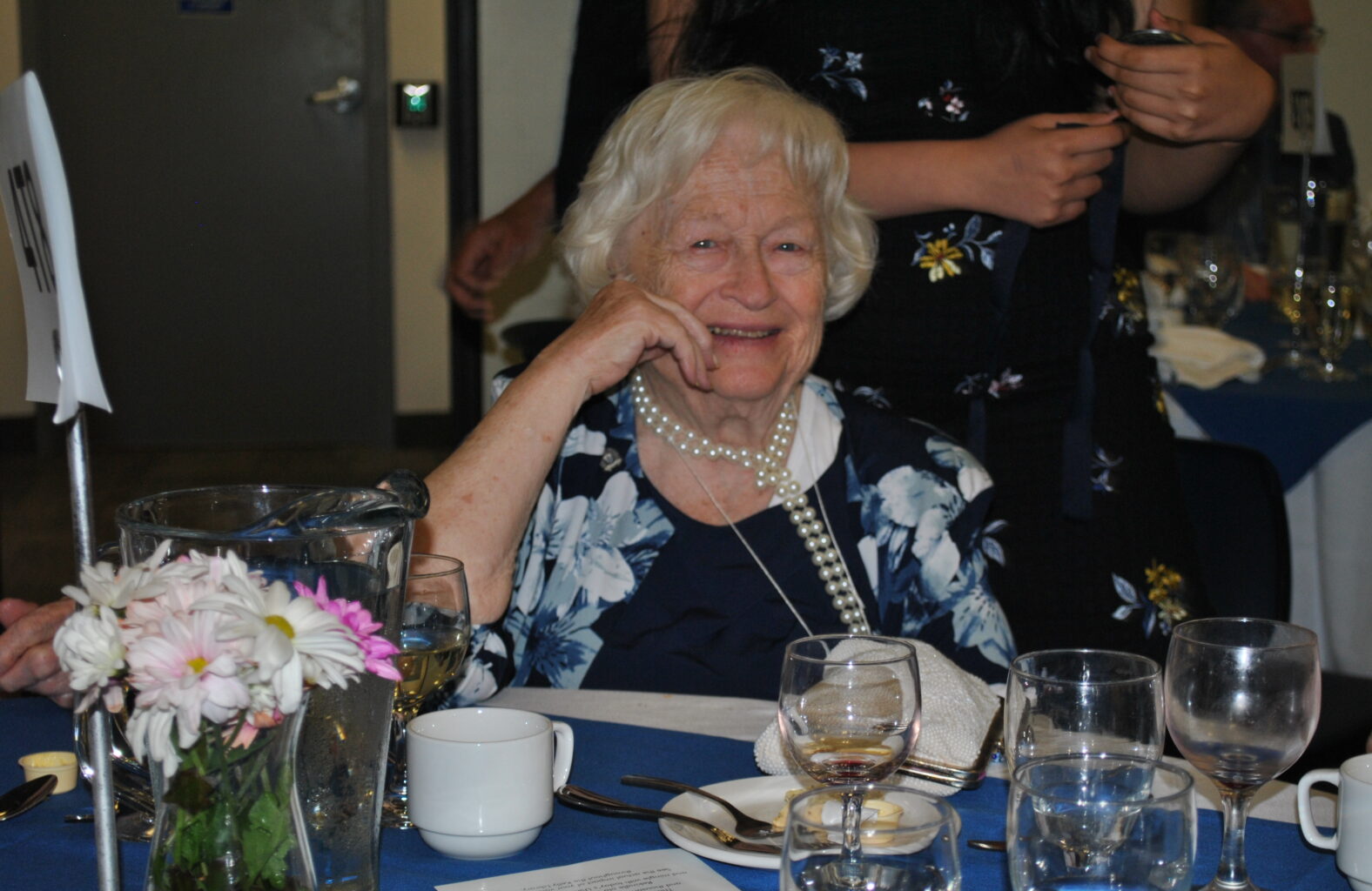
The University of St. Michael’s College and University of Toronto communities lost a treasured friend with the passing of alumna Gloria (Chisholm) Buckley on January 25, 2021. Gloria, who graduated from St. Michael’s College in 1948 with a Bachelor of Arts and Science, majoring in chemistry, was a beloved alumni volunteer leader. She was also a trailblazer who shone a path for women in science and returned her good fortune by serving others.
When Gloria was presented with St. Michael’s Alway Award in 2014 she was celebrated as a “pioneering spirit, a scientist, working mom and community volunteer…at peace with both faith and science, a lifelong passion for knowledge, and thrilled by discovery. With a penchant for asking questions, a feminist before the movement began, a desire to contribute to saving lives, to fight for health and to understand the world at its most basic elements. She has lived up to the highest standards in numerous ways.”
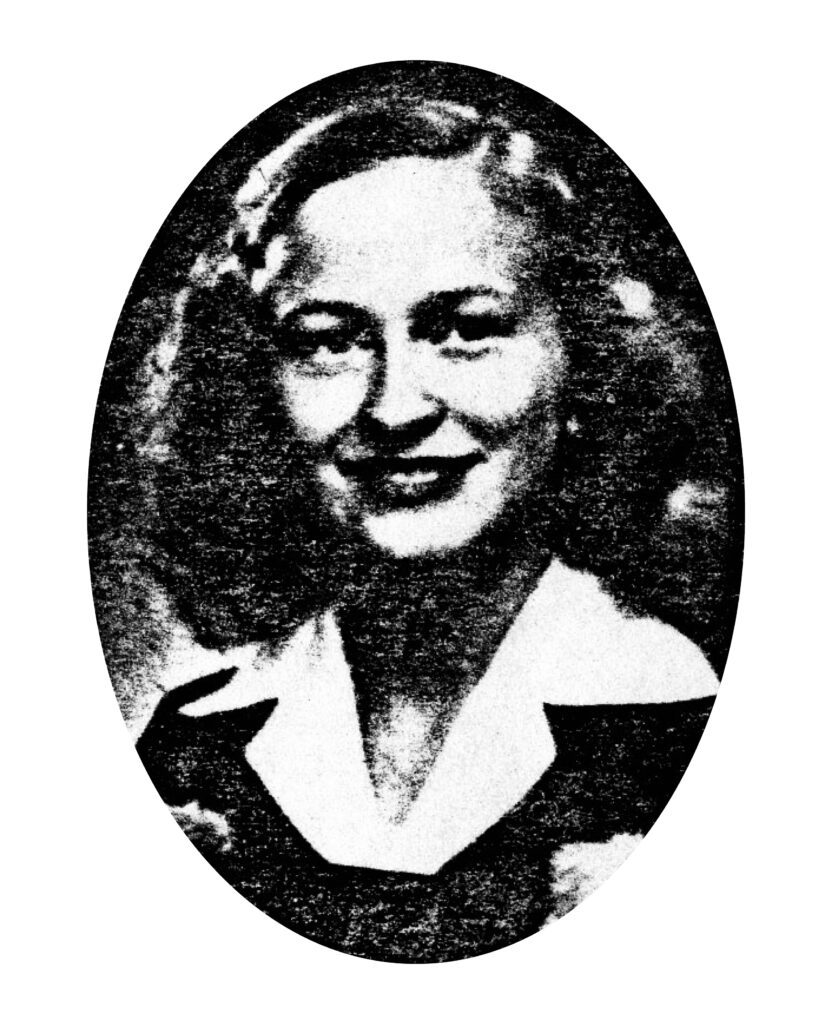
Gloria’s accomplishments were extensive. She was:
- a researcher at University of Toronto and at St. Michael’s Hospital’s Lipid Centre
- a scientist in the private sector, including in bioscience and clinical chemistry specializing in cancer research
- a member of the Christian Family Movement—helping peers with children cope with the pressures of life while raising families
- a member of the Associates of the Sisters of St. Joseph for more than 25 years
- one of the longest-serving members of the U of T Senior Alumni Association
- the founder and leader of the organizing committee for University of St. Michael’s College Alumni and Friends Annual Lenten Twilight Retreat
and
- the longest-serving Board Member of the USMC Alumni Association.
Gloria was also the proud mother of sons Roger, Brian, and Phillip, all of whom attended St. Mike’s.
She was a much-loved friend among the alumni community. St. Mike’s alumna Marcella Tanzola remembers:
“I had the honour of knowing and working with Gloria for many years on the St. Michael’s Alumni Board. With Father Bob Madden, we both helped to establish the Annual Twilight Lenten Retreat and worked closely over 25 years to make this a memorable and meaningful event. Gloria was a tireless worker and supporter of all alumni pursuits. For me she was a ready ear and good counsellor. We shared wonderful conversations during all those years and I learned what a remarkable woman she was as we exchanged our life experiences. Rest in a much deserved peace Gloria. I will miss you.”
Miriam Kelly, another alumna and colleague, adds:
“The Basilian Fathers, the University of Toronto and the University of St. Michael’s College, and the Annual Lenten Twilight Retreat will all be thankful for the many years Gloria gave to their many endeavours, sharing her wisdom, hospitality and sense of humour. Gloria will be much missed and remembered. Rest in Peace.“
When I joined St. Mike’s advancement and alumni programs team in 2016, all my new colleagues recommended that Gloria be one of the first alumni I should meet. She had a long-standing connection with St. Michael’s, deep commitment to the university, and astute perspectives on our past and our future. She was also a frequent attendee at alumni meetings and events, and I soon learned why she was loved by my colleagues. Betty Noakes, a member of our advancement team who knew her for more than 10 years notes that “Gloria’s kindness, knowledge, sage advice, and grace made the world a better place. She exemplified Goodness, Discipline and Knowledge. I will hold her in my heart, and miss her dearly, as will, I’m sure the community she has left behind.”
The University of St. Michael’s College is truly blessed by a loyal and committed alumni community, and I have a special place in my heart for Gloria. From our first meeting in fall, 2016 until our last conversation this past fall, when she was sharing ideas about St. Mike’s vision for the future, I have felt extremely lucky to have known her, even just a little.
Thank you Gloria. God speed.
Gratefully, Kathryn.
Alumni who wish to share memories and tributes to Gloria are invited to send messages to: smc.alumniaffairs@utoronto.ca. We will collect them and send them to the family.
Read other InsightOut posts.
James Roussain begins a new role at the John M. Kelly Library this January as the Interim Head of Public Services, a change from his position as Outreach and Instruction Archivist, which he has held since 2017. Prior to joining the University of St. Michael’s College, James worked at Scotiabank, where he was involved in the maintenance and deployment of the corporate records management program. At the Kelly Library, James assists students with their research, exposes students to the treasures in the Kelly Library’s Special Collections, and teaches in the college’s Book and Media Studies program. James is a past president of the Archives Association of Ontario (AAO) and the Toronto Area Archivists’Group (TAAG). In his spare time, he is pursuing a Master of Education in Higher Education at the Ontario Institute for Studies in Education (OISE). He holds a Master of Information degree from the University of Toronto’s Faculty of Information.
On Jellyfish, Loneliness, and Learning
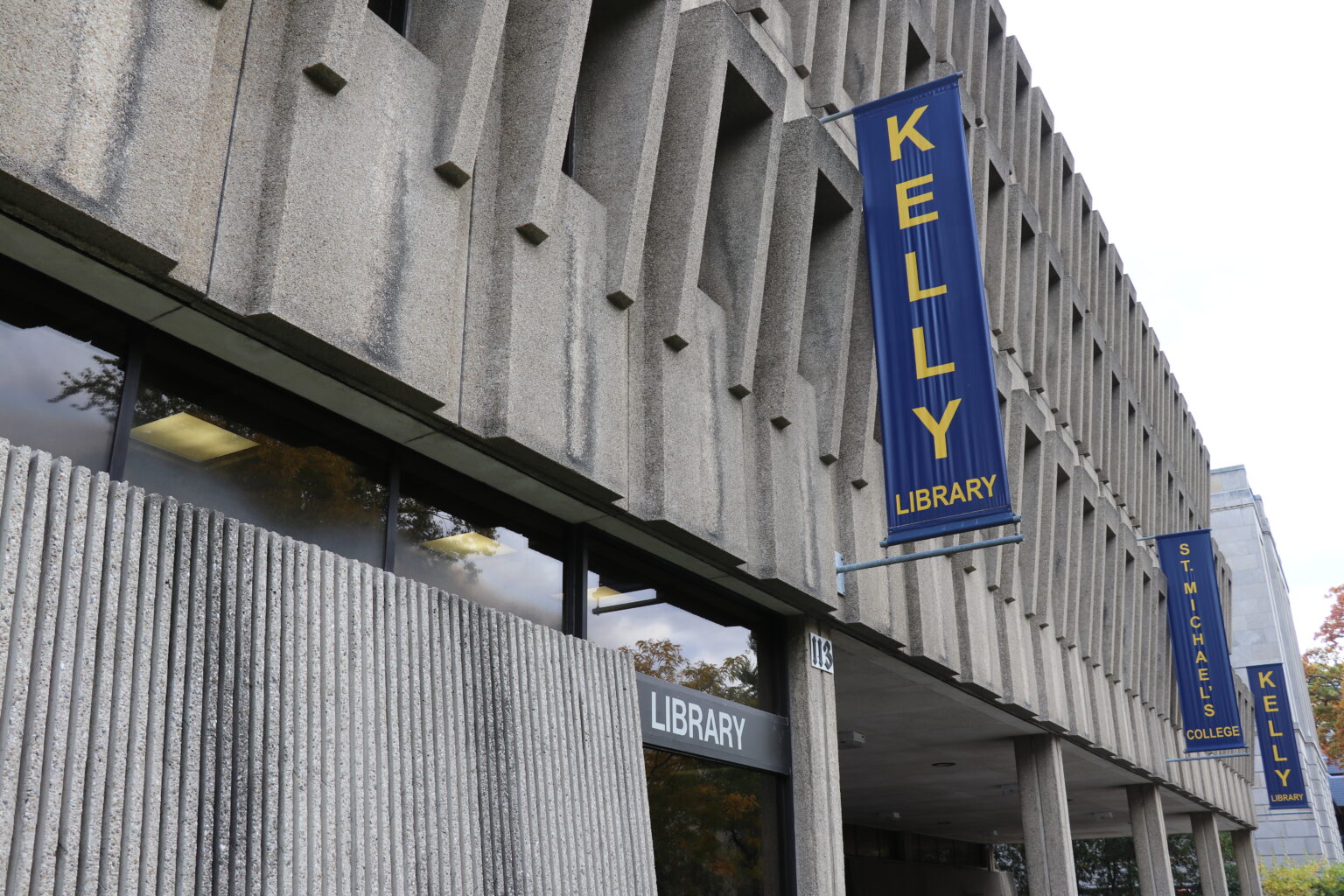
As the new semester gets under way in the coming days, it is important to take a step back and think about those we are working to support: our tireless and dedicated students. With our new reality of living apart and working remotely becoming just that—our current reality—we need to remember that these are indeed strange and stressful times not just for us but for our students, too. As a librarian at the Kelly Library, I am fortunate to work directly with students assisting them in their research, writing, or in navigating the complexities of the University of Toronto’s immense library system. For many, the library is an intimidating space in the best of times. Compounded with the challenges of remote work and a lack of helping hands, finding resources and completing research has never been more challenging, especially so for many of our first-year students, for whom the academic library is an entirely new entity.
During the fall semester, the Kelly Library, in partnership with the Principal’s Office, hosted twice-weekly Research and Writing Help Drop-In sessions, where students were able to join us—remotely—for one-on-one assignment help. With two writing instructors at my side, we would greet students and, using private break-out rooms, answer as many questions as possible over a two-hour period. What started off as a way to accommodate students who were unable to snag longer scheduled appointments grew into a window on our students’ lived reality: too many due dates, a mess of assignments vying for their attention, and an overwhelming sense of isolation and, at times, loneliness. Logging in from their living rooms, kitchens, bedrooms, and sometimes an enviable patio, students shared with us their frustrations in working alone and, for many, navigating time zones and poor internet connections. This has not been an easy time.
As I helped students find articles, tidy up citations, or figure out the best keywords for their upcoming essay on, say, vestigial traits in jellyfish, I grew to realize two things. The first—and perhaps sacrilege to our faculty readers—is the trivial nature of our work during these incredibly challenging times. In more than one occasion I felt the need to reassure students that while, yes, your essay is important, so too is the need to care for yourself and reach out to others. This is not to say we must lessen academic rigour, but rather carry a realistic understanding of what is possible. The second thing I learned is how little I know not only about jellyfish but about every single topic brought to me during these drop-in sessions. The level of academic achievement on our campus is truly astounding. There has not yet been a case where working with a student on their research has not taught me something new, and for that I am thankful.
In looking ahead to the coming semester and the challenges it will surely bring to our students, especially those graduating into a world of social, political, and simply logistical unknowns, we need to work together to ensure empathy and perspective are at the front of our minds. The rise of mental health programs and services on campus—so well advocated for by our dedicated students on SMCSU—brings overdue awareness to the importance of creating community wherever possible. Week after week, soon after logging in, the same group of students would join our drop-in sessions. Some came for detailed questions on style and structure, while others came just to check in. We created community in the most unlikely of places: a Zoom call focused on academic research and writing help. Who knew? In our own unique way we forged a space where students could share their frustrations, get some help, and see a familiar face at the same time. It is easy to get caught up in administrative matters, the daily to-and-fro of emails and meetings, or the challenges of bureaucracy. Take a moment, as often as possible, to guard against these blinders and seek our community. Or, if so inclined, check in with our students and ask them how they are doing. What may be seen as a hollow “How’re you?” during pre-COVID times may now carry more weight than you know.
While the library’s stacks are closed for the time being, our dedicated staff remains available to help. We strive to place the student experience at the centre of our work and tailor our collections, services, and spaces to offer them an inclusive, welcoming, and supportive environment—both in a physical and virtual sense—where they can flourish during their time on campus. In my own role within the library, and my small role on the University of Toronto campus, I am proud to have the opportunity to work daily with our students and to learn alongside them.
Read other InsightOut posts.
Dr. David Sylvester is the 8th President and Vice-Chancellor of the University of St. Michael’s College in the University of Toronto. A professor of medieval social and economic history, he holds an M.A. and a Ph.D. from Fordham University, New York City and has taught for three decades in universities in Canada and the United States.
Together in this Season of Gratitude and Hope
And for all this, nature is never spent;
There lives the dearest freshness deep down things;
And though the last lights off the black West went
Oh, morning, at the brown brink eastward, springs—
(Hopkins, Grandeur of God)
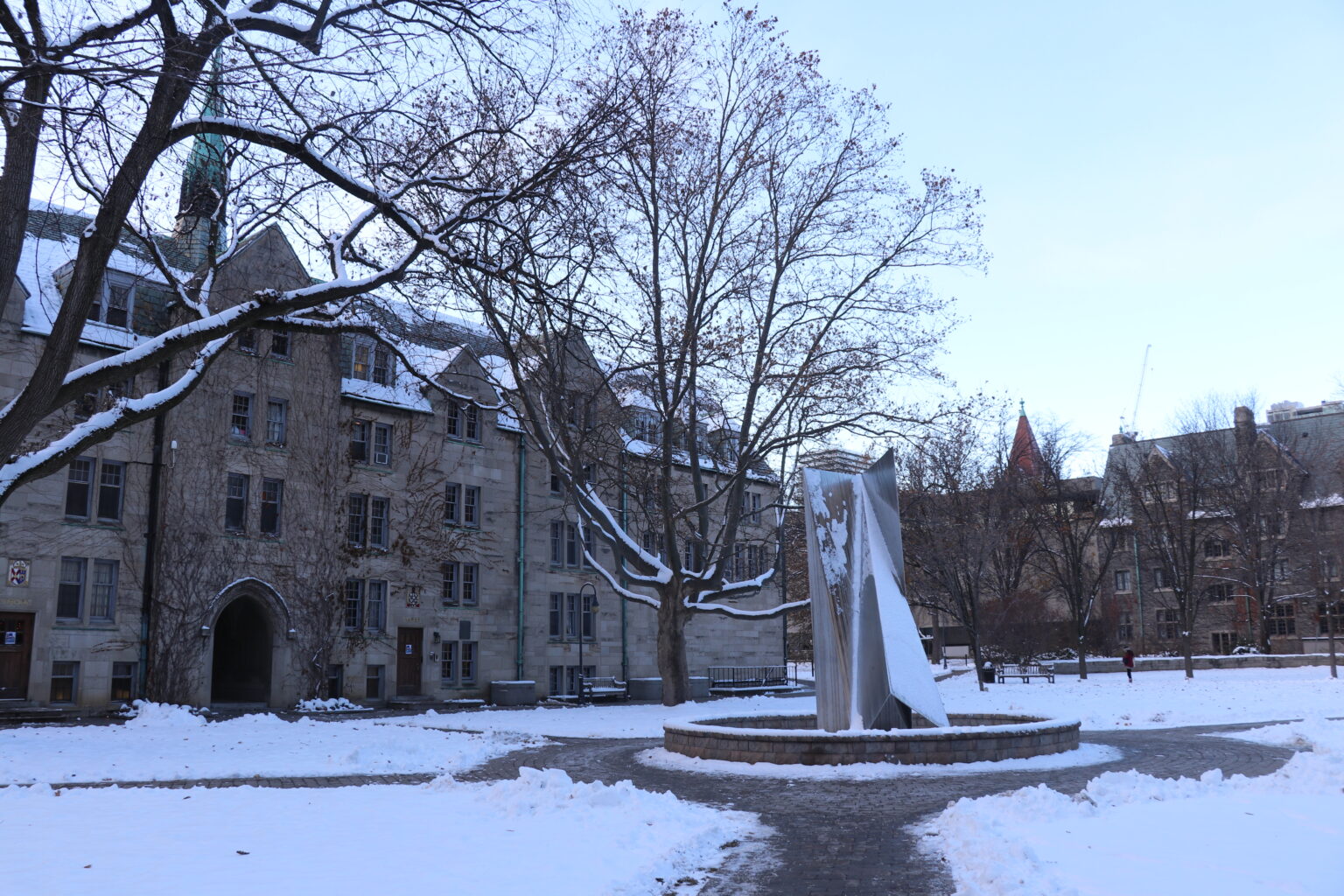
One of the beautiful things about being a part of the University of St. Michael’s College is our attentiveness to the rhythms of life in community. Our pastoral urban campus, with its historic oak trees, colourful ivy and beautiful rock gardens, keeps us attentive to nature, and demands that we acknowledge the passage of seasons. The academic year is traditionally framed, of course, by all the necessary signposts of the academic year, such as move-in days, reading weeks, and midterm and final exams. But St. Michael’s is also defined by the rich cultural and religious mosaic of our community, and we are invited throughout the year to celebrate the many important feast days that help our students, faculty and staff bring meaning to their work and studies: solemn and joyful holidays like Easter, Ramadan, Diwali, Rosh Hashanah, and Nowruz. Even as I write, friends and colleagues are preparing to light candles to mark Hanukkah.
So, here we are together now in Advent. For Christians, we wait and prepare to celebrate the birth of Christ, the light in the darkness, our hope for the world. For all of us, this is meant to be a time for completion, for rest and reflection with friends and family, and for preparations for new beginnings.
As I take stock of this past year, my thoughts are filled with gratitude. In this most remarkable year, in which all of us have experienced disruption, loss and sadness, I am continually amazed by the dedication, kindness and generosity of the people with whom I work. Their compassionate leadership and sacrifice have bolstered fellow students, professors, and colleagues alike. I see it every day in the bold actions and quiet kindnesses they take on. And I know that much more is done unseen.
The response to this pandemic from our students, faculty, staff, trustees, and alumni invites more than gratitude, however. It gives me great hope for the future of our community, and for our role in continuing to bring hope to others. Many challenges remain ahead of us, but the compassionate resilience of St. Michael’s shines through and sustains us even in these darkest days of winter. I now approach each day understanding that our university serves as a light of hope in these difficult days, for each other, and for the society in which we live.
As we pause to celebrate the coming holidays, I wish each of you and your families, a happy and holy Christmas, and prayerful best wishes for a New Year marked by many new reasons to give thanks and to share in the hope that binds us all together.

David
Simon Patrick Rogers is the special collections archivist at the John M. Kelly Library. He earned his Master’s degree in Information Studies (archival stream) from the University of Toronto in 2008 with an additional specialization in Book History and Print Culture. He has extensive experience processing, arranging, and appraising archival materials and is also active as a faculty instructor for the Book and Media Studies program at the University of St. Michael’s College. He currently serves on the University’s Collegium. He has published numerous articles on diverse topics including archives, municipal history and architecture, music, literature and the field of monetary appraisal.
A Busy Fall for Kelly
It has been a busy fall in the Kelly Library’s archives and special collections, at the end of a long, tumultuous year full of upheaval and trial. In spite of the closure of the rare book reading room to researchers, we have been active behind the scenes with some exciting new acquisitions to the collections.
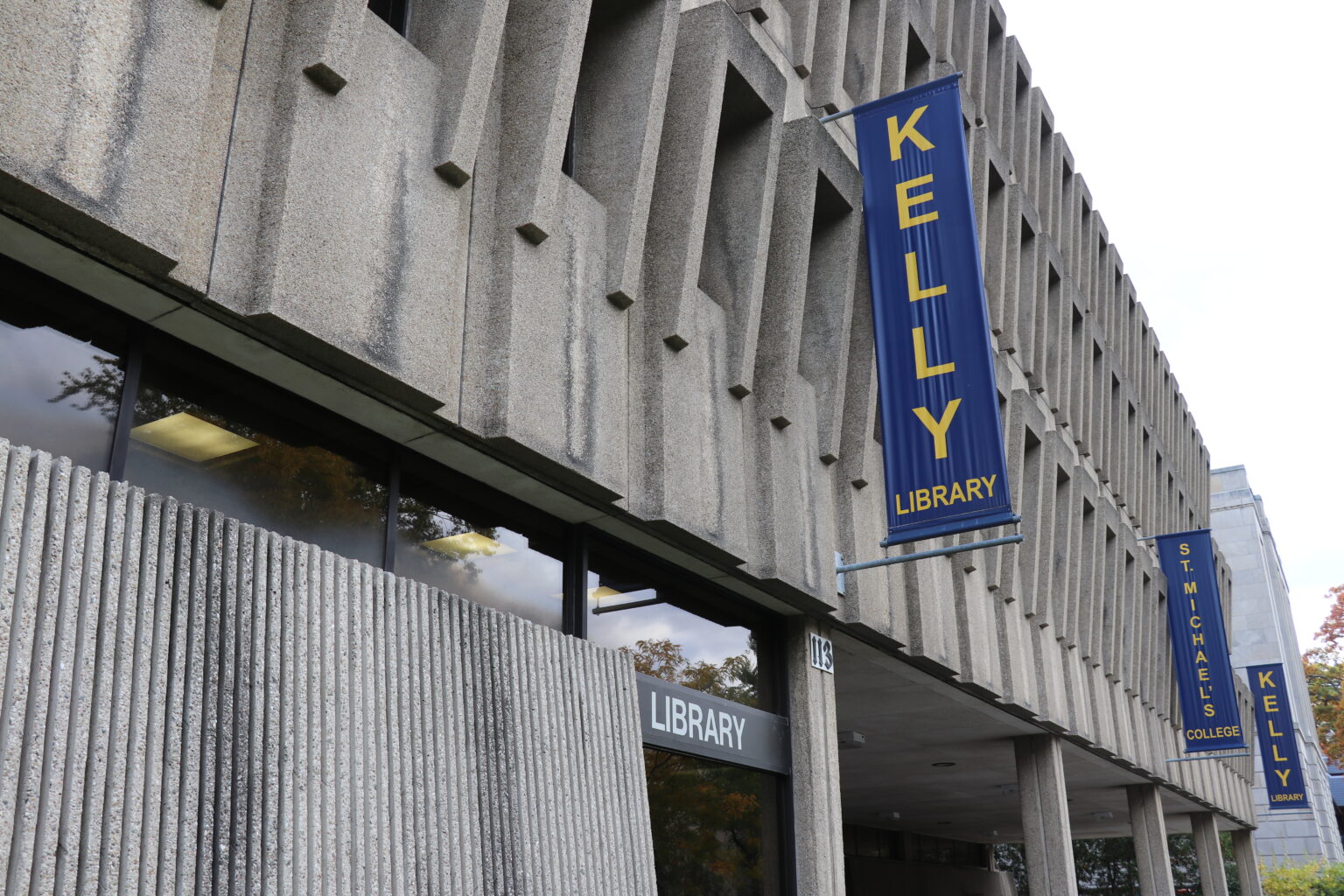
A major accomplishment for us was receiving a wonderful donation of photographs for the Henri Nouwen Collection from San Francisco-based photographer Kevin F. Dwyer, a gift which includes some of the best photographs taken of Nouwen just before his death. A formal announcement of the acquisition, complete with a look at some of the photos, will come in January, 2021.
In other Nouwen news, we have hired a new processing archivist to work on the backlog of Nouwen materials, and especially to focus on important collections of letters and materials collected posthumously in the archives. The successful candidate for this position, Teresa Wong, started on December 1st and joins us most recently from the completion of a prestigious internship at the Getty Institute in California. The position was made possible by a generous donation from Henri’s brother Laurent Nouwen, and the Henri Nouwen Society. We are very excited to begin work on these important collections and to make available for the first time new collections to researchers online through the discover archives database and Collections UofT portals.
I am also delighted to announce the recent acquisition of the administrative archives of the Canadian Alternative Investment Cooperative and Foundation. This important organization in the history of social justice in Canada began in 1984 and recently finalized its dissolution. The archive will provide researchers new insights into Catholic social movements in Canada inspired by responses to Apartheid and to the Second Vatican Council of the 1960s. The co-op’s mandate was to work with registered charities, non-profits, and co-ops to promote alternate economic structures leading to long-term structural change in underprivileged and marginalized communities. They managed loans and financing for a whole range of social enterprises across Canada, including many thriving and firmly established cooperative businesses still in operation. These papers will complement our other social justice collections, such as the L’Arche Canada and L’Arche Daybreak collections, and the papers of the Catholic New Times journal.
There are some further donations in the works, too, that I look forward to announcing in 2021. It has been exciting to build our collections and work with the donors to understand the histories and backgrounds of these new archives.
As we concentrate on working from home, I have been able to do some more direct research work with patrons, especially with providing access to already-digitized materials. Unfortunately, many of the archival collections are not yet digitized. Sometimes this is because of access restrictions or copyrights, but other times materials could be made more digitally available. We have been assembling the equipment to build a digital preservation studio in the Kelly and building the in-house capacity to digitize and preserve those items that can be digitized. We already have the equipment to digitize many of the most common kinds of media we find in our collections, such as photographs, textual records, legacy material on floppy disks, and other born-digital collections, as well as all kinds of audio and video formats. It is exciting to be a part of this process, especially now as we see more and more materials coming into archives that require some kind of digital preservation just to access their contents. It can be a little like detective work to even figure out the software formats of legacy media, and the process of digitization can also be a little like conservation work, as materials are cleaned or restored where damage to the original media format has taken place over time.
Personally I miss the office. A lot of my work is very dependent on having physical access to the collections and, like many of my colleagues, I am feeling the long haul of logging so many computer hours and interacting virtually through video meetings. I also miss the camaraderie of the office space and the kinds of connection that I can make through chatting and small talk with my fellow librarians over my daily pilgrimages to the coffee maker or the staff dining hall.
It has not been all bad, however. I am more mindful and appreciative of life at home and am blessed to have had this extra time with my wife and son. We did some garden projects this spring and summer and enjoyed the harvest. We went camping when we could. I bought a really nice hand-cranked coffee grinder and do a virtual exercise class in the mornings with a great trainer in Ottawa. In some ways this attention to the routines of domesticity is very much like archival work. I hope we can all maintain some appreciation for simple pleasures as we look forward to life after COVID.
Read other InsightOut posts.
Not even a pandemic can stop Christmas from coming to St. Mike’s.
While the campus is quiet and missing many of the traditional seasonal activities this year—the alumni Christmas tea and the Schola Cantorum Advent concert are two notable, sorely missed examples—our gorgeous Christmas lights will still illuminate the grounds to bring cheer both to those students in residence as well as to neighbours and passersby.
To ensure that help gets to those in need, the annual toy drive, which sees St. Michael’s team up with the University of Toronto campus police and the Society of St. Vincent de Paul, is accepting donations online to buy gift cards for families so that parents can pick out the perfect items for their loved ones. Donations of gift cards are also being accepted at the security desk in Charbonnel Hall at 81 St. Mary St. Donations are being accepted up until Friday, December 4.
And in this season of giving, the University has been particularly touched by the generosity of the creative minds who came up with a way to compensate for the fact the annual golf tournament fundraiser was COVID-cancelled. Two golf tournament sponsors—Mackenzie Financial and CIBC, who are represented by event co-chairs Barry McInerney and David Scandiffio—made donations of $10,000 each this year instead of sponsorships. USMC matched these donations with proceeds from previous years’ tournaments to create a $40,000 expendable fund, allocated care of the Registrar’s office, to help students with exceptional needs related to COVID.
This approach parallels the Faculty of Theology fund created earlier this year, which was built from donations and matched by St. Michael’s. Together, these gifts represent the continued loyalty of golf tournament sponsors and the commitment of alumni, faculty, staff and the university to helping students during this challenging time.
At a time when food banks and social service agencies are seeing soaring demand, the generosity is being spread widely. Another golf tournament sponsor, Mawer, donated $5,000 in lieu of sponsorsip. This, too, was matched with donations from previous years and augmented by other alumni gifts, creating a gift of $12,500 to support the Out of the Cold program at St. Basil’s Church.
While an Advent Vespers service followed by dinner is one of the highlights of the Faculty of Theology’s social calendar, Vespers will be observed online this December, with a social gathering to follow. And since there’ll be no dinner cheque for the SLC to pick up this year, they’re offering a great incentive to partygoers, promising to make a $15 donation to the Into the Cold program for each person who attends the online party.
The undergrads also have online fun planned, with a Winter Festival from Dec. 4 to 6 featuring decorating Christmas ornaments with the commuter dons, a Kelly’s Corner, and a family dinner all lined up.
And while most of us will find this a quieter, slower-paced Advent season, without the usual trips to the mall or holiday parties, there is no doubt we could all use some peace. With that in mind, St. Basil’s is hoping to open the church for prayer from 7:30 to 8:30 a.m. and 12 to 1 p.m. Monday to Friday, 5 to 6 p.m. Saturdays, and 12 to 1 p.m. and 4:30 to 5:30 p.m. on Sundays. Capacity when the church is open is restricted to 10 people. During these prayer times, a priest is usually available to hear confessions, except for the 7:30 to 8:30 a.m. time periods.
COVID-19 may have changed this holiday season, but the heart of St. Mike’s just continues to grow.
John L. McLaughlin is Professor of Old Testament/Hebrew Bible and Interim Dean of the Faculty of Theology, University of St. Michael’s College. One of his many COVID-related regrets is that he will not be able to return “home” to New Brunswick this Christmas and have some fresh dulse.
Hope in the Time of COVID

I collect cartoons. My collection focuses on pieces that deal with biblical themes, especially those that cite specific passages. Many are from the Peanuts comic strip, documenting the experiences of Charlie Brown and his friends. One of my favourites, which I often use in introductory courses to convey the continuing relevance of Scripture, shows Lucy and Linus looking out the window at the pouring rain. Lucy worries that the whole world might flood so Linus reassures her by noting God’s promise to Noah in Genesis 9 never to do so again, with the rainbow as a sign of that commitment. She says, “You’ve taken a great load off my mind,” to which he responds, “Sound theology has a way of doing that!”
I think it is safe to say that most of us are carrying more than one “load” these days in light of the ongoing COVID-19 measures. I am writing this on the day that Toronto, and with it the University of St. Michael’s College, began its second pandemic lock down, once again restricting what was still very limited opportunities to leave our homes and even less ability to interact directly with our family, friends and colleagues. The entire University of St. Michael’s College community has quickly come together to respond to this new crisis, making it possible for us to continue our mission as a university. But I am sure that most of us are also pretty tired of virtual meetings and remote classes via Teams and Zoom. I can hear some readers asking, “Where’s your ‘sound theology’ now, bud?”
Well, today is also six days before the first Sunday of Advent, the beginning of the Christian liturgical year. So Happy New Year! Like many religions (Rosh Hashanah in Judaism, al-Hijra in Islam, Vikram Samvat in Hinduism, Nowruz in Bahai’ism and Zoroastrianism, and so on), Christianity starts its year separately from the calendar year. But this is more than the oddity of a different date to note the annual passage of time. Advent marks the resetting of Christian worship. Because Christians structure their annual worship differently, their lives have a different focus, or at least they should. In contrast to the calendar year, the liturgical year is not simply a cyclical repetition of the same weeks and months year after year. Instead, it is an annual spiritual journey towards an end point, reinforcing that our lives are not a random collection of experiences, but rather they have a purpose, a goal. In keeping with this, we start the journey through the life and teachings of Jesus anew by switching to a different Gospel that is read more or less sequentially (with some supplements from the other Gospels), this year from Matthew in 2019–2020 to Mark in 2020–2021.
One might think we would start that journey with the beginning of Jesus’ human existence. Instead, the liturgical year begins with the Advent season, four weeks that prepare for Jesus’ birth on Christmas Day. That is the specific moment of the Incarnation, which Christians celebrate as the epitome of divine engagement with humanity, when God became one of us. But that was not the start of God’s involvement with the world and its inhabitants; the opening verse of both Genesis and the Fourth Gospel affirm that God began interacting with the world “in the beginning.” By starting the liturgical year not with Jesus’ birth but with a period of preparation for that event, the Church reinforces the fact that God’s concern for us did not start a little over 2000 years ago in Roman occupied Judea, but rather long predates the Nativity.
For the next three Sundays, the first reading is drawn from the latter part of the book of Isaiah, which is marked by themes of hope and encouragement. Isaiah 40-66, called Second or Deutero Isaiah, derives from an unknown prophet (or two) speaking to Israelites deported to Babylon after the Babylonians conquered Judah and destroyed the Temple in Jerusalem. This constituted a crisis of faith for the people. In the ancient world, military success was attributed to the superiority of the victorious nation’s god. In this case, the Babylonians had even destroyed the Temple, considered the dwelling place on earth of Israel’s God. But if he (all ancient deities were gendered, male or female, but that’s a very different blog post) couldn’t protect his own house, surely he wasn’t much of a God. At the very least he must be secondary to Marduk, the chief Babylonian God.
Faced with this theological challenge, many ancient Israelites abandoned faith in their God. In fact, this is the point when the Israelite religious traditions should have faded out to become an historical artifact, like the Babylonian religion did when they in turn were conquered by the Persians 50 years later. Instead, the Israelite traditions lived on precisely because of Israelite prophets, historians and priests, who responded to this theological crisis in two ways. First, they reinterpreted their national defeat as God using the Babylonians to chastise them for their history of sin and apostasy, which meant that their God was in control of the Babylonian army, not Marduk. Second, Deutero-Isaiah in particular encouraged the exiles as well as those left in Jerusalem to recognize that God was still with them and would intervene to free them from their bondage and bring the exiles back to Jerusalem, which did happen shortly after. As a result of this and other efforts Israelite religion continued, eventually giving birth to both Judaism as we know it today and Christianity.
“Sound theology has a way of doing that!”
All the Advent lectionary readings emphasize this hopeful perspective. Rather than try to comment on all the readings from each of the four Sundays of Advent (a significantly longer blog post), let me concentrate on how the first readings do this each week. On the first Sunday of Advent, the prophet calls God to come down from the heavens and intervene like he has done in the past, while acknowledging that their sins have prevented him from doing so (Isa 64:1-9). The next week we hear the opening words of Second Isaiah (Isa 40:1-11) with its repeated command to comfort God’s people because they have paid double for their sins. As a result, the prophet announces,
A voice cries out:
“In the wilderness prepare the way of the LORD
make straight in the desert a highway for our God” (v. 3)
which Mark cites (and restructures) in the corresponding Gospel reading. On the Third Sunday of Advent, the prophet expands on this, proclaiming concretely that
The Lord has anointed me
to bring good tidings to the afflicted;
he has sent me to bind up the brokenhearted,
to proclaim liberty to the captives,
and the opening of the prison to those who are bound;
to proclaim the year of the Lord’s favour . . .
to comfort all who mourn (Isa 61:1-2).
Then, on the Fourth Sunday of Advent the lectionary switches to the pronouncement in 2 Samuel 7 that David’s “throne shall be established forever” (v. 16). Historically, the Davidic kingship ended with the Babylonian conquest, but other writers spoke of a future “anointed one,” just as David was anointed when he took the throne, and the Hebrew word mašîaḥ/mashiach gave rise to the idea of a coming Messiah who would liberate them from foreign oppression.
As these passages along with the other lectionary readings convey, Advent is a time of hope and expectation. Those attitudes may be in short supply these days in the midst of a global pandemic, even with recent announcements of possible vaccines on the horizon. But the prophet’s message that God was still with the Israelites in exile, linked to Advent’s anticipation of God coming among us, not as a powerful leader but rather as a tiny baby, affirms the belief that God does not abandon us in times of need. Hope remains.
“Sound theology has a way of doing that!”
Read other InsightOut posts.
Adrian Ross is the Executive Assistant to the Principal at the University of St. Michael’s College. Trained as a musician, he is an historical keyboardist specializing in harpsichord and clavichord. He is engaged by the agency of music, especially rhythm, in health and liturgy, especially in antiquity and the Middle Ages.
InsightOut: Les Barricades Mystérieuses

The therapeutic potential of music has long been recognized: King David and Orpheus disarmed evil by the lyre, and harmony and rhythm could restore the revolutions of Plato’s soul, to give but a very few examples. Indeed, and perhaps because of this, the restorative power of music is particularly attested in times of plague. The prescription of music was especially prevalent not just as palliation, but as prevention and treatment, during outbreaks of plague in mediaeval and early modern periods. More generally, music is often desired during life’s most uncertain, critical, and mysterious experiences, notably in dying. The composer Guillaume Dufay (1397–1474), for example, even wrote a motet for his own deathbed (Ave Maria Caelorum III) and to this day music at the bedside continues in palliative care.
It is difficult to define precisely what technical qualities make music capable of healing physical and spiritual crises, and this may be subjective to a certain degree. One piece that has always spoken to me as particularly consoling is the enigmatically titled Les Barricades Mystérieuses (The Mysterious Barricades) by François Couperin (1668–1733). It is one of the most popular and abiding pieces of music written for the harpsichord, a keyboard instrument predating the piano and using plucked strings, like a guitar.
Like much current popular music, Couperin’s piece features a refrain (the rondeau) and three verses (couplets). Beginning with a masterfully simple refrain, each of the verses becomes increasingly dramatic, culminating in the last verse. Having moved from the simple to the relatively complex and uncertain, this last verse prolongs the musical tension and the expectations of the listener until that final resolution and dissolution back into the final refrain. This arc of experience is not unique to this piece, to music, nor indeed to the arts at large.
We are now in November 2020, still in the midst of pandemic and called by the Church to reflect on the passing of life to death and, by grace, to glory. Listening to music, even music of past ages, is an opportunity to experience the beauty of art not merely as entertainment and distraction, but as a transcendental that defeats our barriers, opening the human heart to relationship with others and God.
Please enjoy my interpretation of Les Barricades Mystérieuses, recorded on an instrument built by Yves Beaupré (Montréal), generously on loan from Charlotte Nediger, using a tuning system by Jean-Philippe Rameau (1683–1764).
Read other InsightOut posts.
Mandatory COVID-19 Screening Now in Place
In compliance with the Ontario Government’s “Stage 3” Regulation, and on the recommendation of the Chief Medical Officer of Health for Ontario, the University of St. Michael’s College along with other employers in Ontario is required to conduct employee screening for COVID-19 whenever employees come to work. All employees, contractors, and volunteers coming to St. Michael’s to perform work are required to complete a COVID-19 screening process each time they arrive on campus.
Application has closed.
Results of Screening Questions:
• If you answer NO to all questions from 1 through 3, you can enter the workplace.
• If you are experiencing any symptoms or answer YES to questions 2 or 3, be advised that you should not enter the workplace (including any outdoor, or partially outdoor, workplaces). You should go home to self-isolate immediately and contact your health care provider or Telehealth Ontario (1 866-797-0000) to find out if you need a COVID-19 test. St. Michael’s employees should also notify the Bursar and their unit head.
The completion of this Screening Form is mandatory as a condition of entry into University of St. Michael’s College premises. The data collected will be stored securely and will only be shared as necessary for the strict purpose of support for contact tracing should there be a risk to the University and its community members due to a positive case of Covid-19.
Dr. Pa Sheehan is from Sixmilebridge in County Clare, Ireland. He was living in St. John’s, Newfoundland when the pandemic started and moved to Toronto in July. He teaches the Irish language at the University of St. Michael’s College as the Ireland Canada University Foundation (ICUF) scholar.
Finding One’s Inner Resilience
Whenever this pandemic ends and we can look at it in the past, we will all be able to say that it was a defining period in each of our lives. I want to be able to say to myself that it was the period in my life during which I realized what resilience I had always possessed but was not always sure how to use. We cannot control the end result but what we can control are the decisions we make during the process that lead us to the end result. That may sound a little contradictory but it is a perspective I have borrowed from the sporting world and adapted to use in my new normal life.
As a teenager, and even during much of my time at university, I began noticing that I enjoyed being in control of my destiny, that the final outcome would always align with my desires. We all know that this is not always the case, however. There are instances when the outcome does not correspond with the initial intentions. This used to make me feel bitter, angry, anxious and many other things. I look back at exam results with which I disagreed or at not having been picked on a particular sports team and how I allowed these external decisions make me become upset. Little did I know that these external decisions were outside of my control and that I had already done my part, so as long as I was satisfied with the role I had played, I had no reason to feel any ill sentiments.
I truly believe that this pandemic has been a blessing in disguise for me personally. I do not want to belittle the appalling circumstances in which many people find themselves due to the pandemic. I only want to acknowledge the wonderful things it has done for me and I hope you can appreciate that. I talked about resilience at the beginning of this article and I want to refer to it again.
Many moments have tested my resilience during this pandemic. I am from Ireland and have had trips home cancelled, meaning I have not seen my family in well over a year now. My job involves organizing social events and fostering a sense of community amongst the Irish themselves in Toronto as well as anyone interested in Irish culture. This has obviously been affected. One could view my moving to Toronto during the pandemic as a pity, considering I cannot experience what the big city has to offer in its fullness. I am also a sports fanatic, whether it be playing or watching and this aspect of my life has been considerably impacted as well, as sports events were cancelled one after one. I was in the middle of training for my first marathon, which inevitably succumbed to the pandemic. Having been deprived of playing my first love—the Irish sport of hurling—while living for a year in Newfoundland, I welcomed the move to Toronto as it would afford me the opportunity to play it again, given the number of Irish expatriates living in the city. Of course, the pandemic continued and these plans were scuppered along with many others.
A couple of years ago, I would have viewed these setbacks with frustration as I could do nothing to control them. However, I realize now that there is beauty in the fact that I cannot control them. It means that I must make new decisions which are within my control. For example, my inability to physically go back to Ireland has encouraged me to reach out more to people back home whom I may have neglected in the past, whether they be family or friends. It has also motivated me to appreciate the greatness of my homeplace, something I strive to illustrate each day in my teaching of Irish language and culture. Not being able to physically host social gatherings has afforded me opportunities to organize more online events and I am extremely thankful for this as I have most definitely interacted with more passionate and enthusiastic Irish people as a result of the compulsion to go online. The cancellation of marathons and hurling championships has reminded me of the reasons I initially fell in love with playing sport. I do it because it makes me feel good, simple as that. I am still running almost every day, but not because I am training for a marathon that may or may not take place in the future. I have no control over that. I train to feel well. And whenever I can play hurling again, the result of the match will not be significant, nor will the quality of my own performance. All that will matter will be the sheer enjoyment I derive from playing the game and making my best possible effort. Never in a million years would I thought I would have uttered that last sentence!
As plans continue to go awry, flights continue to be booked and cancelled, restrictions are lifted and then enforced again, events are planned only to be aborted once more, I take solace in the fact that my mind is not bound by the outcomes which I cannot affect but by the decisions which I choose to make every day to make the best of every possible situation. Resilience is something each human being possesses but only initiates when necessary. I encourage anyone to solely focus their minds on the decisions they can control. Although you have no say in them, the results will probably astonish you.
Read other InsightOut posts.
St. Michael’s Profs Use Creativity to Remotely Engage Students
As a scholar of video games in popular culture, St. Michael’s Assistant Professor Dr. Felan Parker is deeply familiar with entertainment platforms used to livestream video games for an audience, a genre of media that has only grown more popular among Parker’s students since the pandemic forced their lives online.
Parker puts his expertise to use by using the streaming platform Twitch to teach, offering critical and academic commentary on his own playthroughs during his courses and virtual events. Doing so enables him to provide direct insight into issues of form, themes, tropes, and even the economics of production in the context of the games themselves.
“I think being a media scholar is a double-edged sword in this situation,” says Parker. “On the one hand, I have practical knowledge of digital media and conceptual understanding of how to use them effectively, but on the other hand I am acutely aware of the challenges and potential problems with digital platforms,” he says. Making sure students understand how platforms leverage user data for targeted advertising, for example, has been important to Parker during the transition to remote teaching.
Each week for classes such as his First-Year Foundations course How to Study Video Games, Parker uses Twitch to play a different game live on stream with running commentary about how it relates to the topic, and students will chime in using the text chat function.
“Rather than being passive observers, I’m taking advantage of the interactivity of the platform to encourage students to be ‘backseat players,’” Parker says. The active involvement of his students during in-class streams ranges from their own observations about the game and connections to other class materials to crowdsourced decisions that Parker uses to drive ahead the game’s action.
The Twitch engagements provide a foundation for further discussion, and Parker uses the stream in part to model “a critical and analytical mode” for students to practise when they interact with games. Twitch also factors into the course content because it’s become an essential promotional tool for game developers as well as a major presence in gaming’s cultural ecosystem. In his research, Parker explores the way the streaming platform has become essential for independent game developers to market their wares, and in class he uses it to showcase games his students may not have seen or been able to access before.
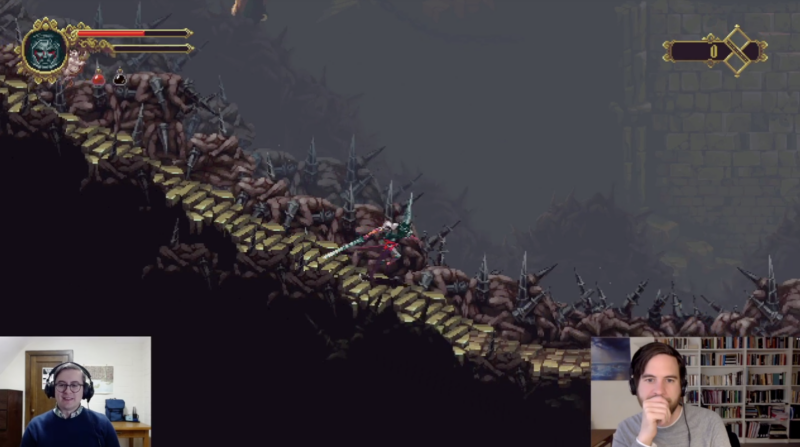
One example is Blasphemous, a game Parker played on Twitch to kick off Streaming SMC, a new series in which he invites fellow St. Michael’s professors to join him to discuss games relevant to their expertise. As Parker’s St. Michael’s colleague Dr. Stephen Tardif offered commentary linking the game’s pseudo-Catholic aesthetics and narrative to real-world sources, Comper Professor of Medieval Studies Dr. Alison More entered the chat to provide historical insight into subjects ranging from 13th-century understandings of purgatory to medieval penitential movements.
The way games and other popular media help to shape and inform modern culture is one of the interests that drives Parker’s research. This year, he joined scholars from several other universities to collaborate on a SSHRC grant–funded project, Swarming SDCC, which looks at the complicated relationship between media industry producers and fans. The two groups have very different relationships to both entertainment franchises and the ComicCon events that showcase them, as Parker and his collaborators argued in an article for The Conversation. Eventually, Parker says his hope is to bring his students into the project as researchers “to participate in the actual on-site ethnography.
“I always strive to give students the tools to bring a critical perspective to bear on the digital media and technology that structures their everyday lives,” says Parker. “This feels particularly pressing in this moment, since for better or for worse we are more immersed in digital media than ever.”
_____________________________
Consult Fall 2020 for current updates on St. Michael’s plans for the fall semester.
November 2, 2020
A generous gift from the Henri Nouwen Legacy Trust to the University of St. Michael’s College will help make the work of the beloved spiritual writer more accessible to researchers and readers around the world.
The funding will support a 12-month contract for an archivist to process the Henri J. M. Nouwen holdings in the Archival and Manuscript Collection housed in the university’s John M. Kelly Library. A search to fill the position is now under way.
Working with library staff, the archivist will handle the preservation, arrangement, and description of various materials, as well as promote their existence and add them to web-based finding guides. The position holder will also digitize materials so that the wealth of books, letters, promotional and related materials in the collection will be easier to access.
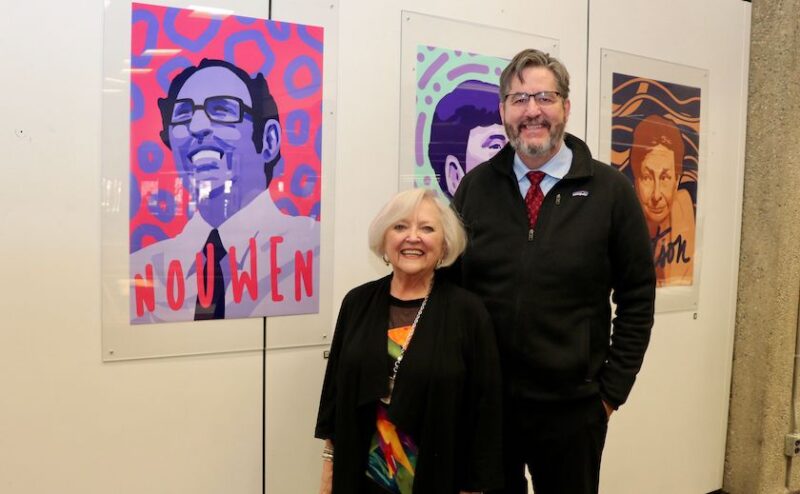
“We have always been grateful for our partnership with St. Michael’s, and this position will help open up Henri to a whole new generation,” says Karen Pascal, who is the Executive Director of the Toronto-based Henri Nouwen Society. “Henri’s writings touched people’s hearts, and demonstrated that vulnerability is part of leadership. As St. Mike’s works to create new leaders, this is a perfect fit.”
University President and Vice-Chancellor David Sylvester is delighted for the continued partnership the funding acknowledges between the society and St. Michael’s.
“The University recognizes and appreciates that this gift builds on the Nouwen Society’s longstanding support of the collection, and we share the commitment to ensuring the collection is preserved and made available to scholars, students and the wider community,” he says. “We look forward to welcoming the new archivist, and to continuing the conversation about other possible partnerships.”
More than 100 researchers accessed the popular collection last year, and John M. Kelly Library Archivist Simon Rogers notes that the funding from the Nouwen Legacy Trust will help to increase the discoverability of its materials. It may become possible “to surface previously unprocessed materials including photographs, audio-visual archival materials, personal correspondence and oral history recordings,” he says.
“We are excited that we are going to be able to give focused attention to these materials, allowing broader engagement for the larger Nouwen community,” Rogers says, adding that the library archive anticipates new materials, including letters and photos, to be added to the collection soon.
A priest, pastor, professor and writer, Henri Nouwen was born in Holland in 1932. A prolific author, he produced dozens of books of spiritual reflections during his life, with more than seven million copies of his works sold. His writings were varied, reflecting on everything from Rembrandt’s depiction of The Prodigal Son through to Thomas Merton, the topic of aging, and a sabbatical year Nouwen spent living at a Trappist monastery in upstate New York. His vast career saw him teach at Harvard and Yale’s divinity schools and live with communities on the margins of society. He spent his final years at L’Arche Daybreak, a community for people with developmental disabilities, just north of Toronto. He died in 1996.
Sr. Susan Mosteller, C.S.J., who served as executrix of Nouwen’s estate, donated the archival material to the Kelly Library in January, 2000, and the archives were officially opened later that year. With a mandate to collect, preserve, and support archival material on Nouwen, the archives hold more than 16,000 letters, various sound and video recordings, a complete set of his published books—including translations—and a comprehensive collection of articles published by Nouwen between 1957 and 1996.
“Henri died before the explosion of the Internet,” says Pascal. “He was a prolific letter writer and felt letters were part of his ministry. He wrote to all sorts of people. Accessing more of these letters, for example—and making them available to researchers—will teach us so much about him, because there’s still so much to learn.”
Dr. Adam Hincks, S.J., holds the Sutton Family Chair in Science, Christianity and Cultures at the University of St. Michael’s College. Dr. Hincks, who specializes in physical cosmology, completed a B.Sc. in physics and astrophysics from U of T in 2004. In 2009 he earned a Ph.D. in physics from Princeton University and then entered the Jesuit novitiate in Montréal. After pronouncing vows in 2011, he pursued philosophical studies at Toronto’s Regis College and later did a Bachelor of Sacred Theology at Rome’s Pontifical Gregorian University. Returning to Toronto, he worked on a Master of Theology and Licentiate in Sacred Theology at Regis College from 2018–20. He was ordained to the priesthood in 2019.
What Parish Are You At, Father?
“What parish do you live at, Father?” It’s a question I’ve been asked a couple of times since I was ordained last year. The answer—“I’m not based at a parish”—can be unexpected for those who are only used to seeing priests at Sunday mass. The fact of the matter is that most ordained Jesuits are not parish priests, nor have we ever been since our founding in the sixteenth century. The same can be said for those in many other religious institutes, such as the Basilian Fathers who are so important to St. Michael’s College. This doesn’t mean that none of us have parishes—for instance, here in Toronto, Our Lady of Lourdes is served by Jesuit priests and St. Basil’s by Basilians. Nor does it mean that we don’t help out at parishes in various ways. But it isn’t our sole defining ministry.
In my own case, my principal assignment, which I just began in July, is as a professor here at the University of Toronto. To be honest, when I became a Jesuit in 2009 fresh off of a doctorate in physics, I never dreamt that I would come back to the St. George campus, where I had been an undergraduate, as a professor! I figured after the many years of Jesuit formation I would could end up in an academic setting, perhaps at one of the scores of universities we run around the world, but it was only a vague idea.
The position I have begun here is new and unique. Supported by the Sutton Family Chair in Science, Christianity and Cultures, I have an appointment both in the Department of Astronomy & Astrophysics and here at St. Michael’s College. The majority of my research is purely scientific, in the area of physical cosmology, or the study of the Universe as a whole. I work on telescopes that observe the very early universe and that map out the cosmos on its largest scales. But with my training in philosophy and theology, I also have an interdisciplinary interest in how science relates to faith and vice versa. And so a good part of my teaching will be precisely in this area—such as SMC371, “Faith and Physics”, which I shall teach in the winter term of 2021.
Still, one might return to the spirit of the question I began with and frame it a bit differently: why should a priest be engaged in research and teaching at a public university? There is the somewhat facile answer that there have been clerics on faculties ever since the first universities of the West arose in the eleventh and twelfth centuries. The Church has always valued education and the pursuit of knowledge, and thus her clergy and religious as well as her laity have always contributed to these great endeavours. But looking at the question from within the tradition of my own religious order, I am reminded of the notion of “finding God in all things”, a formula often used to capture a key aspect of the spirituality of St. Ignatius of Loyola, our principal founder.
“Finding God in all things” is not a vague aphorism or a flaky aspiration, but is rooted in the deeply Biblical conviction that as Creator, God is intimately present to his creatures, or, as Thomas Aquinas put it, “God is in all things, and innermostly.” This does not mean that if you use a powerful enough microscope (or telescope!) you will suddenly find scientific “evidence” for God. But it does mean that studying creation—whether through the lenses of the humanities, the social sciences or the natural sciences—can be a springboard to contemplating its Creator. “Whatever is true, whatever is honorable, whatever is just, whatever is pure, whatever is lovely, whatever is gracious, if there is any excellence and if there is anything worthy of praise, think about these things” (Phil. 4:8, NABRE). And ultimately, it is “contemplation of divine things” that is one of the principal tasks of those of us in religious life.
So I consider myself blessed to have this opportunity for contemplation, even if the busyness of the job means that I can’t always advert to it! I am looking forward to collaborating with all my colleagues at this university—fellow faculty, other researchers and students—as we lift our minds to consider true and lovely things “worthy of praise.” Not everyone contemplates science from within a religious worldview, and of course there are some who think such a stance is ludicrous. But I’m excited that St. Michael’s College has opened the space to explore it further, and I’m excited to see where it leads. I trust it will make me a better scientist, a better Christian—and a better priest.
Read other InsightOut posts.
Risa de Rege is a library technician at the Kelly Library. She has a B.A. in history, art, and medieval studies from the University of Toronto, and is currently a master’s degree candidate at the Faculty of Information.
The Ups and Downs of a Paradigm Shift
The past year, and the unwelcome pandemic that came with it, has brought a lot of change to my life. Usually I’m a person who is happy with things the way they are, but every now and then the paradigm shifts, so here I am. Since January I’ve started a new job here at St. Mike’s, seen my hobbies completely change for the foreseeable future, and enrolled in a graduate program. Nothing is normal, and every day I feel the stress of a global disaster. But maybe the British were on to something with “keep calm and carry on.”
I’m no stranger to libraries. I worked at Victoria College for several years at the circulation desk, and in 2018 joined USMC as a processing clerk in the technical services department. A few years ago I decided to make a career out of this experience, and recently finished my library technician diploma. In January I had the pleasure of joining Kelly’s access and information team full-time—only for us to shut down about 10 weeks later. After a few months working solely from home (probably the longest I’ve gone without visiting campus since high school), I was back on-site to help with shifting in anticipation of an ongoing construction project. I then helped with curbside pickup and, more recently, re-opening for study space. Not exactly how I imagined my career really taking off, but sometimes that’s just how it is.
Working from home offers more flexibility and no more time lost to commuting. I have a bit more time to myself, but nothing to do with it. Outside of work and school I spend most of my time singing opera, a hobby which for obvious reasons will not be coming back anytime soon. A trip to perform in England this summer was postponed to a healthier year, and I have many friends whose shows, if not whole seasons, were cancelled. I have been singing virtually, though. While unfortunately my local opera society has not ventured online, I’ve rejoined the Toronto Mendelssohn Choir, which is producing a virtual concert season, and I continue to sing with a community choir which has adapted marvellously. This all-ages, all-abilities group generally sings music written specifically for it by local composers. While singing together live on Zoom is basically impossible due to a host of technical issues, our current composer-in-residence is creating music specifically with this situation in mind. It’s been fun to explore music this way, but it’s not the same. It’s really articulated to me that I sing not only for love of the art form but for love of the people I sing with.
One true advantage of COVID is that working from home means I can foster kittens. I’ve fostered adult cats for years and now have my own, a tabby named Autumn who I picked up the day after Kelly closed. But now, being home most of the time means I’m here to keep an eye on things (I love cats, but I don’t trust them). I started taking in kittens in July, and I’m on my second pair now: two brothers who have a mild neurological condition that affects their balance and motor skills. Among all the stress of a global pandemic, a million dead, a looming election, an environmental crisis, etc., it is extremely grounding to take care of two sweet, vulnerable babies and know that I am giving them a second chance at a happy life. Sometimes all the good we can do is small, but that doesn’t mean it doesn’t make a difference.
Another thing I’ve started during COVID is my master’s degree at the Faculty of Information. While I’m grateful that the Faculty committed to an entirely virtual semester early on, an entire graduate program quickly moving online is not without its difficulties. But I was eager enough to start that I didn’t want to delay another year just on the off chance that in-person courses might return in the fall of 2021, and I don’t regret it. It’s nice not to have to worry about commuting any farther than across my bedroom to my computer desk. And while online classes are still pretty structured, there’s a bit more flexibility to go at my own pace. I did my library technician diploma completely online, through Mohawk College, and it was an entirely different experience that I found very positive. Classes designed to be delivered online are very different from classes designed to be in-person that get thrown into Zoom. Everyone in academics has described this year as a “learning opportunity.” What we learn from it remains to be seen.
The biggest downside is that communication is much harder and mostly relies on the strength of one’s internet. With professors still encouraging group discussions as a major part of classes, I’ve found that a lot of my time is spent trying to hear someone over background noise or a bad connection. Due to either bandwidth or shyness, few people have their cameras on so it’s been very difficult for me to feel like I’m getting to know anyone. If there’s one thing COVID has taught me, it’s how much I rely on casual social interactions: chatting before class starts; stopping by a former workplace to catch up; and the subtle body language and facial expressions that contribute so much to conversation. In some ways staying behind a computer is good for social anxiety; in other ways it’s far worse.
Still, things have been okay. I want to do a thesis and I’ve been able to start refining my ideas and doing some preliminary research this term. I’m interested in fringe beliefs, like conspiracy theories, the paranormal, or pseudoscience, and why people believe in these things. While I’m pursuing this mainly out of personal interest, it’s not hard to justify why understanding science resistance is pretty important in the current state of things. If we ever want to go back to learning in-person, we need to get more people on board with the latest epidemiology.
Read other InsightOut posts.
Fall Campus Week gives prospective University of Toronto students the opportunity to remotely explore programs and colleges at the University. This Saturday, St. Michael’s College will open its virtual doors to introduce some of those students to its vibrant community, its outstanding academic programs, and its robust supports for students.
“When you come to St. Michael’s you will feel this sense of community that is very real,” says Giancarlo Mazzanti, St. Michael’s Registrar and Director of Student Services. “Our approach is to make it as human an experience as possible – meeting with current students, advisors and student services personnel,” he says.
This year, current students will facilitate live chats with virtual guests to discuss life at the College during two two-hour windows, and a diverse student panel will also offer a more focused presentation on their experience of community at St. Mike’s.
Advisors from the Office of the Registrar and profs and staff from the Office of the Principal will also introduce prospective students to another St. Mike’s distinctive during Fall Campus Week and on Fall Campus Day itself: the outstanding interdisciplinary programs that draw from the College’s historic strengths.
“I like to think of it as a small liberal arts college sitting at the corner of Bay and Wellesley,” Mazzanti says, noting the small class sizes and personalized support students receive in sponsored programs like Christianity & Culture and Medieval Studies. The appointments of new professors like Dr. Adam Hincks, SJ as the Sutton Family Chair in Science, Christianity and Cultures and Dr. Alison More as Comper Professor of Medieval Studies and the introduction of special initiatives like Dr. Paolo Granata’s Media Ethics Lab have contributed to a sense of renewal and new excitement for the College’s programs.
These professors also support the College’s commitment to building a diverse and inclusive community, connecting with students through virtual events and a unique first-year check-in program. These are two examples of the many supports the College’s registrarial advisors will introduce to students—a range of services touching all parts of campus, from mental health counseling to academic assistance to financial aid.
While the pandemic has made the prospect of attending university more challenging for some students this year, Mazzanti also emphasizes the ways the University and College are partnering to give unprecedented help to incoming students affected by COVID-19. St. Michael’s normally receives $372,000 from the University of Toronto to support grants and other student aid. This year that figure has doubled to $744,000, with the extra funding intended to cover COVID-19-related needs. This funding is in addition to St. Michael’s own bursaries, grants, and other student aid, all of which will be covered during the event.
The additional funding enables the Office of the Registrar to help a bigger pool of students to cover additional expenses, and gives the office the flexibility to provide assistance to international students undergoing pandemic-related financial stresses.
While students may not be able to physically visit the campus, virtual tours will make it possible for them to take in the sight of St. Michael’s “Oasis in the City.” If they pay attention to social media, they may even get a chance to catch sight of one of the campus’s most recent visitors—a silver fox—or take a moment to relax in front of one of the many fireplaces.
Fall Campus Week at the University of Toronto runs from October 17 to 25. Fall Campus Day for St. Michael’s College will take place Saturday, October 24. Register to attend.
“The whole is greater than the part, but it is also greater than the sum of its parts.” (Pope Francis, encyclical Fratelli Tutti (3 October 2020), # 145.
We write to inform our communities that representatives of the Board of Regis College, and the Collegium of the University of St. Michael’s College, have met recently to explore a mutual desire to renew long-standing discussions regarding a closer institutional relationship between the two Catholic institutions.
We are pleased to report that these very fruitful meetings have led to the establishment of a Steering Committee that will oversee, on behalf of the two governing bodies, the formulation of an alliance between Regis and St. Michael’s. The work of the Regis-USMC Steering Committee and its anticipated sub-committees, and the deliberations of the respective governing bodies, will be guided by the following shared principles:
- The commitment to forge a world-class centre of excellence in Catholic theological study whose mission is to promote teaching, research, and formation to serve the needs of the Church and society, here in Canada and globally;
- The commitment to consult all stakeholders (including the administration, the faculty, staff, students and alumni/ae, of each institution, as well as the sponsoring religious orders/ congregations). The continuation and cultivation of a cordial relationship with the Archdiocese, while keeping the Cardinal informed of plans and on-going developments;
- The commitment to orient governance of Regis and St. Michael’s to a deepening union for the sake of enhancement of their mission.

David Sylvester, PhD
President and Vice-Chancellor
University of St. Michael’s College

Thomas Worcester, S.J., PhD
President
Regis College
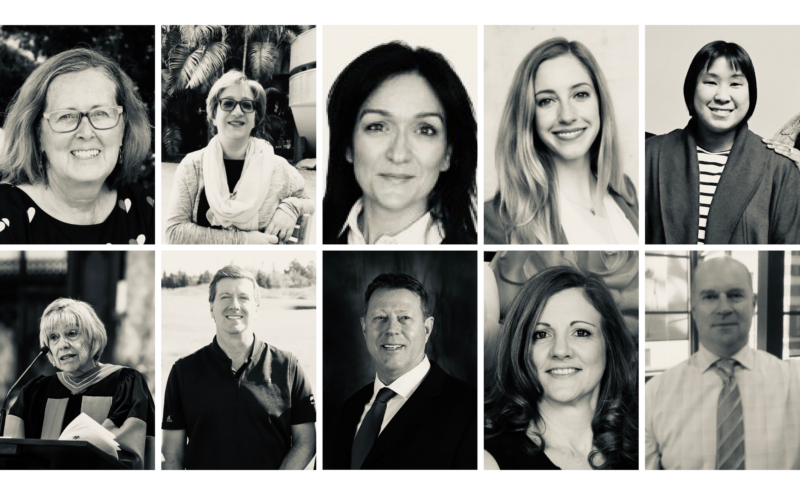
Ten alumni of the University of St. Michael’s College have been named recipients of the Arbor Award, the highest honour granted by the University of Toronto. The award recognizes outstanding volunteer contributions to the life and mission of the university community.
This year’s Arbor Award winners from the University of St. Michael’s College alumni community have helped coordinate initiatives that have funded major improvements for students, supported uniquely impactful programs and associations, and done much else to further the work and community of the university. Join us in congratulating the following recipients:
Wendy L. Brennan (SMC 7T6) has been a volunteer supporter of the Friends of the Kelly Library annual book sale since 2008, serving since 2015 on the executive committee. With her help, the yearly sale has generated proceeds that have directly benefited St. Michael’s and UofT students through improving the Kelly Library’s physical spaces, updating library technology, and preserving and enhancing its collections.
Susan Campisi (SMC 9T1) has since 2017 served as Awards Officer for the Dalla Lana School of Public Health’s Public Health Alumni Association. Through her leadership in the position and her membership on the board, the PHAA has grown stronger, and the awards process has become more efficient and streamlined.
Rosa M. Del Campo (SMC 8T7) has supported the Rotman Commerce community through mentoring students, speaking on panels and moderating for events, and has offered her expertise and support consistently to both current students and alumni in the Rotman community.
Lauren Della Mora (SMC 1T2) received a Fr. Robert Madden Leadership Award from St. Michael’s upon her graduation in 2012 in recognition of her service and leadership in the St. Michael’s student community. Since then, she has served a valuable role on the Dalla Lana School of Public Health’s Public Health Alumni Association’s board of directors, and provided mentorship and guidance to students through a variety of organizations at UofT including Women in Science and Engineering and the Faculty of Arts & Science’s Backpack to Briefcase program.
Elizabeth I. Lee (SMC 0T5) has served the Factor-Inwentash Faculty of Social Work Alumni Association in a volunteer capacity for the past five years, contributing her administrative talents as Secretary for the association from 2015 to 2018 and continuing to serve since then as a member-at-large.
Dr. Mimi Marrocco (SMC 6T9) has served as her class representative since her graduation in 1969, helping to expand and strengthen the St. Michael’s alumni community. Since 2015 she has given tireless support to students in St. Michael’s Corporate Social Responsibility program, offering career advice, helping them to connect with the program’s alumni network, and lending her expertise in social responsibility, social impact and sustainability.
Barry S. McInerney (SMC 8T5) has served as co-chair of the annual St. Michael’s Golf Classic since 2017, and in the role has helped to organize virtually every aspect of the event. Since its inception in 2000, the golf classic has raised more than $2.7 million to directly support St. Michael’s students.
Joe G. Nizich (SMC 7T7) has helped coach the Varsity Blues Men’s Lacrosse team since 2006 and has been head coach since the fall of 2010. His dedication to the sport and to his student athletes testifies to his commitment to the education of the whole person.
Laura A. Pasut (SMC 8T2) became president of the Department of Nutritional Sciences Alumni Association in 2018 following six years of providing mentorship to students and leadership in the association. She has been credited with helping to revitalize the association and has supported and provided guidance to many students studying in the department.
Stephen T. Taborek (SMC 8T4) upholds the value of St. Michael’s approach to the education of the whole person by honouring its athletic tradition. He has supported St. Michael’s alumni and students involved in athletics by serving on committees for the Mulock Cup, Lex Byrd award, and Boozer Brown athletics reception, and helped to launch the Lex Byrd bursary for student athletes at St. Mike’s.
________________
Since 1989, more than 2,300 alumni and friends have received Arbor Awards for their tremendous generosity and contribution to the experience of U of T students, faculty, staff and alumni. The award is the highest honour granted by the University and is given for sustained contributions to specific academic units, such as faculties, colleges or institutes, or for broader contributions to the University at large.
Catherine Mulroney is a communications officer at the University of St. Michael’s College. She holds degrees in English and theology from St. Mike’s. This holiday, she is stopping herself from making too many pies.
Gratitude as Gift

This Thanksgiving, I choose to be grateful.
Gratitude may not be the first emotion that will come to mind for many of us this fall. If your holiday traditions include circling the dinner table with guests rhyming off the things for which they are thankful, you may have to dig a little deeper this year. I can’t think of a person I know who hasn’t been touched in some way by the pandemic, whether it’s by fears of job loss and economic instability, worries over the health and safety of loved ones, or a general sense of anxiety about the way forward to healthier, happier times.
For my family, this is our first Thanksgiving without my husband. Mike died the week prior to the pandemic lockdown, and we celebrated his life in Charbonnel Hall the day before the COVID restrictions began. Charbonnel seemed an ideal place for a memorial service because, although he wasn’t a St. Mike’s grad, he spent plenty of time on campus, first swinging by after work to pick me up in the COOP when I was an undergrad, then picking me up after classes when I returned to study theology, and finally re-arranging his drive home from the office to get me when I began working here five years ago.
At times, my family’s grief—both individual and collective—seems bottomless, our loss immeasurable. Heightening our mourning is the fact that we moved immediately from a celebration of life to a life of isolation, cutting us off from the ways in which people mark a death and find consolation. Yes, there were casseroles, but instead of inviting the consoling chef in for a visit, there would be a timid knock at the door and a wave from the driveway. There were mass cards, but no masses to attend. And as my children gradually returned to what passes for normal life these days, social distancing often cut us off from even the solace of each other’s company.
We do talk to each other, though—a great deal—and when we do we ponder the life of their father, our time together as a family during his illness, and, of course, happier times. It has been through these conversations that I am repeatedly reminded of the sacramental nature of gratitude.
To be grateful is to admit that our lives—and the people in them—are a gift. It is to acknowledge our own vulnerability and our deep need for connection. At its heart, gratitude signals an awareness of the grace that imbues our lives, allowing us to weather the most challenging of times and circumstances. It reminds us that this is not the end. Even in loss, we can acknowledge the richness of what we have received—and we can hope for the future.
Like so many other people this year, this will be a tough Thanksgiving for our family. Instead of adding an extra leaf to the table to accommodate the kids and their overflow crowds, I’ll be arranging only four settings, appropriately distanced. Two children will not be making it home for dinner this year. Mike’s spot will be empty.
But we will Zoom with extended family, and we will laugh, and we will tell stories. And through it all I will try to remain thankful—for the gift of a wonderful marriage to a great guy, and for our four children, who continue to remind me of Mike, whether by a facial expression, a turn of phrase, or by outrageously goofy behaviour.
When our oldest son was over recently to help me with some gardening, for example, he had one tree nearly felled before he realized he was cutting down my favourite lilac rather than the sizeable weeds that had sprung up from wandering maple keys.
Jake’s face showed his chagrin when he realized his mistake, his desire to help his mother having turned instead into something he worried would upset me. But suddenly his expression turned to one of amusement. “Hey,” he said, “didn’t Dad mow down your hydrangea the week after you planted it?”
When I confirmed the memory, Jake tilted his head and smiled. “Just like Dad!” he said. Yes, I thought, you certainly are. And so are your siblings.
This year, there will only be four places at our Thanksgiving table. Our lives are upended and not at all what we would have anticipated or asked for.
And in the midst of it all, I will choose to be grateful.
Read other InsightOut posts.
Stephen Marchment is an assistant registrar for the Faculty of Arts & Science at the University of St. Michael’s College. He is currently working on a Master of Education degree in Student Services in Higher Education at OISE. Steve has worked for post-secondary institutions across Canada and internationally for more than 10 years. USMC is the sixth post-secondary institution he has called home.
Looking at Your Hands
On June 7 of this year, my wife and I welcomed our son Ollie into the world. My wife was in labour for just a little over 31 hours. To say she did an amazing job is an understatement; she laboured for about 20 hours at home before we decided to transfer to the hospital with our midwife. But this Insight Out isn’t going to be about giving birth in a hospital during a pandemic, or about how the first time Ollie and I met I was wearing a mask—that could be a whole other post. This Insight Out is about one simple question: When was the last time you just looked at your hands?
My wife and I didn’t really get a lot of direct in-person support from family or friends in the first few weeks of being new parents because of the circumstances surrounding the pandemic. We simply couldn’t; there were still many unknowns about COVID-19 and its effect on infants. We were advised by multiple health care professionals to be very cautious about who we let around our son in the early week—even grandparents. This was difficult for us and our parents. But let’s fast-forward to when he was about three months old so that I can share the following story.
I was just finishing up a meeting when my wife called me downstairs to see what Ollie was doing. We both looked at each other in wonderment and laughed because Ollie was simply looking at his hands for the first time. He had just realized that these things that kept floating in front of his face and going into his mouth were in fact attached to him! It was a wonderful moment to share with my wife, to be present for that little triumph and moment of new self-awareness.
So, let’s rephrase the question: When was the last time you appreciated a very small part of your day?
I’ve been reflecting on that moment a lot as the months have passed. I feel that Ollie was not just discovering his hands but was trying to teach us a lesson: Appreciate the small stuff, because the small stuff can make the biggest difference. Now that Ollie has discovered his hands he can suck his thumbs, grab onto things and push himself up during tummy time, grab his pacifier out of his mouth. It’s all because he took a moment and pieced two and two together… he’s had his hands this whole time.
As we go further into October and we see news about a second wave and predictions of 1,000 cases a day in the coming weeks, I encourage you take a moment and appreciate the small stuff. Take a minute to breathe and think about a small thing you may not have given much attention to or taken for granted. Maybe it’s a new song you heard, or how your coffee tasted amazing this morning, or you heard from an old friend, or that you simply have the ability to wipe away a tear or two from a moment of sadness or a moment of laughter.
I try my hardest to keep as positive of an attitude as I can and bring that to work with me every day. I truly think we’re in this together and we need each other to succeed. Let’s take moments to be self-aware, to notice things we may have missed before, to be grateful for the small stuff, and to take care of each other.
Read other InsightOut posts.
Roshni Mathews is a social responsibility enthusiast and student in the 2020–21 cohort of the Graduate Diploma in Social Responsibility and Sustainability.
Kathryn Cooper is Program Manager for the Graduate Diploma in Social Responsibility and Sustainability at the University of St. Michael’s College, a Professor of CSR at Conestoga College and the President of the Sustainability Learning Centre.
Using Experiential Learning to Understand the Bigger Sustainability Picture
To some of us, the current pandemic is a warm-up for the climate crisis. For others, there is a direct connection between changing climate and infectious diseases.
Amid the roller coaster of pandemic cases, students in St. Mike’s Graduate Diploma in Social Responsibility and Sustainability were busy recently seeing the connection and designing a world that could adhere to the Paris Climate Agreement’s 1.5 degree C warming. Divided into Zoom teams, participants played the roles of World Governments, Clean Tech companies, Climate Activists and Fossil Fuel businesses in an international Climate Summit simulation. They learned first-hand the level of collaboration needed to make the planet the climate-stable and socially just place it needs to be. Topics on the debate floor included, “Can focusing on small changes leverage big results?” and “Can building new connections between stakeholders generate environmentally sustainable, socially just possibilities for all?”
These were heady questions for a Monday morning, but with the help of Climate Interactive’s En-ROADS Climate Simulator and the program’s own Climate Ambassador, Laura Lindberg, the group came away with important insights.
“There is no ONE solution on climate action,” says student Tayna Thorpe, Senior Advisor, External Affairs and Communities, Rio Tinto, a participant in the program. “No single action is sufficient. Many levers are required to meet the 1.5 degree target. It truly is all-hands-on-deck time.”
And that is why student Laura Lindberg chose to study the role of climate conversations and became an En-ROADS Climate Ambassador for her capstone project, the summative work for the CSR program. Lindberg, recently employed by PepsiCo in New York and Toronto, joined the program to better understand the impact of the climate crisis.
“I am increasingly concerned about the state of the climate and dire implications for our continued survival. To be honest, I find it difficult not to think about. I felt I needed to do something significant to help,” she notes. “I love presenting and facilitating, so when I found the En-ROADS simulation and training, I knew it would be a tool I could use to make a difference.” As the certified En-ROADS facilitator, Laura guided the climate role play by taking on the role of executive secretary of the United Nations Framework Convention on Climate Change. “It was the first time the En-ROADS Climate Summit had been delivered on Zoom…Companies around the world are beginning to use this tool for employee training and scenario planning. I am proud to be leading USMC’s introduction to this groundbreaking tool,” she says.
“We want participants in this program to challenge their worldview,” notes Kathryn Cooper. “We are living the unintended consequences of our unexamined assumptions about the environment, society and business. Participating in the simulation and role play engaged the cohort in an interactive, thought-provoking way. I think we learned that everyone has a role to play in addressing global climate change. None of us can solve this alone, and small measures won’t cut it. We are all part of a larger system and every policy lever needs to be pulled. Everyone reading this article has a role to play.”
After using the En-ROADS simulation, CSR participants understood at a deeper level which policies and strategies are more likely to have a big impact.
“Cross-industry and cross-sector partnerships are required to make significant environmental progress,” says Roshni Mathews, who took the free training sessions to become the En-ROADS facilitator for this exercise. “In this simulation, we all learned that collaboration, shared goals, and a willingness to be flexible for the greater good is key to making impact.”
About the Graduate Diploma in Social Responsibility & Sustainability:
For close to 20 years, the University of St. Michael’s College has been the go-to school in Canada to study Corporate Social Responsibility, an operational philosophy also known by a variety of other labels, including ESG (Environmental, Social, and Governance), Corporate Citizenship, Social Purpose and Social Innovation. The program is renowned for blending Liberal Arts critical thought, social justice, and practical problem solving with expert instructors and mentored capstone projects. In 2019, Dr. David Sylvester awarded the first President’s Capstone Project Awards.
Read other InsightOut posts.
Dr. David Sylvester is the 8th President and Vice-Chancellor of the University of St. Michael’s College in the University of Toronto. A professor of medieval social and economic history, he holds an M.A. and a Ph.D. from Fordham University, New York City and has taught for three decades in universities in Canada and the United States. For the 50th post in the InsightOut series, Dr. Sylvester offers special greetings for Michaelmas.
Betty Noakes has been a proud employee of St. Michael’s College since 2009. She has served as Alumni Affairs Associate, responsible for numerous alumni and community events for many years, and, most recently, as Advancement Associate, responsible for donations processing and donor stewardship. Betty earned her BA in Social and Cultural Anthropology from St. Mike’s/UofT in 2013, crossing the stage at Convocation Hall at the age of 50, finishing off studies that were postponed in the 1980s. One of the greatest joys of Betty’s work has been interacting with and getting to know many St. Michael’s students, alumni and friends. Betty is also one of the human caretakers of Toby, the 11-year-old Newfoundland/Labrador dog and, most recently, nine-week-old Baco the kitten.
A Family’s Best Friend Gets a Pandemic Pal

Toby, our big brown Newfoundland and Labrador mixed-breed dog, came to us 10 years ago when he was just a year old. We found him on Kijiji a few days after our family dog Jake passed away. Losing Jake, our family felt anchorless. We had always had a dog, and we felt so incomplete. Our cat Luke missed having his dog friend to chase around the house, to torment, and to cuddle with during the day when the humans were away. We wanted a dog who was large and gentle and who would enjoy time with our family at our cottage on the Crowe River. A dog who loved water would be best, and we thought love of water would be ingrained into a Newfoundland and Labrador’s DNA. We were right about that!
Toby’s previous home had been in a high-rise apartment in the GTA where, during the day and for most of the night, he was kept in a crate. His previous owner had to move and so put Toby up for sale. Lucky for our us! We like to think lucky for Toby as well. From the very beginning Toby loved us and we loved him. It wasn’t long before he became well known in our neighbourhood from his walks and visits to the local park, as he would greet everyone with a tail wag and a smile and could get along with most other dogs. For the past several summers, Toby has become infamous on his stretch of the river by our cottage where he stands in the water for hours on end “fishing,” often mistaken for a bear by passing boat traffic.
Toby and his cat Luke were best buddies, and often curled up together to sleep in Toby’s favourite chair. After long days at work or at school each of us would be greeted with such excitement! It was as if he had been waiting for our return all day. These greetings and the kisses that came with them were magic, and helped us leave the stresses of our days at the door. Evening time was always a flurry of supper preparations and clearing, homework, chores, and a walk for Toby. Afterwards, when things quieted down for the night, Toby would stretch at our feet and receive pats and scratches, with Luke snuggling in my lap as we read or watched TV.
As the years ebbed on, Toby was always at or under our feet or by our sides. When he sensed we were sad or when things were not going our way, he would put his big chin on our laps or rub against our legs and we would automatically reach out for the comfort of patting him, without even realizing we were doing it. Toby always seemed to know when anyone was sad and needed an extra bit of his gentle, unconditional love.
It’s been 10 years since Toby arrived, and our two sons have grown. One of Toby’s human brothers moved away and Luke the kitty recently went over the rainbow bridge. These changes came in the winter of 2019 and were hard on Toby. He missed the human who grew up with him and he kept looking in the vacated room, sometimes just sighing heavily and lying on the floor of that room, waiting for his brother’s return. When his cat brother passed on, Toby was extremely sad, looking for Luke in all his favourite spots, and cuddling with the cat’s abandoned stuffed toys. Toby was depressed and seemed to lose his enthusiasm for things that used to give him so much joy. We tried to pat him even more and show him extra love, but he just seemed so sad, so despondent, although he went along wagging his tail, likely for our sakes.
Then suddenly, about six months ago, things changed again in Toby’s world. We humans stopped going out every day and stayed home most of the time. All of the sudden there were more walks and more pats on the head! We humans who were left in the house, however, seemed sad and worried to Toby, as we sat more in front of the TV news shaking our heads. Toby became even more attentive to us, sensing we needed to pat him, and hoping we needed to go out for another walk soon. It seemed to help Toby’s sadness having us around so much, and we sure know it’s been a big comfort to pat him, to walk him, and to look into his big kind brown eyes full of unconditional love for us. We pat him and we feel our worries ebb away; worry and concern for his needs takes us out of ourselves a little bit.

Though Toby has been busy looking after us the past six months, he still seemed a bit sad, and still went to the same spots looking for Luke the cat. But recently, the opportunity to give a new kitten a home presented itself. We jumped at the chance to give a home to a cute little kitten born in a barn in a vineyard. We’ve named the kitten Baco, after the delicious Baco Noir which hails from his birthplace.
For now, Toby and Baco are sniffing at—and closely keeping an eye on—each other. Over the past few days, Toby has an extra spring in his step, although for now it may be the prospect of humans leaving open the door to the room where the cat food is, giving him the opportunity to gobble it up before we or Baco know what is happening. Or it may be the realization that in Baco he has a new friend to commiserate with about the humans, to share toys and to cuddle with—and eventually to keep him company when the days return that prompt the humans go back to being away from home for hours on end.
For now, though, Toby is delighted to lie at our feet and let us pat him while he sniffs at the kitten swatting at his nose from my lap.
Read other InsightOut posts.
St. Michael’s Profs Use Creativity to Remotely Engage Students
Dr. Paolo Granata is no stranger to the beguiling magic of digital media, and the transition to remote learning this year has brought out his own penchant for magic tricks, including one found in a video he created for students to give them a sense of what they’ll experience this semester. (Spoiler alert – keep your eye on the apple at the end of the video!)
St. Mike’s Book & Media Studies professors have a reputation for keeping students engaged, and their subject matter expertise gives them a deep understanding of the pedagogical advantages of teaching online.
Granata, a scholar of legendary St. Michael’s media theorist Marshall McLuhan, refers to McLuhan’s famous dictum when discussing the possibilities: “As the medium is the message, we do approach online course delivery as a medium, and try to find the uniqueness of that medium, to experiment with that medium, and eventually understand how it works, what are its intended and/or unintended implications,” he says. These formal dimensions of online learning and remote teaching are things he explores with students in his classes, as well.
For Granata, accessibility is another area where remote teaching provides unexpected and unique benefits.
“Recorded lectures can be more accessible and, to some extent, more inclusive,” he says, mentioning the benefit of closed captions and variable playback speeds. “Accessibility means also engaging students using different means such as the class chat,” he says, and because he’s also better able to customize the experience for individual students, “nobody is left behind.”
Granata’s remote teaching toolkit includes the ability to swap out the video source, making it possible to move from a standard lecture to a close view of a special text or physical artifact students might not have access to under normal conditions. This and other approaches open up a number of possibilities for St. Mike’s courses he is teaching this year, including Media in Culture and Society, the McLuhan Seminar in Creativity and Technology and the Media Ethics Lab.
One question remains. How did prof Granata do his apple trick?
His reply: “The magic is in the eye of the beholder.”
Consult Fall 2020 for current updates on St. Michael’s plans for the fall semester.
Mike Czobit is the director of the Office of the Principal, and the coordinator of SMC One. Before joining St. Michael’s in 2017, he was an editor and writer at World Vision Canada.
There Will Be Cake
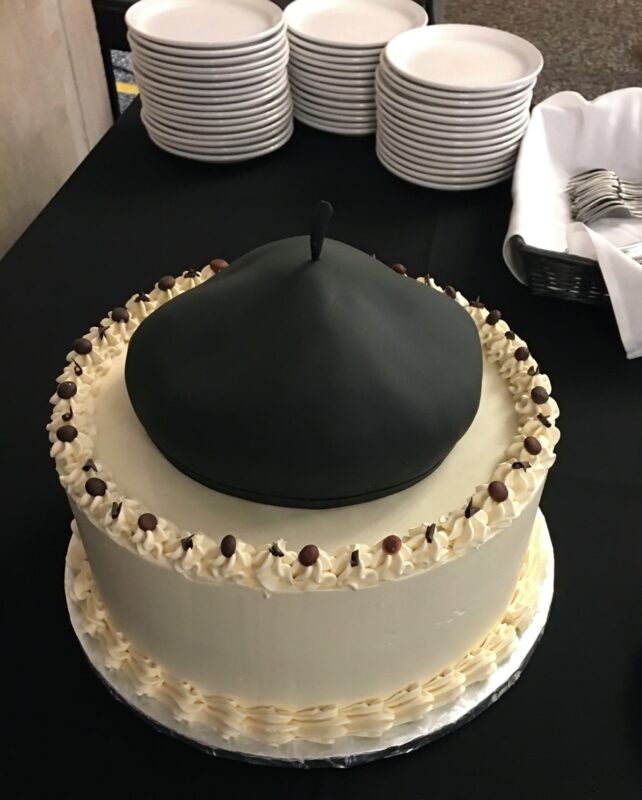
Every year, before the Gilson Seminar in Faith and Ideas meets for its first lecture in September, we have an opening reception and something we call the “Beret’ing In.” To the tune of Prince’s “Raspberry Beret,” each incoming Gilson Seminar student approaches the lectern in Charbonnel Lounge and receives a black beret, officially joining the seminar. After every student has been beret’ed in, cake is served—a special kind of cake: raspberry beret cake.
This tradition is a night of fun and introductions before the hard work of the Gilson Seminar begins. The course, which is split into two half-term classes over the course of the year, is one of three first-year seminars offered by St. Michael’s College as part of our SMC One program. The other two seminars are the McLuhan Seminar in Creativity and Technology and the Boyle Seminar in Scripts and Stories.
These seminars are among the most popular first-year courses at the University of Toronto, owing to a number of factors. For example, each is taught by a member of our talented St. Michael’s faculty in a small class setting that fosters fascinating discussions and close friendships with fellow classmates, and each features an international learning experience. In the Boyle Seminar, students are invited to travel to Dublin after the April exam period. A trip to Silicon Valley takes place during reading week for the McLuhan Seminar. And the Gilson Seminar’s second half-course has its destination in its title: The Gilson Seminar in Faith and Rome.
For most people, international travel these days has been ruled out for health and safety reasons, and for the impracticality of visiting a country when it likely requires a quarantine upon arrival. But, back in February, before the present conditions of international travel took hold, there still was the possibility to go to Rome or Dublin. In fact, that was the plan for both the Gilson and Boyle classes (the McLuhan Seminar had traveled to Silicon Valley last November, before anyone here had really heard of the virus).
In the Principal’s Office, we are responsible for organizing all three SMC One trips. Throughout January and February, we proceeded as usual, preparing students by holding Safety Abroad workshops, requesting traveler information, and making airfare arrangements. We worked with our partners in Dublin and Rome to finalize details for each trip, and in the case of Rome, arranged for tickets for the Pope’s Wednesday Audience. Everything was proceeding as it had every year, except, as everyone knows now, this wouldn’t be a normal year.
By late February, my office was paying particular attention to reports of COVID-19 cases emerging worldwide. When the first few cases surfaced in northern Italy, we were concerned but hopeful that the country would get control of the virus. Reflecting on that now makes me realize how little we all knew and how naïve my optimism was. Day by day, in early March, the number of infected patients rose. Not just in Europe, but also at home. These developments worried our SMC One students, who began asking my office questions about the safety of our planned trips. At the time, we honestly didn’t know what the virus would mean, but we assured our students that safety would be paramount and that the trips could be postponed. Then, on March 12 that happened. The University decided that due to safety concerns, all student travel would be postponed until further notice. This was the right decision.
After we unwound the arrangements for the planned trips, my office had a different task to attend to, which was to start recruiting for next year’s SMC One seminars. When we promote these classes, we do the opposite of shying away from discussing their travel components. But during this recruitment period, getting on a plane to go somewhere far away seemed like the least desirable thing to do. At the same time, the 2020–21 SMC One seminars were months away and the situation in March would change—and, to be optimistic, be much, much better.
We pushed forward with our recruitment effort, inviting incoming U of T students to apply for a spot in our seminars. We expected that we would struggle to fill the classes. We expected that SMC One would have lost its popularity. What happened was something different.
When the application window closed on June 15, we had received the highest number of applications for SMC One in the three years their present format has existed. In fact, we doubled the total number of applications over our previous best. Our incoming students were not deterred by news reports of the virus or of how international travel will never be the same. They reacted to the closing of borders with a greater desire to see them open again. What they want, and what classes such as SMC One will provide, is a return to better times when a desire to explore and experience life and culture in different parts of the world can enrich a university education.
As the new academic year begins, we have begun planning for our SMC One classes. Different this year is that all three will take place in the Winter term, with the hope that all will be able to be in-person or have a larger in-person component than is safe in the Fall term. It is too early to know what international travel will look like in 2021, but we’re hopeful that conditions will improve.
Every year, the Gilson Seminar begins with berets and cakes. We hope to see this tradition resume in this coming year’s Gilson class. And when the cake is finally served, it will have the double meaning: welcoming a new class to St. Michael’s College and also celebrating how far we’ve come through difficult times. When we began our recruitment effort for SMC One in the spring, we were pessimistic about our prospects of filling these classes. Our students showed we should have felt otherwise.
Read other InsightOut posts.
Theologian Karl Barth famously advised younger colleagues to base their work on both the Bible and the newspaper. Now, two new courses offered by the Faculty of Theology at the University of St. Michael’s College are doing just that, reflecting theologically on the evils of racism and clerical sexual abuse, topics that regularly make front-page news.
Theology of Radical Evil and Suffering will look at the experience and testimony of Jewish, African American and Indigenous individuals and communities who experienced extreme evil and suffering at the hands of those reclaiming what they understood to be their Christian faith, values and way of life.
(Sexual) Abuse and the Catholic Church, in turn, aims to explore how the present sexual abuse crisis informs—and proposes the need to reform—the understanding of the church as body of Christ.
“These are very challenging—and very necessary—courses,” says Interim Dean John L. McLaughlin. “We are educating people who will be helping to find the answers to society’s ills. They need to understand root causes and be able to recognize systemic challenges before they can begin to effect change.”
Radical Evil and Suffering “will offer a different approach to evil, as often we look at both God and evil at once in abstract philosophical terms,” says Dr. Jean-Pierre Fortin, who will be teaching the course. “This course will have a more practical approach, based on self-narratives, determining agency and how we experience the impact of evil on our personal identities and lives. How as Christians do we listen to victims when Christianity is on the side of the perpetrator?”
Along with readings from theologian Dorothee Soelle and philosopher Simone Weil on the nature of suffering, the course also features the works of such writers as Holocaust survivor Elie Wiesel, Dr. M. Shawn Copeland, who is a specialist in African American Catholic theology, Aboriginal writer Thomas King, and documents from the Truth and Reconciliation Commission (TRC).
Dr. Fortin, who is the author of Grace in Auschwitz: A Holocaust Christology, says his years living in Chicago while teaching at Loyola University exposed him to the reality of the African-American experience, and allowed him to hear prophetic voices. As a Canadian, he felt the ongoing fallout from residential schools and the injustices revealed via the TRC highlighted the need to discuss injustices suffered by Canada’s Indigenous peoples and reflect constructively on a responsible Christian response.
(Sexual) Abuse in the Church, which is being co-taught by theology professors Drs. Darren Dias, OP, and Michael Attridge, is one of the first of its kind to be taught in Canada.
“The church has gotten better, in the sense that the present number of cases has decreased, but the crimes that have been committed are a permanent wound,” Dr. Dias says. “After (1989’s) Mt. Cashel scandal, people thought it couldn’t happen again. Then came the magnitude of Pennsylvania (where a grand jury report indicated the church had covered up abuses committed by more than 300 priests over a 70-year span) and we began to realize that this was happening around the world, in any number of cultures and linguistic groups, whether the United States or India.”
The course will be delivered in three sections: the first will be inductive, using data such as statistics and ethnography; the second will look at structural, systemic issues such as celibacy, clericalism and power; the final section of the course will be deductive, looking at what church is and what the people of God are called to be. The last section, notes Dr. Attridge, will look at Scripture, and theologically grounded teachings from Pope Francis and others. Each class will begin with the testimony of survivors.
“If we think of church as sacrament, with the moral responsibility to be the body of Christ, the presence of God in the world, ask yourself what it means when the Church, called to be an instrument of God’s love, behaves in this way,”says Dr. Attridge. “We are talking about Church in a responsible, methodological way.”
Dr. Dias agrees.
“This is a pervasive issue and Catholic universities have to address it, both because we have witnessed degrees of abdication within the church and because we are informing people who will be in ministry,” he says.
Theology of Radical Evil and Suffering (SMT5610HS) is offered Tuesdays from 14:00-16:00 in the fall semester.
(Sexual) Abuse and the Catholic Church (SMJ3/6505HF) is offered staggered Saturdays from 9:00-13:00 in the fall semester.
In the aftermath of the 2013 acquittal of George Zimmerman, the man responsible for the death of Black teenager Trayvon Martin, a hashtag began to circulate on Twitter: #BlackLivesMatter. In the years that followed, the hashtag has transformed from a rallying cry in response to police violence against Black people to a powerful movement for racial justice and equality around the world.
Starting in the Winter term, a journalist, scholar, and activist who has been deeply involved in the conversation about the movement in Canada will teach a high-level seminar on #BlackLivesMatter in the Book and Media Studies program at St. Michael’s.
“To answer the question of the relationship between the movement and the media, it is necessary to answer a second question: do Black lives matter in the media?” #BlackLives and the Media course instructor Emilie Nicolas says. “That second question is the question that goes way before the creation of the [BLM] movement, which is very much the latest iteration of a human rights movement that goes back generations.”
Providing this historical context for #BlackLivesMatter is an important goal for the course, which will also provide a critical perspective on the dynamics of power and the complicated interrelationships between the movement and the media environment in which it emerged. Because the media environment varies from country to country, Nicolas will also offer a comparative international perspective to help students grasp the nationally specific characteristics of the movement and its reception around the world. Though the hashtag first appeared in response to violence in the United States, it’s important to remember that #BlackLivesMatter “is not just an American movement,” she says.
As a columnist for Québécois newspaper Le Devoir and a regular contributor to national outlets such as CBC’s Power & Politics and CTV’s PowerPlay, Nicolas has spent years observing and participating in conversations about how the media covers stories about Black people—and how it can fix its coverage. She also “contributed to social movements and organized on behalf of victims of police brutality in Montreal,” and several years ago helped head up a group that lobbied against Canadian media using blackface. This larger background in both journalism and organizing will fuel a course that provides an inside look at the dynamics of both media institutions and the movement for racial justice that sees media as a “battleground.”
With guest speakers including both reporters and organizers, the course will also be responsive to breaking news, including the aftermath of the upcoming American election. “When we understand the relationship between anti-Black racism and the media better, we can understand the news better,” Nicolas says.
#BlackLives and the Media continues a series of topical Book and Media Studies seminars that began in 2018 with Trump and the Media, a class taught by journalist and former New York Times editor Sam Tanenhaus. Last year, the series continued with #MeToo and the Media, which was jointly taught by Jessica Johnson of the Walrus and the late Anne Kingston, a senior writer and columnist for Maclean’s.
“In its efforts to educate students in media literacy, the Book & Media Studies Program must engage the salient issues of the day, particularly those of social justice, media manipulation, and systemic racism in North American society,” Interim Principal and Vice-President Mark McGowan says. “It is imperative that our students explore the engagement of #BlackLivesMatter and the media and I am delighted that St. Michael’s College can provide a forum for this important conversation.”
SMC300H1S #BlackLives and the Media will be taught on Fridays from 12 to 2 p.m. during the Winter 2021 term.
What does community look like in the face of a pandemic? For the Faculty of Theology at the University of St. Michael’s College, community has meant professors digging deep into their own pockets and inviting others to join them to start an emergency fund for graduate students struggling with finances due to COVID-19.
To date, the fund has received more than $30,000 in donations from a small group of professors, staff and alumni and the university has offered to match up to $50,000.
When the pandemic began to take hold, the University of Toronto quickly established an emergency fund for students, but because the Faculty of Theology’s degrees are issued by St. Michael’s rather than UofT, graduate students studying at the faculty are not eligible for the UofT relief funding.
Having been graduate students themselves, however, Faculty professors Drs. Darren Dias and Michael Attridge recognized that their students might be facing any number of challenges, ranging from job loss—particularly tough for single students with no supplementary income—to additional expenses because travel restrictions kept them grounded in Toronto. International students, they note, are not eligible to receive CERB funding from the federal government.
“As soon as [Dr. Dias] reported that students were asking if any funding was available I knew creating assistance was the right thing to do,” Dr. Attridge says.
The two professor chatted and then opened up the conversation to their colleagues. In the broader brainstorming session it was suggested that professors establish a fund to help students unable to help cover costs such as groceries, rent or other standard expenses.
St. Michael’s President David Sylvester received the idea enthusiastically and took it one step further, proposing to match donations up to $50,000 from a University fund.
“The Faculty of Theology is in a position to generously fund many students in terms of tuition, but we do not cover day-to-day living expenses,” Dr. Dias explains. “Graduate students often live close to the poverty line. Coronavirus would only make things worse.”
Doctoral student Mariia Ivaniv agrees.
“It is a challenge for an international student to be alone in a foreign country, but to be alone in a foreign country during the world pandemic is….a huge struggle,” says Ivaniv, who comes from Ukraine. “As a student in such a situation, I was happy to hear about [the] initiative… It shows [the professors’] desire not only to develop the big theological ideas but to practice Christian generosity.
“This kind gesture will help students to overcome a lot of challenges and feel protected and supported.”
Another student, who preferred not to be identified, noted that Toronto is a very expensive city, offering as an example his rent of $1,000 a month for a basement apartment.
“Finances are probably the most difficult thing about being a PhD,” says the student, who was forced to stay in Toronto for the summer, even though his work hours were reduced, due to conditions in his home country.
“Response has been great,” says Ken Schnell, whose regular role is Advancement Manager of the annual fundraising campaign, but who is also overseeing this special project. After the initial donations from professors, the advancement office launched the next phase of the campaign and is reaching out to the wider community of alumni and partner organizations to invite them to contribute. “We are delighted by the generous response, to date.”
“Our students tend to be shy about asking for any kind of help,” says Emil Iruthayathas, the faculty’s Student Services Officer, who is notifying students by email about the fund and how to apply.
Funding will be on a semester-by-semester basis and capped at $2,000 a semester per student. With the $32,000 already received and the matching amount from the university, the fund sits just shy of $65,000.
“Since we do not know how long the pandemic will last we want to ensure we can keep some money flowing to students for as long as possible,” says Dr. Dias.
“This kind gesture will help students to overcome a lot of challenges and feel protected and supported,” says Ivaniv.
For more information or to contribute to the Faculty of Theology Student Emergency Fund please contact Ken Schnell at ken.schnell@utoronto.ca or call 416-926-7281.
Laurie Morris is communications director at the University of St. Michael’s College and the proud owner of a Conklin Carnival t-shirt. She holds a B.A. in English from UofT and a certificate in Corporate Social Responsibility from St. Michael’s.
Do You Want to Go Faster?!?!?
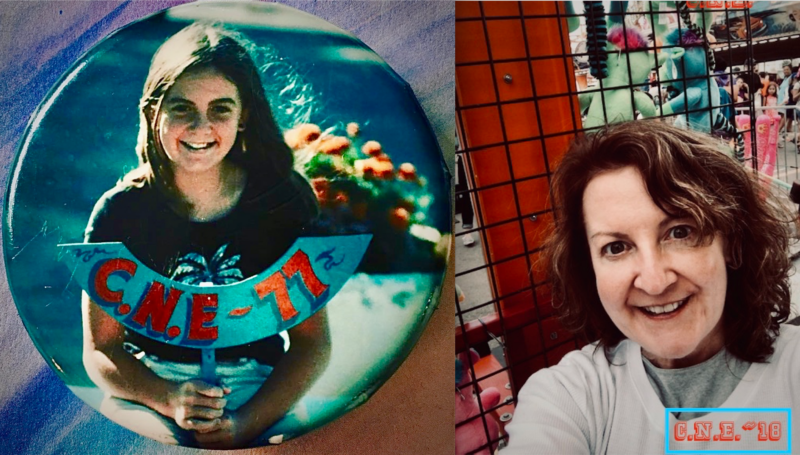
In the five months since most of the country went into collective lockdown, there have been countless memes and chin-stroking think pieces about the effect of COVID-19 on our perception of the passage of time. March went by in a millisecond, April lasted 1100 days and now, according to the Gregorian calendar at least, the end of summer is upon us. But how will we know the summer’s over if we can’t go to the Ex?
For as long as I can remember, going to the Canadian National Exhibition in Toronto has been a welcome but bittersweet segue between seasons. Even when I lived in New York, I’d factor the dates into my vacation calendar. It would never be the primary reason for a return visit to Toronto, but it never fell off the radar either. The CNE was something that kept me strangely anchored to “home.”
I’m sure most of us have a mental reel of Exhibition highlights. For me, it includes Holly Hobby doll prizes, huge boxes of Double Bubble gum (100 pieces at once!!) and the Polar Express guy who keeps asking if you want to go faster. And, of course, the thrill of discovery in the “oddities and novelty” factor—the invisible dog, Labatt Blue tube socks and, more recently, a larger-than-life sculpture of Justin Trudeau made entirely of butter.
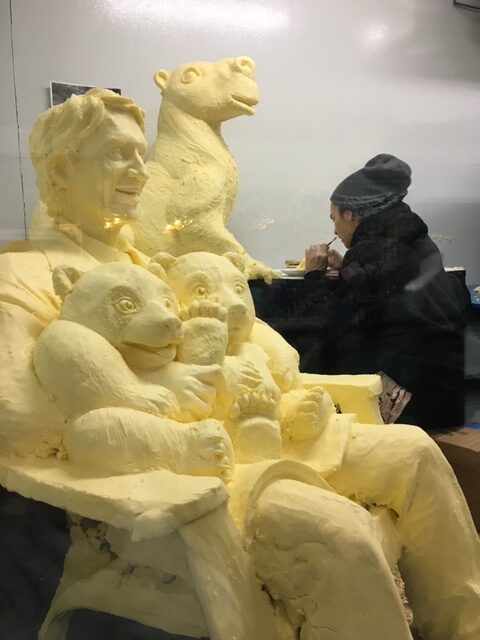
But when it comes down to it, the lure of the CNE (at least for me) was less about what actually happened there and more about the promise of one last chance to exhaust the potential of summer, complete with corn dogs and top hats emblazoned with glitter. A trip to the Ex offered an opportunity to embrace simple, silly pleasures and a brief distraction from the more serious business of “getting down to business” in the Fall.
COVID-19 has challenged us in unexpected ways. Among other things, it’s called us to be flexible, patient and quick to realign expectations to find the best path forward—arguably some of the same skills required to scale the shifting steps of the Fun House.
But as much as the virus has us taught us about masking, distancing and cleaning, it’s also given us the opportunity to be creative and impressively resilient. Not nearly as satisfying as corn dogs, but important to recognize nonetheless. Many of the usual milestones and markers that we’ve depended on to bridge transitions and provide a sense of renewal don’t work well in a time of social distance and sanitization.
So this year, we have to draw on lessons learned from CNEs past and COVID present. As we head into Fall, give yourself permission to embrace silly, simple pleasures and to delight in the smallest things. The gates of the CNE are temporarily closed but we can still make the trip.
(Contributor’s note: No invisible dogs were harmed in the making of this blog post.)
Read other InsightOut posts.
Anthony De Feo is the Programs Coordinator at the Faculty of Theology at the University of St. Michael’s College. He began his time with the Faculty of Theology back in November of 2019, taking over for Catherine Mulroney. He graduated with his Honours B.A. in Religious Studies and Italian from McMaster University and his Master of Divinity degree from USMC. He lives in Stoney Creek, ON with his wife, Cristina, and their three-year-old daughter, Catarina.
Rethinking How We Do Things
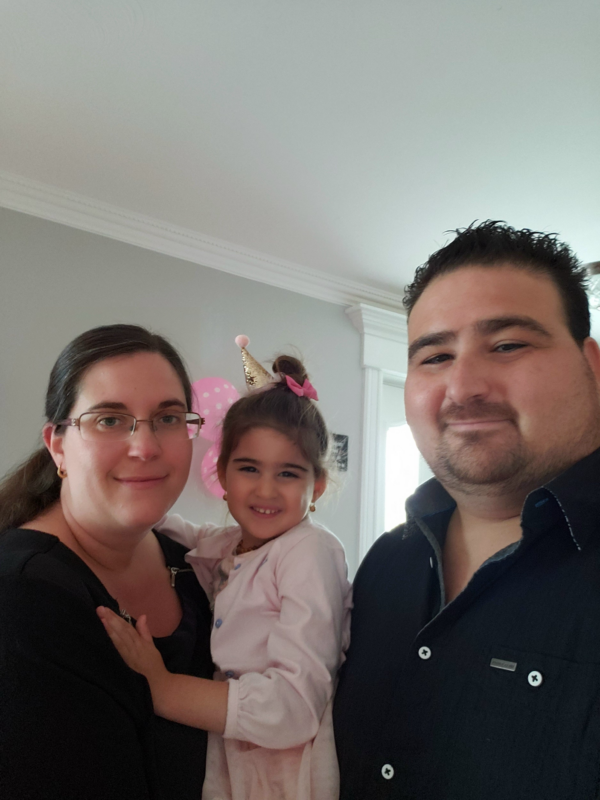
Five a.m. alarm clock: I sulkily hit the snooze button and slowly roll out of bed, ready to begin my journey to the office in Toronto. The train leaves promptly at 7:20 a.m. from Aldershot station, about a 20-minute drive from my house in Stoney Creek. To make it to the train on time so I am in the office by 9 a.m., I leave the house no later than 6:45, providing time for a proper parking spot and to load up my PRESTO before the train leaves. Shower, get dressed, eat a quick breakfast, and out the door I go; then on the train to Union Station, where the second “adventure” of getting onto the TTC awaits. I get off at Bay Station and hit the Tim’s on Wellesley to get my morning cup of coffee, then on my way to Alumni Hall. Emil is usually already hard at work, ready to greet me as I saunter past his office, stopping for a brief chat about the previous evenings’ Leafs game or how neither of our children slept the night. The day usually starts with checking the many emails that came in overnight, from students asking about information on their courses and reaffirmations that they are on the right track. Diana comes in not too long after, and the three of us chat a bit before getting “lost” in our work; though, before long one of us would usually ask “Is it lunch time yet?” as we couldn’t wait to go to our favourite lunch hot spot: EATALY! As you can imagine, the afternoons were a little harder to get through because of having eaten delicious food and especially after a bombolone (Italian doughnut). However, we got through the days easily with the help of student drop-ins, conversations with faculty, and many phone calls and emails being made.
Fast forward to mid-March. No longer being woken up by a 5 a.m. alarm to remind me I had to catch a train, the commute from Stoney Creek to Toronto turned into the commute from my bedroom to my “living room office.” No longer worried about getting on a crowded GO train or TTC subway. The worry now was whether my internet would hold up for the Zoom appointments I had that day; or whether my three-year-old would make an appearance at our Faculty Council meeting. Face-to-face conversations with students turned into many back-and-forth emails; morning conversations between colleagues turned into many WhatsApp messages and frantic Zoom meetings to talk about what had to be done that week. It very soon became “the norm” and we had to adapt quickly to our new circumstances. Course planning in the lounge turned into strings of emails between me and TST, making sure we had the right course information for the upcoming academic year. Zoom became a normal way of communication between me and our students, meeting to plan for what courses they had to take in the Fall and Winter. Since the COVID pandemic has caused many to re-think how we do things, we as a Faculty of Theology have decided to run our Fall courses remotely, not yet knowing what the Winter term will hold. The hope is that we can return to some in-class learning, but only time will tell. For now, we will continue to forge ahead and are planning a virtual Welcome Day, many Zoom liturgies to come, and a possible online Convocation.
Only a handful of times does my daughter want to know what “papa is doing,” or decides to peek her head into one of my student appointments. I have the benefit of not having to juggle working from home and taking care of my daughter at the same time because my wife has also been home since March; this has been a blessing in disguise. Though there have been challenges, it has been nice to be home with my family and be able to experience some of the things I would otherwise miss while away at work. We are lucky to be able to enjoy nice lunches together outside on our deck in the beautiful summer weather; It isn’t EATALY, but it is perfetto!
Read other InsightOut posts.
InsightOut: Connective Threads
Emma Hambly is a communications coordinator at the University of St. Michael’s College. She has a B.A. in English Literature and Classics from McGill University, and an M.A. in Literatures of Modernity from Ryerson University. In her spare time, she sews, makes collages, designs zines, writes comics, and looks for more hobbies.
Connective Threads

Push the needle through two layers of fabric, then loop the thread back through itself to make a neat little knot before continuing. It’s a motion I’ve done thousands of times. But during quarantine it’s taken on a new kind of meaning.
***
I’m lucky to be surrounded by very creative friends and family. It seems that most of them have taken the quarantine as an opportunity to take up old hobbies or delve further into their current projects.
One friend is writing again for the first time in years, and another is 52,000 words into her science-fiction novel. My mum is painting more frequently than she has since art school, and my dad is creating collages in the same sketchbook he left half-finished 20 years ago. My best friend is cross-stitching patterns with dainty florals and profanities. My partner is cooking and baking new recipes and continues to feed our temperamental sourdough starter.
As for me, I’ve been sewing. A lot.
Since quarantine started, I’ve been sewing gifts for friends and family and donations for strangers in need. I’ve hand-sewn 16 plushies, embroidered a beret, and made 60 face masks. Our small apartment is bursting at the seams with sewing supplies. My recent online purchases from small Canadian sellers include glass eyes, sheets of vegan leather, metallic felt, and a wonderfully soft faux fur called “minky.” Right now, I’m working on a little bird for my aunt’s birthday and a plague doctor doll because…well, I suppose that one doesn’t need an explanation.
There’s something enormously comforting about a simple task that gives you a sense of control during uncertain times. For me, sewing is a magical combination of enjoyable, relaxing, and creative, a form of self-expression that helps to counteract pandemic-era feelings of anxiety and powerlessness.
My mum, who is a talented seamstress, taught me how to hand-sew when I was six. And since then, the slow but sure process of turning a few pieces of fabric and some thread into a three-dimensional object with its own personality hasn’t stopped enchanting me.
Quarantine may be filled with necessary constraints, but it has let me pursue my hobby unrestricted.
In the earlier days of the pandemic, I volunteered for Stitch4Corona, an initiative organized by U of T Engineering students to provide fabric masks to Torontonians in need of them, like seniors and the unhoused. With access to a sewing machine and basic skills, it felt like the least I could do. When I was able to expand my social bubble to include my parents, my mum offered to help.
Sitting at the dining room table on a rainy day, listening to the whir of the sewing machine, took me back to my childhood, watching my mum make my Halloween costumes. Year after year, she would create an impeccable, real version of whatever I had dreamed up: a furry tarantula with eight interconnected arms, a red rose with my face peeking out of the petals.
This time, though, we were working together. I sewed the fabric into its basic mask shape and stitched in the elastics. My mum gave each rectangle three neat pleats, and I finished the sewing, adding in the nose wires and leaving pockets for filters.
We switched, laughing, when we realized she had accidentally pleated all the masks so far upside-down, and I was much slower at topstitching. We found our rhythm and spent the afternoon turning a pile of fabric sheets, elastic, and wire into a thick stack of masks.
Before I could start my third round of sewing, Stitch4Corona announced that with COVID cases decreasing in the city, they were wrapping up their initiative. In the end, more than 600 volunteers sewed more than 14,000 masks.
I turned back to my lifelong hobby, sewing by hand.
When quarantine started, I felt caught up in the need to do some small thing to let my loved ones know I was thinking of them. So, I bought two pattern collections (32 designs in total), sent the images around to my friends and family, and asked them to pick their favourites. I’m about a third of the way through the list.
I’m worried about my grandmother’s wellbeing and I haven’t been able to spend quality time with her in months, but I’m glad to know she keeps the little raccoon I made her right next to her computer. My friends’ faces lit up when they picked up their creations at our 6-feet-apart, masks-on barbecue.
It makes me happy to create something tangible for my friends and family when our connections these days are so digital. And I hope my silly plushies can bring them a smile in these strange, stressful days.
Time, effort, and connective threads. Put simply, sewing is the art of bringing things together. Sometimes, it can have that effect on people as well.
Read other InsightOut posts.
The University of St. Michael’s College is preparing for a gradual, safe return to campus guided by the advice of public health authorities, UofT processes and protocols outlined in UTogether 2020: A Roadmap for the University of Toronto and within the framework of the following principles:
1. St. Michael’s staff and faculty should work from home whenever possible, and campus offices will remain closed until further notice. Staff and faculty whose functions require their presence on campus will be provided approval by their department managers to work on campus based on capacity, need, public safety guidelines, and UofT policy.
2. Deans, directors and department managers (or their designates) are responsible for ensuring their staff and work spaces align with COVID-related protocols. This includes:
- providing approval for, and tracking, employees and faculty who come into the office and coordinating efforts to ensure safety in spaces be shared by multiple departments
- contacting Facilities to request replenishing of PPE and sanitization materials as required
- following UofT protocols should one of their employees/faculty be diagnosed with COVID-19
3. St. Michael’s, like all UofT campuses, will follow the University of Toronto Policy on Non-Medical Masks or Face Coverings and draft guidelines. To support UofTs policy on non-medical masks, St. Michael’s will provide staff, faculty and students with two reusable, non-medical masks. St. Michael’s department managers will provide their employees with their two reusable, non-medical masks. St. Michael’s employees will be responsible for cleaning their own masks, and providing their own face coverings if these are lost.
As the fall semester approaches, the University of St. Michael’s College is implementing cutting-edge measures—including some from front-line health care settings—to keep the campus safe for community members and visitors.
“Safety is of foremost importance when considering reopening—not just for staff and students, but for everyone that has access to USMC,” says Michael Chow, Director of Facilities and Services at St. Mike’s. Following public health guidelines and the University of Toronto, Chow and his team have implemented measures ranging from extensive cleaning strategies to high-tech virus-killing devices. The measures fall into three main categories: facilities, administrative measures, and personal protective equipment (PPE).
Facilities
Visitors to campus will notice a variety of newly installed safety measures this fall, including Plexiglass shields at key points including the Porter’s Desk, Registrar’s Office, and other areas where queues could create challenges for physical distancing. Classrooms and common areas will have less furniture and reduced capacities in order to make it easier for an appropriate distance to be maintained, and signage and stickers will help direct pedestrian traffic to keep people moving efficiently and safely through indoor spaces.
HVAC equipment will receive increased–efficiency filters wherever possible, as well as a more rigorous filter replacement schedule to ensure clean air throughout campus buildings. Twenty-five free-standing hand-sanitizer stations have been installed next to building entrances, high-traffic areas and entrances to larger classrooms, and wipe or spray disinfectants will be available for students to quickly clean off a desk or chair before they use it, as well. All washrooms are now stocked with paper towels, and Legionella testing has identified no issues with water on campus.
Administrative
“I think the most important change is about our cleaning strategies, for both common spaces and student spaces,” Chow says. In line with UofT’s tri-campus cleaning protocols, St. Mike’s will conduct enhanced cleaning throughout all building spaces and student areas while also adding “a dedicated team of cleaners to do disinfecting and increase cleaning in high-touch areas—a minimum of twice a day for high-touch surfaces.” Routine cleaning during normal workday hours as well as on nights and weekends will be enhanced through the use of new cleaning agents, which have been upgraded to a dual-purpose cleaner that both cleans and disinfects.
Hard at work keeping campus safe since the pandemic began, the Facilities and Housekeeping teams is going into the fall semester with new, high-tech tools. Chow says that his team adopted some of these after first seeing them used in hospital and long-term-care settings—the front lines in the fight against the virus.
These tools include a stand–alone UV light system, which staff are using to disinfect all residence rooms before new students move into them in September. The portable UV system is also intended for use in classrooms. A hospital-grade portable disinfectant misting system will also be employed on an as-needed basis, helping to disinfect places that are hard to reach using normal cleaning methods.
PPE
All Facilities & Services staff members have worn either reusable or disposable masks during their work since the pandemic began, with many of those coming from a generous donation of 2000 masks by a St. Michael’s student in May. Now, as some staff and faculty return to campus this fall, two reusable masks will be provided to every student and employee. St. Michael’s will follow the University of Toronto and the City of Toronto in requiring non-medical masks or face coverings to be worn inside buildings that are normally publicly accessible.
Anyone without one will be able to receive a single-use mask at the Porter’s Desk, ensuring that all outside visitors and contractors will also be able to have access to masks while on the USMC campus. Signage posted throughout campus will provide visitors and community members with reminders of proper mask usage as well as principles of handwashing, correct hand sanitizer usage, and other important safety principles.
Behind all the safety measures being implemented on campus, Chow says, are the members of the Facilities and Housekeeping teams, whose tireless efforts have kept students, employees, and visitors safe throughout the pandemic. As he wrote for InsightOut, “Behind the scenes—and often unnoticed—the F&H staff have faced the challenges of the pandemic as essential staff and turned them into opportunities as guardians for the university.”
“I think we’re doing something right,” Chow says. While the safety measures will help keep the St. Michael’s campus safe this fall, he notes, it’s almost just as important to communicate the changes to the campus community “to put everyone’s minds at ease.
“We’re not just sending everyone back to the same university they left,” he says.
Consult Fall 2020 for current updates on St. Michael’s plans for the fall semester.
Fr. Alexander Laschuk, PhD is a priest of the Ukrainian Catholic Eparchy of Toronto. He is currently the Interim Executive Director of the Metropolitan Andrey Sheptytsky Institute in the Faculty of Theology, in addition to his responsibility as Judicial Vicar of the Toronto Regional Tribunal. He lives in Trinity-Bellwoods with his wife and daughter.
Finding Stillness in Chaos
I am a Catholic priest. Unlike most you know, I am married and have a six-year-old daughter (with number two on the way). Also unlike most priests you know, I do not spend much of my ministry in a parish. Instead, I live my priestly ministry in the curia, where I work as a canon lawyer. There are seven dioceses in Ontario for which I am responsible. Additionally, I seem to have a specific skill set—I fix problems. Sometimes those problems are in my own Eparchy, which extends from the Ontario border to the Atlantic. At other times my service is to the universal Church, which brings me to dioceses throughout the English-speaking world. My ministry means I am frequently away from home, which can add up to two or even three months in a year.
This all came to a crashing, screeching halt in March. I remember my last day in the office with my staff—we already were encouraging people to work from home. It was the feast of St. Joseph and there were zeppole on my desk. The State of Emergency was declared shortly thereafter, and we all began a brave new adventure.
In my case, this has meant being physically grounded—a real blessing in some ways as now I am home every day to put my daughter to bed. But it has also been chaos. When the Archdiocese moved to “remote work” except for essential staff it meant that in addition to my own job I suddenly had to keep 26 people busy. We were in the midst of opening a new tribunal office in the suburbs to remove the “physical distance” that, Pope Francis reminds us, prevents people from accessing the tribunal.
In our small Ukrainian Eparchy many parishes needed help applying for government support; I became the go-to guy with all these acronyms that soon became all too familiar: ROE, CERB, CEWS, and CEBA. At our parish in Trinity-Bellwoods, instead of hearing Easter confessions I became a videographer and learned far too much about live-streaming, while at my daughter’s school, the online class sessions every morning and afternoon became the anchor of her (and our) day. I realized how lucky we were when I spoke to other kindergarten parents whose children would only have one (or no) session a week.
My wife, who suffers from difficult pregnancies, was often bed- or couch-ridden and was, as I termed her, a “quarantine professional” who never left the apartment except for medical appointments. The usual downtown comfort of the constant hum of people and traffic turned into silence, and often the only sounds were screams in the night from the growing number of people on the street and in the park with nowhere else to go. As bedtime not so quickly approached for my daughter, there would be the silent prayer to God: just one more hour, Lord. Get us there, peacefully if possible. When she’d finally go down it would be frantic work until I fell asleep to catch up on all those things left behind in the workday.
More than four months have passed. The world is awakening from its pandemic-induced slumber. We have set up a chapel in the parish archives where I celebrate mass with my wife and daughter. For my daughter’s sixth birthday we ran around individual cakes for her party on Zoom. We’re getting really good at making dinner as a family instead of constantly eating out. I’ve started a new job as Interim Executive Director at the Metropolitan Andrey Sheptytsky Institute here at USMC. I can’t go into my office at Windle House and my predecessor can’t move out. I’ve not been on an airplane in six months. Our new home has been delayed nearly a year. The parish has spent thousands on PPE. I overhear my daughter giving her friends Zoom advice. My car dashboard is covered in blue masks. My wife rejoices that we’ve almost run out of hotel shampoo.
This time has left me frequently thinking of Elijah, who we call Elias in the East. When he went to find the Lord God, the Voice was not in the earthquake, nor the fire, but in the light breeze (3 Kings 19). Here, in the unnatural silence of abandoned downtown, the Voice of God blows with the breeze across the abandoned storefronts and the tents in the park. I hope we can all find a moment to stop and hear it, finding stillness in this time of chaos.
Read other InsightOut posts.
Martyn Jones is a content specialist in the Office of Communications. On a freelance basis, he also writes reported features, essays, and criticism for online and print outlets. Martyn and his wife Melanie’s toddler, Fox Jonathan Jones, turns 18 months old on August 2.
The Difference Three Hours Makes
In the endless domestic present brought on by COVID-19, I sometimes find it difficult to remember that going to work once meant going in to work.
A few months ago, my wife and I would kiss our toddler goodbye, trudge through the snow to a bus stop, and wait to be carried into the city alongside thousands of fellow close-breathing commuters. It was far darker then, and both our bedtimes and alarms were earlier. In the mornings we’d wake the baby around 6:30 a.m., pass him back and forth to allow one another to get dressed and brush our teeth, and then hand him off to his grandparents around 8 a.m. for safekeeping for the day as we began our commute.
During my wife’s maternity leave, I would often look down from my computer screen in my office to find a message from her that included a photo or video. These were digital records of Fox’s progress: first words, first steps, first instances of bizarre behaviours that would become characteristic. When my wife returned to work, she would forward similar notes from her parents containing records of Fox’s new experiences that we were both missing.
After work, we’d get home around 6 p.m., scramble to put Fox’s dinner together, play with him if time allowed, and put him to bed by 7:30. Our total allotment of time with the boy was about three hours a day—most of it spent performing necessary tasks, and relatively little spent in reading, play, or exploration.
When remote work began for both of us in mid-March, we entered into a family bubble arrangement with my wife’s parents, who continued to provide our toddler’s primary care during the workday. For the last several months, we’ve worked with Fox always within hearing distance, either downstairs in our own home or in another room at his grandparents’ house.
We are incredibly fortunate to be able to rely on our toddler’s grandparents in this way. For so many younger families, the closure of childcare centres and schools forced parents to look after their children while also continuing to work full time. We were shielded from this grueling scenario. For us, the silver lining has made up almost the entire cloud.
Atul Gawande notes in his book Being Mortal that one of the major domestic shifts brought about by modernization is the move away from multigenerational homes. The past few months have given us glimpses of that abandoned paradigm: during a break between tasks, I can join Fox at the keyboard where his grandpa is preventing him from striking the keys too hard, or peel an orange while listening to the toddler perform his mimicry of reading out loud for his delighted grandma.
He is a wild and energetic boy; his arms already have a shape that evokes the naturally athletic teenager, and as they grow will gain mass while retaining their rough proportions. He occasionally gets away from his grandparents and pounds on our office door until it opens for him, at which point he might walk to my desk, look at me silently, throw back his head, and laugh. While he’s interrupted his share of Teams meetings, my colleagues reassure me that his presence has always been welcome.
I have no truck with vulgar permutations of utilitarianism, the worst of which employ an actual calculus to determine the moral worth of an action, but I do find it useful to put a number to our experience: 270. This is a rough estimate of the number of hours my wife and I have gained back to spend with our boy during the portions of the day we would otherwise have spent commuting or having lunch at work. Our three-hour allotment has doubled for each workday, without even taking into account the random visits he pays us as we hunch over our computers.
Instead of receiving photos or videos through text or email, my mother-in-law can simply call me to come down, and I can be there to see my boy build a block tower or put on his own shoes. We haven’t yet reached the point at which his long-term memories are able to take root in his mind, but I hope that he will carry this period of special nearness into the later parts of his childhood, and know without knowing that we were close by.
For all the uncertainty and hardship brought on by the pandemic, COVID-19 has also shown us how flexible the world can be when the heat of necessity causes it to bend. There will not be a return to an earlier status quo after the virus subsides or vaccines are developed: instead, a new world will emerge. I hope that our new arrangements will make future virtues of past necessities, and that it will be possible for more working parents to experience the difference three hours makes.
Read other InsightOut posts.
Dr. John L. McLaughlin, Interim Dean of the Faculty of Theology, is pleased to announce that Dr. Hilda P. Koster will be joining the Faculty of Theology as an associate professor in Ecotheology. Dr. Koster comes to St. Michael’s from Minnesota’s Concordia College, where she held joint appointments in Religion, Gender Studies and Environmental Studies.
“The addition of Dr. Koster to our Faculty underscores the importance of both ecological and feminist theology to the University of St. Michael’s College,” says Dr. McLaughlin. “She will carry forward the groundbreaking teaching and research of eco-theologians Fr. Stephen Dunn and Dr. Dennis O’Hara, as well as the important work in feminist theology conducted by professors such as Sr. Ellen Leonard and Sr. Mary Ellen Sheehan.”
Dr. Koster will teach courses for the Faculty’s three basic degree programs—the Master of Theological Studies, the Master of Divinity and the Master of Religion Education degrees—as well as teach and supervise graduate students through the Graduate Centre in the Toronto School of Theology. In the 2020-2021 academic year her courses will include Introduction to EcoTheology, Catholic Social Teaching, and a new course titled Ecofeminism, New Materialism and Ecological Theology.
She will also help shape the activities and certificate program of the Faculty’s Elliott Allen Institute of Theology and Ecology (EAITE), which was established in 1991 to allow students to acquire a specialization in theology and ecology.
“The University of St. Michael’s College has been a leader in ecological theology through the Elliott Allen Institute. It is a privilege and an honour to further this tradition of visionary ecotheological education and scholarship,” says Dr. Koster. “My own work in ecological theology is done from an eco-feminist perspective. To me environmental and gender justice are interconnected.”
Born in The Netherlands, Dr. Koster received her Bachelor of Arts and Master of Divinity degrees from The University of Groningen. After further study at Princeton Theological Seminary and the Candler School of Theology at Emory University in Atlanta, she earned her doctorate at the University of Chicago.
Dr. Koster has published articles and book chapters on eco-feminist theology, and edited two books on Theology and Climate Change. The book Planetary Solidarity: Global Women’s Voices on Christian Theology and Climate Justice (Fortress, 2017), co-edited with Grace Ji-Sun Kim, gathers eco-feminist theological reflections on the intersection of gender and climate justice by feminist/womanist/mujerista theologians from both the minority and majority world. Together with Ernst Conradie, she published the T&T Handbook of Christian Theology and Climate Change (Bloomsbury, 2019) to create a dialogue between religion scholars, ethicists and theologians situated within a high carbon footprint context and those representing climate vulnerable communities in low carbon footprint world.
St. Michael’s unique community owes much to the people who have worked at the College and contributed to its culture over many years. Employees who this year celebrate work anniversaries ranging from 5 to 30 years were honoured by the College with service awards.
Many of those honoured this year belong to Facilities & Services and the physical plant, including Steve Craig (10 years), Isabel Louro (15 years), and Irene Wiseman (15 years). These departments were among the few that remained largely on campus over the summer to provide essential services, focusing on health and safety.
Members of the Office of the Principal and the Registrar’s Office include Jean Talman and Guillermo Mejia (both 30 years), representing decades of faithful service to St. Michael’s students in sorting out everything from questions about program requirements to the logistics of convocation. Given the Office of the Registrar’s fast transition to remote service delivery in response to COVID, it remains possible for even a veteran of 30 years in the department to experience something new at work.
The list of honorees also includes admired professors such as Christianity and Culture’s Michael O’Connor (15 years), esteemed members of the Kelly Library such as Remi Pulwer (15 years), and staff and faculty from still other departments whose work continues to strengthen the bonds of St. Michael’s community even in a time of physical isolation.
In addition to these figures who continue to serve, St. Michael’s also honours two members of the community who have concluded their work for the school. Fr. Peter Galadza retired from his position as Director of the Sheptytsky Institute of Eastern Christian Studies this summer. In addition to decades of teaching and research at the institute, he oversaw its transition to St. Michael’s from St. Paul’s in Ottawa. Debra Matthews in the Office of the President concluded her career at St. Michael’s this year as well after providing direct support to three presidents during her tenure. She has retired in order to spend time with another community: that of her children and grandchildren. St. Michael’s wishes both Fr. Peter and Debra all the best in their next chapters.
Noel McFerran has worked as a librarian at the University of St. Michael’s College since 1998. His current position is Theology and Rare Books Librarian.
“Be Right Back!”
I spent last Wednesday morning in the Kelly Library providing curbside pickup service to faculty and students. As a librarian, it was exciting for me to see the library taking further steps to provide library materials to patrons while maintaining the health and safety of everybody involved.
Since mid-March I’ve been working from home, keeping very busy responding to emails from faculty and students about their course work and research. Wednesday was one of my first times back inside the Kelly Library. The most important thing was to be trained in how to function in my regular work environment during a pandemic. I thought that I knew all about social distancing, wearing masks, and sanitizing hands—but it’s so much more important in a workplace where there are other staff using the same desk and equipment. Just like in the supermarket, we’re maintaining a one-way route in the library in order to reduce face-to-face encounters between staff.
Every day the Kelly Library receives a computer-generated list of books and DVDs which patrons have requested through the UofT Library Catalogue. One staff person looks for these items on the shelves. Most items are where they are meant to be, but occasionally we have to search for something which has wandered from its regular home. Items then get checked out to patrons. Right now all items are signed out until September 18, 2020.
Another Kelly staff person, working from home, sends personalized emails to patrons telling them that their books are ready to pick up. Sometimes patrons respond with special requests (e.g. “Can a friend get my books for me?”).
At present patrons can pick up their requested items at the Kelly Library anytime Monday to Friday between 9:00 a.m. and 4:00 p.m. The pick-ups ebb and flow. I filled the low periods with other library work to keep myself busy.
The first encounter between a library patron and staff is through a glass wall where the patron shows their library card. (I had real difficulty reading the card through the glass, so I might need to make an appointment for an eye exam!) You can’t really hear people on the other side of the glass, so we have various printed signs which communicate the most frequent things (like “Be right back”).
Staff retrieve the patron’s bag of books and place it on a table outside the library under the overhang. Even then there is reduced interaction between staff and patrons. Smiling doesn’t mean so much when you’re wearing a mask, so I tried to wave in a friendly way.
The response from faculty and students to the Kelly Library’s curbside pickup service has been very positive. My colleague Risa de Rege, who has worked many shifts in the past week tells me, “People have been very grateful that we’re offering curbside pickups, and are also respectful of our space and policies.” In the first week, 76 patrons submitted requests for 141 items. As more people learn about the service and how easy it is to use, that number is likely to increase. So far, though, we’ve been able to respond quickly to requests.
Nobody wants the COVID pandemic to go on any longer than it has to. But for the present and near-future, the Kelly Library is developing solutions to continue to provide library service to our faculty and students. I love being a part of that, knowing that my work contributes in a small way to the academic success of others.
Read other InsightOut posts.
The Metropolitan Andrey Sheptytsky Institute (MASI) heads into the 2020-2021 academic year with new leadership and a new faculty position in Patristics.
Fr. Alexander M. Laschuk has been named Interim Executive Director of MASI following the retirement of Fr. Peter Galadza on June 30 of this year. Fr. Laschuk is a priest of the Ukrainian Catholic Eparchy of Toronto and Eastern Canada, and serves in numerous ministries, including as Judicial Vicar of Toronto’s marriage tribunal. Until recently, he was also economos, or finance officer, of the Eparchy of Toronto and Eastern Canada. Fr. Laschuk has civil and ecclesiastical doctorates in canon law from Saint Paul University and the University of Ottawa. His research interests include ecclesiology, penal law, and procedural law and he regularly publishes in these areas in addition to canonical consultancy and advocacy work with dioceses and clients across North America.
Fr. Laschuk has regularly taught with the Sheptytsky Institute since 2010, and continues to teach in the Faculty of Canon Law at Saint Paul University, Ottawa, where he served as Interim Director of the Sheptytsky Institute in 2013-2014.
Dr. Sean Argondizza-Moberg has joined MASI on a one-year Contractually Limited Term Appointment as an Assistant Professor in Greek Patristics. Specializing in Christian asceticism in late antiquity, Dr. Argondizza-Moberg earned his doctorate at Catholic University of America’s Center for the Study of Early Christianity. The position, located within the Sheptytsky Institute, is renewable to a maximum of three years. Dr. Argondizza-Moberg is currently working on a book on monasticism and classical culture.
“We are delighted to have both Fr. Laschuk and Dr. Argondizza-Moberg joining us,” says Dr. John L. McLaughlin, Interim Dean of the Faculty of Theology. “Fr. Laschuk is a skilled academic who will offer strong leadership at MASI as it looks toward the future, while Dr. Argondizza-Moberg’s work in Patristics will strengthen our offerings to students in this key field.”
The Sheptytsky Institute is an autonomous academic unit of the Faculty of Theology of the University of St. Michael’s College (USMC) in the University of Toronto (U of T). It specializes in Eastern Christian Studies, including the theology, spirituality, liturgy, history, and ecclesial polity of the Eastern Christian Churches, both Orthodox and Catholic. MASI students specialize in Eastern Christian studies within the basic-degree and graduate degree programs of St. Michael’s College. All degrees are conjointly conferred by St. Michael’s College and the University of Toronto.
Emily VanBerkum (USMC MDiv 2015) is the Dean of Student Residence at Loretto College, and John Paul Farahat (UofT DMA 2019) is Director of Music and Principal Organist of Saint Basil’s Church.
Enjoying Life’s Quiet Moments
“How many times have you noticed that it’s the little quiet moments in the midst of life that seem to give the rest extra-special meaning?” — Fred Rogers
The story of the proposal is really a two-part saga. Last year around this time, we were vacationing in Chamonix, France. Standing at the base of Mont Blanc, eyes gazing up at the breathtaking alpine landscape with gelato and marzipan cookies in hand, we considered ourselves incredibly grateful.
Unbeknownst to one of us, an engagement ring had been discreetly tucked away in our luggage for a surprise proposal in the Alps. But that carefully chosen landscape would fall through following an ill-timed fall down an old stone church staircase moments before that destined date-night dinner. Instead of a picturesque engagement ring reveal in a historic gazebo on a crisp late summer night under a sky of twinkling stars…a torn ligament, a pair of crutches, and a wheelchair ride through the Geneva airport.
One month later—ankle reasonably healed—we took a relaxed evening stroll along Toronto’s Queen’s Quay. Nearing sunset, on an ordinary park bench looking out to the calm waters, a proposal happened at last. A wild success: two elated smiles (and no torn ligaments). It was a perfectly tranquil, joyful moment. We laughed at the story of the-Chamonix-proposal-that-almost-was, and exclaimed to each other that 2020 was the year to be married—a year of perfect balance and harmony. We unhesitatingly chose Saint Basil’s, a parish to which we have both happily belonged since our student days, and set a date for September, 2020.
Much has changed in the world since we made initial arrangements. While our 2019 selves were focused on venues, vendors, realizing the “wedding vision,” and planning for out-of-country family members to attend, our 2020 selves have been more concerned with health, safety, and grappling with our new reality.
Our new central question was shared with many others: do we go ahead with the wedding, or do we postpone?
Our engagement story provided us with a providential lesson. The elaborate getaway proposal in Chamonix—with bells, whistles, and grand gestures—was replaced with a quiet proposal close to home, with only the most essential elements: the two of us, the “big question,” and a whole-hearted promise to spend our lives together. Indeed, the most though-out plans do not always go according to plan. Often, it is the beauty of the “quiet” moments that we cherish so deeply. It’s these instances that capture a moment in time, leaving an indelible mark on our minds and hearts.
Therefore, we have decided to move ahead with the originally scheduled date.
Establishing a sacramental union in Saint Basil’s, even without the larger guest count, elaborate reception, or flourishes that we had originally imagined, allows us to be true to what is most foundational: that marriage is a vocation in which the couple is drawn together for a purpose greater than themselves. Just like the proposal, our wedding day will be a reminder to find joy and contentment in the quiet, less elaborately planned moments of our married lives.
The beginning of our married life, surrounded by a small gathering of immediate family, will be at the forefront of our special day. And while we know the wedding day doesn’t make the marriage, in the end, perhaps the apparent “quietness” of the day will be everything we didn’t know we needed.
Read other InsightOut posts.
Catherine Mulroney is a communications officer at the University of St. Michael’s College. She is also a double alumna of St. Mike’s, holding a B.A. in English and Mediaeval Studies and a Master of Divinity degree. That equals many hours in Kelly Library and many, many overdue fines.
Raising Our Voices
It began—as many of the best things do—with someone volunteering an absent colleague for a little extra work.
Our new St. Mike’s blog, InsightOut, is the result of an after-hours conversation with Communications Director Laurie Morris and Theology prof Dr. Darren Dias on March 16, the last day we were all present on campus. Dr. Dias mentioned that his colleague, Dr. Michael Attridge, was self-quarantining at home after a research trip to Italy.
“It’s a good story,” Fr. Darren said. “You should ask Mike to write something for the website.”
Then the wheels began to turn. While not one of us could predict just how the comings weeks and months would play out, we knew we were facing an extraordinary moment in the university’s history. There would be value, we thought, in hearing each other’s experiences in, and thoughts about, living through such a momentous period.
Four months later, we now have a pattern established of InsightOut blog posts running on the St. Mike’s home page every Monday and Thursday. Each story, each opinion, is unique. And as the person privileged with soliciting and receiving submissions, I am humbled by the chance to be part of the process.
Graduate student Fr. Gustave Noel Ineza, O.P., for example, spoke about his childhood during the Rwandan genocide and urged us not forget the suffering of the broader world as we focus on local troubles.
Alumnus Dr. Christopher De Bono,Vice President of Mission, People and Ethics at Vancouver’s Providence Health Care, wrote about how moving he found his neighbours’ nightly ritual of banging pots and pans and making noise to celebrate the dedication of health care workers.
Interim Principal Dr. Mark McGowan, meanwhile, a professor of History and Celtic Studies, submitted a video explaining the typhus epidemic of 1847 in light of the current situation.
Professors have written about what their subject areas tell them about the pandemic, while students have talked what St. Mike’s means to them. And alumni members like Patricia Dal Ben, along with her colleague John Kostoff, a member of St. Michael’s Collegium, offered their professional wisdom on how families can keep a faith life alive when unable to get to Mass.
Some people have shyly offered to submit while others, when approached with a specific topic, agree with grudging good humour.
Coming posts will touch on the reality of working from home as a parent, how we are preparing for the coming academic year, and even how to get married during a pandemic. Pieces have ranged from moving to amusing.
Anyone who has worked through these past months will have experienced their colleagues in new ways. Zoom meetings reveal family photos or a glimpse of a partner or pet. A phone call might be interrupted by a delivery person at the door of what has become a home office.
For those of us working at St. Mike’s, the blog has taught us about family, we’ve heard admissions from those who miss their colleagues, we now know about our officemates’ hobbies, and we have gained insight into who we are as a community and what makes us unique. When we are at our best, it seems, we are closer to being family than colleagues.
But lest this sound like busy work or a grand vanity project, it’s anything but. While we’ve gained insight into our colleagues, the blog’s purpose is very much outreach. Having worked on planning various campus events, I know how people look to St. Mike’s to keep them engaged with the world and continuing on a path of lifelong learning. And if we can’t do that in person, some reflections and mini-online lectures are a sound alternative.
Parents of future students may come away from this blog reassured that not only are the people who’ll be working with their children skilled, capable professionals, they are also decent and caring people.
Future students can read the blog and find out some of the cool work happening on campus, and look forward to engaging in the kinds of discussions that make university a once-in-a-lifetime experience.
And alumni can engage with InsightOut and know that their alma mater remains vibrant and in good hands.
One of the great ironies of this time of masks and social distancing is that through it we have been brought closer together. We now know more about each other and, more often than not, knowledge brings with it respect. We have learned to work together in new ways and have seen the value in teamwork.
As we approach the fall, this blog will begin to pivot toward other aspects of life at St. Mike’s, looking ahead to a time when we can put the pandemic behind us.
If you are connected with St. Mike’s and would like to participate in InsightOut, please send me an email to chat about a submission.
Having heard the stories of the St. Mike’s community, I am confident we will head into the fall ready to take on pretty much anything. As the hashtag says, we really are all in this together.
Read other InsightOut posts.
Giancarlo Mazzanti is the Registrar and Director of Student Services at the University of St. Michael’s College. Giancarlo is a graduate of the University of Toronto (St. Mike’s) with an Honours B.A. in Political Science, and a B. Ed. from the Faculty of Education in 1985. He began his career in education at St. Michael’s College School and has worked in student services for over 30 years.
Our Connection Is Just Fine
It’s not like rumours weren’t swirling about a possible move to a primarily online mode of delivering the services of the Registrar’s Office and related Student Services. So it was with the better judgment of our team that we began preparations for what was beginning to look like the inevitable. It seemed like no time at all passed from those water cooler conversations with colleagues within the university community to when the email arrived from the Office of the President telling us that our offices were closing to in-person services. Academic advising meetings, learning strategist sessions, wellness appointments, and every other function and/or service would need to go online.
We received the call on the afternoon of March 17. Within minutes, Morteza was making sure e-tokens were good to go and that college staff in the various university offices were able to log in from home. Most were taken care of, but there were still a few to activate: no problem. Miranda, with Guillermo’s and Philip’s help, was making certain all students on the day’s docket were either seen or given a new appointment, all while planning for graduation scholarships and any number of the other responsibilities within our office. Nawang was ensuring that bursaries were going to get into students’ hands… yesterday! Next was getting ready for the hundreds of financial aid requests that would be submitted by our students, as well as the upcoming round of May admissions. Stephen was finalizing plans on how we were going to meet with future applicants, remotely, all while he and his wife were getting ready to deliver a future SMC student. Judy and Alex? Well, the newest members of our office were getting ready for the onslaught of student advising appointments which would fall on their shoulders as the various portfolios were being tended to. Hundreds of emails daily! Then, as the day turned into evening we packed our favourite mugs and our laptops and, with e-tokens in hand, we went home to our new offices!
All were confident as we prepared for remote delivery, even though the occasional nervous giggle could be heard. Gone were the commutes, the traffic, and the aggressive drivers. So was that horribly conspicuous dash to the only open seat on the train; everyone knows when you have designs on a seat in a subway train at 8:15 in the morning! Now it was simply a 12-second climb to the second-floor office, right next to the bathroom, and with a lovely view of the garden.
And so it was that practically overnight all university operations moved online, except for the staff in finance, the residence operation, and building services. They were our “hyflex” model pioneers. They were toughing it out on campus to make sure that USMC kept functioning and that students unable to get home had a room on campus, and that it was a safe space. The I.T. department stood on its collective head to make sure we had the hardware, software and in-servicing on the technology we had all dabbled in but which was not yet part of the daily menu. All of a sudden, Teams and Zoom were the plat du jour! And of course, the Communications team made sure there was an uninterrupted flow of information, essential to all parts of the community.
By the end of Day One of working from the home office, in whichever corner of the house we were assigned—or had earned over many years of squatting—many of the bugs had been worked out. It was quickly becoming business as usual for most, with the rest not far behind. Professionals who were accustomed to meeting in person were now looking at a screen with nothing more than a student’s initials in a small circle. Whether discussing course selection, scholarships, or convocation, all meetings were now being conducted via telephone or in a Teams meeting. Different delivery models, same great advice and suggestions.
And how appreciative our students were during those early days of the new, even if only temporary, normal! Every email or call we received began with “sorry to bother you during this very busy time,” and was often followed up with a lovely thank-you note.
Today, after hundreds of Teams or Zoom advising meetings, thousands of emails, dozens of website updates, countless online lectures and tutorials, governance meetings, a virtual Welcome Day for newly admitted students, two new Quercus courses to help transition our class of 2024, and hundreds of thousands of dollars in emergency financial aid to our students, it dawned on me. I confirmed for myself what I knew all along. The people! That is the ingredient that is making all the difference.
The people I met on campus were important to me during my undergrad years, decades ago, and I understand far more clearly how important that is today: the staff, faculty, and students of the university. In these “interesting” times, we know we can rely on each other. Whether teaching or making sure we are well positioned to tackle the financial pressures of the coming year or helping a student find a course that will fill a final breadth requirement, we know each member of our community continues to do their utmost to make things work for our students—and for each other. I am confident that is why we were all drawn to this place, our community. That is why we will be ready for the coming year. Yes, a simple electronic screen will not get in the way. Our connection in just fine.
Read other InsightOut posts.
Kelly Library patrons can once again hold physical books from the collection in their hands through a new curbside pickup service.
To support the community’s access to materials while also following public health guidelines, library staff can now accept requests from any patron with a valid UTORid through the UTL catalogue for select physical items in the collection that are not held in the Hathitrust Digital Library. These items are then made available for pickup in a safe and appropriately distanced manner.
“Curbside pickup of materials is an exciting move toward reinstatement of our services and in our ongoing effort to support students and faculty,” Chief Librarian Sheril Hook says. “As we launch and evolve the service, the health and safety of our community is a top priority, with safety precautions implemented at each step of the borrowing process, following guidelines outlined by the University of Toronto Libraries and Toronto’s public health authorities.”
After they receive a pickup notice from library staff, patrons can visit to pick up materials between 9 a.m. and 4 p.m. Monday to Friday in front of the library. Visitors using the service will queue in a waiting area and then proceed to approach the window near the book return slot under the awning of the library, and boxes marked with tape on the ground will indicate where patrons should wait in order to maintain a safe physical distance. The library will not be open to visitors indoors, and all pickups will be handled outside. Patrons who cannot come in person can place a note in the catalogue request for their friends or family members to pick up materials for them.
The service makes available materials that have otherwise been inaccessible to patrons in any format during the pandemic. In addition to the physical items now available for curbside pickup, patrons can request a PDF scan of a single book chapter or journal article from the library’s circulating collection not available through Hathitrust. Physical items being lent out will be due back by August 31, 2020, although this date may be updated as plans continue to change during closures.
The Kelly Library has made available full instructions for using the service, including health and safety guidelines and FAQs.
Jean-Olivier Richard is Assistant Professor, Teaching Stream, in the Christianity and Culture Program. A historian of science by training, his research and teaching interests include the relationship natural philosophy with Christianity with science in the early modern era, Jesuit history, environmental history, and the history of alchemy, astrology, and magic.
Night Sky and Quietude
On June 17, I decided to set up a tent in the backyard of my partner’s parents, thereby adding a room to what was beginning to feel like a crowded house. My girlfriend and I brought mattresses, pillows, sleeping bags, and munchies. I also decided to install my Meade ETX 90, a reflecting telescope I had purchased a couple years ago and neglected to use since. I figured that on a clear night in Ottawa’s suburbs, it would find better use than in dazzling Toronto.
Around 3 a.m., we woke up to a starry sky, with Vega and Arcturus above our heads and a handful of planets lined up within the narrow band of the Zodiac. In the south, majestic Jupiter lorded at its zenith in conjunction with Saturn. Red Mars was lagging further to the East, next to Neptune, invisible. The waning crescent Moon, with Venus by its side, had yet to rise. Over the next two hours, we turned the telescope to each of these celestial bodies, trying different lenses and observing with childlike excitement. My girlfriend saw, for the first time, Jupiter’s four largest satellites—the same Galileo discovered with his spyglass in 1610—as well as hints of the giant’s darker belts. Even more delightful, to both of us, were Saturn’s rings, which we could see distinctly, like a pair of bright handles. Then, just before dawn, the ancient Moon’s familiar wink was made unfamiliar. Next to its shadowed face, Venus was showing its crescent. At that point, our excitement had ceded place to a kind of contemplative wonder, mixed with serenity and sunlight. With our naked eyes, we had observed and experienced what astronomers of old described as the wheeling of the celestial spheres around Polaris, the axis of the world. It was a wakeful night well spent.
Over the next couple of days, my mind was busy pondering Plato’s Timaeus, a speculative account of the creation the universe I teach in some of my Christianity and science courses. Therein Plato argues that the cosmos was made by the Demiurge, a divine, benevolent craftsman who ordered his materials mathematically and beautifully, in the likeness of eternal, unchanging forms. The Demiurge not only created the gods (including the planets) but also individual souls (each one tied to a guardian star), whose bodies He let the lesser deities shape from imperfect matter. Plato teaches that our souls, trapped as they are in their fleshy shells, tend to be confused and disorderly, having lost sight, from the moment of their birth, of the divine harmonies from whence they come. For Plato, contemplation of the wheeling stars—and by extension, the study of mathematical proportions—is the best way to quell our inner disturbances and to restore our quietude. Failing to do so is to risk losing clarity of mind, to condemn the soul to reincarnate in critters less suited for philosophy than human beings: birds, brutes, or—God forbid—fish!
For sure, contemplating the heavens was not a source of excitement for Plato in the way it can be to city dwellers today, but it was just as salutary. Plato’s great insight was that education is transformative: we become what we study, and we must therefore be mindful of our intellectual diet. In trying times, when we feel trapped in our heads and in our houses, it pays to look up, and emulate the stars.
Read other InsightOut posts.
Matt Doyle, Advancement Officer, Special Projects, has worked in the St. Michael’s Advancement Office for eight years, involved with a range of alumni and fundraising projects. A graduate of U of T (UC), he has studied business and project management. He lives in a place with way too many books and no television.
Living with Books
A good friend of mine once said “you live with books,” and that sentiment has resonated with me, as I’ve been working from home for nearly four months now, surrounded by my books. COVID-19 has given me more time to spend with them, gazing at their spines neatly lined up on the shelves, knowing which ones have been read and which others will be enjoyed in the future. I’ve finally found the time to alphabetize them all.
I shared that statement with someone last year and she looked at me quizzically, wondering what I meant. For the bookworm like me, it made perfect sense, with no need for an explanation. Books are different than art. Art hangs on the wall, but books are something special in your house. They’re there to be enjoyed—pulled off the shelf, returned, moved around, sorted, read, and re-read.
One author represented on my shelves is Morley Callaghan, an alumnus of St. Mike’s who graduated in 1925. Sadly overlooked today, and more remembered for knocking down Ernest Hemingway in a boxing match refereed by F. Scott Fitzgerald, at one time Callaghan was one of the most popular novelists and short story writers in Canada. His novels and stories are written in a deceptively straightforward style which belies the deeper moral concerns underpinning each one. Toronto was still very much a part of the British Empire in the 1930s, and Callaghan’s dramas focus on the Catholic minority in a city that was beginning to lose it homogeneity.
Callaghan’s career began while he was an undergrad studying at St. Mike’s, writing for the yearbook, submitting short stories to publishers, and penning articles for the Toronto Star. Besides his writing, Callaghan also organized the St. Mike’s Literary Club, where he chose the books and plays to be read by the other students, with a heavy bent to the modernist writers who were his near contemporaries. Conrad, Fitzgerald, Tarkington, Galsworthy, Shaw, and O’Neill were some of the authors Callaghan chose, all of whom were giants in the early 20th-century literary world. One wonders if the Basilian Fathers who were teaching at the school knew who Callaghan was encouraging his fellow students to read.
Debating was a popular activity on the U of T campus in the 1920s, and Callaghan was a member of the St. Michael’s team that won several debates, which would help his studies when he went to Osgoode Hall Law School after he graduated. It should also be mentioned that St. Mike’s was not only the place where Callaghan started his literary career, but he was also awarded for his boxing skills while at the college, which would come in handy when he was later challenged to that bout by Hemingway.
That’s one of the things I enjoy most about working in the Advancement Office at St. Mike’s—learning the rich traditions and stories of the College’s nearly 170-year history. The pandemic has prevented our usual in-person events from happening, including Alumni Reunion, when alumni are invited to return to campus. I miss meeting with our alumni and hearing their stories about their time at St. Mike’s. I know it’s only temporary, and our alumni will be back on campus soon. Our recent grads are our newest alumni, and who knows—maybe someday one of them will be Canada’s most popular author.
Read other InsightOut posts.
Sam Hodgkins-Sumner is the Executive Assistant in the Office of the Principal. He graduated from U of T last year with a B.A.in Philosophy, and a minor in Christianity and Culture. Currently, he is in a cabin somewhere in the woods.
Cardboard, Thresholds, and Hope
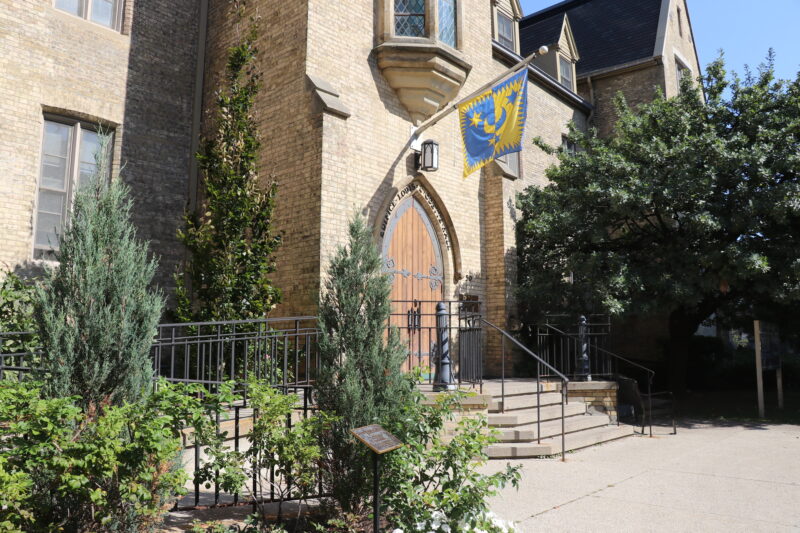
If you’d told me in late February that assembling and packing boxes with Randy Boyagoda’s books and personal effects would be the highlight of my workweek, I’d have probably laughed (or maybe wanted to cry) at the idea. Yet that’s exactly how things turned out on June 11th. There I found myself sorting books alphabetically by last name—Ellison, Faulkner, Gaddis—and receiving instruction from the incoming FAS Vice Dean, Undergraduate on how to fold down cardboard flaps so as not to require any tape—a trick he learned working at a book factory in his student days. Only the crunch of the occasional Dorito break punctuated the thumps and thuds as we stacked pounds and pounds of American literature and Catholic tradition. Not a typical day at Saint Mike’s, but it sure beat Microsoft Teams meetings.
Why was this packing session so bittersweet for me? It had to be something more than working, eating, and chatting with our outgoing Principal, because I’d had the chance to do all of those during my year in his office. But in a sense, that was all it was about. For the preceding ten weeks, I’d missed the many interruptions by the people who show up at my door (who would have guessed that?), discussions of current events over morning coffee, and running into people on my way to the mailroom. My work hadn’t featured the conversation, shared meals, or other un-screen-mediated interactions that so make being a part of the USMC community rich and joyful.
We find ourselves in a liminal time. We’re passing between life before and after COVID as case numbers drop in many parts of the world, but worries of second waves and the absence of widely available vaccines or immunity tests mean that we haven’t crossed the threshold yet. We don’t know what life on the other side of that threshold will look like. Many have died; many have lost their loved ones, others their jobs. The pandemic, along with the killing of George Floyd and the ensuing demonstrations and public discourse, has reminded us of racial and economic inequality in this American election year. We can only hazard guesses at the timeline that runs towards social and cultural normalcy, towards full concert halls, naves, patios, and any of those other places where we gather in embodied groups.
Further, we find ourselves in a spiritually liminal time. Our regular rhythm of movement about the city, with its many external distractions and stimulation, has been disrupted. The resonance between COVID workspace and monastic cell is evident for those of us with the privilege of working from home; we were afforded a lot of time for rumination and reflection, at least before summer weather broke. The occasional escape-via-HBO-binge notwithstanding, something has shifted inside of most of us.
Again, we wonder: what ramifications—social, political, economic, and spiritual—will result from this liminal time?
As another entry in this series reminded me, times of privation and uncertainty can also be occasions for memory and hope. One of the most enjoyable and memorable aspects of my time in the Principal’s Office so far has been serving as a staff member in the Gilson Seminar in Faith and Ideas. The Seminar is a synecdoche for St. Mike’s at its best: Gilson involves the integration of work, play, and friendship. Gilsonians study great texts together, enjoy pelting each other with dodgeballs every month, and share an experience of travel (barring pandemics). It’s been inspiring watching Professor Boyagoda offer his whole person to the Seminar as he led our office in its administration, taught students with the support of our two postdoctoral Fellows, and even brought his family to many of its events. Such leadership is among the many reasons we will miss him in the role of Principal. Although he’s moving on to the Faculty of Arts and Science, Professor Boyagoda will remain the instructor of the Gilson Seminar—an occasion for hope!
Another occasion for hope in our office lies in the fact that we’re gaining Principal Emeritus Mark McGowan on an interim term. Professor McGowan’s devotion to Saint Michael’s over the years, and his considerable institutional memory, will surely prove invaluable in the months to come.
I value working at a place like Saint Mike’s, a place that seeks to nurture the whole person in a community of study, service, friendship and spiritual practice. Although we can’t currently be together in the way we’d want, we can remember what USMC was like before our liminal moment, and look to the future with hope.
Read other InsightOut posts.
St. Michael’s pulled out all the (virtual) stops on Thursday to honour three key leaders as they move on to new roles and responsibilities. More than 90 people gathered online to celebrate the careers—thus far—of Principal Randy Boyagoda, Theology Dean James Ginther and Fr. Peter Galadza, Director of the Metropolitan Andrey Sheptytsky Institute of Eastern Christian Studies (MASI).
Festivities began with a slideshow of each man in action on campus—Fr. Peter with students at Windle House, Dean Ginther presiding at convocation, and Principal Boyagoda in Rome with Gilson Seminar students—all set to the jazzy strains of Natalie and Nat King Cole’s duet of “Unforgettable.”
Then President David Sylvester kicked things off with a welcome to guests, who ranged from students and Collegium members to colleagues and family. Dr. Sylvester recalled his own welcome party two summers ago, bemoaning the fact that the assembled could not celebrate in person in the sunshine of Scollard Park, as he had been feted.
As the program unfolded, however, the inability to gather together did not stand in the way of heartfelt praise for each man. Dr. Ginther offered a tribute to Fr. Galadza, who is retiring from MASI, citing his “dogged commitment to academics,” his “passion for Eastern Christian studies” and his deep faith.
The Dean recalled that even though the two men were doing doctoral studies at the same time at St. Mike’s, it was only during the negotiations in 2017 to bring MASI from St. Paul’s University in Ottawa to St. Michael’s that they met, and Dr. Ginther expressed great admiration for Fr. Galadza’s dedication to students, MASI and the Church.
In response, Fr. Galadza offered his thanks, and expressed his delight at finally being able to spend more time with Olenka, his wife of 41 years.
“God bless all of you,” he said, and guests responded with a flurry of virtual toasts and clapping emojis.
Then Dr. Sylvester offered thanks to Dean Ginther for his service to the Faculty of Theology, noting that, as both men are mediaevalists, the former knew the latter’s academic reputation long before the two met, given Dr. Ginther’s profile as a scholar of Robert Grosseteste and his work in digital humanities.
Calling him a champion of the Faculty, the President cited the Dean’s “tireless work” in renewing the graduate division of St. Michael’s, citing three new hires as an exciting indication of things to come.
Dr. Ginther responded with thanks to faculty staff and his colleagues, and told those assembled how much he is looking forward to returning to the classroom after his year-long research leave.
“It’s been 12 years” since he’s had a leave, he noted.
This prompted another flurry of toasts and clapping icons.
Then it was Dr. Boyagoda’s turn to be honoured. With some gentle teasing, the President noted that if he left anything out in his introduction “Randy would fill it in.”
Dr. Sylvester thanked the outgoing Principal for his vision for St. Michael’s, noting that he was at the forefront of the renewal of the university’s programming and repetition, helping to restore St. Mike’s to its place as the leader in Catholic education.
In his response, Dr. Boyagoda, who has been named Vice Dean, Undergraduate in the Faculty of Arts & Science at the University of Toronto, offered thanks to many people, and then concluded his remarks with an anecdote.
He had just been the basement of Elmsley Hall with a young colleague to seek out furniture for the office he will maintain at St. Mike’s, as he will teaching the Gilson Seminar next year. The new employee who greeted him thought he was a student.
“I’m leaving here feeling young!” he proclaimed, and everyone offered a virtual toast.
Then came a round of comments from such notables as Collegium Chair Fr. Don McLeod, CSB, and Dr. Christopher Brittain, Dean of Divinity at Trinity College.
It was not the in-person party that anyone had imagined, but it was a heartfelt send-off, and the community wishes all three godspeed as they head off in new directions.
June 24, 2020
The University of St. Michael’s College and The University of Toronto Faculty of Arts & Science are pleased to announce that astrophysicist Dr. Adam Hincks, S.J., will be the inaugural holder of the Sutton Family Chair in Science, Christianity and Cultures. The position, jointly supported by Arts & Science and an endowment to St. Michael’s from alumni members Dr. Marilyn and Thomas Sutton, will make a significant contribution to the body of scholarship on the intersection of these three key fields.
Alumni and generous donors to St. Michael’s, the Suttons have long envisioned a position dedicated to examining how Christianity, science and cultures interact and intertwine.
“Marilyn and I are pleased to make this gift of gratitude in support of the distinctive partnership of USMC (St. Michael’s) and U of T. Our education in the Humanities at USMC and Math and Physics at UofT gave us a strong foundation for further education and our professions,” says Mr. Sutton.
The Suttons have found in their own studies that exciting knowledge is found in the spaces between disciplines. The Sutton Family Chair will offer a distinctive opportunity to advance such understanding.
“The inquiries of Science, Christianity and Cultures are informed by intersecting strands of scholarship. This Chair will provide a locus for focused study of those intersections and facilitate the development of new knowledge,” Dr. Sutton says.
Dr. Hincks specializes in physical cosmology, which studies the evolution and overall structure of the universe. In 2004, he completed a B.Sc. in physics and astrophysics from U of T, while also earning the St. Michael’s College Gold Medal for the highest cumulative GPA in sciences for a graduating student. In 2009 he earned a Ph.D. in physics from Princeton University and then entered the Jesuit novitiate in Montréal. After pronouncing vows in 2011, he pursued philosophical studies at Toronto’s Regis College and later did a Bachelor of Sacred Theology at Rome’s Pontifical Gregorian University. Between these studies, from 2013 to 2015, he was a postdoctoral research fellow at the University of British Columbia. Most recently he has been completing a Master of Theology and Licentiate in Sacred Theology at Regis College. He was ordained to the priesthood in 2019.
“As an alumnus of St. Mike’s at the University of Toronto, where I did the undergraduate Astronomy and Physics specialist programme, I’m proud that my alma mater has created this creative position, and I’m delighted to be taking it up,” he says.
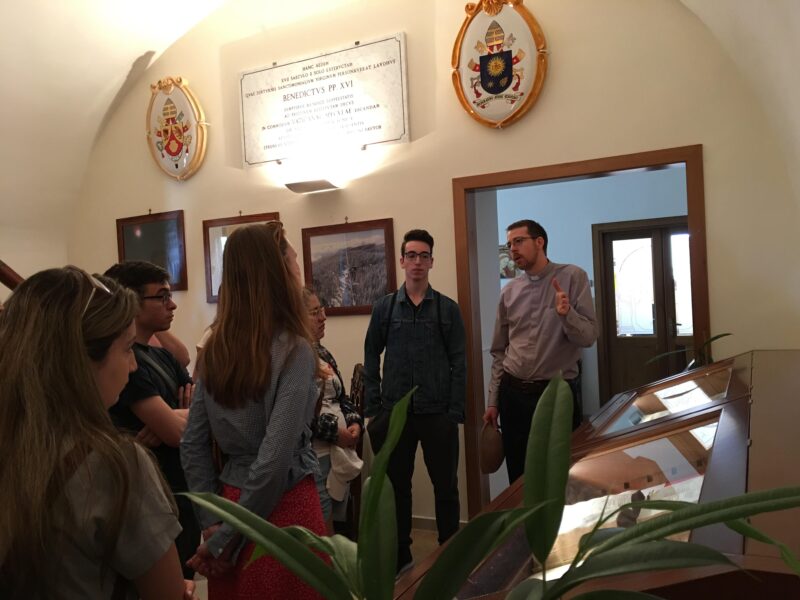
Among his various academic affiliations he is an associate scholar of the Vatican Observatory, while his research includes work with the Atacama Cosmology Telescope and the upcoming Simons Observatory, both located in Northern Chile, that are designed to answer fundamental questions about the history and structure of the Universe. In the past, he has also worked on the Canadian Hydrogen Intensity Mapping Experiment in British Columbia’s Okanagan Valley.
“I’m looking forward to continuing my scientific research in a context that also allows me to examine how it enters into conversation with Christianity and culture, both in the classroom and as a secondary research area,” Dr. Hincks explains.
“Dr. Hincks is a stellar addition to a growing group of very fine core faculty at St. Michael’s,” says Dr. Sylvester. “He reflects the caliber of research and teaching excellence St. Michael’s is providing to all University of Toronto students. Dr. Hincks’s work—especially in studying the interrelationships of Science and Christianity and their relationships to a variety of cultures—disproves the frequent assumption that science and religion have nothing positive to gain from encountering each other. We are very glad to welcome him home to St. Michael’s.”
Dr. Melanie Woodin, Dean of U of T’s Faculty of Arts & Science, agrees.
“The establishment of the Sutton Family Chair will advance research and teaching in multi-disciplinary ways that attest to the breadth and depth of the scholarship and learning that takes place in the Faculty of Arts and Science,” Dr. Woodin says. “I am delighted to recognize the generosity of U of T alumni and longtime supporters Tom and Marilyn Sutton. Their investment in this co-located Chair affirms the importance of creative and meaningful collaborations between the Faculty and one of its valued federated colleges, St. Michael’s.”
Dr. Hincks will begin his four-year appointment on July 1, 2020. The David A. Dunlap Department of Astronomy and Astrophysics will host Adam’s graduate appointment in the University of Toronto. In addition to teaching courses for the Department and also for the Christianity and Culture program sponsored by St. Michael’s College for students in the Faculty of Arts and Science, Adam will develop a course to be offered jointly for students in both programs, related to religion and science, in the time ahead.
Marilyn and Tom Sutton are graduates from St. Michael’s class of 1965. Marilyn graduated with a B.A. in English and French, completed a Phd at Claremont Graduate University and is Professor of English (Emerita) at California State University, Dominguez Hills. Tom graduated with a B.Sc. in Mathematics and Physics and is the retired chairman and CEO of Pacific Life Insurance Company.
Jessica Barr is the University Archivist and Records Manager for the University of St. Michael’s College. She is a graduate of the University of Toronto (New College 0T9, Faculty of Information 1T1), and spent much of her time as a student studying in the John M. Kelly College Library. Not much has changed, except her desk’s location in the library.
Archiving St. Mike’s in Quarantine
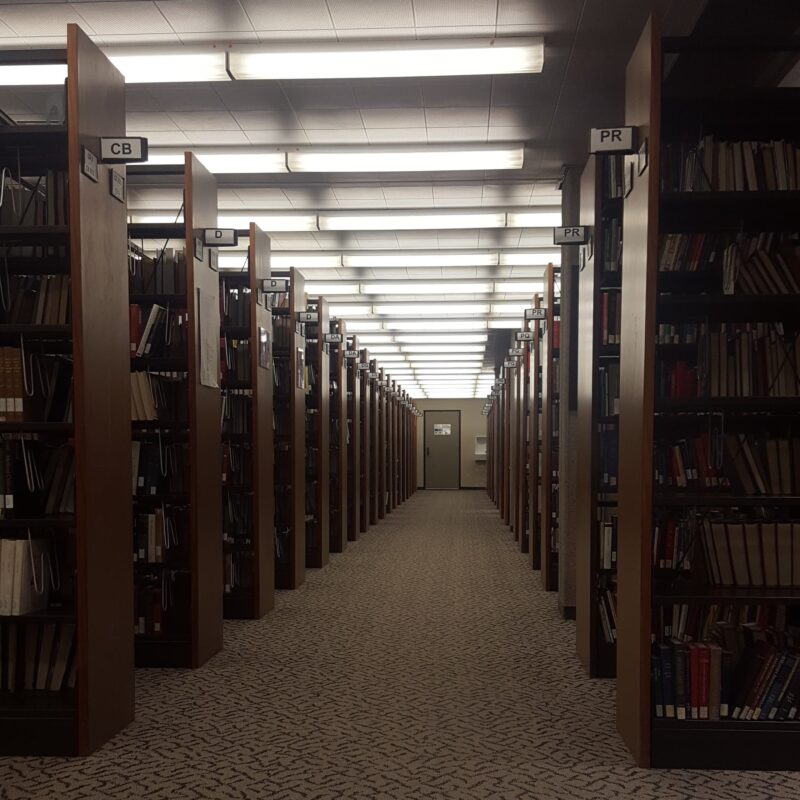
The University of St. Michael’s College Archives is tucked in a corner of the third floor of the John M. Kelly Library. The Archives preserves the official records of the University, including records from the offices of the President, Principal, Faculty of Theology, Pontifical Institute of Mediaeval Studies, and Continuing Education program. We also have papers from faculty, records about some alumni, student publications, and an extensive collection of photographs. More recently, I’ve written a survey to capture the experiences of our community during the COVID-19 pandemic (but more on that later).
Much of my time includes hands-on work with the paper records that contain the history of St. Michael’s College: I arrange transfers of records from donors, I make sure the archival materials are properly housed so they can withstand many of the tests of time (including damage from light, pests, or mould), and I create digital inventories with written descriptions of the materials so they can be accessed by researchers. I also respond to reference requests from researchers near and far—some are looking for information on alumni who attended St. Michael’s, some are conducting academic research using papers written by faculty, and some are simply interested in our history as an academic institution.
Since mid-March, however, I have been working remotely, like many of my St. Michael’s colleagues. So how do I archive materials without physical access to the archives? With the help of the IT departments at St. Mike’s and the University of Toronto, I have been able to maintain access to my network drives and my digital records. These records include my digital inventories of the collections held in the archives and more than 1500 digitized photographs. This means I can continue to respond to many reference questions, including a recent query about the date the clock was added to the Elmsley Hall tower. (It was 2005, in case you are wondering.) I can also update inventories and spreadsheets to make them more accessible for future users, or upload them to the website; update policies and procedures; coordinate with colleagues on questions related to records management; finally clean up my hard drive; and convert already digitized materials to more usable file formats.
During this time of quarantine and pandemic, I have been wondering how the archives can preserve this point in history. I find myself asking: What do I wish we knew about the 1918 pandemic at St. Michael’s? What was that period like for our students, staff, faculty, and alumni? We are able to gather some information from administrative records and yearbooks, but we don’t have very many first-hand accounts. In response, I have been actively archiving the digital records created by the administration over the past three months, including public emails and the St. Michael’s website. In an attempt to gather eyewitness accounts of the COVID-19 pandemic, I have also written a survey to send to our community, with the goal of capturing information about our thoughts, feelings, and experiences. In the future, researchers will be able to access these answers to learn what life was like for us during this particular moment.
We invite you to submit your own answers to the survey, and any photographs that capture this moment: https://stmikes.utoronto.ca/usmc-archives-and-covid-19/
I’ve copied examples of my own answers below:
Name: Jessica
What is your current location: My kitchen table, Pickering, Ontario
How are you connected to St. Michael’s College? Staff
How have you, your family, and community been impacted by the COVID-19 pandemic? I have been working remotely since March 12th. A few immediate family members were temporarily laid off from work, but the rest have been working remotely. We have all, thankfully, remained healthy. Many of my neighbours have been home, so we see a lot more people on walks now.
Share your experience with teaching, learning, or working remotely: I was able to begin working remotely very early on, thanks to previously-set-up off-site network access, and troubleshooting with our IT teams. Transitioning to Zoom or Microsoft Teams meetings was a bit of a challenge, since not all colleagues immediately had access to a camera or microphone. After a couple of weeks, though, we all got into a “normal” swing of things. I have really enjoyed meeting the pets and children of colleagues via web meetings.
What about your routine has changed? My gym is closed, but is offering Zoom classes to keep active. I just noticed that my bus line to get to the GO station has been shut down due to lack of ridership, so that will be a challenge when we’re cleared to physically go back into work. Beyond that, I’ve been reading a lot of cookbooks and testing out a lot of new recipes. Luckily, I have family nearby, so I can deliver some treats to nearby porches. I would normally have a day each month to visit with my father (who lives about six hours away), but we haven’t been able to travel since February.
For more information about the University of St. Michael’s College Archives, please check out this link: https://discoverarchives.library.utoronto.ca/index.php/university-of-st-michaels-college-archives
Please email me you have any questions for the archivist: usmc.archives@utoronto.ca
And, if you’re interested in seeing digitized copies of historical St. Michael’s yearbooks, you’ll find some here: https://archive.org/details/usmichaelscollege
Read other InsightOut posts.
Ask.smc@utoronto.ca offers a single point of access for student to find the help they need
From academic advising to assistance with financial aid, accessibility needs and career planning, the Office of the Registrar and Student Services provides essential help to students in all stages of their St. Mike’s journey. Although the physical office has been closed since mid-March in response to the COVID-19 pandemic, the Student Services team continues to provide timely, crucial support to St. Mike’s students online, and the team is optimizing its services for remote delivery this fall as well.
The effort on the part of the office to optimize online service delivery for St. Michael’s students in a matter of days “is truly something I have never witnessed before,” says St. Michael’s Registrar Giancarlo Mazzanti.
“Advisors have stepped up to deal with the very significant increase in student inquiries, while working at putting into a virtual format everything that students have come to expect of the Registrar’s Office and Student Services,” Mazzanti says. “The university has made a commitment to the continuation and expansion of Student Services to be certain that all students will have the advising and services that have become synonymous with the student-centered St. Michael’s approach.”
During this unique time, a single point of access has made it easier for students to find the help they need: ask.smc@utoronto.ca. Students can email this account to get in touch with an advisor directly, and to get connected with a variety of ongoing services.
Academic Advising is a primary focus of the office. During one-on-one sessions, advisors provide assistance with registration, course selection, program selection and scheduling. In addition, advisors can provide students with guidance regarding workloads relative to other aspect of their student life, and help provide clarity on options for financial aid, some of which are available directly through the University of Toronto.
Nicole LeBlanc MSW, RSW has been the Wellness Counsellor at St. Michael’s since the fall of 2016. All students and residents of St. Michael’s are welcome to set up an online half-hour counseling appointment with her by email: nicolem.leblanc@utoronto.ca. Other wellness resources can also be found through St. Michael’s Student Services under the Wellness Counsellor tab.
Dr. Andrea Graham and Julia Andrews are the Academic Success Learning Strategists at St. Michael’s, and they support students in all areas of learning and academic performance. Graham and Andrews are available to help students discover their best ways of learning, adapt to university expectations, increase their efficiency, identify and pursue their goals, improve their work, and get the most out of their academic learning experience. Appointments with each can be set up through ask.smc@utoronto.ca, and additional resources for academic success are available through University of Toronto Student Life.
Accessibility Services at the University of Toronto can help students with temporary and permanent accessibility needs receive necessary academic accommodations. St. Michael’s accessibility advisor can be reached through ask.smc@utoronto.ca, and more information about registering for services is available through University of Toronto Student Life.
It’s no secret that writing at the university level can be a challenge, especially for new students. That’s why the Writing Centre at St. Michael’s continues to offer one-on-one appointments for students looking for guidance on all aspects of the writing process, from researching and outlining to drafting and editing.
Support for students also includes help with the period that follows graduation. This is where St. Michael’s Career Educator Husna Arif comes in: she helps students with exploring career options, applications for grad school, upgrading job search skills, conducting mock interview, learning about employment opportunities, and making plans for after graduation. As with the Office of the Registrar’s other services, digital appointments with Husna can be set up through ask.smc@utoronto.ca.
As these services continue being offered digitally through the summer, Mazzanti says remote service is being optimized for the Fall term as well. “We have doubled the number of front-line advisors available to answer student inquiries as well as adding resource to the financial aid portfolio, in personnel and funds,” he says. Regular services offered during the Fall and Winter terms such as the Math and Computer Science Success Centres will be available remotely, too.
Many students will also be making their transition to university during this uncertain time, and the Office of the Registrar and Student Services team is already working hard to make the move as seamless as possible. “We have over 20 events planned over the summer to facilitate the student transition to university,” Mazzanti says, including “welcome events, course planning and selection and other events that will allow students to actively participate, collaborate and meet with our advising team.”
Dr. Darren Dias teaches in St. Michael’s Faculty of Theology, specializing in Trinity, Religious Diversity, and teaching methods. He is currently working of a SSHRC funded project with colleagues Gilles Routhier (Laval) and Michael Attridge (St Michael’s) entitled: “One Canada, Two Catholicisms: Divergent Evolutions in the Catholic Church in Quebec And Ontario, 1965–1985.”
When the Monastic Cell Meets a Zoom Meeting
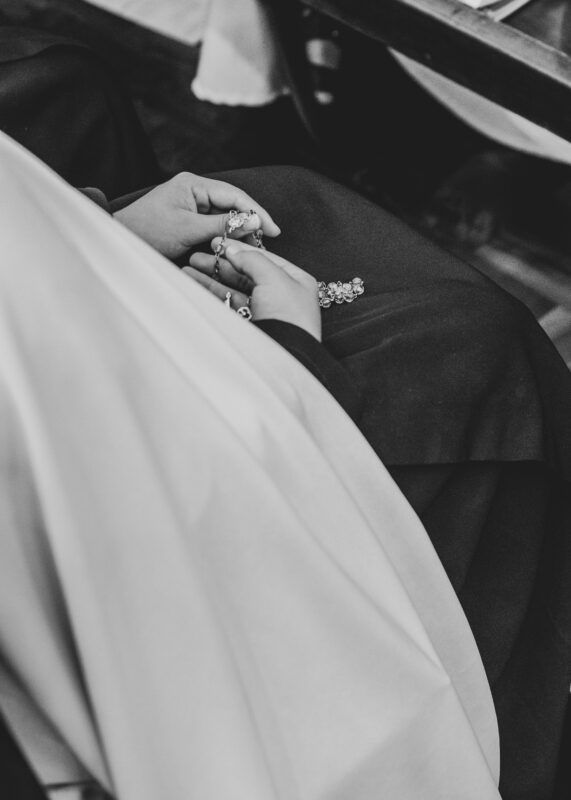
When someone enters a religious order or institute for consecrated life they begin with the novitiate. Monastic orders like the Benedictines, Cistercians, and Trappists, mendicant orders like the Franciscans, Dominicans, and Carmelites, or apostolic congregations like the Basilians, Sisters of St Joseph and the Lorettos—everyone begins in the novitiate. This is an intense period of no less then twelve months when the novice is removed from his or her normal life and confined to the novitiate community. The novice leaves behind his or her job, or studies, and the comfort of one’s usual network of relationships, and enters into something new. One is suddenly disconnected and inserted into a foreign reality. Novitiate is the beginning of a process of formation into a particular history, charism, spirituality, theology and way of living.
My novitiate was spent in the Priory of St. Albert the Great in Montreal. The large priory was built to house about 100 friars in 1960 (just before the exodus of so many religious). The complex includes a large conventual church, refectory, community rooms, ‘cells’ (bedrooms), pastoral institute, administrative offices, even a pharmacy, swimming pool and its own postal code. Although on the campus of the University of Montreal, St. Albert seemed like an oasis in the midst of the hustle and bustle of urban university life. One could easily survive without leaving the complex for weeks, maybe months.
St. Albert seemed to have preserved much of the medieval character of the Order of Preachers: a separate choir for the religious in the chapel, long refectory with an alcove for the reader, silence in the halls, habited religious moving from choir to refectory, etc. The rhythm of my day unfolded according to the schedule of the liturgical hours (prayers): lauds and Eucharist in the morning, mid-day prayer, and vespers; after each hour, the appropriate meal was served. Between prayer and meals there were blocks of time for contemplation and meditation (naps); study, common and individual; and work, on-site labor to meet the needs of the community (cleaning, gardening, snow removal, etc.).
The imposed confinement in March due to COVID-19 has felt in many ways like a return to my novitiate experience. The rhythm of life that developed in the wake of the confinement was not unfamiliar. My life was not punctuated primarily by apostolic activities—teaching, lectures, parish ministry—but around common prayer. Always being home has meant that morning or evening activities no longer make it possible to skip common prayer for a different “priority.” Of course, through technology many of activities continue, but in drastically different ways. The sacrosanct private space of the “monastic cell” has been displayed on Zoom for all to see.
For centuries, religious have in some way retreated from the world, for love of it, into a voluntary confinement. Withdrawal means making space for the other, especially for the most vulnerable and in need. This is not a space of escape from the world, but a space of intimate encounter, where the “joys and the hopes, the griefs and the anxieties” (Gaudium et spes) are appropriated and placed before the Triune God in prayer. Since COVID-19 began, this prayer has been mottled by petition and supplication for healing and reconciliation.
Religious communities, even ones rooted in monastic or medieval notions of “separation from the world,” are not unaffected by pandemic. In 1918 Archbishop Paul Bruchesi of Montreal wrote a pastoral letter praising the work of many religious communities during the Spanish Flu epidemic. Apostolic religious communities were on the frontlines of health care and social assistance then. In these twilight years of religious life in Canada, religious communities experience solidarity with the victims of COVID-19 differently. Less than directly serving those most affected by the pandemic, many religious have become its victims.
If religious communities were aware of their vulnerability before the pandemic, how much more keenly are they aware of it today? In 2014, Canada counted about 11,600 religious. Of that number 50% were over 80 years old and 44% between the ages of 60-80. Already in 2014 fully 25% of all religious lived in long-term care homes. Many religious communities have been devastated by the coronavirus. In Ontario, the Jesuits temporarily shut down their retirement facility. Half of the residents in the Residence-De-La-Salle, a mixed religious community care facility in Quebec, have died. Some religious communities have lost up to one third of their members due to COVID-19.
My return to my novitiate experience, coupled with the witness of those who have been affected by the disease, reminds me that religious life is an ongoing process of becoming ever more vulnerable. A voluntary confinement does not separate religious from the world around them, but brings the vulnerability of that world into the heart of who we are.
Read other InsightOut posts.
Today, we hear from two of the voices working to keep the campus in safe and beautiful condition. Angela MacAloney-Mueller is Physical Plant Coordinator. She’s been a part of the USMC community since August 1994, and notes that the comfort of students and staff are her top priority. Michael Chow is the Director of Facilities & Services. He joined the USMC community in August of 2019, and is dedicated to making USMC the most beautiful campus in Canada.
The New Normal on the St. Mike’s Campus
Angie
Anyone who’s visited my office knows how much of a Harry Potter fan I am. During the last few weeks a line from one of the movies keeps running through my mind. In Order of the Phoenix, Mrs. Figg assists Harry in escaping two Dementors—flying, soul-sucking monsters—who have attacked Harry and his cousin, Dudley. “Dementors in Little Winging! Whatever next? The whole world’s gone topsy-turvy!” Some days it does feel like that.
In early January, the coronavirus was something discussed but not really worried about—at least not by me. Then I was asked to source order hand sanitizer for the campus. It was then I started to worry a little; it wasn’t as easy to source as I had thought, although I was able to order some. Once it arrived I distributed it to various departments. At that time, I think we were all hoping the coronavirus wouldn’t affect our lives—it was happening “out there.” February came, the virus became more widespread, and senior managers discussed emergency plans.
Then everything seemed to happen so fast. Students were asked to move out early, classes moved online, and plans were made for the staff who could to work from home. I woke up one March morning to find myself using a laptop for the first time, logging in remotely from my kitchen. It took a couple of weeks to get used to working from home. I still get up at the same time and follow my morning routine. I do this for two reasons: one, my cat won’t let me sleep in and, two, I know it is better for me mentally to stick to my regular routine wherever I can.
I am grateful I can work from home and don’t have to take public transit, but I miss the camaraderie with my coworkers, going to lunch at my favourite sushi place, and just being on campus. I have worked on campus for more than half my life. Sixteen years at the Pontifical Institute of Medieval Studies, and it’ll be ten years this August that I have worked for the Facilities Department. The campus is like a second home, and it’s taken some adjusting to not being there as often.
This time of year is normally one of the busiest times for the Facilities Department. Students move out at the end of April, and we do room inspections and repairs in May, when we normally prepare to host summer camps. I missed the hustle and bustle of that this year. Still, we must keep moving forward, so we are now getting some work done in the campus buildings.
I go to campus once a week to do paperwork and other tasks I can’t do from home. I always go for a walk around the mainly quiet campus. Signs of spring are everywhere. The lilacs are in bloom, the birds are singing, and the tulips planted last fall are showing off their lovely colours. The day I’m in the office feels the most normal. It’s nice to see and chat with a couple of coworkers, to have a sense of normalcy, even if only for a day.
I don’t know if we will ever go back to the way things were, but I know we will all adjust to a new normal. Yes, it does feel very “topsy-turvy” right now, but we must keep going and not let fear take away the joy in our lives. I know this is not forever, and I need to keep reminding myself of that. I look forward to the day we are all on campus together again.
Michael
The campus and the world are not the same today as they were three months ago.
As a commuter, it is now hard for me to believe I had problems finding a parking spot at the GO train station ahead of my 6:28 am train. After March 12, parking was no longer the issue, but rather the frequency of trains. Ridership dropped drastically, which I originally attributed to March Break but quickly learned was a sign of people staying away from the “germ tube.” I followed suit and decided to drive to campus. To my surprise, I was able to make it to campus in about 25 minutes or so, the equivalent of making the same drive prior to sunrise on a Sunday morning.
Self-isolation, self-quarantine, border closures, and a state of emergency were the hot topics in mid-March, replacing the usual campus discussions surrounding mid-term results, lectures, final exams, and convocation. After the campus closure was announced and the majority of the students had moved out, a surreal dream started playing out in Technicolor.
Imagine walking through Canada’s largest university campus in March and only encountering three people. Weird and eerie are two words to describe the overall ambiance.
While other USMC staff were able to work from home, the same opportunity was not available for the Facilities & Housekeeping staff. The courageous and dedicated staff from F&H persevered, and many of them braved public transit to ensure uninterrupted services for those students unable to return home due to travel restrictions.
Behind the scenes—and often unnoticed—the F&H staff have faced the challenges of the pandemic as essential staff and turned them into opportunities as guardians for the university. Deep cleaning and disinfecting of all campus spaces, polishing and waxing of large common floor areas and meeting rooms, lowering utilities by managing equipment set-points and turning them off where possible, and pushing forward with maintenance projects which might otherwise not be feasible with a full campus.
As we all try to predict what the “new normal” will look like, the staff and students can be assured that the USMC campus will continue to be one of Canada’s most beautiful, safe and ready to welcome everyone back once we are able to.
A card in the Facilities office from the Dons of 2019/2020 reads: “Not all superheroes wear capes.” Please stop a F&H staff member upon returning to campus; a simple heartfelt “thank-you” will have a lasting impact.
Read other InsightOut posts.
June 8, 2020
Dear members of the St. Michael’s community,
I trust this message finds you in good health and holding up in these uncertain times. The 2019/2020 academic year has ended like no other, and I have watched our community respond with grace, courage and resilience to the challenges created by the COVID-19 pandemic. Once again, St. Michael’s is showing that even in very difficult times, our strength and generosity marks us as an anchor of hope in our community.
Social media use of #allinthistogether has gathered traction as the world responds to COVID-19, but I am particularly struck by how, at St. Mike’s, we really are in this together. Together, our students, faculty, alumni, and staff have worked to respond to these unique times, enabling classes to continue while ensuring the safety and security of campus, and the community. Students have been particularly resilient, and they have shown great understanding and patience in the face of a dramatically upended school year. As I look forward not only to the coming academic year but also to the future of St. Mike’s, I am confident that the lessons learned in these challenging days will help strengthen this incredible place, a place with compassion and community at its very heart.
When it became clear in mid-March that we needed a drastic response to the looming health crisis, creative problem-solving swung into action across the University. Within days, faculty and staff began offering classes and advising remotely, and students rose to the challenge. Residence students were able to pack up and head home early. The library remained open online, even offering a town hall on research. With a dedicated skeleton staff on campus to ensure that our students who could not leave were safe and supported, colleagues began working remotely, and virtual meetings became the norm. For the first time in history even Collegium and Senate meetings moved online.
This period will forever be remembered as a time when the world faced challenges above and beyond the norm, and we offer our support to those who are suffering. For St. Mike’s, the pandemic has forced us to sacrifice some much-loved traditions. We had to cancel spring reunion on campus and move to online anniversary activities, and the Class of 2020 missed out on an in-person, on-site convocation. As always, however, our community has responded with energy and hope. Whether it’s our Student Life team working on a virtual orientation for the incoming class, staff in the Registrar’s office taking additional time and care to respond to new and returning students’ concerns, or one of our students arranging to donate thousands of masks to protect those still on campus, this community is motivated by a concern for others, and it has been deeply moving and inspiring to witness.
We were in the midst of our St. Mike’s 180 planning when the pandemic hit. The pause in this project has allowed us time to reflect on our efforts to date and has affirmed what we already knew, that it is the strength of this community that is helping us weather this difficult storm and gives us hope for the future. We remain focused on our plans for renewal and I look forward to restarting conversations with you all about who we want to be as an institution and how we plan to achieve that. Obviously, we are stepping into a very different world, but St. Mike’s is prepared and must take up the mantle of leadership and think of new ways to build hope for our university and society, through our academic and student life programs and through our alumni and community partnerships.
Looking ahead to the 2020-2021 academic year, much remains unknown and difficult decisions must be made in the face of ongoing uncertainty. The health and safety of our community continues to come first, as well as the ability to reopen and resume operations when we are able to do so safely. The university is also facing challenges with regard to reduced revenues, and must also ensure that it remains fiscally sustainable. In early April, we implemented a hiring freeze, along with temporary redeployments. More recently, faced with prolonged shutdowns of parts of our campus and operations the University has worked with the United Steelworkers so that employees in our Facilities and Services Department and Physical Plant Departments can self-identify if they are willing to take a temporary leave. Staff who are affected by this decision have already heard from us directly.
Despite the challenges we are facing as the result of the pandemic, we remain committed to our community and charting a path forward. We are doing everything we can to sustain our workforce and adapt as we move through this crisis. We have established an advisory group, focused on plans for the fall, and we will continue to follow advice from public health and government guidelines. The University of Toronto has recently announced a plan to support employees in working from home where possible until at least September. St. Michael’s is part of this collaborative effort to achieve a gradual and safe reopening of the city’s workplaces.
Fortunately, in addition to calling on the expertise of our in-house resources, we can also tap into the knowledge and best practices of organizations such as Universities Canada to help us continue to do what we do best as a centre of learning and faith committed to building the common good.
Our Collegium remains a strong sounding board and a source of advice, responding wisely and compassionately to the unique concerns raised by the pandemic. Last week, the USMC Senate discussed the impact of COVID-19 on our academic community. We head into the coming year in especially capable hands, with former St. Michael’s Principal Dr. Mark McGowan returning as Interim Principal, as Prof. Randy Boyagoda becomes Vice-Dean, Undergraduate in the Faculty of Arts & Science at U of T. As well, Dr. John McLaughlin will again serve as Interim Dean of the Faculty of Theology as Dean James Ginther returns to the classroom following a leave. We are also very fortunate to have continued great student leadership, and I have already begun to work with Cianna Choo and the newly-elected executive of SMCSU.
While there is still so much we do not know about the course of this pandemic, rest assured that we will continue to communicate via email, social media and our website, stmikes.utoronto.ca, with important information about the 2020-2021 academic year and how and when the campus will reopen. Yes, we are in extraordinarily challenging times, but we are truly all in this together, and with your help St. Michael’s serves as an anchor of hope, an engaged and compassionate community dedicated to serving the greater good.
I am proud to be a member of this remarkable community.
Gratefully,
David Sylvester, PhD
President and Vice-Chancellor
University of St. Michael’s College
The following remarks were included in a program delivered to members of the graduating class as part of their virtual Convocation.
On behalf of Principal Boyagoda, and all of our colleagues at the University of St. Michael’s College, I offer congratulations on completing your undergraduate studies at the University of Toronto.
The historically rich university ceremony of convocation is meant to provide the opportunity to celebrate your academic accomplishments and to acknowledge publicly those who have supported you. Well done, and congratulations also to your family, friends and the professors and many others who have helped you complete this important chapter in your educational and personal journey.
This year, however, you and your classmates, in fact all of us, have been also called to reflect upon the extraordinary events we find ourselves facing, individually and as a society. The circumstances surrounding your convocation are like no other. We recognize that it has been a challenging way to end this year. It is not only the shift to remote learning, and the distancing from good friends at this time of celebration: for many, the events of the last few months have added real economic and personal strain to the usual challenges one would expect to face as program completion deadlines approached. So, please know that we acknowledge that in addition to the academic focus and discipline you have demonstrated in this last semester of your studies that you have been asked to find within yourselves the patience, flexibility and strength to face these new challenges.
Thank you for the grace and resilience you have demonstrated in this challenging time. You, and the class of 2020, will be remembered in a unique way in the long and rich history of St. Michael’s.
Congratulations again. Be well, and God bless you and yours.

David Sylvester, PhD
President and Vice-Chancellor
The University of St. Michael’s College
Throughout the seasons of Lent and Easter, Dr. Darren Dias, OP, who teaches systematics at the Faculty of Theology, has shared his homilies with the broader university community. For the Feast of Pentecost, he spoke on the subject of race and renewal.
Pentecost 2020: Act 2:1-11; 1 Cor 12:3-7, 12-13; John 20:19-23
Today we celebrate the renewal of creation when the risen Lord appears amidst his disciples and breathes life into them, as God first breathed life into Adam (Genesis 2:7). But today the last words of George Floyd—a 46 year-old father of 2 brutally murdered by police because he was black—echo in our midst: “I can’t breathe.”
This week the Ontario government warned that confinement and distancing regulations will not be relaxed as expected because of the increase of COVID-19 cases. We see these especially in lower income and new immigrant areas of the city where pockets of racialized persons live. We have spent the entire Easter Season in confinement and now at its completion, it looks like it will be prolonged.
Perhaps not unlike the disciples we lock our doors out of fear of the real dangers lurking about; locked in our homes or in the bubbles created by masks and gloves and safe distance. Yet Pentecost in John’s Gospel account is the moment when Jesus appears to the disciples, meets them in their fear, and releases them from it by breathing the Spirit of new life into them, and then sending them into the world on a reconciling mission. But we remain locked up, anxious about COVID-19 , and for racialized persons like me, fearful of the lurking plague of violence. So what kind of Pentecost can we celebrate this year?
In the narrative from Acts we read another account of the giving of the Holy Spirit. A violent wind fuels the tongues of fire that appear over the disciples. These are external manifestations of the Holy Spirit’s presence in the community. Likewise, the disciples’ preaching, understood by speakers of various foreign languages, Parthians, Medes, and Elamites, Libyans, Romans, Cretans, etc., is a manifestation of the Spirit’s power.
Pentecost is often seen as a remedy to the confusion of the multiple languages that resulted from the destruction of the tower of Babel in Genesis 11. Now we don’t have readings from the Hebrew Bible during the Easter season, but if you remember in Genesis 11 the whole earth is said to have spoken one language. This makes the people of earth powerful and they decide to build a tower to the heavens as a testament to their power. In response the Lord comes and scatters the people, replacing the single language that seemed to be constitutive of their powerful abilities with many languages. The people become confused because they are unable to understand one another due to the multiplicity of languages and their building project is left unfinished. If a multiplicity of languages that resulted in confusion was divine punishment for the Promethean building project, then Pentecost might be understood as its remedy.
For example, Gregory of Nazianzus writes:
“But as the old Confusion of tongues was laudable, when men [sic] who were of one language in wickedness and impiety, even as some now venture to be, were building the Tower; (Genesis 11:7) for by the confusion of their language the unity of their intention was broken up, and their undertaking destroyed; so much more worthy of praise is the present miraculous one. For being poured from One Spirit upon many men, it brings them again into harmony.” (St. Gregory of Nazianzen, Oration 41)
But in the narrative from Acts 2, Pentecost does not result in a single language like Babel but is about being able to understand one another. Multiple languages are not replaced with a single language: all are speaking their own language but they understand one another.
In his reflection on Genesis 11 and Pentecost, Gustavo Gutierrez, OP, claims that the builders of Babel are punished not because of a rivalry with God and God’s ensuing jealousy, but because Babel is a “political attempt, totalitarian in nature, to dominate people.” Clear allusions to the imperial project of the tower’s construction are seen in Peter Bruegel’s painting of the Tower of Babel. Bruegel (1525-69) paints the Tower of Babel to look like one of the greatest symbols of western imperialism, the Roman Colosseum. Though a Catholic himself, Bruegel alludes to the singularity of the Latin language in the Roman Catholic Church in depicting a stylized version of one of Rome’s greatest landmarks, compared to the myriad of vernacular languages used by Protestants in the low countries of his time.
That human community is expressed through a single language is a fiction. Gutierrez argues that a single language aims at a more efficient domination of the other through “the flow of orders coming from the central authority.” Dominating and oppressive imperial projects are impeded by diversity, especially diversity in language. A single, imposed language is an abuse of language and power. Pentecost, on the other hand, is about the life giving option of diversity. This diversity of languages makes dialogue, mutual understanding, inter-personal exchange and unity possible precisely through the diversity.
The gift of the Holy Spirit did not change the immediate situation of the disciples. They still struggled with Jesus’ new mode of presence and they still feared the authorities and their message was met with resistance. But they were able to establish new ways of being community together and beyond themselves. The disciples were able to move beyond themselves to build relationships with those who were most different, strangers and foreigners.
As Pope Francis reminded us during Holy Week, the world has been sick in many ways, even before COVID-19, but many of us with privilege thought that we would not get sick. Evils like white supremacy that render human persons into things with no worth, existed before George Floyd breathed his last. But many of us imagined that we were either not susceptible to or not implicated in structures of power and race. This Pentecost we are reminded that we too can get sick and that the violence of racism looms large.
The gift of the Holy Spirit compels us to creative and bold ways to build-up human relations in their wonderful diversity. Three examples come to mind from this past week. First, this weekend the College Theological Society decided to hold its annual conference online due to COVID-19. This virtual gathering made it possible to relate to one another, to break out of our confined spaces, and to become a community of teachers and learners once again. Another example is the Atlanta Chief of Police who met with protestors in the wake of George Floyd’s murder. She did not condemn them or order them to go back home. Instead she listened to them and affirmed them in their justified fears. Protestors and police spoke peacefully and meaningfully to one another. Last, today in our zoom Eucharist we find ourselves constituting community in a new way to share in word and sacrament across special divisions. I’ve never heard so many of you say that our weekly time together has become the highlight of their week. COVID-19 reveals the depth of our need to become community.
Every Pentecost is the re-birth of the church anew into a particular time and place and context, each with its own joys and sorrows. The visible manifestation of the Holy Spirit in Pentecost today may be very similar to the first Pentecost: reaching across boundaries to understand those who live differently, speak differently, experience reality differently. Through speaking and the use of language—which is always first by listening—we exchange breath. Every language exchange includes the exchange of breath (but no ‘moist’ speaking). In these times when it has become dangerous to breathe, we are called to exchange life-giving breath as the disciples did, using language to build in inclusive community.
Our Spirit-given diversity challenges singular and dominating forms of power that dehumanize, and that ignore the breath of divine life, the Holy Spirit, who dwells in all creation, in every human being. This gift offers us countless and bold ways to build communion and inclusive community where diversity breathes life.
Gustavo Gutierrez, “Between Babel and Pentecost,” in Gustavo Gutierrez, Essential Writings ed. James B. Nickoloff (Maryknoll: Orbis Books, 1996)
Dr. Stephen Tardif is an Assistant Professor in the Christianity and Culture Program at the University of St. Michael’s College. He also offers courses in the Book and Media Studies Program. This spring, Dr. Tardif was named as co-editor of The Hopkins Quarterly, an international journal of critical, scholarly, and appreciative responses to the life and work of Gerard M. Hopkins, S.J., as well as to those of his circle.
Reading Hopkins in Quarantine
By April, the poet was already sick; in June—just six weeks shy of his forty-fifth birthday—he would succumb to an infection for which, within a decade, there would be a widespread, life-saving vaccine. The death of the Jesuit poet, Gerard Manley Hopkins, from typhoid fever in 1889 appears to present a number of grim contrasts: a young man cut down in the prime of life, who dies from a soon-to-be cured disease. And yet, as his illness worsened, Hopkins’ mood seemed to lighten: the last letters to his family offer consolation, his reported last words, “I am so happy,” offer inspiration.[1] And his last poem, which he sent in April to his best friend, Robert Bridges, offers an “explanation”—this, indeed, is the poem’s last word. Although typhoid is certainly very different from the pandemic we face today, we can take a lesson from Hopkins about how to endure both the disease itself and the disruption it continues to cause, especially from his final poetic achievement.
This poem, a sonnet entitled, “To R.B.,” is, in fact, addressed to his best friend, and it ended what Bridges later recalled being “a sort of quarrel” between them, one precipitated by a joke and some hurt feelings.[2] Hopkins had teased Bridges about the small run of a forthcoming collection of his poems; Bridges parried with a reminder that Hopkins had published virtually nothing at all; with the peacemaking poem that Hopkins sent his friend, he provides a kind of alibi for his silence. Hopkins, who had only sporadic poetic inspiration for years, turns this privation into an invitation to imagine the very impulse that he lacks. The result is one of the most successful examples—and accounts of—poetic creation in the English language.

Hopkins’ poem is thus a reminder of the abilities that we possess, even in times of quarantine, confinement, and infirmity. While we might not all have be able to describe the artist’s creative act, we do have the power to maintain and renew the social bonds between us. While the sonorous, Latinate rhyme-words which end the poem —“inspiration,” “creation,” and “explanation” (ll. 10, 12, 14)—might seem to rise with the first two words but fall with the last, this word is really its pinnacle. After all, this explanatory poem, which reconciled friends who would soon be separated by death, precipitated the experience of inspiration that it captures so well. Above even the poetic muse, then, Hopkins elevates our power to write letters, make phone calls, and send emails to the family and friends from whom we have been separated—or estranged.
But there is another lesson to take from “To R.B.” In a winning, lyric passage from her first novel, Housekeeping, Marilynne Robinson describes a counterintuitive relationship between presence and absence:
For when does a berry break upon the tongue as sweetly as when one longs to taste it…and when do our senses know anything so utterly as when we lack it? For to wish for a hand on one’s hair is all but to feel it. So whatever we may lose, very craving gives it back to us again. And here again is a foreshadowing—the world will be made whole.[3]
Hopkins, too, turns his lack of inspiration into the subject of his poetry; the absence of that affect becomes the thing which he describes in verse. The poem confirms the otherwise paradoxical insight of the French philosopher and mystic, Simone Weil: “Every separation is a link.”[4]
Sooner or later, the restrictions and precautions which have been adopted during this pandemic will fade, and we will no longer measure the minima of social distances or the concavity of curves. But our appreciation for the things and the people that we miss—those that will be restored and those that won’t—need not wait on any government policy or public health finding. As Robinson reminds us, “the world will be made whole.” Until then, in the “winter world, that scarcely breathes that bliss,” (l. 13) we can yield explanations to each other and embrace the strange gift of separation which is already a foretaste of that ultimate completion.
[1] See Paul Mariani, Gerard Manley Hopkins: A Life (New York: Viking, 2008), 425.
[2] Mariani, 418.
[3] Housekeeping (New York: Bantam Books, 1982), 152-153.
[4] Gravity and Grace, trans. Arthur Wills (Lincoln: U of Nebraska P, 1952), 200.
Read other InsightOut posts.
Dr. Mark McGowan is a Professor of History and Celtic Studies, and the Interim Principal of the University of St. Michael’s College for the 2020–2021 academic year. Dr. McGowan is an historian renowned for his work on the Catholic Church in Canada and the Great Irish Famine, as well as the lasting impact that the Famine’s mass migration had on Canada.
Explore other InsightOut posts.
Principal Emeritus Dr. Mark McGowan will serve as the Interim Principal of the University of St. Michael’s College for the 2020-2021 academic year, President David Sylvester has announced.
“I am delighted that Dr. McGowan, with his extensive administrative experience both at St. Michael’s and at the University of Toronto, will be returning to Odette Hall,” says Dr. Sylvester. “His presence in the Principal’s Office, particularly in these challenging times, ensures that the academic affairs of St. Michael’s will remain in strong and capable hands.”
St. Michael’s Principal from 2002-2011, Dr. McGowan is an historian renowned for his work on the Catholic Church in Canada and the Great Irish Famine, as well as the lasting impact that the Famine’s mass migration had on Canada.
He has won multiple awards for both his teaching and writing, and is well known for his work in Catholic education, including the history of Catholic education in Ontario. He has served as a consultant to the Institute for Catholic Education. His latest book, It’s Our Turn: Carrying on the Work of the Pioneers of Catholic Education in Ontario was published by Novalis in 2019.
He is cross-appointed to U of T, where he holds tenure and has served as Deputy Chair of the History department (2017-19), as Senior Academic Advisor to the Dean of Arts & Science, International (2014-17) and as Acting Vice-Provost, Students, for the University of Toronto for part of 2013.
Dr. Sylvester also offers his congratulations to current Principal, Dr. Randy Boyagoda, on his appointment as Vice Dean, Undergraduate in the Faculty of Arts & Science at U of T.
“St. Michael’s has greatly benefited from Dr. Boyagoda’s four years as Principal,” Dr. Sylvester says. “His vision and creativity have led to a renewal of undergraduate education at St. Michael’s, including the hiring of new, full-time faculty as well as the roll-out of our new One Seminars, which are quickly becoming the most popular first-year programs at U of T. We are grateful for his many contributions.”
Dr. Boyagoda will continue to teach the Gilson Seminar in Faith and Ideas for St. Michael’s.
Dr. McGowan’s and Dr. Boyagoda’s appointments are effective July 1, 2020.
Michael O’Connor is Associate Professor, Teaching Stream, in the Christianity and Culture program and Book and Media Studies. His research interests include music and liturgy and he is director of the St. Michael’s Schola Cantorum and the college Singing Club.
Saturday night, Sunday morning
Saturday night
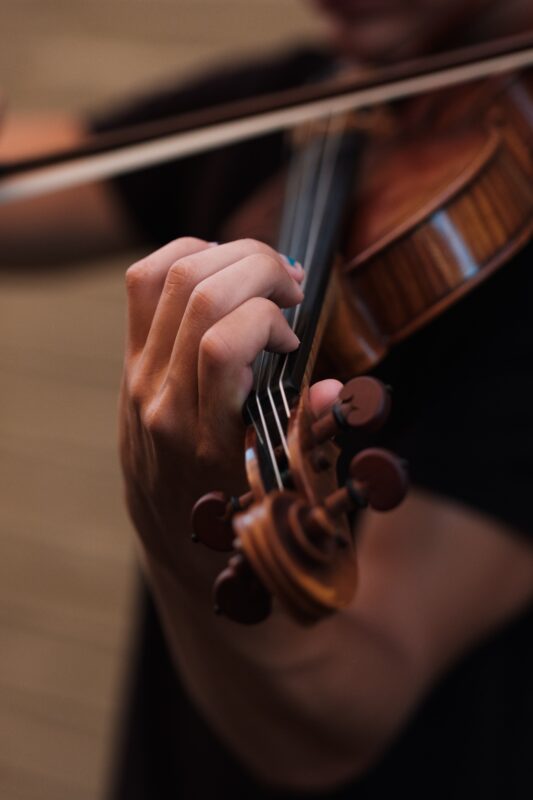
You were lucky the get tickets for the Tafelmusik late-night concert. You arrive an hour early for check-in, as required, and stand in a well-spaced line in the cordoned-off section of now pedestrianized Bloor Street. Your mask is inspected, your temperature taken, you are asked some routine questions about your health (all rather reminiscent of flying to the US in the old days—when we could do that), and are then directed to your seat, four seats away from the next person, empty rows in front and behind. The tang of bleach competes with wood polish. At least there’s space to put your coat, scarf, and mitts (it has been an especially cold March). You nod at your nearest neighbours, an indistinct gesture that could mean “Why on earth are we here?”
The tiny orchestra is spread out over the whole dais. The string players are all wearing masks, the harpsichordist is wearing gloves, and the oboist is inside a plexiglass booth, standing on a disposable absorbent mat. The choir, of course, has been furloughed—they are supervectors. According to the program notes, which you read on your phone, you’ll be hearing music from seventeenth-century Venice composed in thanksgiving for deliverance from the plague. The oboe gives a note and the strings begin tuning up; at this sound, neither music nor noise, you shiver with unpremeditated delight. It has been almost a year since you heard any live music—other than the neighbour’s daughter practising clarinet. You realize in that instant how heartsick you have become with the diet of autotuned, click-tracked, virtual ensembles.
You can’t take you eyes off the three-dimensional, flesh and blood performers. They make occasional eye contact with each other at beginnings and endings but for the most part, like geese in formation, they sense together the music’s flight, bobbing and weaving as one. Carried along with them, your spirit soars, your pulse quickens. Behind your mask, you chuckle with nervous joy. They play for an hour (no interval, no washrooms, merchandise for sale online only) but it passes in moments. Your final applause is exuberant, reverberant, as you try to fill the space with the appreciation of an absent crowd.
Sunday morning
At St. Basil’s, you join the ticket-holders for the 11:07 mass (“enter through the west door, please stand on the red dots”), where your mask is inspected and your temperature taken. Once the 10:30 mass is over, you file up the stairs into church. Household groups sit together; others sit in isolation. You choose a spot in the sightlines of the camera live-streaming the mass on the parish’s YouTube channel. Your mother will be watching (“No, not lingering adolescent guilt,” you insist: “it will lift her spirits to know she has a proxy at mass”). You greet parishioners whose names you now know from Zoomed faith-sharing sessions. Stilted remarks are exchanged across the voids but, like teenagers, you have learnt to save your most vulnerable conversations for social media. Gloved sacristans lay out all the necessaries next to the altar; there will be no servers.
The entrance hymn is sung by an unseen cantor and although the words are projected onto two large screens, you are encouraged only to hum along quietly (“Singing is worse than coughing”). This suits you, since you are a reluctant singer—unless it’s “Come all Ye Faithful,” “Amazing Grace,” or that bit from the Mass of Creation that everyone knows. You recall the choir director who insisted that singing is all health benefits and no side effects—you wonder how he’s enjoying his humming. Readers proclaim the scriptures from individual iPads. The priest’s homily is polished—which is not surprising given the number of times he has preached it today. Occasionally he turns to the camera to address the over-60s watching from home. He looks tired. You enjoy the reminder that the collection basket has been stood down (“temporarily, of course”), and nag yourself (again!) to go online as soon as you get home to make your donation.
Bread and wine are prepared at the altar. The organ plays softly, a half-disguised melody accompanied by the clink of the cruets on the chalice. The sight of the empty seats conjures up the parishioners who normally occupy them, and your mind’s eye is flooded with images of warm, colourful, singing bodies. In among them, you wonder if you really do see faces of angels, apostles, martyrs—a shimmer of countless holy ones.
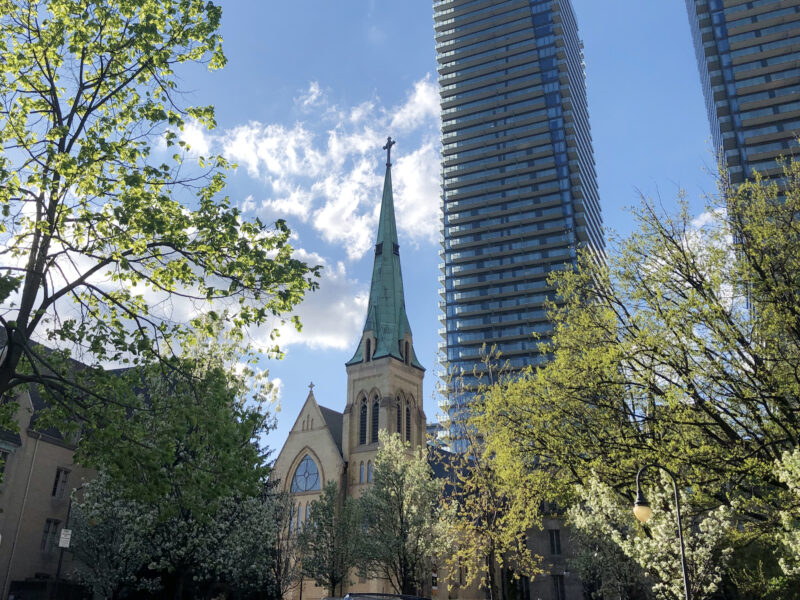
Communion is a regimented, high-alert manoeuvre. You make your way forward biddably. Against all reason, you lower your mask. As the social distance collapses to near-zero, the minister deftly drops the host onto your well-scrubbed hands. You exhale your Amen. Back in your seat, you savour communion. You think of those you love, those in need, those who have not made it this far. While the invisible cantor reminds you to taste and see how good the Lord is, your prayers rise on clouds of Purell and latex powder.
After the closing devotionals (St. Michael has been joined by St. Blaise and St. Roch), you leave the church in an orderly fashion (“exit through the east door”). The organ postlude is almost loud enough to drown out the sound of disinfectant being sprayed on the pews as the church is made ready for the 11:44 mass, the last one before the lunch break.
On the long walk home, your mind is a-chatter: yes, togetherness is in your genes, primates love to sing and laugh together, to feast and embrace. But as a rational primate, you have been hearing for months now that your neighbour is a potential biohazard—that you could be a biohazard—and that the only safe space is the digital universe, where viruses are metaphors.
When you get home and inside, you slump against the door, pull off your mask and take several long breaths. You’re exhausted. You’re blessed. You just might be hungry (you’re never sure these days).
The lockdown was not easy; but the opening-up feels much harder.
Sources
Guidelines for rehearsals and concerts during the pandemic have been issued by the German Orchestra Association’s Health and Prophylaxis Working Group and by seven orchestras in Berlin. Two bodies in the US have produced guidelines for the celebration of sacraments: the Thomistic Institute in Washington and the Federation of Diocesan Liturgical Commissions. An alliance of singing groups sponsored a webinar on the near future of singing.
Read other InsightOut posts.
The Vatican has designated May 16–24, 2020 Laudato Si’ Week to mark the 5th anniversary of the completion of Pope Francis’s groundbreaking document Laudato Si’: On care for our common home. (The document was formally signed on May 24, 2015 and released on June 18, 2015.) The global campaign is sponsored by the Vatican’s Dicastery for Promoting Human Development, and is designed to spur Catholics to become more involved in environmental action.
Dr. Dennis O’Hara, who authored the reflection below, edited a book on Laudato Si’ with Matt Eaton and Michael Ross. The book, Integral Ecology for a More Sustainable World: Dialogues with Laudato Si’, brought together scholars from around the world with diverse backgrounds, including Chris Hrynkow, Cardinal Turkson, Brother Guy Consolmagno (Director of the Vatican Observatory), Sue Rakoczy, and John Haught. Drs. O’Hara, Eaton and Hrynkow are graduates of the Elliott Allen Institute for Theology and Ecology at the Faculty of Theology, and Michael Ross is an EAITE doctoral student.
Laudato Si’ Five Years Later
Even before its promulgation on June 18, 2015, the papal encyclical, “Laudato Si’: On Care for Our Common Home,” had created tremendous advance interest. At the time, I was serving as Director of St. Michael’s Elliott Allen Institute for Theology and Ecology (EAITE) and thus was frequently invited to speculate on the possible content of the encyclical, including on a student radio show, at a conference on religion and cosmology at Yale University, and in parishes of both Christian and non-Christian faiths.
Prior to its official release, I was given an advance copy of the encyclical so that I could prepare for the anticipated media attention. Interviews for radio, television, and newspapers punctuated the next several days, to be followed by talks at conferences, for school boards and NGOs, and in many parishes, both in Canada and Korea. This unprecedented interest was echoed in the encyclical’s enthusiastic reception at the 21st Conference of the Parties (COP21) of the United Nations Framework Convention on Climate Change at Paris in 2015, resulting in the Paris Climate Agreement. The encyclical inspired the formation of hundreds of new Catholic organizations to advance its goals, including the Global Catholic Climate Movement (a global network of 900 Catholic organizations) and the Catholic Climate Covenant as well as numerous initiatives of religious orders and the expansion of the work of Catholic NGOs to address an increased concern for our common home. It also spurred the interfaith project Living the Change, and the formation of the Vatican Dicastery for Promoting Integral Human Development. The encyclical continues to be favourably referenced in academic circles among diverse disciplines, including theology, ecology, economics, justice, social studies, healthcare, and more.
With the advantage of five years since its release, a retrospective assessment of Laudato si’ gives a fuller appreciation of its accomplishments. For decades, ecotheologians had acknowledged the Christian teaching that there are two books of sacred revelation—viz., scripture and creation—bringing a renewed focus to exploring the theological and ethical implications of a more sympathetic and scholarly reading of the latter. They had been pioneering a deeper understanding of humanity’s role within the epic of evolution and advocating for a more integrated understanding of the myriad of justice issues related to the ecological crisis. Pope Francis’ first encyclical validated their decades of innovative work.
The call of Laudato si’ to recognize the integral ecology of creation and to engage in conversations of respectful dialogue with diverse voices from all sectors of society, emphasized the intersectionality of ecological, ethical, economic, political, social, gender, and justice issues. Through such efforts, the encyclical articulated a more robust and integrated version of Catholic Social Teaching. Concurrently, it required the conversion of ourselves and our cultures, eschewing a consumerist individuality in preference for the health of the common good and our common home. As the magnitude and urgency of the ecological crisis in its multiple forms became better understood within more disciplines and by more people, the comparable magnitude, complexity, and intersectionality of this conversion also became more apparent.
Nevertheless, such awareness has not spurred an adequate response within either secular or religious institutions. For example, the concentration of greenhouse gases in the atmosphere continues to increase while the vitality of life on Earth declines despite generally universal calls for a vigorous reversal of both. This past November, the retiring president of the U.S. Conference of Catholic Bishops described climate change as “important but not urgent.” Yet as Msgr. Bruno Marie Duffe, secretary of the Dicastery for Promoting Integral Human Development warns, ” the alarming speed of climate change caused by human behavior and the choices we make threaten the very survival of species, water and air quality as well as food security. These are huge challenges…and the Paris Agreement is an absolute minimum and in fact does not go far enough.” Despite fine rhetoric, few nations are likely to reach the pledges they made with that agreement.
Laudato si’ continues to challenge this delinquency among nations and within its own Church. Its observations, assessments, and calls for action often serve as a standard against which efforts are measured or as an interlocutor that nurtures or guides responses to global crises. The contrast between the analyses and aspirations of the encyclical, and the anemic responses and sclerotic leadership still too often seen, shows that while the encyclical has had significant impact, the conversion it prescribes is far from realized. Like every good encyclical, Laudato si’ needs to be read and re-read to better understand and apply its message.
Assistant Professor, Christianity and Culture Stephen Tardif is now co-editor of The Hopkins Quarterly, an international journal of critical, scholarly, and appreciative responses to the lives and works of Gerard M. Hopkins, S.J., and his circle. He begins his duties at the same time as fellow co-editor Dr. Michael D. Hurley of Cambridge University.
“I’m delighted to be co-editing the Quarterly, which has been the major journal in Hopkins studies for almost a half-century,” Tardif says. “It’s also a great pleasure to extend The Hopkins Quarterly‘s long-standing connection to St. Michael’s College.” Past co-editors include St. Michael’s Professor Emeritus Joaquin Kuhn, who co-edited the journal for 25 years.
Founded in 1974, the journal publishes academic articles and book reviews, notes and notices, as well as special issues, from new and established scholars. The first issue of the journal under its new co-editors is now available, featuring articles on “The Wreck of the Deutschland” and Hopkins’ and Christina Rossetti’s poetic depictions of flux, and a number of book reviews.
Silvia Vong is Head of Public Services at the John M. Kelly Library and oversees the Access and Information Services department. Her research interests include critical reflective practice in academic librarianship. Currently, Silvia is a doctoral student at OISE in the University of Toronto working on research related to equity, diversity, and inclusion issues in higher education.
A Critical Reflection on Virtual Libraries
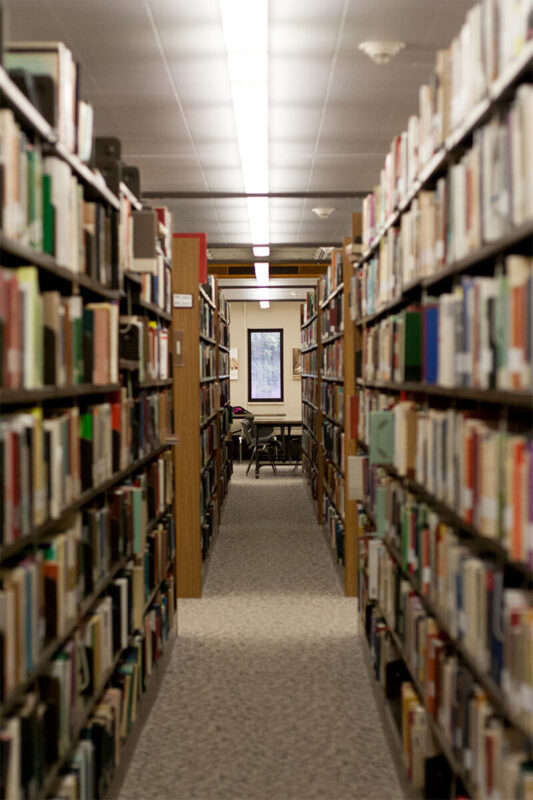
In my first year of the library and information science program at Western University, we were introduced to the idea of a code of ethics in librarianship. A code of ethics guides the values of a library professional and can manifest into actions such as advocating for open access or teaching critical thinking skills. Currently, the International Federation of Library Associations (IFLA) outlines six codes, and the one that holds the most weight for me is responsibilities towards individuals and society. This has led me to practice critical reflection in the classroom, and with our online library services.
While the coronavirus does not discriminate, people experiencing income inequalities, the digital divide, racism, and domestic violence have particularly suffered during this exceptional time. As the pandemic began, librarians began to critically reflect on access and service. Brookfield (1995) and Tripp (1993) offer insight into ways of critically reflecting, first by reviewing incidents and interactions, and then asking the following: What is the dominant view? How does this view silence other views? How does this dominant view ignore or serve dominant groups? How does it impact disadvantaged groups and what can we do to create a socially just structure to address this oppression?
In the first three weeks of the shutdown, I thought about how online access and research may inadvertently exclude some of our community members. Patrons may face financial stress during a pandemic and, in turn, not own laptops in good condition with proper software. Some patrons may not be home due to domestic violence, or be in places without Internet access. In addition, some of our patrons may not have the ability to access mental health services and other resources in the community that allow them to focus and succeed at learning. While e-books and online journals in some ways increase access, they can also create barriers to some of our community members. With social distancing restrictions in place, I struggled to find solutions that could help our marginalized community members.
As I continued to look for ways to be more inclusive, the University of Toronto was offering a session on COVID-19 through a diversity, equity, and inclusion lens. Income inequality and mental health were major themes of the presentation. However, the main takeaway was that under all the stress and anxiety that we all feel during this time, we need to remind ourselves to approach every decision-making process with empathy so that we can make socially just choices for our community.
My very inquisitive 4-year old daughter, Isabella, had overheard the webcast and peppered me with why, where, and how questions related to inequity and inequality in the university and the world. One evening, while munching away at her green beans with a furrowed brow, she paused suddenly, and her little face lit up. Isabella turned to me and said, “Mama, I know how we can make the world better. If we, and anyone with a little extra, could give it away…people with nothing would be safe from bad things.” Oh my heart! My enlightened little one was absorbing my conversations and reflections on the ethical responsibility that we, as members of society, all have during this pandemic.
To put her idea to practice, Isabella and I identified a way to safely help others. We decided to donate to the Daily Bread Food Bank to give our “little extra” to someone in need. Isabella’s reflective thoughts on the pandemic reminded me that while I could not make one big change to help others, I could still find several small ways to reach out and help our community.
Read other InsightOut posts.
Professor Emeritus Dennis Patrick O’Hara is the former Director of the Elliott Allen Institute for Theology and Ecology at the St. Michael’s Faculty of Theology, where he taught from 2002-2019, and directed many theses in ecotheology and ethics. He was also an associate member of the graduate faculty at the School for Environment at the University of Toronto. In addition to teaching courses in ecological theology, spirituality, ethics, and sustainability, he has worked for the World Health Organization and Health Canada researching and preparing policy positions. He regularly delivers both popular and academic lectures in Canada and the USA but has also lectured in Europe and South Korea. Prior to becoming a theologian, he practised as a chiropractor and naturopathic doctor, and taught at colleges of both of those professions.
Moments of Grace and COVID-19
Basil of Caesarea, in Rule LV: Whether the Use of Medicinal Remedies is consistent with the Ideal of Piety, instructs that a serious illness can be sufficiently disruptive to our normal patterns of living that it can force us to consider the circumstances that led to our illness and to re-evaluate our choices so that we can once again align our life with the telos of God’s creation. This opportunity can be identified as a moment of grace, on a religious level.
Thomas Berry notes that moments of grace can also occur on cosmic and historical levels, such as the dispersal of primary element via the explosion of stars or the development of photosynthesis. Throughout the 13.8-billion-year history of the universe, change occurs when systems reach the most tension that they can creatively endure. At that point, systems evolve irreversibly by transforming into a new level of order and complexity by resolving the dangerous tension in an unprecedented way. In many respects, we are at such a moment, in part due to the COVID-19 pandemic and in part due to an ecological crisis magnified by climate change.
The people who are suffering the most due to the ecological crisis with its complex interwoven array of hardships will undoubtedly be least able to withstand the consequences of the COVID-19 pandemic with its threats to personal health and reduced access to supportive infrastructures. Both the ecological crisis and the COVID-19 pandemic are anthropogenic crises on a global scale, and both require a commensurate response. This pandemic has demonstrated the enormous actions we will take when we decide to act for the common good as a single Earth community. Despite decades of exasperating delay to curtail climate change, when faced with this pandemic, nations rapidly instituted measures to restrict travel, pause economies, enforce physical distancing, and impose domestic isolation. Perhaps such a collective and purposeful response could become a rehearsal for addressing Earth’s ecological challenges as we creatively seek ways of being that are mutually enhancing for us and the rest of the Earth community.
Pope Francis, in an interview with Austen Ivereigh from the University of Oxford concerning this pandemic, noted that the great uncertainty of this present moment is “a time for inventing, for creativity” because “every crisis contains both danger and opportunity: the opportunity to move out from the danger” through conversion, including “the decisive step to move from using and misusing nature.” Ecotheology reminds us that we have a common origin and share a common sacred story with all of Earth. We need to reframe our choices to better align with the creative dynamics and the telos of that story for we will go into the future as a single Earth community or not at all.
Read other InsightOut posts.
Dr. Callie Callon is a New Testament scholar at the Faculty of Theology who has also taught at the undergraduate level for St. Michael’s. She is an expert in ancient physiognomy, looking at how early Christians used appearances to praise or impugn others. Her book, Reading Bodies: Physiognomy as a Strategy of Persuasion in Early Christian Discourse, was published in 2019 by Bloomsbury Publishing.
Healing Moistly in Ancient Times
Recently, Prime Minister Trudeau rather infamously suggested that wearing masks during the current health crisis will help prevent the transmission of the virus through saliva, or, as he phrased it, by “speaking moistly” on others in close proximity. As cringeworthy as this “terrible image” is to a contemporary audience, it likely would not have evoked the same reaction in an ancient Mediterranean one. In this context the use of saliva was considered by some to be highly efficacious in treating a number of various ailments.
Perhaps the most famous examples of this are found in the New Testament, where Jesus is depicted as using his own saliva in conjunction with healing some sensory afflictions. In the Gospel of Mark Jesus heals a person with hearing and speech impediments through his touch, prayer, and by spitting (7:31-53). Visual impairments are healed by him with the assistance of a topical application of his saliva in two accounts. In Mark, Jesus spits directly into the eyes of a supplicant prior to laying his hands on him (8:22-26). In the Gospel of John Jesus forms a paste made from saliva and earth which he the applies to the blind man’s eyes before instructing him to then go and wash in the pool of Siloam (9:6-7).
However, these were not the only people who were held to have regained their vision through the application of saliva in ancient texts. According to the first/second century historians Suetonius and Tacitus, the emperor Vespasian accomplished a similar feat through the use of his saliva (Vesp., 7.2; Hist., 4.81). Pliny the Elder, a natural historian from the first century, also attests to the use of saliva for ocular disorders, asserting that ophthalmia could be remedied by daily application of the spittle of a fasting person (N.H. 28.7). According to him, a fasting woman’s spittle was considered an extremely effective treatment for bloodshot eyes (N.H. 28.22)
Beyond eyesight, Pliny further relates a tradition that seems to have held the application of spittle from a fasting person as a particularly effective treatment for a variety of different complaints. To cite but a few examples, it was thought that the application of this type of spittle behind a person’s ear would soothe a disordered mind (N.H. 28.5), could be used to treat boils (N.H. 28.7) and to remove leprous spots (N.H. 28.7), and that a “crick in the neck may be got rid of by carrying fasting spittle to the right knee with the right hand, and to the left knee with the left” (N.H. 28.7).
Non-topical uses are also attested for a host of different ailments, ranging from warding off snakes to prevent poisonous bites (although should it enter their throats it purportedly destroys them [N.H. 7.2]), as a preventative against contracting epilepsy (N.H. 28.7), and as a means to secure the desired outcome of a healing incantation regarding foot pain, with the rather interesting stipulation that the accompanying words “must be recited sober” (Varro, Agr. 1.2.27).
Far from being a transmitter of health complications, in some ancient Mediterranean thought saliva was viewed as a means to resolve or even prevent them. While our present circumstances necessitate keeping our saliva to ourselves, there is still a wealth of actions drawn from the gospels that we can, have been, and should emulate: compassion, faith, love and care for others. And of course, social distancing (Mark 1:35; Luke 5:16; Matthew 14:13)!
Read other InsightOut posts.
Sheril Hook, chief librarian at the John M. Kelly Library, tells the story of a University of Toronto professor calling her recently for help. The professor simply couldn’t find the materials he was searching for—Syriac-Latin text editions for the Patrologia Orientalis series, as well as articles from Analecta Bollandiana. With just a little digging, she found them, digitized from the Pontifical Institute for Mediaeval Studies (PIMS) collection, which is housed at Kelly.
“U of T is one of the top research libraries in North America. I was confident I could find the materials,” Hook says.
A library can be hard enough for an expert to navigate, so asking students to find resources remotely during physical distancing can be a challenge for those already stressed over papers, exams, and an uncertain summer.
In response, Hook and Noel McFerran, Kelly’s Theology and Rare Books librarian, are hosting a virtual town hall on Wednesday, May 6 for students in the basic and advanced degree programs at the Faculty of Theology. The afternoon session is perfect timing for theology students enrolled in intersession courses. Eligible students have received an email with instruction on how to access the online gathering, and it will be recorded for anyone who cannot make the 3-4 p.m. time slot.
The librarians have three goals for the hour-long session, which will include a 15-minute presentation, as well as time for questions posted to the forum. First, they want to do a close look with students at the U of T catalogue, delving into some of the more advanced ways to search it to discover digitized materials.
“We’d like to show people how to find materials they didn’t anticipate being online,” Hook says.
Then, they will highlight materials that have been made temporarily available to students. While in this period of physical distancing due to COVID-19, for example, students can call on the HathiTrust Emergency Temporary Access Service.
The third thing McFerran wants to stress is that the Kelly librarians are constantly discovering new materials.
“Send us an email and ask us about availability,” he says. “Just last week I had to say ‘sorry, it’s not available’ to a request, but this week that material has been digitized, so I was able to help the student after all.”
“This is a great new opportunity for learning,” says Hook, who notes that Kelly Library plans to expand sessions in the fall semester to include undergraduate students as well. “It’s important to feel comfortable in asking for help. If you can’t find something, we will look for you, as we very likely have it.”
Dr. Reid B. Locklin is Associate Professor of Christianity and the Intellectual Tradition at the University of Toronto, a joint appointment with St Michael’s College and the Department for the Study of Religion. His research focuses on a range of issues in Comparative Theology and Hindu-Christian Studies, particularly the engagement between Christian thought and the Hindu tradition of Advaita Vedanta. He also writes on the scholarship of teaching and learning in theology and religion.
Catholics and Hindus, Together Alone
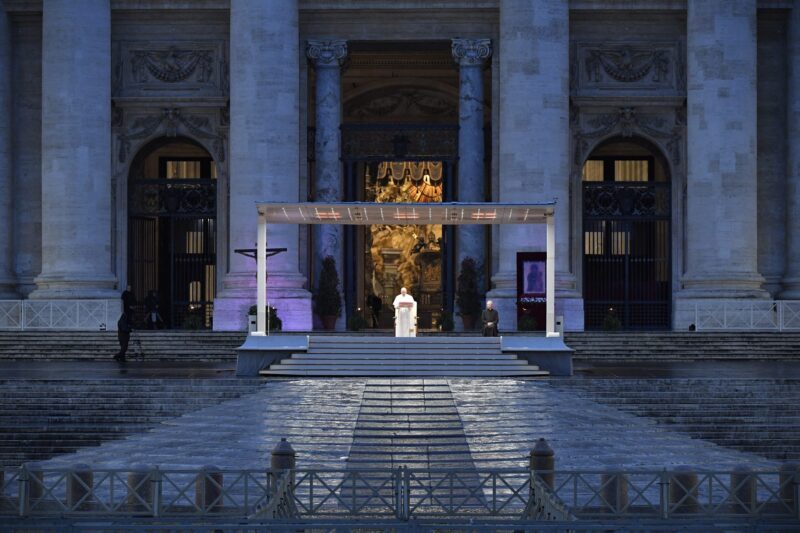
Like many Toronto Catholics, I began my observance of Holy Week this year in front of my family’s television, watching the Cardinal’s celebration of Palm Sunday in St. Michael’s Cathedral. A little over a week earlier, on March 27, I sat transfixed in front of my laptop computer as the pope pronounced a special Urbi et Orbi blessing to an eerie, empty St. Peter’s Square. My devotional life has moved nearly entirely online.
Catholics, of course, are not unique in this respect. Consider an “e-Satsangh” hosted on Facebook Live by the New York City-based Hindu movement Sadhana on April 2. In this event, a pandit offered a ritual puja in his apartment, presenting Sanskrit verses, water and other offerings to several Hindu deities well suited to the present crisis. These included the elephant-headed god Ganesha from a local temple in Flushing, New York; Arogya Lakshmi, the Goddess in the form of mother, health and power; and Sudarshana Vasudeva Dhanvantari, the god Vishnu in the form of a medicine healer. Following the puja, from a different apartment, one of Sadhana’s co-chairs guided virtual participants in a short meditation and hymns for the flourishing of all living beings. Discussion followed, ranging from the visceral—one participant sought advice on grieving the loss of a friend to COVID-19—to broader questions of advocacy and political organization. The focus here was on action: pragmatic service to those who are vulnerable, and also ritual action for their health and well-being.
Still more direct is the approach taken by residents of the Indian city of Mumbai, according to a widely circulated report. There, it seems, the Novel Coronavirus has been personified as an antigod or demon (asura). On the eve of the popular festival of Holi, effigies of this antigod—called Coronasur—were created and ritually destroyed, in an effort to halt the virus.
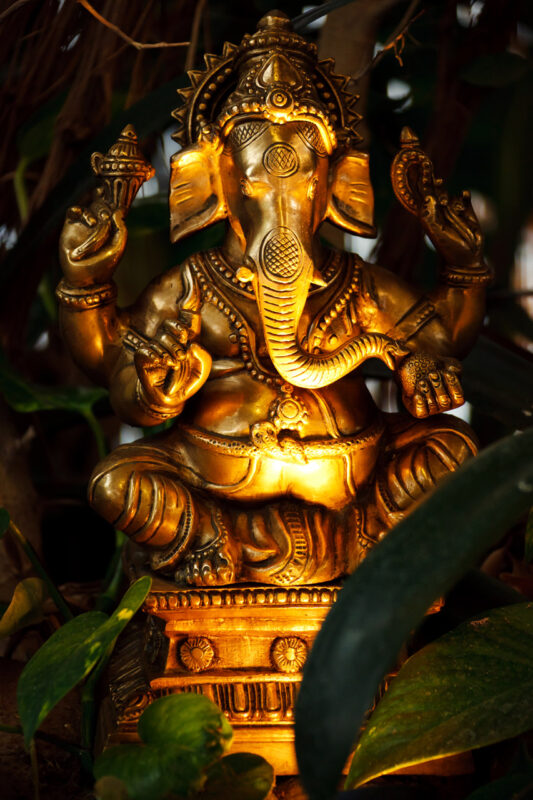
As a Catholic, I admit some discomfort with these rites, at several levels. But, also as a Catholic, I am obliged to approach such discomfort with an attitude of dialogue and exchange, rather than fear or condemnation. What might I learn from my Hindu neighbours about being a person of faith in this time of pandemic?
I think that the examples of Sadhana and even the Coronasur effigy offer an important reminder that Catholics, no less than Hindus, believe in the authentic power of ritual prayer. When Pope Francis raised the Blessed Sacrament and pronounced the Urbi et Orbi blessing on March 27, he was flanked by two icons that had defeated plagues in the past, Mary Salus Populis Romani and the Crucifix of San Marcello. This was a spiritual blessing, to be sure, an indulgence for those unable to receive the Rite of Reconciliation. But it was also an invocation of the power of God to intervene on behalf of those who are sick, and to arrest the devastation of COVID-19.
In the present crisis, some voices on the secular left and the religious right have called persons of faith to make a false choice: to follow the recommendations of public health officers, or to trust in the power of our shared prayer. Most Catholics, like most Hindus, refuse this choice. We embrace both the best science and the deep wisdom of our ritual traditions.
And so we vacate our churches and temples, and even St. Peter’s Square, to “flatten the curve.” But that need not, and cannot, stop us from persisting in our prayers. In this, Catholics, Hindus and many other others stand together, even while we are alone.
Read other InsightOut posts.
Readers looking for a new book to pass the time during social distancing will find many options for expanding their minds and imaginations in the work of authors at St. Michael’s. While the school has been a centre of excellence in teaching since its founding, USMC has also provided an institutional home to authors who have published in a wide variety of genres.
Advancing Research
Professors in St. Michael’s sponsored programs and the graduate Faculty of Theology publish scholarly monographs and edit collections of academic essays to advance research in their fields.
Alison More, holder of the inaugural Comper Professorship in Medieval Studies, explores the story of pious medieval laywomen in Fictive Orders and Feminine Religious Identities, 1200-1600 (Oxford University Press, 2018). Her book continues a long tradition of excellence in medieval scholarship and publication at St. Michael’s, which also includes the regular publication of books under the publications programme of the Pontifical Institute of Medieval Studies (PIMS).
Book and Media Studies is a natural fit for students interested in studying book history, but what about books themselves? St. Michael’s Assistant Professor Felan Parker made use of his cutting-edge work in game studies while co-editing Beyond the Sea: Navigating Bioshock (McGill-Queen’s University Press, 2018), a collection of critical essays on the beloved video game franchise. In the same department, professor Paolo Granata has written numerous books in Italian on media and media ecology, including the first guide to art resources on the web ever published in Italy.
Parker and Granata‘s BMS colleague Iris J. Gildea’s book Toward a Poetics of Freedom: An interpretive analysis of Ricoeur and Dante (Lambert Publishing: 2014) argues the thought of philosopher Paul Ricoeur changed after an encounter with the poetry of Dante Alighieri—and the great Italian poet is himself the focus of a special collection of rare books and illustrations housed in the Kelly Library.
Religion adds a special dimension to the scholarship of several St. Michael’s authors. Christianity and Culture professor Michael O’Connor’s Cajetan’s Biblical Commentaries: Motive and Method (Brill, 2017) has been described as “a very welcome addition to our knowledge of religious scholarship in the Renaissance.” Fellow Christianity and Culture prof Reid Locklin is the co-editor of Teaching Civic Engagement (Oxford University Press, 2016) a book that explores the role of religious education in fostering a vibrant democratic order.
On the civic theme, Canadian historian and St. Michael’s professor Mark McGowan is the author of historical studies such as The Imperial Irish: Canada’s Irish Catholics Fight the Great War (McGill-Queen’s University Press, 2017), which brings together Canadian religious and military history. His book It’s Our Turn: Carrying on the Work of Pioneers of Catholic Education in Ontario (Novalis, 2017) tells the story of Catholic education in Ontario, and casts a vision for its future.
Professors in the St. Michael’s Faculty of Theology advance scholarly conversations in fields ranging from Historical Theology to Interfaith Studies. Professor John McLaughlin, an Old Testament scholar recently appointed Interim Dean of the Faculty of Theology, has written numerous books including An Introduction to Israel’s Wisdom Traditions (Eerdmans, 2018), currently available in an e-book format for under $3. Professor Callie Callon’s Reading Bodies: Physiognomy as a Strategy of Persuasion in Early Christian Discourse (T&T Clark, 2019) explores the use of physiognomy in the rhetoric of early Christian theologians and writers.
Enriching Culture
Authors at St. Michael’s have also written for audiences outside the confines of academic disciplines. Principal and Vice-President Randy Boyagoda has published several critically acclaimed literary novels and a widely-reviewed biography of an important American Catholic public intellectual. He is currently at work on a Dantean trilogy of novels. The first, Original Prin (Biblioasis, 2018), is an academic satire set on the downtown campus of a Catholic university.
Celtic Studies Assistant Professor Máirtín Coilféir’s poem Cumhdach (Kelly Library Print Studio, 2019) was custom printed and bound at St. Michael’s. He is currently working on a translation of The Adventures of Huckleberry Finn into Irish.
Professors Boyagoda and Coilféir belong to a long lineage of creative writers at St. Michael’s. In the first half of the 20th century, Canadian novelist Morley Callaghan called St. Mike’s home. After graduating, he would help build the Canadian literary tradition with numerous novels, and short fiction for outlets like the New Yorker. Midcentury novelist Hugh Hood called St. Michael’s home as well, as have more recent creative writers such as poet Anne Carson, novelist Anthony De Sa, and Unbuilt Toronto author Mark Osbaldeston.
The literary legacy of St. Michael’s continues, with dozens of faculty and staff publications made available for borrowing from the Kelly Library in a special section near the entrance. The building is closed for now, but the list—including many more books that could not be mentioned here—is available online, with some books available for electronic borrowing.
University of St. Michael’s College President David Sylvester is pleased to announce the appointment of Dr. John McLaughlin to a two-year term as Interim Dean of the Faculty of Theology, effective July 1, 2020.
Dr. McLaughlin served as the Faculty’s Interim Dean in the 2014-15 academic year prior to Dr. Ginther’s arrival.
“St. Michael’s is fortunate to have such a capable administrator with a strong familiarity and history in the Faculty” says Dr. Sylvester. “Dr. McLaughlin’s presence in the Dean’s office will help make this process seamless, and I look forward to working with him in this role.”
A professor of Old Testament/Hebrew Bible, Dr. McLaughlin earned a BA from St. Thomas University in Fredericton, NB before enrolling at the University of Toronto, where he earned an MA in Philosophy. He then studied Theology and Scripture at St. Michael’s Faculty of Theology, earning an MDiv and a PhD.
Professor McLaughlin joined the St. Michael’s faculty in 2002 after teaching for seven years at Wheeling Jesuit University in Wheeling, West Virginia. He is an Associate Member of the Graduate Faculty with the Department of Near and Middle Eastern Civilizations at U of T, and is a past President of the Canadian Society of Biblical Studies. He currently serves on the Editorial Board of the Journal of Hebrew Scriptures and as an Associate Editor of the Catholic Biblical Quarterly.
Current Dean Dr. James Ginther completes his five-year term on June 30 of this year. After a 12-month research leave, Dr. Ginther, a mediaevalist and historical theologian, will return to the Faculty to teach and conduct research.
Dr. Sylvester has expressed his gratitude for Dr. Ginther’s service over the course of his term in the Dean’s office. “I would like to thank Dr. Ginther for his tremendous service to our community as a member of the President’s Advisory Group and Senior Administration team, in his leadership within the Toronto School of Theology, and in many other collaborative initiatives, including in his field of expertise at the Pontifical Institute of Medieval Studies and the Centre for Medieval Studies,” he says. “I look forward to Jim’s return to campus following his leave and to his renewed leadership at the University.”
Alison More came to St. Mike’s from the Centre for Medieval and Early Modern Studies at the University of Kent, where she designed and taught core courses on Latin and palaeography. She studied Latin in Rome with Reginald Foster, and has further developed her skills through teaching and research fellowships at Harvard, the University of Edinburgh, and Radboud Universiteit. A passionate Latinist, Alison is interested in alternative interpretations of absences and inconsistencies in the historical record. In particular, her research investigates the intersections between social and religious culture in Northern Europe from 1250 to 1450.
Sancta Corona, ora pro nobis

Medieval saints were often hailed as powerful intercessors in particular situations. Even today, St Anthony of Padua is a faithful helper for finding lost things; St Apollonia helps those in dental distress; and St Joseph of Cupertino is invoked by students taking exams. Recently, St Corona has re-entered popular religious consciousness as a protector against plague, pandemics, and infectious disease. After years of relative obscurity, Corona’s relics are now on display in a reliquary in Aachen Cathedral in Germany. Also, versions of her legend have been re-written for the Internet. While she is undoubtedly happy to intercede for the sufferings of the earthly Church, our health was not one of Corona’s traditional concerns. Her story is an interesting example of the ways in which saints’ cults adapt in accordance with the social needs of the day.
The tales of early Christian martyrs are generally formulaic. They contain little precise information and emphasize the gruesome deaths of their subjects. Corona’s tale is no exception, and we have little historical information about the saint. Her date of birth has been placed anywhere between 161 and 270 CE. She was married to a soldier named Victor at around the age of 15 and martyred one year and four months later. The Bollandist catalogues record more than 50 manuscripts of her vita, but all seem to be brief. Her short Passio in the Acta Sanctorum tells us that Corona’s profession of her illicit faith was an act of solidarity with Victor. After refusing to renounce Christ, Corona was tied to two trees, which her captors had bound together. When her tormentors cut the trees apart, Corona was ripped in two. Victor was then beheaded.
Until the current pandemic, there was little to connect Corona to viruses, plagues, or illness. Instead, her cult which existed primarily in Italy and the German regions appears to have been associated with the pursuit of fortune. Her name “Corona” is Latin for crown. In his work on treasure hunting, Johannes Dillinger points out that “corona” or “crown” was also the name given to a unit of currency in several countries. Whatever the reason, Corona found herself being invoked as the patron of treasure seekers. Dillinger points out that “Corona books,” texts midway between prayers and spells, circulated widely. Like prayers, they directed the supplicant to request Corona’s intercession. Like spells, the texts often seemed to depend on specific rituals and were even tailored to the amount of money in question. Later Corona texts even included methods of divining the lottery numbers. Not surprisingly, the lottery soon became another area of Corona’s patronage.
There does not appear to have been any association between Corona and plagues until 2020 when a virus that shared her name showed modern society to be less than invincible. Like our ancestors, our response was to seek divine aid and find a saintly intercessor as patron. Saints such as Roche and Sebastian were frequently invoked for protection against the plague in the 14th century. Their counterpart, the 12th-century St Rosalia of Palermo was called upon during an outbreak of illness in her native city during the 17th century. Notably, Rosalia has recently been featured in The New York Times as “The Saint Who Stopped an Epidemic on Lockdown in the Met.” In our current hour of need, those with an interest in saints discovered the existence of St Corona. As has been true of the cult of saints throughout Christian history, her devotees found a suitable association to declare her informally a patron of a crisis affecting the modern world. Her relics in Aachen, originally intended for a display on medieval metalwork, became a focal point for prayer and intercession. After several hundred years of relative quiet, she found herself being called upon as an intercessor.
Saints cannot exist in isolation. Instead, like all aspects of popular religion, their cults adapt to meet the needs of the society that venerates them. Throughout Christian history preachers and hagiographers have included imagery, allegory, and etymological devices based on saints’ names to communicate particular messages. The cult of saints has long illustrated the ways in which devotion could be incorporated into daily life. The case of Corona is no different: her name attracts attention and there is no reason to doubt her intercessory power. Perhaps this Easter Vigil, she will quietly be added to our litanies: Sancta Corona, ora pro nobis.
Works referenced:
“De SS. Victore milite et Corona martyribus in Ægypto,” AASS, May, t. III, pp. 265-67.
Johannes Dillinger, Magical Treasure Hunting in Europe and North America (London: Palgrave Macmillan, 2012).
Read other InsightOut posts.
With a new name, award, and enhanced value, St. Michael’s longstanding program in Corporate Social Responsibility entered a new phase last fall. The changes came not long before COVID-19 would create a context in which working for the common good — a signature emphasis of the program — would take on a new meaning.
“The Corporate Social Responsibility program is a vital offering at the University of St. Michael’s College, helping business and institutions focus on ways to become better — and more effective — global citizens, whether environmentally, socially, or economically,” says St. Michael’s President David Sylvester.
While today’s global citizens uphold the common good by practising social distancing to slow the spread of COVID-19, the changes wrought by the virus will create new context and opportunities for creating social impact in a post-pandemic world. Graduates of the St. Michael’s diploma program will be among the first to imagine new possibilities for our life together when social distancing is no longer required.
The CSR program is featured in the latest issue of St. Michael’s Alumni magazine, and reproduced below.
A Season of Transformation for St. Mike’s CSR Program
Updated name, new award, enhanced value all signs of program’s coming of age
No matter what stage of life you’re at, icebreakers can help the first day of school seem a little less daunting. But when the school is St. Mike’s, and the subject is corporate social responsibility, you can forget about standard tension diffusers like ‘tell two truths and one lie about yourself’ or pinning your birthplace on a giant map.
As participants in the 2019/2020 Graduate Diploma in Social Responsibility and Sustainability cohort met for the first time this past October, students were asked to chat with a seatmate and then present that person to the group by naming their core values. As the introductions circled Charbonnel Lounge, words like honesty, gratitude, compassion, respect, integrity and humour surfaced, indicators that this is not just any classroom.
For close to 20 years, University of St. Michael’s College has been the go-to school in Canada to study Corporate Social Responsibility, an operational philosophy also known by a variety of other labels, including ESG (Environmental, Social, and Governance), Corporate Citizenship, or Social Purpose and Social Innovation.
The common thread is an institution’s commitment to action that enhances the common good by adopting strategies such as environmentally friendly processes, fair labour practices, or corporate volunteer efforts. Proponents of CSR argue that a strong strategy can have multiple benefits, from answering shareholder concerns and aligning with a board’s ethics through to self-preservation and furthering employees’ sense of participation in something valuable, all factors that can contribute to a stronger bottom line.
“Corporate Social Responsibility is not just a set of [business] tools but a new outlook,” Program Manager Kathryn Cooper explains. “CSR helps you look at people in a more human way and, as such, it is transformational.
“When we talk about Corporate Social Responsibility or Citizenship, we talk about social and environmental impact. Today investors, consumers and global citizens want to know that organizations are not causing social or environmental damage. In fact, there is an expectation that companies are making a positive contribution to society and the planet.”
As an example, she cites athletics apparel giant Nike as a cautionary tale. When negative media reports on its international labour practices surfaced in 1996, stock value fell by 50% from $38 to $19 per share, while sales dropped almost 10%.
It is precisely the goal of positive change that makes St. Mike’s a logical host for the program, says University President David Sylvester, because the program’s goals and outcomes represent the long-standing values of St. Michael’s. There is a clear correlation, for example, between the topics studied in the program and the tenets of Catholic Social Teaching, whether the issue is environmental stewardship, concern for the marginalized or a driving interest in the common good, he explains.
As it approaches its third decade of operation, the St. Mike’s program is undergoing its own transformation, a sign of a coming of age not only of the program but also for the concept itself.
This past Fall, the program name of Corporate Social Responsibility was changed to the Graduate Diploma in Social Responsibility and Sustainability. Corporate no longer appears in the program name because the core concepts’ appeal reaches far beyond the business world. While the idea began with financial institutions, it is now being embraced by a variety of sectors, including health care, education, NGOs, and not-for-profit organizations, notes Cooper. Recent graduates from the St. Michael’s program have come from a diverse group of employers, including Toronto Hydro, Manulife Financial, the University of Calgary, and UNICEF.
“The idea of social responsibility used to be viewed as a public relations issue or the way to earn a ‘social licence to operate’, but it’s got far wider applications,” she says.
Sustainability has been added to the program’s name “in response to a global trend toward embedding environmental, social and governance issues in business,” Cooper adds. “To survive and thrive, organizations must focus beyond their bottom line, and create positive social impact.
“We make a lot of personal connections between values and ethics and urge people to take their whole selves to work.”
The name change also signals the program’s upgrade from a certificate to a diploma. Graduates of the 2018/2019 cohort were the first to receive diplomas at their November convocation, and are eligible to use the post-nominal letters G.Dipl.SR&S. The upgrade is a result of the increasingly academic nature of the program, says Dr. Sylvester, who notes that when the motion to change the program to a diploma was put before St. Michael’s Senate, it was unanimously approved.
The changes to the CSR program come as St. Mike’s engages in its own strategic visioning exercise, notes Dr. Sylvester. St. Mike’s 180, Rooted in the Future seeks input from community members, asking how St. Mike’s can create a dynamic and abundant future as the school looks to its 180th anniversary in 2032.
St. Mike’s, like many other Canadian post-secondary institutions, is beginning to think more about the social impact of universities, and is looking to imbed related language and goals, examining everything from purchasing and infrastructure to examining a school’s relevance and how it engages with the community, he adds.
“We want to turn research and teaching on the community as a vibrant force, because universities must be engaged in the community to have relevance,” Dr. Sylvester says.
The Social Responsibility and Sustainability program at St. Mike’s runs over 13 months, and consists of three sets of in-class sessions throughout that period, for a total of 11 days on campus. In between the three on-campus sessions, participants engage in reading assignments, participate in webinars, post reflections, meet with mentors who provide advice and guidance on a capstone project, and stay in touch as a cohort through a special web portal. As each cohort is capped at 30 students, both participants and instructors get to know each other well, with plenty of time for discussion.
On-campus sessions include workshops on everything from making the business case for social and environmental responsibility to how to apply CSR and sustainability strategies in the workplace through the development and implementation of diversity and inclusion, community investment, ethics and reporting and communication policies and procedures.
The program draws three types of participants, Cooper notes. Some are tapped on the shoulder by employers wanting participants to develop their company’s CSR or Sustainability Strategy. Others are looking for a purpose-focused mid-career transition, while a third group consists of younger people who have graduated with theoretical knowledge about sustainability and CSR but are looking to learn from mentors and program participants with practical experience.
Participants have two major assignments, as well as a capstone project where they work with a seasoned CSR and sustainability mentor to undertake a practical social responsibility and sustainability project. Students identify their project’s outcomes and methodology, as well as how to socialize the plan with key stakeholders, she explains.
Past projects have included Community Investment Strategies, Volunteer Programs, Environmental Sustainability Initiatives, Indigenous Impact and Sustainability Reports and CSR/Sustainability Strategies.
The ability to connect with experts, as well as to meet others in similar fields grappling with similar questions, is one of the big draws for the program, graduates note.
“It’s a top-notch program, the only one of its kind in Canada connecting like-minded people with similar passions in Corporate Social Responsibility,” says Alexandra Biron, who is Assistant Manager, Corporate Responsibility at professional services firm Deloitte in Toronto. She looked at online offerings from other schools but was drawn to St. Mike’s both because of the in-person sessions, as well as what she heard from former students.
“You can find a lot of information online but the network of professors and speakers is what’s most valuable. You are a cohort with a diverse group in terms of age, sector, experience, background, and even with those who might not come from a CSR background but are looking to change fields,” Biron explains. “These people share their struggles and high points, especially as so much can happen in 13 months. These are people with similar values and passions in a variety of jobs.”
Biron was one of the two winners of the inaugural President’s Capstone Award this past Fall for her project, entitled Deloitte Canada 2019 Indigenous Impact Report, which examined the impact [Deloitte has] made with Indigenous communities through pro bono work, volunteering, donations, sponsorships or serving as directors on boards.
“This report was the first of its kind for the firm. We publish an annual CR report but this was the first time we looked at the impact we were having with Indigenous communities. It’s led to an even bigger project, which is the firm’s Reconciliation Action Plan, which is set to launch in 2020 and will set the stage for how Deloitte will move forward on implementing TRC recommendations into its corporate life.”
Like Biron, Sarah Thirnbeck credits the program with offering her the skills to lead change in her workplace. Thirnbeck, who is Associate Director of Strategic Impact for the Canadian Real Estate Association in Ottawa, says of the program, “It changed my life.”
When moved from handling social media into her current duties this past Fall, Thirnbeck sought a program to help her create a vision for her new role.
While seeking resources online, she found mention of the St. Mike’s program “and it fulfilled all my expectations. I arrived on Day 1 knowing I wanted to develop a CSR strategy for my organization but I became like a sponge, soaking up information.”
Thirnbeck was the other winner of 2019 President’s Capstone award. Her project was titled “A CSR Strategy for the Canadian Real Estate Association.” It has already had an impact, as the Board of Directors of CREA agreed to include ethics, sustainability and social impact as a new priority in its strategic plan, based on her recommendation.
Now, she will begin implementing ideas from her project, including a green strategy, in her own office, with an eye to rolling them out to various local boards and offices across the country.
Program graduate Robert Waite now serves as a CSR mentor, working with and inspiring other students. Waite found himself in the program in 2008 while working at Canada Post, after he was asked to lead the effort of Crown Corporations in the area of environmental stewardship. Deciding he wanted an academic understanding of the program, he chose St. Mike’s because “I liked the structure. …It was more humanistic and less technical, with more emphasis on the soft skills. The program gave me the tools I needed,” says Waite, who went on to produce the first CSR report of any Crown Corporation, and hosted a meeting of various Crown Corporations to share best practices.
Waite, who now teaches at Seneca College and does consulting, says he decided on the St. Mike’s program for several reasons, including the fact that the small program, on a small campus within the enormous University of Toronto campus, had an intimacy to it.
The very nature of a liberal arts college is another, he adds.
“Climate change, for example, can be positioned as a moral issue, a philosophical one,” he says.
A few years after graduating, he was invited by a United Nations official to lecture on CSR to a group of postal agencies from 10 Caribbean countries.
“The materials I used were materials I gathered from St. Mike’s. It was a great feeling, as many participants’ countries were small and didn’t have the resources to take on issues like environmental stewardship. My ability to say yes can be tracked to my participation in the program. I have nothing but praise for the people who run the program.”
One of the influences he cites is Dr. Mimi Marrocco, who started the program in 2002, when she ran St. Mike’s continuing education program. In chatting with various stakeholders, it became clear to Dr. Marrocco that “the liberal arts had something to contribute to business, including creating the time to think,” she recalls. “Liberal arts allows for reflection.
“Sometimes, work environments can become siloed, but this program creates a forum to talk to like-minded people, and it presents the opportunity to make connections inside and outside.”
One of Dr. Marrocco’s first ideas for the program was to introduce a novel study to allow people to use their right brain, the hemisphere associated with creativity and innovation.
The first year, participants read E.M. Forster’s Howards End, which bears the epigraph Only Connect, a message she says underlines the program.
“We need slow knowledge, slow movements. We are busy people in business and
sometimes we fall into busyness, which doesn’t allow us to use the whole person.”
New grad Alexandra Biron agrees.
The program “provided me with a platform to combine my professional life and one of my passions…. My career may not have progressed the way it did so quickly without this experience.”
By Catherine Mulroney
From St. Michael’s Magazine: Winter 2020
Dr. Felan Parker is an Assistant Professor in the Book & Media Studies program specializing in digital media, video games, and media industries. His current research explores the production, distribution, and reception of independent or “indie” games.
The profile picture you see is Dr. Parker’s self-representation in the game Animal Crossing: New Horizons.
Comfort Games
Given the requirements of social distancing, it’s not surprising that people are turning to art and media of all kinds for much-needed escape. Video games are no exception: the industry is experiencing a not-insignificant sales bump, and game scholars and health experts are highlighting games as a way to stay connected and ease loneliness.
When we think about video games and escapism, most likely what comes to mind are action-oriented games of spectacle and hyper-masculine violence, and indeed those kinds of games loom large in the industry and culture of games. When I teach my first-year and fourth-year game studies seminars, part of the goal is to challenge this narrow mainstream conception of games as a cultural form. In that spirit, here are some reflections on three games in which I’ve found comfort and escape.
Animal Crossing: New Horizons, the latest entry in Nintendo’s popular franchise, was serendipitously released just as social distancing measures came into effect. New Horizons has resonated widely thanks to its gentle, colourful simulation of small town life (with anthropomorphic animal neighbours), its local and online multiplayer mode, and its “invest and express” customizability. I’ve been playing with my partner and six-year-old, and dressing up our cute little avatars and homes, sending in-game messages and gifts, and running around collaborating on projects together has been a joy. Part of what makes Animal Crossing so compelling is that it never ends, reliably changing in real time with the seasons; an ideal virtual getaway for an uncertain world (albeit premised on a peculiar utopian fantasy of resource extraction and consumerism).
A Short Hike, by Toronto game developer Adam Robinson-Yu, is a delightful pocket-sized world that takes significant inspiration from Animal Crossing but can be played in just an hour or two. The player takes the role of a young bird-person searching for cell phone reception in a provincial park. Along the way, there are numerous quirky characters to chat with, errands to run, and secrets to discover. The game shines in its ability to cultivate curiosity and encourage exploration, reinforced by the relaxing musical score and wonderfully pixelated natural environment. The hiking and climbing is complemented by a flying/gliding system, and I found the feeling of soaring across the landscape below deeply satisfying in this period of confinement, in particular during the game’s unexpectedly poignant climax.
The free browser-based tobogganing game Sanki is one of the purest distillations of that same feeling of speed and movement I’ve found in video games. Polish indie developer Krystian Majewski strips away all extrinsic goals and story until all that’s left is the hill, the snow, and the sled. The game is tiny, but has tremendous clarity of purpose in its muted palette of ultra-minimalist pixels and limited controls, perfectly capturing the serene sense of velocity I strongly associate with childhood winters in the Gatineau hills. The music is a bit giddy, so I turn it off and imagine the stillness interrupted only by gasping laughter. Each Sanki run is over in seconds, but I keep coming back to it for just one more.
Although quite different in form, content, and mode of production, each of these games offers an accessible, easy-to-play escape into gentle, comforting imaginary worlds. This is not to dismiss more fantastical and spectacular forms of escapism, but in this strange, liminal moment in time there’s something special about video games that playfully defy cultural expectations and embrace the simple pleasures of nature, movement, and everyday life.
Animal Crossing: New Horizons can be purchased digitally or physically for Nintendo Switch.
A Short Hike can be purchased digitally for Windows, Mac or Linux.
Sanki is playable for free in an ordinary web browser.
Read other InsightOut posts.
Because public masses have been cancelled due to the coronavirus pandemic, Dr. Darren Dias, O.P., has shared his homily for Easter.
Dr. Dias teaches in St. Michael’s Faculty of Theology, specializing in Trinity, Religious Diversity, and teaching methods. He is currently working of a SSHRC funded project with colleagues Gilles Routhier (Laval) and Michael Attridge (St. Michael’s) entitled: “One Canada Two Catholicism: Divergent Evolutions in the Catholic Church in Quebec And Ontario, 1965–1985.”
Seeing the God of Life
Easter Morning: John 20:1-18
The resurrection narrative of John’s Gospel account centres around the words “saw/look.” In the lection today we hear multiple instances. Mary Magdalene arrives in the dark, sees the stone removed from the entrance from the tomb and runs. The beloved disciple sees the wrappings in the tomb, but does not enter; he stops at the entrance. Peter goes into the tomb and sees the wrappings and the cloth rolled up. And then the beloved disciple enters the tomb and sees and believes. Mary stands outside the tomb weeping, and looks in and sees two angels there; she turns and sees Jesus but does not recognize him. And what are Jesus words to her?: “Whom are you looking for?” And when Mary realizes that she has encountered the risen Jesus she declares: “I have seen the Lord.”
The contrast of light and darkness, blindness and sight runs throughout John’s Gospel account. Today we discover what, ultimately, John is speaking of: the darkness of Good Friday to the brightness of Easter; from Mary initially arriving at the tomb in the dark, a darkness that left her unable to see, to her encounter with the light of the risen Christ that enables her to declare: “I have seen the Lord.”
Mary’s declaration is not only testimony of the man Jesus being raised from the dead, but a witness to something more. Indeed, the God and Father of the risen Lord is our God and Father, too. A new relationship has been established in the cross and resurrection that we have all been made children of God: “I am ascending to my Father and your Father, to my God and your God.”
Celebrating Easter during the global COVID-19 pandemic raises many questions for us. Some of us stand at the entrance of the tomb staring in; some are looking at the linens confused; some have witnessed miracles and are still unsure of what’s going on; some have had a profound encounter with the Lord and don’t know which way to run. Each of us is on a unique journey of faith, a journey that is a constant back and forth from the darkness of Good Friday to the light of Easter. We all stand in the empty tomb this morning and ask ourselves: what’s going on? What could this mean?
In the midst of a health crisis that has resulted in suffering, illness, anxiety, and death, a situation that has affected every aspect of our daily lives —even our ability to celebrate Easter as we normally do—it may seem difficult to find God. But our narrative today reminds us that we are often unaware that what we are looking for in right in front of us. Like Mary who is looking for the dead body of Jesus when she is staring right at it—fully alive. The resurrection surely teaches us that ours is a God of surprises. None of Jesus’ followers ever expected him to be crucified, and even less could they imagine a resurrection. The God of life is often revealed in the places and spaces beyond any expectation or imaginings.
Today we stand at the entry of the empty tomb, the linens are wrapped up, and we don’t quite know what to make of things. All the resurrection accounts we read this Easter season are the stories of coming to see with the eyes of faith, whether Doubting Thomas next week or the Emmaus narrative the week after.
This morning the reality of the empty tomb confronts us. The experience of the risen Lord and the reality of COVID-19 empower us to see the world and our own lives like never before; to declare: I have seen the Lord.
Dr. Jean-Pierre Fortin is Assistant Professor of Practical Theology in the Faculty of Theology. Dr. Fortin teaches the Theology of Ministry and Reflection Seminar classes and also oversees field placements, an essential aspect of the Master of Divinity and Master of Religious Education programs at the Faculty. His research includes work in ecumenical dialogue.
Challenging Our Usual Ways of Living
According to the Gospel of John, when Jesus is brought before Pontius Pilate, he tells the Roman governor: “For this I was born, and for this I came into the world, to testify to the truth. Everyone who belongs to the truth listens to my voice” (John 18:37, NRSV). Jesus was born, came among us to bear witness to the truth. For Christians, who profess to be followers of Jesus, a fundamental task and challenge is to bear witness to Jesus. As it invites us to experience and celebrate the mystery of Christ’s Passion, death and resurrection in particular fashion, the Lenten/Easter season is a most suited time for us to reflect on the quality of the witness we bear to Christ.
The current COVID-19 pandemic has so challenged our usual ways of living, relating to, and serving one another that we are summoned to be creative and devise new ways of being faithful disciples of Christ. What does it mean to bear witness to Christ, celebrate and give praise to him in times of social distancing and isolation? How is the truth about the human condition (flaws and blessings) unveiled when humankind is confronted with challenges such as a global viral pandemic?
The recent closing of the USMC campus and the transfer of courses to online platforms have enabled me to witness both the turmoil that such a sudden change creates: administrators, professors, staff and students struggling to learn how to give/take courses, hold/participate in meetings, and host all sorts of academic activities online. The cancellation or postponing of so many public events, lectures, conferences, liturgies—even pub nights—led me to perceive that this year’s Lenten season would in a very real sense last much longer than 40 days. The extent of the transformation to which my working environment was being subjected fully came home when I realized I no longer had access to campus libraries and my office. At the same time, I have also witnessed how instructors and students have managed to break through technological walls to recreate communities of learning that enable insightful reflection and sharing.
In a time such as this, when we are likely to feel deeply unsettled, inadequately equipped, and summoned to take initiative and exercise leadership in unprecedented ways, we may relate to Pontius Pilate, who admits to being profoundly challenged by the person and words of Jesus when he responds to his testimony with an honest question: “What is truth?” (John 18:38) Pilate opens himself to the fact that he is encountering a reality he did not foresee. This encounter with truth in person may alter who he is in profound ways.
During this Holy Week and the following Easter season, then, as we face the COVID-19 pandemic, we may reflect on the ways Jesus questions our assumptions about our usual way of living and following him. We may also think about the questions we have been carrying with us for some time (perhaps a long time) which we know we should ask to Jesus in person. What are the questions that would liberate us, allowing us to pursue the truth revealed in Jesus in more faithful, complete fashion—especially now, in challenging times? We may bring these questions before Jesus in our prayer, with the desire and hope of being transformed so as to be able to bear witness to the truth that he is in and for times such as these.
Read other InsightOut posts.
For the students in Dr. Paolo Granata’s Media Ethics class at the University of St. Michael’s College, the theoretical suddenly — and urgently — became reality with the introduction of the COVID-19 social distancing guidelines.
“We were just discussing digital inclusion when self-isolation guidelines arose and students suddenly had a real-life experience of seeing how important digital inclusion really is,” explains Dr. Granata.
Digital inclusion, and its companion term, digital inequality, refer to the importance of fair access to both the tools and the data needed to participate in the digital world. In 2011, the United Nations’ Human Rights Council declared the Internet to be integral to human rights, and recommended that Internet access should be a priority for all.
The effects of the current pandemic bear this out, Dr. Granata says, with people needing access to the Internet not only to telecommute and take e-classes but also to do things like pay bills, order groceries and stay in touch with others to reduce isolation.
“Nobody should be left behind,” the professor says.
But everything from income levels to location can have an impact on how people are able to connect. Low-income families, for example, may not have a computer at home for children to do e-learning from home while people living outside of urban centres may have limited access to high-speed Internet, if they have access at all. In turn, working and learning from home can result in soaring data charges.
The closure of institutions due to coronavirus limits access to tools like loaner laptops from schools or banks of computers at libraries, Dr. Granata notes, while shuttered coffee shops and institutional sites means fewer Wi-fi hotspots, where users can find access without having to pay.
Even for those with technology at home, the various platforms now being called on for online learning and e-meetings requires updated software, and that can sideline even those with relatively new computers.
This new reality prompted Dr. Granata to work with his Media Ethics students, research assistants Simon Digby and Alexandra Katz, and the Media Ethics Lab at the University of Toronto to create a call to action on the topic of digital inequality. Titled #DigitalCloseness, the statement spells out how the private sector, various civic organizations, and private citizens all have a role to play both today as well as in the long term to ensure Internet access is available to all.
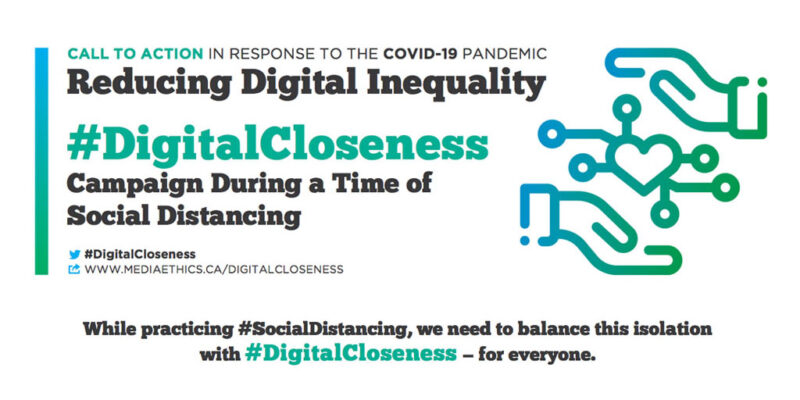
#DigitalCloseness suggests telecom companies, for example, forgive late payments and keep customers connected at this time, while it suggests community organizations and not-for-profit groups can offer access to free courses and virtual tours of exhibits.
In turn, private citizens with unlimited data are urged to share with a neighbour, to lend an extra device to someone who has no access, or to begin to build a virtual community to check in on others.
Going forward, Dr. Granata says, the conversation must continue with a variety of stakeholders to ensure there are ethical standards in the digital world to protect and further the common good.
There are conversations to be had, for example, in the subject of media literacy so that people do not fall prey to false or misleading information on social media, he says.
“We also need to urge legacy media to choose their words carefully for example, so that they avoid sensationalism by falling back on terms like ‘the battle’ or ‘the war’ on coronavirus,” he says.
Conversations about connectivity must also be mindful of who the most vulnerable are in our communities and work to include them.
For the students of the Winter 2020 session of Media Ethics, COVID-19 taught an invaluable lesson, Dr. Granata says.
“People often think that online and real life are two different things. They’re not, and this crisis has demonstrated it,” says, adding that it’s time for the broader population to become familiar with a term coined by Oxford Professor Luciano Floridi: “onlife.”
Then Jesus went with them to a place called Gethsemane; and he said to his disciples, “Sit here while I go over there and pray.” He took with him Peter and the two sons of Zebedee, and began to be grieved and agitated. Then he said to them, “I am deeply grieved, even to death; remain here, and stay awake with me.” And going a little farther, he threw himself on the ground and prayed, “My Father, if it is possible, let this cup pass from me; yet not what I want but what you want.” Then he came to the disciples and found them sleeping; and he said to Peter, “So, could you not stay awake with me one hour? Stay awake and pray that you may not come into the time of trial; the spirit indeed is willing, but the flesh is weak.” Again he went away for the second time and prayed, “My Father, if this cannot pass unless I drink it, your will be done.” Again he came and found them sleeping, for their eyes were heavy. So leaving them again, he went away and prayed for the third time, saying the same words. Then he came to the disciples and said to them, “Are you still sleeping and taking your rest? See, the hour is at hand, and the Son of Man is betrayed into the hands of sinners. Get up, let us be going. See, my betrayer is at hand.”
Matthew 26.36-46
The isolation of the Garden of Gethsemane takes on new meaning for many of us in this unprecedented experience of the season of Lent. As we move toward the Triduum, the pinnacle of the Church year, the COVID-19 pandemic and the resulting physical distancing which has closed churches to the public has forced all of us to rethink how we worship, as well as to remember why we do.
Normally at this time, our campus would be alive with students handing in papers, doing last-minute check-ins with professors, returning library books, and preparing for exams. They would also be visiting St. Basil’s, our beautiful collegiate church, attending one of the two daily masses, receiving the sacrament of reconciliation, and preparing to observe the passion, death and resurrection. There would be a sense of completion to the students’ year, as there would be for faculty and support staff. An academic year would be drawing to a close, just as Easter was about to herald new life.
In our current reality, however, norms have disappeared, which poses multiple challenges. But St. Michael’s is a collection of communities, including a community of faith, and so we thought we’d share a few thoughts on how to support each other as we prepare to say, once again, “He is risen!”
St. Michael’s alumni members have a long tradition of a Lenten retreat. When they were unable to meet together, Dr. Colleen Shantz, who was to lead the retreat with Dr. Darren Dias, O.P, created a virtual retreat, which you can find here. Thanks to both professors for their efforts.
Dr. Dias, who teaches Trinity in the Faculty of Theology, reminds us there are many ways to mark this holiest of seasons, even if we are not able to access our normal traditions.
For example, “people could do a solitary stations of the cross by walking outside and stopping to say a station prayer 14 times,” Fr. Dias suggests. “This would get people outside and attentive to the season.”
As well, “families could read and meditate upon the readings of the day. We can promote the domestic church in this way,” he adds. He also suggests calling an elderly or isolated person to pray with them over the phone, a very powerful reminder of the injunction of when two or more are gathered.
If you watch our website in the coming days, you’ll see homilies from Fr. Darren posted for both Palm Sunday and Easter, and Fr. Morgan Rice, CSB, will contribute the Holy Thursday post to InsightOut, our COVID-19-related blog, on Holy Thursday.
St. Basil’s links to some useful supports for prayer during Lent, and we applaud their efforts to help people in prayer at this unusual time. So, too, does the Archdiocese of Toronto, and we are grateful.
One of the nicest links we’ve seen is this one, which offers a heartfelt alternative to the usual Palm Sunday traditions.
While we may not be physically together on this Lenten journey, we are very much together in spirit, and we look forward to the day when we can gather together and say, “He is risen. Alleluia!”
Dr. Iris J. Gildea is an Associate Professor at the University of St. Michael’s College and teaches in the Book & Media Studies Program. Dr. Gildea’s areas of interest include Comparative Literature, Media Studies, Community Education and Expressive Arts.
A Collective Witness to our Interconnectivity
The week before our classes went online, my 4th-year seminar in the Book & Media Studies Program explored the topic of interconnectivity. We read a piece on the interconnection between humans and the environment by the American Buddhist and Deep Ecologist Joanna Macy. We went on a land walk in Queen’s Park and spent time alone in silence. Disconnected from technology and the need “to be somewhere,” we worked experientially with Macy’s theory.
Afterwards, back in the classroom for discussion, I quickly became aware that interconnectivity as a concept would take far more than the two hours I had scheduled for it! We’d spent the better part of the semester looking at art as a means of interrupting cycles of cultural violence. My students rightly pointed out that oppressions such as racism, colonialism and sexism are very solid impediments to the idea of connection that I was trying to invite through the Macy reading. I became aware that I needed to be more intentional about how I introduced her claim that despite such real oppression there is an inherent fabric of life woven together by the spirit of all that is. That this fabric is a connective tissue more primal than all the socially rooted injuries we create for each other and for this earth. To see why compassion is, for Macy, our route into becoming aware of such interconnection. Awareness, she claims, allows us to heal the world’s collective wound, a wound of which we are all a part. I was left feeling that I needed another route into opening up these topics.
Then our global crisis erupted.
Suddenly, we were thrust into a very clear example of how the actions of one person affect another person, of how people affect other people, of how changes in one system implement changes in another system. Our global community began to collectively witness and feel the impact of interconnectivity on so many levels.
Speaking of the world’s woundedness, Macy says that “Until we can see the world and touch the world, we cannot be part of its self-healing.”
“What does she mean?” I had asked my class.
It is a big question, and that day, in response, my students and I shared in a deep contemplative silence. A few days later, I could not help but feel that the very fabric of connection that deep ecology speaks of was answering us quite loudly as we began to witness the reality of pandemic and the collective suffering it manifests. “Is a deep wound asking us to help heal it?,” I wondered alone at home, reflecting on the class I had just taught in the face of what was happening in the world.
Joanna Macy also says, “If the world is to be healed through human efforts, I am convinced it will be by ordinary people, people whose love for this life is even greater than their fear.” As we re-emerge from this isolation, be it in weeks or months, healing, individual and collective, seems inevitable to me. I work in trauma theory and sometimes new and present traumas open older wounds buried beneath the surface, hidden and ignored but not forgotten. Sometimes doing the work to heal the present is how we heal the past. I cannot help but think this current crisis is also allowing us to access a deeper sense of interconnectivity, one whose roots take us beyond this present moment into the very fabric of relational life. Macy teaches that choosing love over fear cultivates the compassion that bridges the physical and emotional isolation that so many of us feel right now. I am sure it will be the bridge the heals us as we emerge changed, but not lost.
Read other InsightOut posts.
Because public masses have been cancelled due to the coronavirus pandemic, Dr. Darren Dias, O.P., has shared his homily for Palm Sunday.
Dr. Dias teaches in St. Michael’s Faculty of Theology, specializing in Trinity, Religious Diversity, and teaching methods. He is currently working of a SSHRC funded project with colleagues Gilles Routhier (Laval) and Michael Attridge (St Michael’s) entitled: “One Canada Two Catholicism: Divergent Evolutions in the Catholic Church in Quebec And Ontario, 1965–1985.”
Plunged into the Reality of Suffering and Death
Today is “Palm Sunday of the Passion of Our Lord.” It juxtaposes two events: Jesus’ triumphant entry into Jerusalem (Palm Sunday) and the immediate events surrounding his betrayal, arrest, trial and execution (Passion of Our Lord). These two contrasting events are captured in the liturgical celebration that begins with the proclamation of the Gospel narrative about Jesus’ triumphant entry into Jerusalem (this year Matthew 21:1-11). Normally this is followed by a joyful procession from outside the church to inside or within the church itself. We ritually perform what the evangelist describes: a rather chaotic scene of crowds, animals, cloths being thrown down, people chanting and waving branches.
But the exuberance of the triumphant entry into Jerusalem is short-lived. In the reading from Isaiah we are introduced to the maltreated teacher-servant and in Paul’s letter to the Philippians, a theological reflection on the death of Jesus. By the time we read the second Gospel lection, the passion according to Matthew, we are plunged into the reality of death. The lection ends with Jesus’ lifeless body being guarded in a sealed tomb.
On this Sunday, we go from the joyous chorus of “Hosanna to the Son of David! Blessed is the One who comes in the name of the Lord! Hosanna in the highest heaven” to the solitary cry of Jesus: “My God, my God, why have you forsaken me?” to the silence of the sealed tomb.
Death is an inescapable, existential, and mysterious experience. Yet it often catches us by surprise, no matter how prepared we think we are. When my own father died after a lengthy battle with cancer, knowing he was palliative, it still came as a shock. Nothing really prepares us for the mystery of death. In Matthew’s Gospel account the death of Jesus is predicted several times (Mt 16:21-28, 17:22-23, 20:17-19, 26:1-2), and yet we stand at the tomb plunged into the silence of this existential, inescapable and mysterious experience.
A few weeks ago the whole world was plunged into the reality of suffering and death as the COVID-19 virus swept across the globe. Though there were many warnings, no one seemed really prepared for the novel reality we are now living. We still don’t really know what will happen, we don’t yet have control of the situation. Today we stand in Golgotha, at the foot of the cross, lamenting that many have become ill and many have died, anxious because even more will become ill and die. We stand silent at the tomb.
Our Western culture has an odd relationship to death. We try to escape the reality of death and aging, celebrating youth, and constantly chasing after it. We sanitize our field of vision from human misery and suffering, yet we are bombarded with images of violence and death on our screens. Our fear of suffering and death is evidenced in our attempts to control death through the legalization of assisted suicide.
COVID-19 forces us to confront the inescapable, existential, mystery of death. We should not be too quick to say this will pass, that we will get through it, true as these sentiments may be. We want to get hurriedly to Easter and to the empty tomb, without keeping a long vigil at the foot of the cross. This year will be a long Good Friday. Jesus’s cry from the cross resounds with our own: My God, my God, why have you forsaken me?
In many societies and communities around the world, suffering and death is sadly the norm. Latin America theologian Gustavo Gutierrez, OP, draws our attention to the plight of so many millions who live in situations of death every day. For Gutierrez, the poverty he lives means death, lack of food, housing, education, healthcare, respect, dignity, freedom. Exploitation of the vulnerable and systemic violence is the never-ending lot of so many. He asks: how can we proclaim a God of life in this situation of death?
We are plunged into the reality of suffering and death in today’s liturgy and in our lived experience. I invite you to listen to Anton Bruckner’s moving setting of Philippians 2:8-9, Christus factus est, performed by the Choir of King’s College, Cambridge. This music draws us into the depths of the mystery of death and into the God of life.
Dr. Michael Attridge teaches historical and systematic theology at the Faculty of Theology. Recent courses he has taught include theological foundations, Christology, ecclesiology, 19th and 20th century theologians and movements, and the Second Vatican Council in Canada. He is currently involved as a co-investigator in a four-year, SSHRC-funded research project comparing the different forms of catholicism in Ontario and Quebec in the period following Vatican II through the lens of liturgy and catechesis, ecumenism and interfaith dialogue, and socio-political engagement.
Today’s piece was written in the midst of his self-isolation.
A Time for Gratitude

For each the past few years I’ve been fortunate to have travelled to Italy for short periods of time for research and study. Although I often make trips to Rome and Milan while I’m there, my home base is Siena, staying with the friars in the convent of the magnificent mediaeval basilica of San Domenico. Daily life is as peaceful as it is regular—liturgy, meals, study, and work. When I arrived, there were only a few cases of COVID-19 in Italy. All of this, though, changed quickly. On March 4, the government closed schools and universities, but we were still able to work online. On March 8, it locked down 16 million people in the north and, the following day, it did the same for all of Italy—restricting travel throughout the country. Within hours the airline emailed to say it was now only flying out of Rome. I knew I needed to leave immediately. A friend who works in the Lisbon airport was able to get me to Portugal the next day, March 10, on the airline’s last flight out of Italy. With the help of family, I self-quarantined in a small town near Fatima where my wife, Isilda, was raised. On Sunday, March 15, the day before Canada closed its borders, I caught my return flight home.
For the past nine days, I’ve been in self-quarantine in the same room in our house, staying apart from Isilda and our two teenage daughters. I can watch the news, work, read and stay in contact with colleagues and students through email and Zoom. In many ways life is as regular again as it was in the convent in Siena. But I’m realizing, too, how much my sense of time is also marked by daily movement—going to the kitchen for breakfast, walking to work or across campus, going for groceries in the evening. Time seems to be measured as much by going from place-to-place as it is by minutes and hours on the clock. Not having the same obligations of places to go or errands to run, has displaced this sense of time, and instead, I find myself feeling grateful—grateful for the people and communities that are coming together; grateful for the healthcare workers around the world who are treating the sick and the vulnerable. I’m even grateful for the political leaders at all levels in the country who are putting aside differences, following the scientists, and working together for the well-being of everyone.
Above all though, I’m grateful to Isilda and our daughters. Every morning, she and I have a coffee together, with her at one end of the hallway and me in my room. I’m grateful to her and the girls for doing what needs to be done around the house and to our younger daughter who’s been working overtime at our neighborhood grocery store. Last night the four of us sat together—again, them at one end of the hall and me inside my room, having dinner, laughing and sharing stories. I was reminded of Pope Francis’ tweet in October 2015, where he challenged people to “waste time” with others. It’s one of the most important things we can do. These days, as the entire world grinds to a halt and most of us are in social isolation, perhaps this is a moment to embrace our lack of movement, recalibrate our sense of time, reflect on those around us, and be grateful for one another.
Read other InsightOut posts.
Because Sunday Mass has been cancelled due to the coronavirus pandemic, Dr. Darren Dias, O.P., has shared his homily for this, the Fifth Sunday of Lent.
Dr. Dias teaches in St. Michael’s Faculty of Theology, specializing in Trinity, Religious Diversity, and teaching methods. He is currently working of a SSHRC funded project with colleagues Gilles Routhier (Laval) and Michael Attridge (St Michael’s) entitled: “One Canada Two Catholicism: Divergent Evolutions in the Catholic Church in Quebec And Ontario, 1965–1985.”
Tears of Compassion
John 11:1-45
“Jesus began to weep” is the shortest verse in the NRSV English translation of the New Testament. Yet this short verse says something terribly important about Jesus and his solidarity with us in our moments of difficulty and suffering.
In John’s Gospel account, Jesus’ friend Lazarus is ill and Jesus is summoned to his side by his sisters, Martha and Mary. But instead of hurrying to be with them, he waits another two days. He says that the death of Lazarus is an occasion for Jesus to be glorified. Jesus confidently refers to Lazarus’ death as “merely sleeping” and even says, “I’m glad I was not there so you may believe.” Jesus is strangely sanguine about his friend Lazarus’ death.
But as Jesus’ gets closer to the tomb, he becomes increasingly emotional. Twice, the Gospel lection says, “Jesus was greatly disturbed.” And then he began to weep. But why how do we account for this change of emotional state? One moment he seems placid and confident and the next he weeps. Does Jesus not think he will be able to “awaken” Lazarus anymore? Does Jesus suddenly doubt the life of the resurrection? Or the power of God to be glorified? Why the change?
In the Gospel lection, we read that “When Jesus saw Mary weeping, and the Jews who came with her also weeping, he was greatly disturbed in spirit and deeply moved…Jesus began to weep.” It was in his encounter with those who suffered loss and were grieving that Jesus began to weep. He is not weeping for Lazarus. He is weeping with, sharing in the suffering of others. Compassion is the source of Jesus’ tears.
Though Jesus is confident in his belief in the life of the resurrection, it doesn’t negate the real suffering of those who loved Lazarus, his sisters Mary and Martha, their friends, and Jesus himself. At the coming celebration of the Lord’s Passion on Good Friday we will read about Jesus in the letter to the Hebrews: “For we do not have a high priest who is unable to sympathize with our weaknesses, but one who has similarly been tested in every way.”
Compassion comes from the Latin word “to suffer with.” We often experience the suffering of others, whether vicariously or else because we have memories of similar suffering. Suffering is part of our human condition. And solidarity in suffering reveals the depth of our humanity.
The current COVID-19 crisis reminds us how interconnected the human family really is. We are “deeply moved” by the dedication of medical professionals and other front line workers. When I’ve gone to the store to buy necessities, I’ve been struck by the friendliness and dedication of workers in drugstores and grocery stores in very difficult circumstances. We are “disturbed in spirit” by the lack of ventilators for all those who may need them. We “weep” at the deaths of so many around the world, and of their families who are unable to bury them at this time. We are experiencing a deep sense of togetherness around the globe because we are all affected, and we all wait with some anxiety, for an unknown future. As we stand at the entry of the tomb, we ask what will Easter look like this year.
Our Gospel lection today reminds us that the God of life is not unaffected by our situation. Indeed “the Christ, the Son of God, the one coming into the world,” our “high priest” weeps with us, with compassion for the suffering, anxious, sorrowful and grieving.
Note: This article was written before the COVID-19 pandemic. While athletics are central to St. Michael’s, current social distancing measures have put this part of campus life on hold.
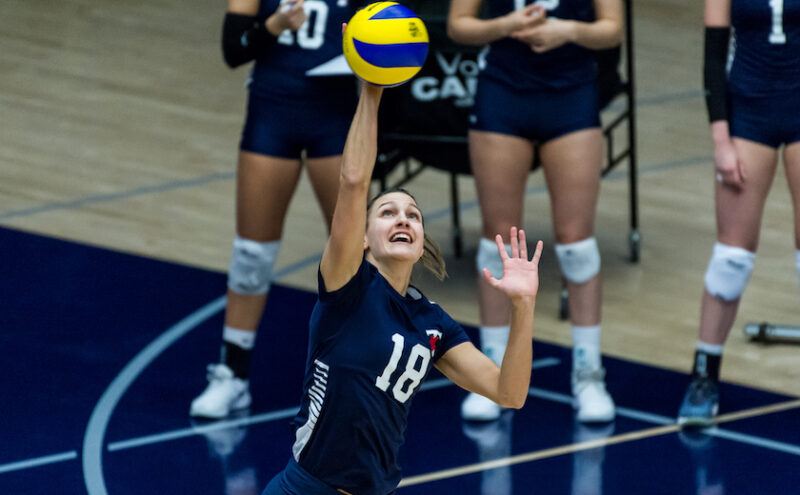
Central to St. Michael’s since its founding, athletics continues to reflect our commitment to educating the whole person
A new skating rink in the quad is the latest reminder that athletics matter to the University of St. Michael’s College. Walk through campus and you’ll see a pick-up game of basketball or a quick toss of a Frisbee outside the COOP. Intra-mural teams are thriving, and we currently are home to 98 varsity athletes, competing in 21 different sports.
It’s no accident that St. Mike’s has a storied history of athletics. One of our guiding principles has always been that supporting athletics reflects a commitment to the formation of the whole person, with the physical rigours of the playing field complementing the intellectual rigours of the classroom.
Athletics also serve as a major source of community and school spirit, whether students are involved primarily with an intramural team or with a nationally ranked Varsity Blues squad. Participation offers a way to develop gifts shared in community, an expression of our calling to service.
St. Michael’s has long been a sports powerhouse. As noted in Edward J. Monahan’s (USMC Class of 1949) Teach Me Goodness, Truth and Knowledge: A History of St. Michael’s College, for example, in the first half of the 20th century, St. Mike’s rose to become a regional centre of collegiate athletics. We even had Basilians competing for St. Mike’s: one notable example is Father David Bauer, who helped a 1945 SMC team win the Memorial Cup, and who gave up a career in the NHL to join the priesthood. He later coached Canada’s Olympic hockey team, and was admitted to the Hockey Hall of Fame posthumously in 1988.
Today, a whopping 33 members of this year’s Varsity Blues Football team call St. Mike’s home, attracted by our reputation for being a supportive community aware of the importance of athletics. We can say with confidence that St. Mike’s is the college of choice for athletically minded students.
My introduction to St. Mike’s athletics came when I moved into residence here as a student in 1995. In May of that year I flew to the Big Smoke from Victoria B.C. to find a place to live for the Fall. I knew only one person in Toronto, a former high school classmate named Laura. She nixed my idea of searching off-campus, telling me to look for a dorm. When I asked for a recommendation, she said: “St. Mike’s. It’s Catholic, it’s a big sports college and it’s right across the street.” The prospect of living close to my only Toronto friend became even more appealing after meeting her roommate, a beautiful Victoria College student to whom I’ve now been married for the past 18 years, but I digress.
I soon discovered why Laura referred to St. Mike’s as a “big sports college.” The residence houses all competed for the coveted Dean’s Cup sports trophy, the College’s teams were perennial contenders in U of T’s intramural leagues, and St. Mike’s was the only college to have its own fully stocked weight room.
One day, as I chatted with housemates in the Canada Room, one of the dons dropped by to say he’d been asked to recruit players for the annual ‘alumni vs students’ football game. Our group didn’t ask many follow-up questions because it sounded like the perfect way to spend a Fall afternoon.
But it wasn’t until I played in that Boozer Brown game in mid-October that I realized how deep the sports roots ran at St. Mike’s. U of T’s football program had run from 1895 to 1994, for example, and during that 100-year span, St. Mike’s had won the Mulock Cup 12 times, including ‘back-to-back-to-back’ victories the final three years. No wonder former players were so eager to relive their glory days.
The alumni team was composed of players from a now-defunct intra-mural league that used to play tackle football. Due to liability issues the tackle program had folded a couple years prior, but the alumni weren’t about to let their annual tradition die with the league. These guys were premier athletes in their day and this game was an excuse to return to their alma mater and prove they hadn’t lost a step.
As our respective squads began running drills, I sized up the competition. Some looked older than my father while others appeared younger than my then-25-year-old self. St. Mike’s jerseys of uncertain vintage were worn proudly but loosely due to the absence of pads, and a few of the old-timers brought their families along, lending a homecoming-type feel. Led by the larger-than-life booster Phil Giroday (USMC Class of 1977), our teams huddled up to go over the rules, flip the ceremonial coin and then the 27th installment of the Boozer Brown got under way.
It was obvious the alumni had come to play. I was stunned to hear their quarter-back calling plays – actual football plays like, “red dog five hook left” and “blue right 30 pull trap.” The ragtag group our dons had assembled possessed lots of talent but the coordinated approach of the alumni, coupled with the ‘creative officiating’ of former coach Lex Byrd, made it clear the alumni would be leaving with bragging rights. When the final whistle blew, the alumni had six touchdowns and the students four; you would have thought they’d won the lottery. (Lex, by the way, had coached the St. Mike’s team from 1978 to1993 and had led the team to an astonishing eight Mulock Cup championships.)
While reliving highlights at a post-game BBQ with the victors, I learned that the alumni-student game had been taking place since 1968. It was named after Bud “Boozer” Brown, a student instrumental in St. Mike’s winning its first football championship in 1930, the coveted Mulock Cup. I remember thinking how fortunate I was to have ended up at a college tailor-made for sports-minded students like me.
I attended the Boozer Brown again the following year as a student and then in 1998, St. Mike’s hired me as their new Dean of Men, involving me in the game in a new way. By this point, the intramural football program had folded, and some wondered how we’d be able to keep the alumni game going. But U of T began awarding the Mulock Cup to the winner of its intramural rugby program and by the mid-2000’s, SMC’s team was a powerhouse, regularly competing for the championship. I was very involved with the team back then and would always explain the historic connection between the football and rugby programs — and would inform our players it was their duty to participate in the annual Boozer Brown game!
Eventually, the intramural rugby league was discontinued, and it was once again time to re-imagine how best to keep the spirit of the Boozer Brown game alive. It was alumni athletes who came up with a great way to create a new athletics tradition. In the summer of 2019, a group of alumni approached USMC’s Advancement Office wanting to create two scholarships, male and female, to honour Lex, their former coach.
We decided to morph our annual alumni-versus-student game into an annual alumni-plus-student reception for the new award. The event would still give our football heroes the chance to connect with their teammates, but a more inclusive event would mean their ranks could be joined by all the great athletes, women and men, who’d competed for St. Mike’s over the years.
On November 30, 2019, SMC hosted the inaugural Boozer Brown Athletics Reception in Charbonnel Lounge. In addition to our esteemed alumni, we had a great turnout from our current crop of varsity athletes, all of whom were introduced by name in President Sylvester’s remarks. The women’s recipient of the initial Lex Byrd scholarship was Varsity Blues hockey forward Melissa Bieman, who is currently studying History and Philosophy. She came to the reception directly from Varsity Arena, where the Blues had just defeated Waterloo to move into first place in the OUA standings. Varsity Blues wide receiver Liam Cousineau, a 1st-year student whose goal is a double major in Political Science and International Relations, was the men’s recipient.
Attendees had an opportunity to reminisce about the past as well as stoke excitement for the future. While there may no longer be an alumni-student football game happening on the northeast corner of the campus, rest assured that sports are alive and well—and thriving!—at St. Mike’s.
By Duane Rendle, Dean of Students
From St. Michael’s Magazine: Winter 2020
Photos courtesy of the University of St. Michael’s College Archive. Check out more photos of athletics at St. Mike’s here:
Because Sunday Mass has been cancelled due to the coronavirus pandemic, Dr. Darren Dias, O.P., has shared his homily for this, the Fourth Sunday of Lent.
Dr. Dias teaches in St. Michael’s Faculty of Theology, specializing in Trinity, Religious Diversity, and teaching methods. He is currently working of a SSHRC funded project with colleagues Gilles Routhier (Laval) and Michael Attridge (St Michael’s) entitled: “One Canada Two Catholicism: Divergent Evolutions in the Catholic Church in Quebec And Ontario, 1965–1985.”
Finding God in Challenging Times
John 9:1-41
Amid this global COVID-19 pandemic, isolation and physical distancing are necessary to diminish the spread of the virus. In our time we can definitely understand the link between illness and isolation. In Jesus’ time, illness, and particularly something like blindness, was believed to be a punishment for the sins of one’s parents or ancestors. Thus, the question of the disciples to Jesus about the man born blind: “Who sinned this man or his parents?” Of course, Jesus’ answer is neither one; the very question misses the point. The man born blind would have been marginalized because his blindness was thought to be the product of divine punishment and so he would have been excluded from the normal network of social relations. We read that he had to beg for his livelihood. Like many other healing accounts, when Jesus heals this man he not only cures him physically but removes the reason for him to be excluded and isolated from his community. Jesus heals him and tells him to purify himself in the pool of Siloam so that he might be re-born into his community.
In the narrative the man born blind is cured of his blindness but only gradually begins to see. When initially questioned by Jesus’ critics about who opened his eyes, the man responds rather journalistically by recounting the events as they happened, not even mentioning Jesus by name. When pressed his questioners ask, “what do you say about him?” The man responds with the conviction: “He is a prophet.” His questioners react with a strong judgment against Jesus, calling him a sinner because he works on the Sabbath. Yet again they ask the man how is it that he now sees. Seemingly frustrated by their criticism of Jesus — and with firm conviction — the man says that Jesus is not a sinner but one who obeys and worships the true God of Israel and to whom God listens. The man’s questioners, those in power and authority, are scandalized that this poor beggar, a man born in sin else he would not have been blind, someone neither named nor vouched for by his own parents, would dare to teach them and so “they drove him out.” The man born blind, cured by Jesus, about to leave the isolation of his blindness behind, on the cusp of entering into social relationships, is driven out of the community he was never really a part of but longed to have a place. It is at this point, a low point for the man who has just been healed of his blindness, that Jesus seeks him out and finds him. In the brokenness and vulnerability of the man born blind, someone who has just gone from marginal to outcast, Jesus shares himself by revealing who he is: I am he, the one speaking to you is the Son of Man. Jesus chooses to reveal his true identity not to the powerful but to the outcast. Because of this intimate moment the man can finally answer the question that had been put to him throughout the narrative about the person who cured him. The man now sees who Jesus really is.
In our Gospel selection today the man born blind, though he had a powerful experience of healing, is only gradually able to see God’s vivid presence in his midst in the person of Jesus Christ. In these days, weeks and even months ahead, many will experience the difficulty of isolation and loneliness, and be challenged to see the God who seeks us and finds us in our vulnerability and fear. But just as Jesus revealed God’s presence in his very person, maybe God’s presence reveals itself to us in the midst of this present crisis: in the selfless dedication of medical workers; in the store workers who ensure our access to food and other supplies; in neighbours who check in on the elderly or vulnerable; in our prayerful solidarity with those who are ill from the virus.
President David Sylvester is pleased to announce the establishment of the Comper Professorship in Medieval Studies at the University of St. Michael’s College in the University of Toronto. This newly endowed position has been made possible by a foundational investment by St. Michael’s alumnus, Dr. Tony Comper, C.M., L.LD. (Hon). Dr. Sylvester is also delighted to announce that Dr. Alison More is appointed the inaugural holder of the Comper Professorship. Dr. More is a highly regarded Latinist whose research investigates the intersections of social and religious culture in late-medieval Northern Europe.
The donation reflects Dr. Comper’s firm belief that studying the humanities offers invaluable benefits both personally and professionally – and that St. Michael’s is on the right path with its renewal as a vibrant centre of undergraduate education at U of T. “Studying liberal arts, in particular literature, provides significant insight into human nature; (it offers) essential knowledge in interpersonal skills, the most important skill for success in business and indeed in life,” says Dr. Comper, who is the retired President and CEO of BMO Financial Group.
Dr. Comper recently returned to campus to take courses in Medieval Studies, a Faculty of Arts and Science undergraduate program sponsored by the University of St. Michael’s College that is available to all students in Arts and Science at the University of Toronto. This has given the philanthropist a front-row seat for the revitalization of Arts and Science undergraduate programs sponsored by St. Michael’s. Pleased with what he has seen, he has offered the university a unique hybrid investment in teaching by funding this position. The gift is comprised of a multi-million dollar bequest, and the promise of annual funding, effective immediately, in the intervening years to cover salary and benefits. This faculty position is one of six that St. Michael’s implemented in 2017 as part of its focus on teaching excellence in the four undergraduate programs it sponsors: Book and Media Studies, Christianity and Culture, Celtic Studies, and Medieval Studies.
Dr. Alison More came to the College from the Centre for Medieval and Early Modern Studies at the University of Kent where she designed and taught core courses on Latin and palaeography. She and the other assistant professors who joined the St. Michael’s community and broader University of Toronto three years ago have become a vital part of social and academic renewal. They have enhanced students’ learning experience through their own engaged and creative teaching and research interests and have contributed a great deal to the culture and community of the College beyond the classroom by supporting student-run initiatives and presenting public lectures for alumni. The Comper gift is creating great excitement on campus, as it represents the first step in the campaign to ensure the professorships remain permanent.
“This generous gift is an extraordinary demonstration of the confidence in the renaissance under way at St. Michael’s,” says Dr. David Sylvester, President and Vice-Chancellor. “It’s also a model of funding for other professorships, and an ideal example of how St. Mike’s continues to renew itself through endowed legacy positions. We’re thrilled that an outstanding philanthropist like Dr. Comper has demonstrated his dedication to his alma mater in this way.”
“St. Michael’s and the wider U of T share a long tradition of international excellence in the field of Medieval Studies,” says Professor Meric Gertler, President of the University of Toronto. “Dr. Tony Comper’s wonderful gift will help to strengthen that tradition for future generations, and to accelerate the renewal of undergraduate education at the College. His generosity also builds on his long record of leadership in the University community, including his previous service as Chair of U of T’s Governing Council, as well as his and his late wife Elizabeth’s support for the Anne Tanenbaum Centre for Jewish Studies. We applaud this latest contribution to our collective success.”
About Medieval Studies at The University of St. Michael’s College
With its strong combination of intensive Latin study alongside explorations of theology, literature, history, culture, and manuscripts, Medieval Studies invites students not just to study the Middle Ages, but instead to join a great tradition of inquiry and discovery enlivened by the world-renowned professors who have taught Medieval Studies at St. Michael’s over the years, including Étienne Gilson, Jacques Maritain, Msgr. Edward Synan, Sr. Frances Nims, IBVM, Sr. Mary Arthur Knowlton, CSJ, and Colin Chase.
The University of St. Michael’s College has a long tradition of teaching and research in medieval disciplines and its library has rich resources in the field. The PIMS library, which is housed in the John M. Kelly Library, includes rare, non-circulating books and draws scholars from around the world. The University of St. Michael’s College recently signed a five-year Memorandum of Understanding with PIMS and the University of Toronto recommitting to collaborative work in research, teaching and publication.
For more information, please contact:
usmc.communications@utoronto.ca
(416) 926-2267
We were very fortunate, this past Fall, that Anne Kingston, who died earlier this week, joined us as a Visiting Professor in Book and Media Studies. Anne was a bold and leading voice in Canadian journalism for many years, and particularly with respect to the rise of the #MeToo movement. In December, I expressed to Anne and her fellow Visiting Professor Jessica Johnson my great gratitude for what they made possible for our Book and Media Studies program, the broader College and the University in teaching a course on #MeToo and the Media. As a testament to her generosity of spirit and seriousness of focus, Anne immediately said she was the grateful one, for the chance to teach our students and be part of our academic community.
Randy Boyagoda
Principal and Vice-President
Remembrances:
“Anne Kingston, passionate writer who skewered modern culture and highlighted violence against women has died,” by Adrian Humphreys (National Post)
“Anne Kingston: A Quiet Fighter,” by Kenneth Whyte (Maclean’s)
“Anne Kingston remembered: ‘Passive was not a word she understood’” by Aaron Hutchins/Various (Maclean’s)
Principal Randy Boyagoda is happy to offer credit for St. Mike’s new first-term check-in program where it’s due: with the students themselves.
The program, which offers students the opportunity to be matched up with professors to chat about adjusting to university life, is the result of an idea brought to the Principal’s Office by SMCSU, St. Mike’s student union.
With concerns over student mental health continuing to make headlines across the country, touching everyone from parents and professors to roommates and friends, Professor Boyagoda says he was pleased when a group of students approached him last spring to ask what St. Mike’s was doing to promote mental health.
“A delegation from the Student Life committee met with me and wanted to know what was being done locally,” he recalls. “They asked what St. Mike’s could do to respond. The challenge came from students.”
In ensuing discussions about what causes students worry or distress, one of the issues that came to light was students’ anxiety over meeting with professors, an experience that is pretty much unavoidable over the course of four years of a post-secondary education.
“Students were telling us they felt intimidated. Our goal was the humanize the relationship,“ he says.
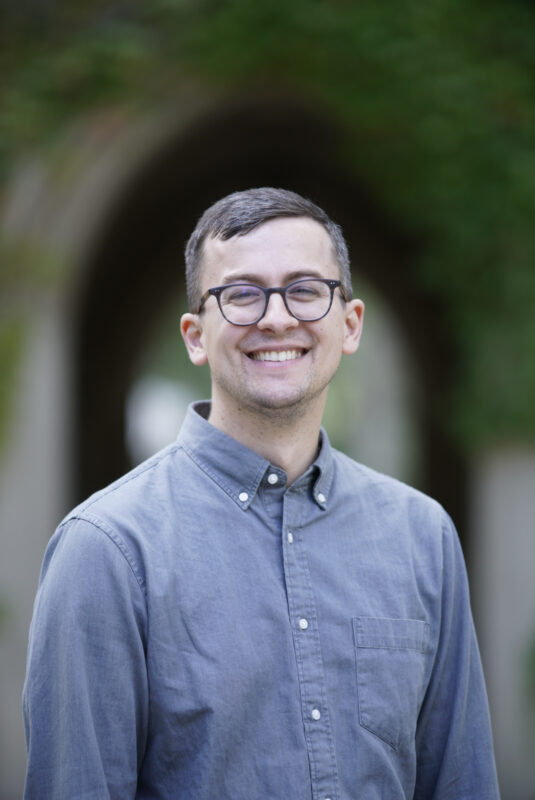
Working to overcome that challenge seemed like a good – and feasible – first step, and so the first-year check-in idea took root with the goal of normalizing professor-student meetings.
A quick survey of professors – both at St. Mike’s as well as fellows associated with St. Mike’s – indicated a great willingness to help, and the program was launched to success this past fall. The University of Toronto has taken notice of the program and is considering broader applications, Professor Boyagoda notes.
“This program is not about course advising. It is totally voluntary, and student-centred,” he says.
First-year student Lisa-marie Lofty took advantage of the new program, and says she found the opportunity to chat with Dr. Felan Parker helpful as she adjusted to life at St. Mike’s.
“We met early in the semester as I was still thinking about courses and we had a friendly conversation about things to consider as the year went on,” she recalled.
As someone who had attended boarding school four hours outside of Nairobi and was drawn to U of T in part because of the appeal of a big city, it was nice, once here, to have another friendly face to relate to, especially as Dr. Parker told her a bit about his own experiences as a student.
Mathematics professor and St. Mike’s fellow Dr. Mary Pugh also participated in the program after a student contacted her. She says the main message she conveyed was that the student could contact her at any time.
The program “gives students access to a disinterested/non-judgmental person who’s well-familiar with the Faculty of Arts & Science and its classes and programs; someone who can treat them like a human and offer support/advice if needed,” Dr. Pugh says.
As helpful as the program is proving to be for students, it is also proving to be educational for professors as well.
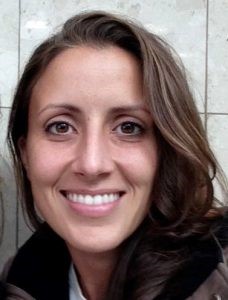
“Because I usually teach upper-year courses, I haven’t had much interaction with first-year students,” says Dr. Parker, who teaches in St. Mike’s Book and Media Studies program. “Contrary to popular myth, I’ve found that they are the opposite of entitled, frequently apologizing for asking for help and uncertain of what kind of support is available. My hope is that the first-year check-ins, along with other initiatives like the first-year foundations seminars, will help show students that we are here to help.”
Social worker Nicole LeBlanc, St. Mike’s in-house wellness counsellor, says first-year students can experience anxiety for a number of reasons. Everything from worry over marks and making friends through to loneliness and being far from home can make students feel anxious or depressed – or both.
“Students face a lot of pressure these days, whether it’s competition to get into graduate programs or wanting to please parents, or worry over expenses. Add in relational issues – the rules of engagement over dating and friendships, for example – and it can be very challenging,” she says. “Many students are going from being a big fish in a little pond to a little fish in a very big pond, no longer having the top marks or profile they might have had in high school. It’s a shock to the system.”
“Be open and honest,” she says when asked what others can do to help. “Tell the person that you notice a change, and let them know that you care. You can suggest counselling or a doctor. Destigmatizing mental illness is very important.”
LeBlanc offers one-on-one counselling for St. Michael’s students, and notes that all it takes is an email or call to set up an initial appointment with her. She finds that a significant part of her role is letting students know what services are available, whether it’s academic help via the writing centre or learning strategist, social support from places like the Centre for International Experience, a referral to the Health and Wellness Centre at the University of Toronto for medical issues, or friendly encouragement to take advantage of on-campus activities offered through St. Mike’s Student Life.
If you or someone you know is in distress, you can call:
- Canada Suicide Prevention Service phone available 24/7 at 1-833-456-4566
- Good 2 Talk Student Helpline at 1-866-925-5454
- Ontario Mental Health Helpline at 1-866-531-2600
- Gerstein Centre Crisis Line at 416-929-5200
- U of T Health & Wellness Centre at 416-978-8030.
As members of our community may be aware, a second presumptive case of the Coronavirus has been confirmed in Ontario. While the risk of contracting the virus remains low, we would like to remind everyone to take commonsense measures to reduce the chance of infection. According to the Public Health Agency of Canada, these include washing your hands often with soap and water for at least 20 seconds, avoiding touching your eyes, nose, or mouth with unwashed hands, and avoiding close contact with people who are sick. Alcohol-based hand sanitizer is available around campus as well.
Any students who are travelling internationally should refer to UofT’s safety abroad office website. If students are unable to return to the University as a result of the travel restrictions, they should contact their registrar (undergraduate students) or graduate program (graduate students) to arrange for accommodations.
Additional resources have been made available by the University of Toronto for better understanding the virus:
- A message from UofT regarding the virus (this page will be updated as new information is available): https://www.utoronto.ca/message-from-the-university-regarding-the-coronavirus
- UofT: FAQs about the Coronavirus: https://www.utoronto.ca/message-from-the-university-regarding-the-coronavirus/faqs
- Public Health Ontario (this page is being updated every day at 10:30 a.m.): www.ontario.ca/page/wuhan-novel-coronavirus-2019-ncov
- Toronto Public Health: www.toronto.ca/community-people/health-wellness-care/diseases-medication…
- Peel Public Health: www.peelregion.ca/articles/2020/coronavirus.asp
- Public Health Agency of Canada: www.canada.ca/en/public-health/services/diseases/coronavirus.html
- U.S. Center for Disease Control and Prevention: https://www.cdc.gov/coronavirus/2019-ncov/index.html
- World Health Organization: www.who.int/health-topics/coronavirus
As the sponsor of four interdisciplinary programs at the University of Toronto, St. Michael’s emphasizes the conversational and communal nature of scholarship. On January 25, students from the St. Michael’s community will convene a wide-ranging conversation about the nature and purpose of learning and education at the USMC Student Colloquium 2020: “Knowledge, Action, Wisdom: What is Learning?”
The showcase of student research is designed to be a learning opportunity for participants, who benefit from detailed faculty responses to their work as well as dialogue with peers and professors across disciplines. Past student-participants have gone on to present their work at academic conferences and other institutions.
Their presentations will also generate a larger conversation on campus about the ideals, purposes, values, and goals that animate the university community.
“Discovery at the University exceeds the boundaries of teaching and research,” says Principal Randy Boyagoda. “At St. Michael’s College, we are committed to providing students the opportunity to seek the truth for its own good and for the greater good, and this Colloquium represents a natural forum for our academic community to do as much.”
For this year’s Colloquium, students from both the undergraduate division and graduate Faculty of Theology will present on topics ranging from theories of scientific change to the novels of John Williams and Vladimir Nabokov and the future of Catholic education. Respondents include Faculty of Theology professor Jean-Pierre Fortin, Christianity and Culture professor Reid Locklin, and St. Michael’s Fellow Clifford Orwin.
The discussions that follow each presentation place their arguments in a much larger context. “We don’t want the presentations to exist in a bubble, but to be part of the conversation,” says co-organizer and Faculty of Theology postdoctoral fellow Dr. Tristan Sharp, who has helped organize three student colloquia at St. Mike’s.
Participants also have the opportunity to benefit from the perspectives of students outside their disciplines. Dr. Sharp mentions a particularly potent combination of papers two years ago, which paired a presentation on “digital resurrection” through social media applications with a paper about concerns around science and technology during the Enlightenment. Dr. Sharp finds cross-disciplinary encounters can spur students on to deeper questions in their own work.
“One of the new trends in thinking about research is to think about it as a certain kind of conversation. What a colloquium like this permits is an opportunity for students to begin to think of themselves as real partners in the conversation rather than merely observers of it,” says Dr. Locklin, who will be participating in the colloquium as a respondent for a third time. “By reflecting on the nature and purpose of education, students also can help us deliberate about the future of the University of St. Michael’s College.”
The USMC Student Colloquium 2020 will begin with coffee and snacks at 9:15 a.m. on Saturday, January 25 in the Basilian Fathers Common Room. All are welcome, and no registration is necessary. Contact tristan.sharp@utoronto.ca with any questions.
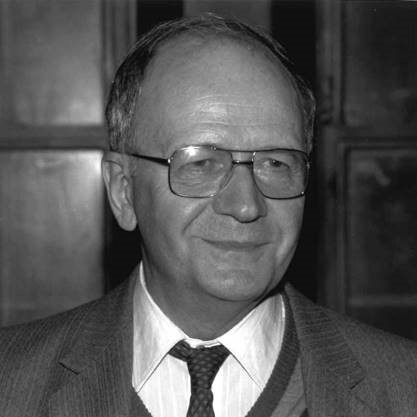
The Pontifical Institute of Mediaeval Studies (PIMS) is mourning the death of long-time faculty member Fr. Édouard Jeauneau, who died at the age of 95 on Monday, Dec. 9, 2019 in Chartres, France.
Fr. Jeauneau was a Professor of Medieval Philosophy at PIMS and the Centre for Mediaeval Studies (CMS) at the University of Toronto from the 1975 through to 1995. He was named Institute Professor at PIMS in 1990 and was awarded an honorary doctorate in 2002.
His involvement in the medieval community in Toronto began following a formal invitation in 1974 to join the PIMS Faculty from Rev. E.A. Synan, Praeses, and Rev. James McConica, CSB, Chairman of the Search Committee.
Until 2015, he spent about eight months each year working on his many projects here in Toronto, most notably the five-volume Periphyseon of Johannes Scottus Eriugena (Turnhout: Brepols).
Fr. Jeauneau was consistently awarded substantial Social Sciences and Humanities Research (SSHRC) grants, and hired a long string of Centre students to work for him, paying them generously. He also trained many of these students in reading the particular handwriting in the manuscripts and in editing the texts.
Among the honours bestowed on him over the years was the position of Directeur de Recherche Honoraire au CNRS in Paris, France’s National Centre for Scientific Research, and an appointment as a fellow of the British Academy.
A funeral Mass will be held Monday, December 16 in his small home town of Coudray-en Perche, about 60 km from Chartres.
His presence will be missed by all who knew him.
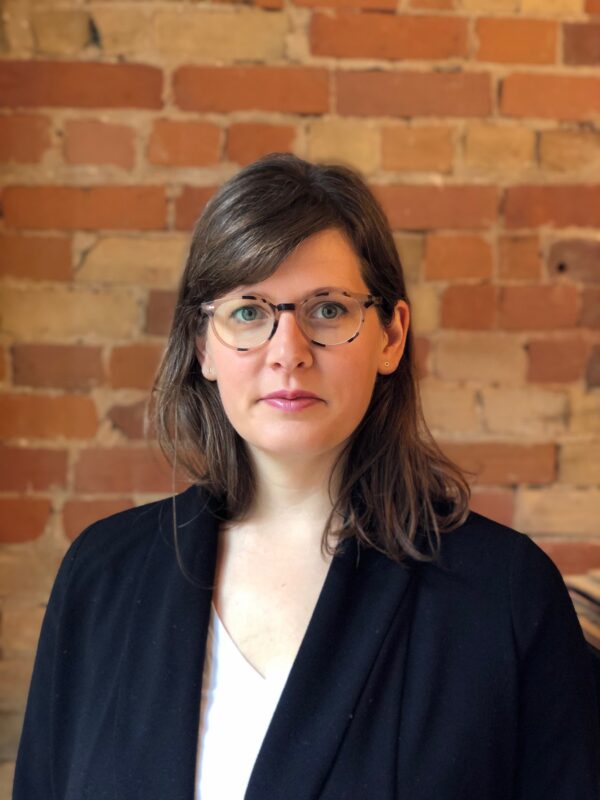
Toronto, ON, Dec. 5, 2019 – The University of St. Michael’s College has appointed Lisa Rae its Director, Office of the President, effective December 6, 2019. In this role, she will oversee the operations of the Office and support in identifying priority issues, facilitating planning and driving project-based initiatives across the University. Rae brings a wealth of policy, operations, communications, and management experience from working both inside and outside of local and provincial government.
Most recently, Rae was Director of Operations and Senior Policy Advisor in the Minister’s Office for Advanced Education and Skills Development, where she worked collaboratively to help set the strategic direction for the office to support the Minister and the government. She was also responsible for delivering key policy priorities including the transformation of the Ontario Student Assistance Program and the introduction of legislation recognizing Indigenous Institutes. Prior to that, Rae was at the Council of Ontario Universities, where she provided project management, policy support and direction to many working groups and committees of senior leaders from universities.
“I’m passionate about higher education and the role that universities play both inside and outside the classroom to build engaged citizens,” Rae said. “I’m excited to join the St. Mike’s community and work in an institution that prioritizes teaching the whole person, and I look forward to working with all members of the St. Mike’s community and the University of Toronto.”
“St. Michael’s is delighted to welcome Lisa Rae into this important leadership role in the Office of the President,” St. Michael’s President David Sylvester, PhD said. “Her background in strategic leadership and stakeholder engagement will be invaluable as we continue to deepen our relationships and pursue new opportunities with community and educational partners locally and globally.”
-30-
About the University of St. Michael’s College
St. Michael’s College was founded in 1852 in partnership with the Congregation of St. Basil in Annonay, France, and became an official Federated College in the University of Toronto in 1910. It remains a centre of Catholic thought, and inspires socially conscious and intellectually engaged students through its undergraduate programs, its graduate Faculty of Theology and its Continuing Education division.
For more information, please contact:
Martyn Jones
Office of Communications
University of St. Michael’s College
(416) 926-2291
martyn.jones@utoronto.ca
The sense of anticipation that comes with the season of Advent fits perfectly into the rhythm of campus life at St. Michael’s. The beginning of the new Church year, with its focus on preparing for the coming of the Christ child, arrives as students look ahead in their lives. There are papers to finish and exams to write as the Fall semester winds down. There are travel plans to make and, especially for first-year students, a growing eagerness to head home to loved ones for the Christmas break. Meanwhile, professors are grading work and submitting marks while staff are tying up loose ends before heading home for the holidays. The mood at St. Mike’s is very much one of expectation.
Underlining that feeling of anticipation are the various ways St. Mike’s marks the Advent season and looks forward to Christmas. The lampposts of Elmsley Place are festooned with garlands of white lights, a festive response to the dark days of December. The altar at St. Basil’s bears an Advent wreath, its one rose and three purple candles marking the passage of the four weeks preceding Christmas. And, in the lobby of Brennan Hall, a crèche set sits waiting, a vivid reminder of the days to come.
While the symbols of the season bear witness to the coming of Christmas, it’s the activities on campus that are the most powerful reminders of the spirit of the season. Everywhere you look there are opportunities to donate to a worthy cause. Campus Ministry has boxes to collect toys and gift cards for the Society of St. Vincent de Paul, and guests attending the Dec. 5 Alumni Tea and Carolling party are invited to join in this campaign by bringing an unwrapped toy or gift to the event.
In the Faculty of Theology, boxes in the student lounge are filling up with donations of food and personal items for Society of Sharing, a member agency of Catholic Charities. Run by Master of Divinity grad Mariza Garcia, the agency makes up care packages at Christmas for isolated people in the downtown core.
During Advent, Faculty member Dr. Darren Dias steps outside his life as an academic to lead retreats for the broader community, while the entire Theology community looks forward to the annual Vespers and Advent Dinner, taking place on Friday, December 6. The evening is a chance for students and professors to take a step back from work to slow down, collect their thoughts in prayer, and then socialize together.
There’s an open invitation for all to attend the Schola Cantorum’s Advent concert in St. Basil’s Church. This year’s concert, which takes place Dec. 9 at 7:30, will include Palestrina’s Missa Gabriel Archangelus and organ music by Frescobaldi, directed by Dr. Michael O’Connor, with Dr. John Paul Farahat on the organ. The event is free, with an optional collection for charity.
And of course there’s just plain Christmas fun to be had before students scatter for the holidays. The tree in the Coop is now decorated, and on Dec. 3 and Dec. 4 the Canada Room will be the site of student Christmas dinners for both commuter and residence undergrads, with a round of carolling rolled in on Wednesday, Dec. 4 from 4 to 6 p.m.
Faculty and staff get in on the festivities on Thursday, December 12. Following Mass at St. Basil’s, all are invited to attend the annual Christmas lunch and round of carols in Fr. Madden Hall, complete with a tree to decorate with more gift cards for St. Vincent de Paul.
St. Mike’s is also launching a new initiative this year, a Holiday Community Social Lunch to be held on Wednesday, Dec. 18 in the Faculty Dining Room. The tasty three-course meal is designed to bring together in celebration members of the St. Mike’s community with friends and neighbours from a wealth of traditions. Tickets for this event can be purchased in the Faculty Dining Room (located on the second floor of the Scollard Park entrance to Brennan Hall).
With the city as its classroom, a new Media Ethics Lab at the University of St. Michael’s College will help students respond to the ethical issues being raised by rapidly emerging technologies and new communications practices.
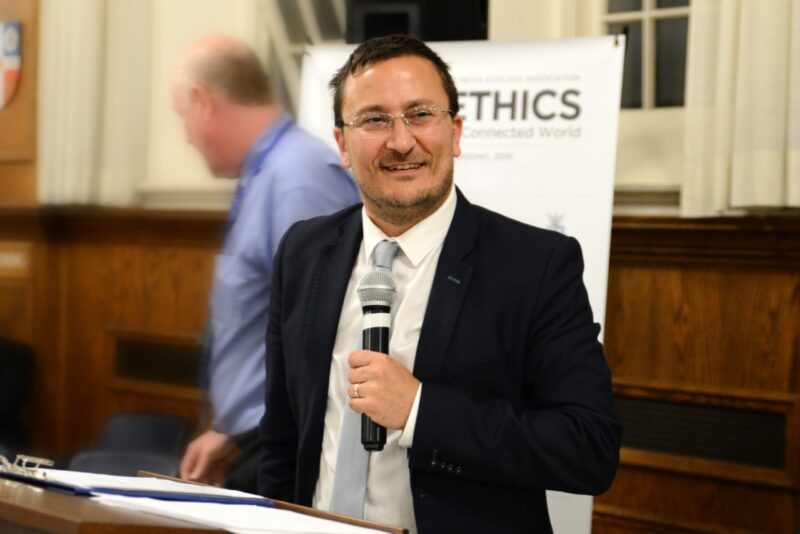
The project is spearheaded by Dr. Paolo Granata, an assistant professor in St. Michael’s Book and Media Studies program. The lab springs naturally from an international conference Dr. Granata chaired earlier this year on the University of Toronto campus in his capacity as the vice-president of the Media Ecology Association (MEA). The conference, Media Ethics: Human Ecology in a Connected World, had a goal of exploring new ethical perspectives and frameworks to help build a digital ecosystem that will serve society in healthy and productive ways.
Popularized by Neil Postman, the phrase media ecology is based on the work of Marshall McLuhan. For those unfamiliar with the term, the MEA’s website defines it as “the idea that technology and techniques, modes of information and codes of communication play a leading role in human affairs.”
The Media Ethics Lab, explains Dr. Granata, is built upon open research, allowing a diverse, collaborative body of stakeholders, from students to media activists and organizations, to freely share information on academic programs and research initiatives to foster ethical thinking in research, learning, and civic engagement.
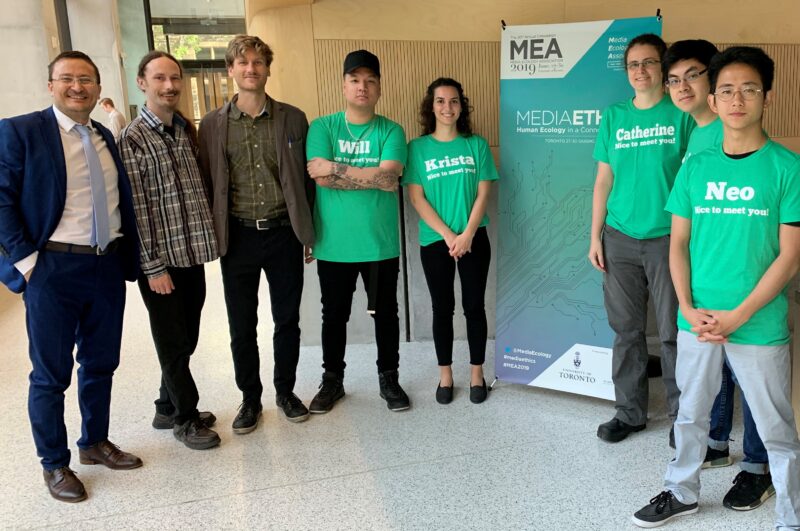
He views the virtual Media Ethics Lab as both an intellectual and social space where interested parties can gather to study and discuss the ways in which digital culture impacts today’s society. He sees it as a sort of clearinghouse to help society stay ahead of the curve of emerging technologies and the ethical issues that can come with them.
For now, the lab will focus on three core areas: Digital Equity, or creating equitable, inclusive communities for all; the Digital City, focussed on designing people-centered information systems; and Digital Literacy, looking at helping communities develop skills to carry them forward into the 21st century.
“Private companies rule our digital world,” says Dr. Granata. “If public policy is too slow, then the market will come first,” regardless of the impact new technologies have on ethical issues relating to matters such as privacy or artificial intelligence.
“The Media Ethics Lab is being started not only as a research project but also as an opportunity for experiential learning,” he adds, noting that some of the lab’s funding comes from the Advancing Teaching & Learning in Arts and Science (ATLAS) program at the University of Toronto.
And this is where the “city as classroom” idea, another McLuhan concept, will come into play. Experiential learning, explains Dr. Granata, means stepping outside of the confines of the university and into the community.
“Everything we do must be able to support, foster and advance and open an inclusive society, as we must not only work towards a healthier digital world, but a more equitable planet” and that requires students getting involved in civic engagement to listening to what a broad range of people think.
He cites as an example a recent workshop students participated in at Mozilla Foundation in Toronto, a global non-profit dedicated to keeping the Internet a global public resource that is open and accessible to all. Students were invited to provide suggestions and proposals, an empowering experience that allowed them to test-drive their ideas, giving the theoretical a practical turn.
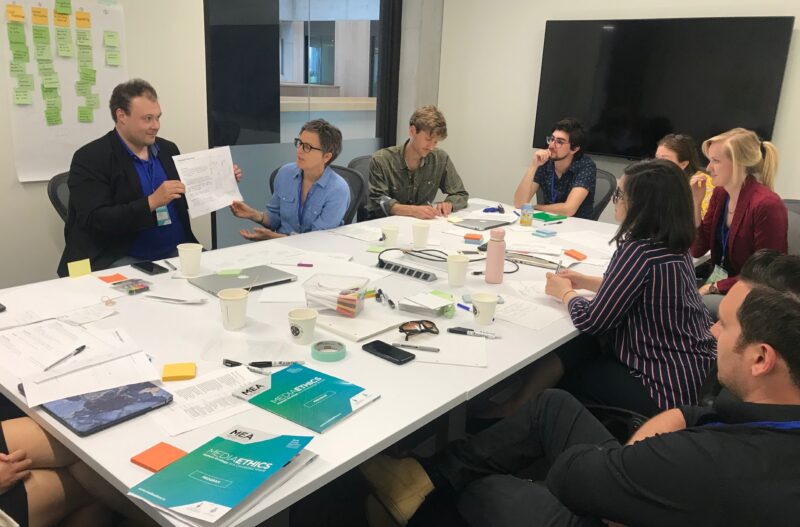
Another form of engagement via the Media Ethics Lab will be periodic charrette sessions, a type of intensive brainstorming meetings where various stakeholders gather for respectful discussion identifying both the benefits and challenges of the current digital media landscape, all with an eye to making improvements.
“We want to foster and support positive change. All of the Media Ethics Lab’s efforts are also are done in support of the UN’s sustainable development goals.” Dr. Granata says.
Several students have already been involved, either in the conference end of this project, or now by on establishing the lab, including Kelsey Mcgillis, Alexandra Katz, and David Lee, all Book & Media Studies students at St. Mike’s as well as Robert Bertuzzi, PhD candidate at Western University, and Simon Digby, recently graduated at British Columbia’s Quest University.
Going forward, the lab will provide both training and mentorship to the students, encouraging them to participate in academic discussion and debate, necessary skills to carry forward if they are to help shape future policy or plan to teach.
Training and mentoring will be provided by Dr. Granata as amplification of his Media Ethics course. Some Book & Media students will serve as research assistants, conducting background reading in the field and participating in periodic discussions to come up with research questions and creating dossiers on their findings.
Working with Dr. Granata, they will post to the www.mediaethics.ca site, selecting both scholarly and non-scholarly publications, as well as a range of commentary to further the discussion. Students will engage in discovering funding opportunities and learn to draft grant proposals.
“The information environment is very much like the natural environment, and we need to take care of the information environment in much the same way we tend to ecological consciousness ,” says Dr. Granata. “The Internet is polluted but it should be a place where people can go and grow. Discussions on media ethics can help restore health.”
That care will require new thinking on how to stop corporate behaviour that is detrimental to society, he adds. Fines in response to privacy breaches, for example, simply don’t work because they aren’t large enough and, more importantly, don’t change behaviour, he says.
“To move forward, we need a humanistic approach to redefine the interface of humans and technology. It’s time to apply ethical thinking in the process of designing new technology.”
The Media Ethics Lab is a step in the right direction.
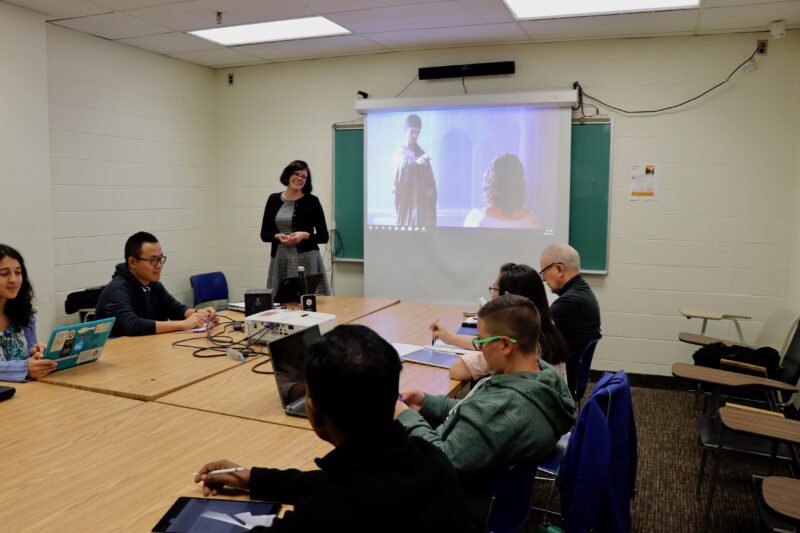
Ask Dr. Callie Callon about her field of study and she launches into an animated anecdote about insults in the ancient world. First she breaks into a grin and then an outright laugh as she details how St. Jerome suggesting that Pelagius fought with “a pointy head” was really an exquisite 5th-century dig at the latter’s character. It’s a laugh that indicates just how much this professor enjoys her work.
“Nerdy, I know!” she says.
Dr. Callon, a New Testament scholar now teaching at the Faculty of Theology, is also an expert in ancient physiognomy, looking at how early Christians used appearances to praise or impugn others. Her book, Reading Bodies: Physiognomy as a Strategy of Persuasion in Early Christian Discourse, was published earlier this year by Bloomsbury Publishing.
The pointy head reference, she explains, was really designed to allude to a wrestling position, as the common thinking about wrestlers in Jerome’s time was that they had brute strength but moral shortcomings. One of Pelagius’s moral shortcomings? He had criticized some of Jerome’s writings. (Subsequently, of course, Pelagius was deemed a heretic at the Council of Carthage in 418 A.D. over his thoughts on original sin.)
“In some situations Early Christians could capitalize on what was held to be a deficiency in the personal appearance of an opponent in order to persuade an audience of his deficiency in character,” Dr. Callon explains. With Jerome and Pelagius at odds over theology, the former took to attacking physical characteristics of the latter to defame and undermine his philosophy.
The delight Dr. Callon finds in her subject area, whether interpreting the nuances of early Church writing or the depths of Scripture, has won her fans among her students.
“You can tell that teaching is her passion,” says doctoral student Min-June Kye, who first encountered the professor in her The Parables of Jesus class, and who uses words like supportive and innovative to describe her as a teacher. “She clearly enjoys what she’s doing, including learning from her students, she’s incredibly smart, and her objective is knowledge, not career.”
When asked to elaborate, he cites things like Dr. Callon’s Greek word of the day to amplify readings and broader horizons, her use of humour in lectures, or her timely response to emails, with detailed answers demonstrating she has read the entire message thoroughly.
“She also offers detailed attention on papers – and she’s always encouraging in the areas that need attention,” he says.
Modest about her students’ appreciation for her teaching style, Dr. Callon describes herself as “student-focused,” and says she tries to get a feel for her students on the first day of class because each group is unique.
“A third of the way through the course I ask students to write one thing that is going well (about the class) and one that they would change and hand them in – anonymously — because there are so many different learning styles,” she explains. “That way I can address areas that could help students better engage.”
Dr. Callon found her subject area of interest by accident.
“An original interest in contemporary gender theory and gender performance let to an interest in the way the body and gender were understood and interpreted in antiquity,” she explains. “A significant component of ancient physiognomic thought was concerned with detecting what it deemed ‘gender slippage’ in bodily comportment.”
She earned her doctorate at the University of Toronto’s Department for the Study of Religion under the supervision of renowned scripture scholar Dr. John Kloppenborg. After graduating in 2014, Dr. Callon taught courses at the University of Toronto and Queen’s University before arriving at St. Mike’s in 2017 as a sessional instructor and then accepting a contract position with the Faculty of Theology in 2018.
This year, she is teaching The Gospel of Matthew, The Life and Letters of St. Paul, and Feminist Interpretations of the Bible for the Faculty of Theology. New to her teaching schedule this year is an undergraduate course, Women and Christianity, which will run in the Winter semester. As described in the syllabus, the course will explore “what Pope John Paul II, among others, called the ‘feminine tradition’ in Christian life and thought.”
“Research-informed teaching is a defining feature of a University of Toronto undergraduate program,” says Professor Randy Boyagoda, Principal of the College and Director of the Christianity and Culture program, in which Dr. Callon is teaching her course. “The College, the program, and above all our students are fortunate to have a scholar of Dr. Callon’s calibre drawing on her active work in this area and sharing that in the classroom.”
Faculty Dean Dr. James Ginther says he’s delighted to see Dr. Callon’s teaching talents shared with the undergraduate division, describing her as a “wonderful ambassador” for theology, and as someone who will offer students a top academic experience while remaining approachable and able to answer questions undergrads might have if they’re pondering graduate studies.
That skill has already been demonstrated. Just ask Min-June Kye.
Dr. Callon is “one of the reasons I continued my studies,” he says simply.
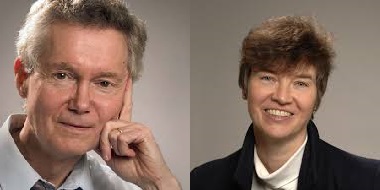
Dr. Margaret O’Gara was a doctoral candidate and Dr. Michael Vertin a professor of philosophy at St. Mike’s when the two wed at St. Basil’s Church in 1976. Over the course of 36 years of marriage not only did each become a legendary professor at the Faculty of Theology, with Dr. O’Gara known around the world for her work in ecumenism and Dr. Vertin for his expertise in Bernard Lonergan, but they amassed a remarkable – and sizeable – library.
Now in the process of downsizing following Dr. O’Gara’s death in 2012, Dr. Vertin has donated an estimated 900 books from the couple’s individual and shared collections to this year’s Friends of the Kelly Library book sale. The sale runs Sept. 24 to 28 in Carr Hall (100 St. Joseph St.).
The works donated from the couple’s library, carefully packed up by Dr. Vertin and delivered to volunteers in 40 bankers boxes, include books on everything from ecclesiology and ecumenism to scripture, patristics, and the philosophy of religion. Many of the items resided for years on simple pine book cases that Dr. O’Gara had built herself, an accomplishment, Dr. Vertin notes, that she felt quite pleased about.
When asked, Dr. Vertin notes there were some items he was unable to part with, including his 25-volume series on Lonergan, complete with its “red U of T Press binding.”
The annual used book sale, organized by the Friends of the John. M. Kelly Library, is designed to raise funds for the library, with proceeds earmarked for such projects as physical improvements, technology upgrades, and adding to collections.
Along with the Vertin/O’Gara donation, this year’s sale will feature a range of shopping options from first editions and art books through to academic works and pleasure reads.
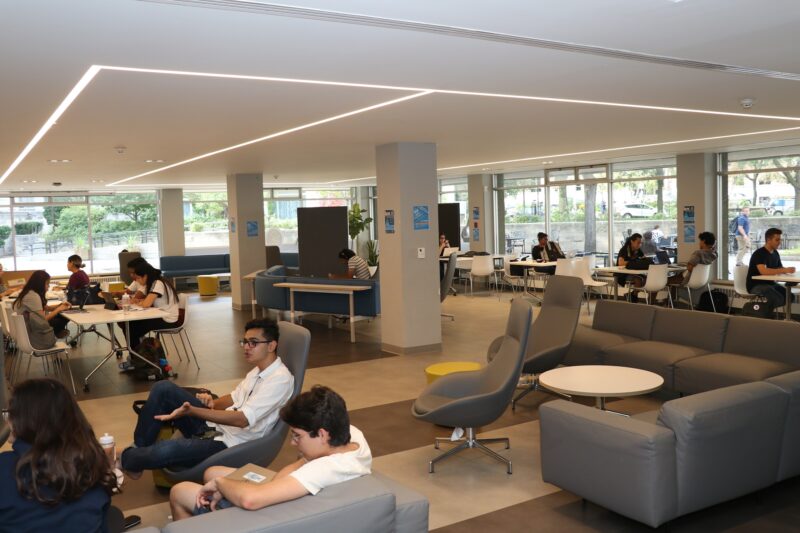
When asked to describe St. Mike’s, students often mention “community” as a foundational part of their experience of the school. The newly renovated and fully accessible Brennan Hall offers – quite literally – a concrete example of the ways in which community is an essential and longstanding feature of the student experience at St. Michael’s. Amid the portraits of alumni and past professors, current students find themselves in a community as familiar as an extended family—and just as committed to their success in every area of life.
“The revitalization of Brennan Hall represents this university’s commitment to student experience,” says President David Sylvester. “By placing key services and resources alongside club and gathering spaces in the heart of our campus, the new Brennan Hall brings together every part of St. Michael’s student life—spiritual, academic, personal, and social—in the same way a St. Mike’s education forms the student as a whole person.”
One of the most important updates to the space is the relocation of the Office of the Registrar from Alumni Hall to the centre of Brennan. This places essential registrarial services at the heart of campus for both undergraduate students at St. Mike’s and graduate students at the USMC Faculty of Theology.
Students can make use of those services while also popping in to the SMCSU office, the Canada Room dining hall, or the Dodig Family COOP. With Campus Ministry and Student Life offices down the hall as well – and exciting events often taking over the COOP during evenings and weekends – the overall effect is that of a bustling home for students from every division of the school, and a place that caters to every part of student life.
Giancarlo Mazzanti ’84, Registrar and Director of Student Services, says “The revitalization of the main level of Brennan Hall has been the catalyst in improving the student experience on our campus.” He mentions one of the key benefits has been that staff “are in constant contact with students, and sharing in the community experience,” and that the new spaces bustle with students “studying and meeting with academic advisors, learning strategists, career advisors or our Campus Ministry team.”
Since the beginning of the new academic year, the revitalized Brennan has been buzzing with activity, from orientation programming to events and first club meetings. A recent Kelly’s Korner – an open mic night and longstanding tradition brought back in the new space – was full to overflowing the doors of the Dodig Family COOP.
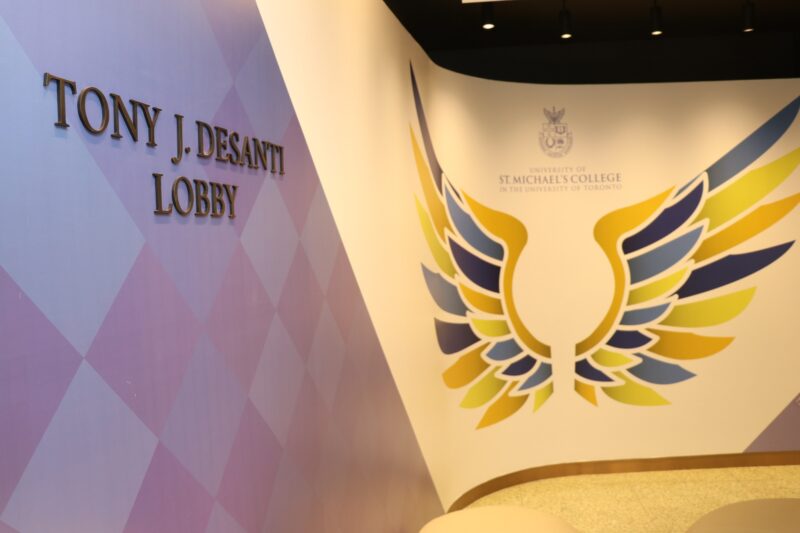
“It looks beautiful and it is coming back to life!” says Maryrose Doucette, a third-year SMC student double-majoring in Christianity and Culture and Mediaeval Studies with a minor in Political Science. “The COOP being redone, the pool table, and of course the coffee shop are all a draw for me, and it’s great to walk through on my way to class and run into friends at every corner.”
The changes to Brennan are apparent from the moment a visitor walks in the south entrance. A bright and welcoming entrance space, the Tony J. Desanti Lobby features a curved wall imprinted with the names of members of the St. Michael’s community who made the renovation possible. The old-school USMC crest on the floor recalls decades of St. Michael’s history, while a pair of giant angel wings on the wall provide Instagrammable photo opportunities to students and visitors to campus.
In the updated central space, students now have a large variety of seating options while waiting for appointments or gathering with friends. One option is to grab a drink or a snack at Mike’s Café, a coffee shop quickly becoming known for its “Basil the Bulldog” signage where students can pick up St. Mike’s merchandise and a small selection of toiletries and living essentials in addition to Starbuck’s Coffee. Arrays of outlets next to every seating area make it possible for students to study or hang out for as long as they like without relocating for a battery top-up.
An essential part of the project was the update to the Dodig Family COOP, a beloved open space where students at St. Mike’s have gathered for decades. It has always played a particularly important role in the lives of commuter students, who treat the COOP as a home base for the days they spend on campus. The new COOP features soft seating, updated lighting, plentiful outlets, and a complement of glass-walled office spaces for student organizations and clubs, as well as a graduate student lounge with further comfortable seating. Microwaves and high-top tables make the COOP a place to eat as well as study, hang out, and gather for events.
Isabel Armiento, fourth-year SMC student and this year’s Editor-in-Chief of The Mike, finds that the revamped club spaces next to the COOP have been a boon to the campus paper’s operations, saying “we can now comfortably host in-house copy-editing and production sessions with more members present than ever before.” Armiento also notes the centralized office spaces make it easier to “hold outreach events in common student spaces and to communicate with Student Life and USMC faculty.”
The Class of 2023 has already begun to make themselves at home in the COOP and the adjacent offices, which are adaptable for a variety of uses. Passers-by often catch sight of board game nights and friendly games of pool on the new billiard table. From residential students to commuters, graduate students to those pursuing certificates in Continuing Education, visitors to the revitalized spaces find a new home for the community that has always made St. Michael’s unique.
Since its official opening in August of 1939, Brennan Hall has been at the heart of the St. Mike’s experience. 80 years later, thanks to the generosity of Brennan Hall “Champions,” gifts from alumni and friends, major class gifts, and a contribution from students through the Student Capital Improvement Fund, the Class of 2023 will be the first to enjoy a completely revitalized Brennan Hall throughout their entire experience at St. Mike’s.
Dr. Tamara Grdzelidze’s career has taken her from the Geneva offices of the World Council of Churches to Rome, where she served as the Georgian ambassador to the Vatican from 2014-2018. Now, her latest travels have brought her to Toronto as the Aileen Driscoll Research Fellow in Ecumenical Theology at the University of St. Michael’s College.
Midway through her year-long appointment, Dr. Grzelidze is delighted to be following in the footsteps of legendary St. Mike’s professors and conducting research at a university known for its work in ecumenism — even though her arrival on campus this past January was something of a shock.
“Certainly I knew cold. I’d been to the Alps, for example, “she laughingly recalls. “But I didn’t know what (a wind chill of) -32 felt like!”
Still, everything from conversations with Dennis Savoie, Canada’s ambassador to the Holy See, to her work at the WCC helped convince her that St. Michael’s was a logical place for her to further her work on ecumenism.
“I was familiar with some of the big names who taught at St. Mike’s – Margaret O’Gara and Étienne Gilson, for example – and I knew U of T is a very good university,” she says. “From my work with the World Council of Churches I knew that, ecumenically, (Canada) is very strong.”
The project she is working on while at St. Mike’s stems from concerns over the fallout for various Orthodox churches in the wake of the 2018 decision by the Russian Orthodox Church to sever ties to the Ecumenical Patriarchate of Constantinople, which historically has held a special place in the Eastern Orthodox world. The break came last October after Constantinople granted the Ukrainian Orthodox Church autocephaly, or permission to operate independently from Moscow.
“Having lived various places this is painful for me. Borders are not so precise,” says Dr. Grdzelidze, who is organizing a conference to take place at St. Mike’s in June, 2020, titled Boundaries of the Christian Faith in the 21st Century: Intersecting with Borders of Geography, Cuture and Theology. Earlier this year, for example, she delivered a paper, ‘National Borders of the Orthodox Church,’ at a conference in Romania.
“Ecumenism is not only about knowledge but about experience, just as theology is not just about patristics,” she explains. “It is about seeing how people interact; it serves as a compass to understand others’ beliefs, their passions.”
In the coming Fall semester, Dr. Grdzelidze will teach The Ecumenical Theology: Division, Difference, Dialogue, a course that will examine some of the major themes related to the impact of inter-church dialogue and action on theological reflection.
Educated in Tbilisi State University in Georgia, St. Vladimir’s Orthodox Theological Seminary in New York, and Oxford, Dr. Grdzelidze has taught around the world, including St. John’s Theological College in Auckland, Trinity College Dublin, and the Angelicum in Rome.
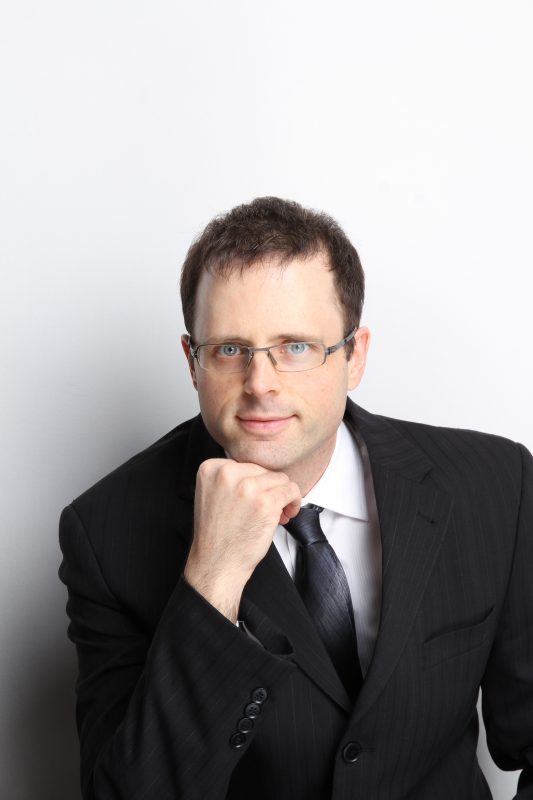
Faculty of Theology Dean Dr. James Ginther is delighted to announce that Dr. Jean-Pierre Fortin will be joining the faculty as Assistant Professor in Practical Theology and Pastoral Formation. Dr. Fortin takes up his position July 1, 2019, and will begin teaching in the Fall semester.
“Jean-Pierre’s work at the Institute of Pastoral Studies at Loyola makes him an ideal fit for us,” says Dr. Ginther. “His research profile and involvement in ecumenical dialogue will also be of great value to our community.”
Dr. Fortin’s most recent book is titled Grace in Auschwitz: A Holocaust Christology, and he is currently working on a book on the spiritual history of grace for Fortress Press. His research focusses on religious concerns and questions of 21st-century Christians.
Mentored as a student by world renowned St. Mike’s theologian Dr. Margaret O’Gara, Dr. Fortin earned an M.A. and a PhD in theology from St. Michael’s. He also holds a doctorate from Université Laval in Quebec City in the philosophy of science and a Licentiate in Sacred Theology from Regis College in Toronto.
As well as teaching at Chicago’s Loyola University, Dr. Fortin has also taught at Université de Sherbrooke in Quebec.
Coming to teach at St. Mike’s “constitutes a tremendous honour and opportunity to bear witness to the quality of the education I received,” Dr. Fortin says.
The duties of the practical theology position include teaching the Theology of Ministry and Reflection Seminar classes, as well as overseeing field placements. Field placements are an essential aspect of the Master of Divinity and Master of Religious Education programs at the Faculty, allowing students to practice under supervision the pastoral skills they have learned in the classroom and then come back to reflect on what they have learned about their abilities.
Dr. Fortin’s experience in the scholarship and teaching of spiritual direction will also enhance the Faculty’s pastoral formation program. “I hope to be able to inspire students to engage in a transformative search for truth leading to a new way of life in and for God,” he says.
20th Annual Media Ecology Association Convention brings ethical perspectives to bear on cutting-edge developments in technology and society
In a world of fake news, hyper-connectivity, and rapidly advancing means of communication, the humanistic and critical perspective of legendary St. Michael’s professor Marshall McLuhan can feel almost prophetic. Next week, hundreds of scholars will converge on the St. Michael’s campus to address many of the most important and challenging questions about media and society today – very much in the spirit of McLuhan himself.
From June 27 to 30, the University of St. Michael’s College will open its doors to co-host the Media Ecology Association (MEA) for its 20th annual convention. This year’s theme is “Media Ethics: Human Ecology in a Connected World,” and the itinerary includes 80 sessions and events that feature 300 speakers from 30 countries.
This international conference takes place at a very important time, with elections on the horizon for Canada and the United States. As St. Michael’s President David Sylvester notes, “Given St. Mike’s long tradition of teaching and research infused with a focus on ethics and values, it’s fitting that we, along with U of T’s Faculty of Arts and Science, Faculty of Information, and the Centre for Ethics, have joined together with the MEA to inspire the next generation of media scholars.”
Book & Media Studies Assistant Professor Paolo Granata, chair of this year’s conference, has organized the event with an eye on a technological society developing so quickly that lawmakers and ethicists struggle to keep pace. Granata explores these ideas in his research and teaching, including the McLuhan Seminar in Creativity and Technology, an SMC One program which features a learning experience in Silicon Valley for first-year students. A number of Granata’s students will also be on hand to participate in and support the proceedings while making connections with scholars in the field.
The conference will kick off on June 26 with a panel discussion on how the internet is affecting civil society, featuring St. Michael’s alumnus and U of T Philosophy professor Mark Kingwell. Presented by the Toronto Reference Library and the McLuhan Salon Series, “The Social Cost of the Information Age” networking event is free and open to the public.
The formal opening of the convention on June 27 will include remarks from the Honourable Karina Gould, Minister of Democratic Institutions, whose involvement in the conference stems from her perception of the possibilities and risks inherent in digital life for the future of democracy.
“The Media Ethics conference provides an important space for Canadians to discuss how they use platforms, the information they are seeing on these platforms and the level of trust they have for these platforms,” says Gould, “Democracy is rooted in the trust of the people in the process and in the legitimacy of the outcome.”
On Friday, June 28, at 7:30 p.m. St. Michael’s Faculty of Theology professor and Director of the Elliott Allen Institute for Theology and Ecology Dennis P. O’Hara will join documentary filmmaker Nora Bateson at the McLuhan Centre for a screening of An Ecology of Mind: A Daughter’s Portrait of Gregory Bateson.
The Media Ethics conference will conclude on June 30 with a plenary session titled “The Future We Want.” Thoughtfulness about the human side of media – a central piece of Marshall McLuhan’s legacy – is an essential part of the St. Michael’s story of humanistic scholarship, and inspires students and scholars alike to think creatively and optimistically in response to problems in the global village.
More information about this year’s MEA Convention, including a link to a detailed itinerary, is available on the Media Ethics website.
St. Mike’s alumni returned to campus for Alumni Reunion 2019 from May 29 to June 2, where they had the opportunity to catch up with classmates, make new friends, and reacquaint themselves with the college that remains an important part of their lives.
The Alumni Affairs team organized 18 different events scheduled around reunion celebrations hosted by the University of Toronto, and in the final count, more than 600 people attended St. Michael’s special events. This year, the honoured classes ending in ’4 and ’9 came back to campus to celebrate their milestone anniversaries, including alumni returning from as far back as the class of 1949.
Some alumni traveled from as far away as New Zealand, England and Houston to participate, while others found themselves returning from a short distance away as they settled back into residence at Elmsley Place or Loretto College for the weekend.
The reunion kicked off with a SHAKER gathering at Ripley’s Aquarium with St. Mike’s young alumni in attendance, and concluded with a full house for Sunday’s Mediaeval Symposium by Dr. Alison More. A selection of photos from these and other events can be found at the bottom of this post.
Highlights from Alumni Reunion include:
- Lectures and presentations from St. Mike’s faculty, including Assistant Professor Felan Parker’s engaging Stress-Free Degree lecture on Fortnite and video game culture and a standing-room-only presentation by Assistant Professor Alison More, who had just returned from conducting an international learning experience in Ireland with Boyle Seminar students.
- Anniversary Masses, one celebrated by Fr. Morgan Rice, CSB (2009 graduate of the Faculty of Theology) in the Loretto College Chapel, and another at St. Basil’s celebrated by Archbishop Michael Miller, CSB, (USMC 1969) who travelled from Vancouver to enjoy his 50th anniversary of graduating from St. Michael’s. Alumni toured the John M. Kelly Library, which is celebrating its 50th anniversary since opening in 1969, and Chester Gryski’s (USMC 1969) spoke about the Canadian Fine Press Exhibition, which featured items printed by the late Glenn Goluska (USMC 1969). If you missed your chance to share memories or photos of the library during reunion, you can still do so—just send an email to usmc.archives@utoronto.ca.
- A revival of the st. mike’s pub. The Class of 1994, in conjunction with the Class of 2009, marked their 25th and 10th anniversary, respectively by turning the Firkin on Bay into the st. mike’s pub, a former campus hangout space.
- A capacity-crowd All Alumni Double Blue Party in the newly renovated Brennan Hall Lounge and The Dodig Family COOP. Alumni had the opportunity to travel down memory lane with a display of photos and flip through yearbooks from the honoured years.
- “Canadian Writing Now,” a panel discussion hosted by Principal and Vice-President Randy Boyagoda and English Chair Professor Paul Stevens. One of the authors, Anthony De Sa (USMC 1989), dedicated his reading to Fr. Robert Madden, CSB, and shared a story of Fr. Madden going out of his way to offer kindness and support after Anthony’s father passed away.
- The Honoured Years’ Dinner and Medal Ceremony where alumni who graduated 55, 60, 65, and 70 years ago, with a standing ovation for Vicky Houghton (USMC 1949), the first ever Female Athlete of the Year at St. Michael’s, who recently donated her Varsity jacket to the USMC Archives.
- Dr. Mimi Marrocco (USMC 1969) was recognized for her work in adult education, corporate social responsibility and ethics as the recipient of the 2019 Alway Award, named in honour of former President and Vice-Chancellor Dr. Richard Alway (USMC 1962).
President David Sylvester expressed his appreciation to the campus community following the weekend, writing:
“Many thanks to the staff, faculty and students who contributed to the success of Alumni Reunion It was a wonderful opportunity to connect with generations of St Mike’s graduates. Our alumni felt warmly welcomed, thoroughly enjoyed the gatherings, lectures and tours and commented on how lovely the grounds and facilities looked. The weekend was a tremendous community effort, which showcased St. Mike’s at its best.”
See you next year! If you’d like to see more photos from the weekend, please email smc.alumniaffairs@utoronto.ca.
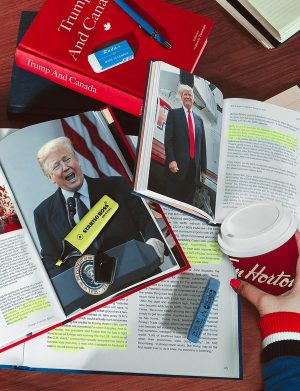
When USMC visiting professor Sam Tanenhaus realized that many of his University of Toronto students knew people who had voted to elect Donald Trump president of the United States, he said to them, “Right now, you have more to tell me than the newsroom of The New York Times.” This moment led him to scrap a detailed traditional syllabus he had prepared for a course titled “Trump and the Media,” and to move in a new direction. He would informally rename the course to match its novel approach: “Trump in Real Time.”
This all comes from the pages of a recent issue of Vanity Fair. The magazine sent writer Joel Stein to attend Tanenhaus’s class and report on how the journalist handled the constantly shifting curriculum. Stein came away impressed, not least by the students themselves:
These students are from the first generation steeped in reality TV, Twitter, memes, and GIFs. They are immune to Trump Shock, a trait which allows them to coolly analyze the first president to grab the levers of those media.
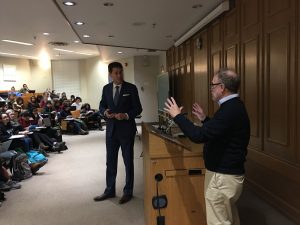
The class of 180 (140 of whom were women, Stein notes) demonstrated a special adeptness with the social media tools Trump uses to circumvent traditional avenues of public discourse, and Tanenhaus “[preferred] to ask questions rather than opine, and impressively [canvassed] the class’s expertise.” USMC Principal Randy Boyagoda says to Stein, “the class is inspiring students to become journalists.” Stein elaborates: “At least half a dozen … say they have put aside law-school applications.”
This is not the first major media attention “Trump and the Media” has elicited. In fact, in an ironic turn, American and Canadian media alike paid a great deal of attention to Tanenhaus throughout the fall term for his agile approach to teaching U of T students about the ways and means of the divisive American president.
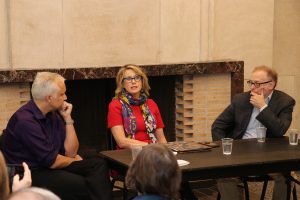
You can listen to Tanenhaus discuss his reasons for coming to Toronto to teach the course in this CBC Radio clip from September, or watch him in this classroom in this video clip from CBC’s The National before the U.S. mid-term elections. An October Globe and Mail article detailed Tanenhaus’s experiences of getting in touch via text message with Steve Bannon, a major player in Trump’s rise to power. In November, a reporter for Vice News found students making plans to pursue journalism careers, with many course-takers longing for longer class times than the customary two hours. At the end of that month, reporter Steve Paikin of TVO’s The Agenda visited the final meeting of Tanenhaus’s class to discuss Canadian and American politics, the future of the journalism industry and what today’s careers in journalism look like. In December, Tanenhaus joined a PEN Canada panel in Charbonnel Lounge on the St. Michael’s campus to discuss the murder of Saudi dissident journalist Jamal Khashoggi and its implications for journalists around the world.
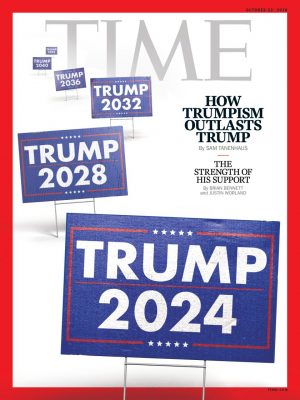
Tanenhaus has maintained a busy freelance journalism schedule in addition to his teaching commitments. One of these projects became an October cover story for Time magazine on the attempts of some Trump supporters to turn the president’s ad-hoc declamations and public statements into a durable political movement.
The former New York Times editor and historian is currently working on a biography of American conservative icon William F. Buckley, Jr., one more pursuit to add to his freelance assignments and occasional teaching load. Speaking of teaching, when reached by email, Tanenhaus had this to say about the dozens of students who filled up his courses:
Without a doubt the highlight of my experience at St. Mike’s was spending time with great students. [They were] engaged, eager to talk and to listen, extremely well informed, scary smart, and in some cases, brilliantly gifted. Anyone harboring worried thoughts about millennials should spend a couple of hours talking with U of T undergrads, and the fog will almost instantly lift.
It is to our great benefit that even though Tanenhaus concluded his teaching at St. Mike’s in December, those students are still around.
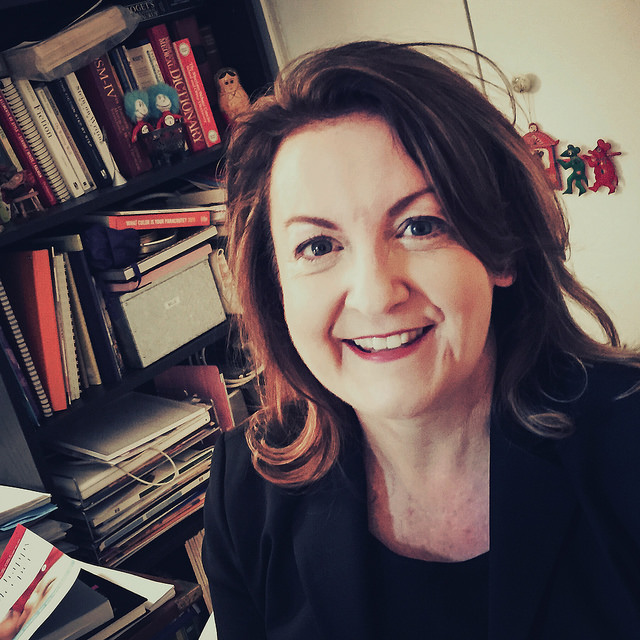
I am pleased to announce that St. Michael’s has appointed Laurie Morris Director of Communications, effective Feb. 19, 2019. Laurie is an accomplished communications professional with over two decades of experience in news media and university communications settings. She comes to St. Michael’s directly from Simon Fraser University in BC, where she oversaw a comprehensive communications strategy that raised awareness of the institution’s mission and identity as Canada’s “engaged university.” She arrives at a time when USMC is experiencing the renewed relevance of its undergraduate and graduate programs.
I look forward to working with Laurie as a member of the president’s senior leadership team. Her collegiate experience will be invaluable as she leads us forward in telling the story of our community in partnership with the University of Toronto, the Toronto School of Theology and our community partners. You can read more about Laurie’s achievements and our excitement at her appointment in our press release about her hiring.
David Sylvester
President and Vice-Chancellor
By: Michael Czobit
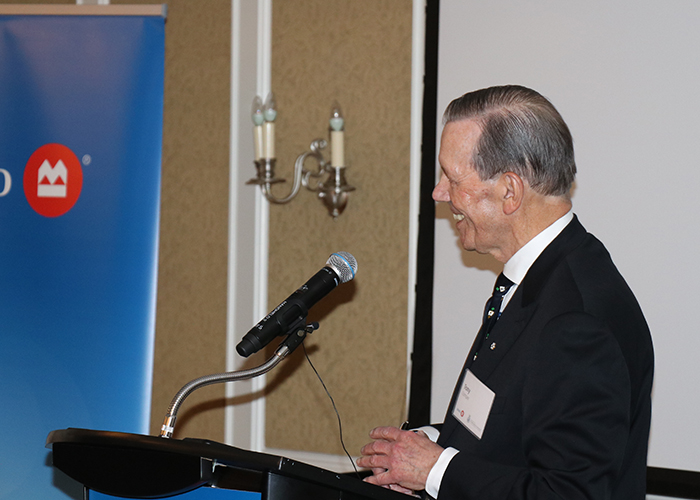
How long does a year feel? With so much activity and change at the University of St. Michael’s College, not very long at all. And much of that activity and change is due to the generosity of USMC’s most loyal and committed donors—members of the Chancellor’s Club, Vice-Chancellor’s Club and Heritage Donor Society—who gathered for the 18th annual St. Michael’s donor appreciation reception hosted by BMO Financial Group at First Canadian Place on Nov. 21.
Dr. Tony Comper, 6T6, welcomed the guests and mentioned a development in his own life: he had returned to school, specifically, St. Mike’s Mediaeval Studies program. Dr. Comper explained that he had begun attending Prof. Alexander Andrée’s Early Mediaeval Tradition course, but joked that he could only audit the class as it had been a while since he’d been tested in an academic setting. Dr. Comper then introduced someone who was also familiar with the Middle Ages, USMC’s newly installed president, Dr. David Sylvester, a social economic historian who holds a PhD in medieval history.
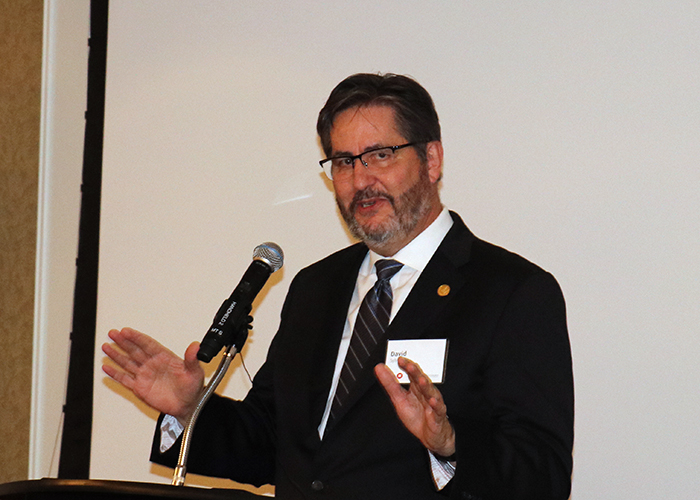
Dr. Comper remarked on Dr. Sylvester’s installation in October, saying the praise for Dr. Sylvester’s appointment as USMC President has been widespread, from Rev. George Smith, CSB, former superior general of the Basilians, and across North America. As he took the podium, Dr. Sylvester thanked Dr. Comper for his generous introduction and welcomed a special guest, Dr. Rose M. Patten, O.C., Chancellor of the University of Toronto. Dr. Sylvester thanked the guests for giving him the opportunity to acknowledge the University’s gratitude for their loyalty and generosity.
Dr. Sylvester then spoke of last year’s donor reception when a video was shown to introduce the launch of a project to renovate Brennan Hall. Shortly after, on Nov. 17, 2017, John Bennett, 6T7 and Diana Collins Bennett, 6T8 made a generous anchor gift, challenging the St. Mike’s community to begin a Brennan Hall Renewal fundraising campaign, which had a $2M fundraising goal. Dr. Sylvester said that over the past year the campaign had generated $1.7M from friends, faculty and staff members. Because of this, the project was nearly complete, with Brennan Hall expected to re-open to students in early December.
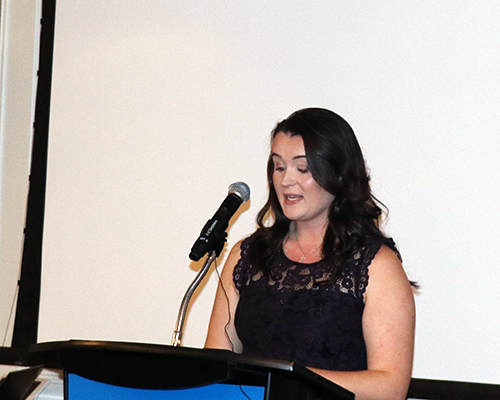
A video (which is embedded and available for you to watch below the text of this article) then detailed the progress of the renovation, and included messages from students about what the renovated Brennan Hall would mean to them and their thanks to campaign donors. The renewal project, which was envisioned and launched by Dr. Sylvester’s predecessor, David Mulroney, centralizes student services and provides space for resident and commuter students to gather, study, celebrate and engage with each other as a community.
After the video aired, Dr. Sylvester had more good news to share. The fundraising campaign had actually met its $2M goal. How? Dr. Sylvester welcomed to the podium Kate Strazds, President of St. Michael’s College Student Union, who announced a $300,000 gift on behalf of all St. Mike’s students.
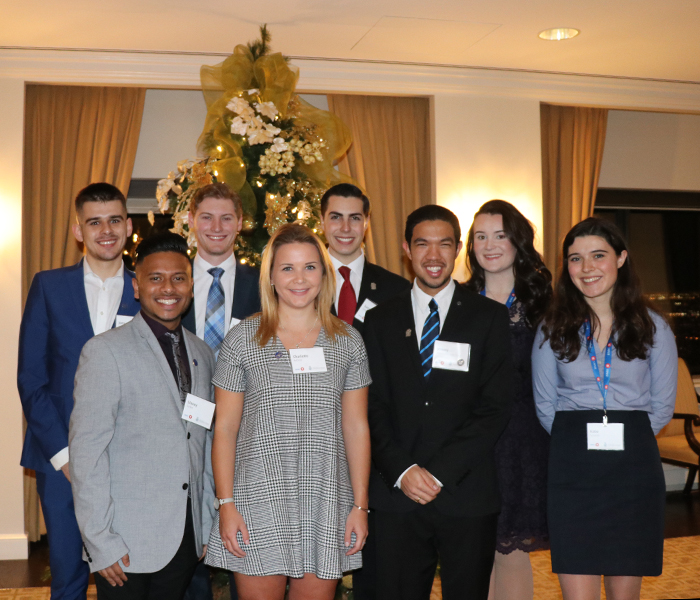
Turning to other exciting developments at USMC, Dr. Sylvester spoke about recent and upcoming faculty appointments in the Faculty of Theology and commented on the work of the six assistant professors who joined St Michael’s in 2017-2018 to teach in the undergraduate sponsored programs. He then highlighted the success of visiting professor Sam Tanenhaus’s “Trump and the Media” course, which has been popular with students and, incidentally, the media—the CBC, Vice, The Globe and Mail and Vanity Fair have all reported on Mr. Tanenhaus’s unique Book and Media Studies course.
Finally, in closing, Dr. Sylvester reiterated USMC’s commitment to maintaining and modernizing campus facilities, growing student aid programs, building wellness services and learning supports for students, and to continuing to pursue teaching excellence in the College and Faculty of Theology. He said that it was an important time for the St. Michael’s community to gather and reflect on how the University will fulfill its mission, addressing the present and planning for the future needs of students, society and the Church.
He closed by thanking guests once again for their advocacy and generous support and invited all to mingle at the reception, graciously hosted by BMO.
Michael Czobit is the Director of the Office of the Principal and Vice-President at the University of St. Michael’s College.
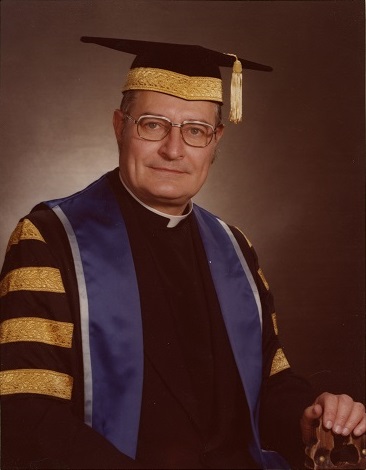
The University of St. Michael’s College today remembers Fr. Peter Swan, CSB, who passed away on Nov. 15 after nearly a century of life. Fr. Swan served as president and vice-chancellor of St. Michael’s from 1978 to 1984, overseeing the the opening of Alumni Hall and the adoption of the Memorandum of Agreement (1984) with the University of Toronto. Fr. Swan also sent a design for a new Coat of Arms to the College of Arms in London, England; the Queen approved the design for use on diplomas and other school-related documents in August of 1979, and it still adorns the wrought-iron gates of Elmsley Place.
Raised in an English expatriate family in Duncan, British Columbia, Fr. Swan was educated in a small private elementary school and at Duncan High School. Graduating from secondary school at age sixteen, Swan entered St. Michael’s College in September 1935. After graduating with a BA from the University of Toronto in 1938, he joined the Basilians in 1939. He was ordained in 1943 and in 1946 he completed his Ph.D. in Philosophy at the University of Toronto. That year he was assigned to Assumption College and named an Associate Professor of Philosophy. In 1949, Swan became Registrar there; in 1958, Vice-President Academic. In 1961, Swan was appointed Superior and Principal of Thomas More College in Saskatoon, Saskatchewan, where he served for sixteen years prior to his appointment at St. Michael’s.
In June of this year, Fr. Swan was presented with a medal in celebration of the 80th anniversary of his graduation from St. Michael’s College. We join the Basilian Fathers in mourning the loss, honouring the work and celebrating the life of Fr. Swan.
Fr. Swan’s funeral Mass will be celebrated on Friday, Nov. 30 at 10 a.m. in the Chapel of the Cardinal Flahiff Centre. Visitation is immediately before the Mass.
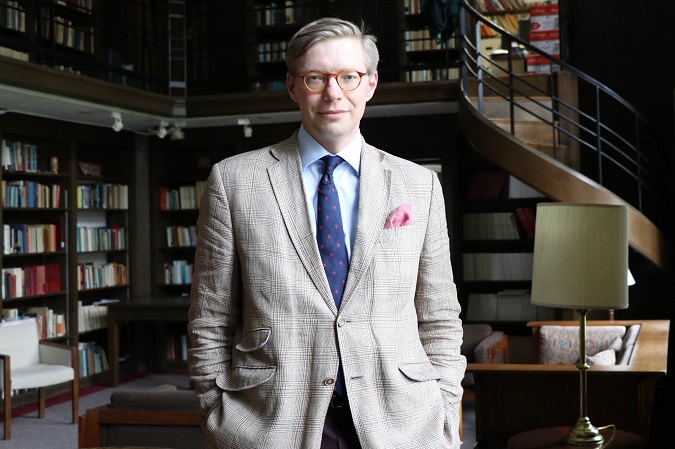
Dear USMC Community,
Please join me in congratulating our colleague Alexander Andrée on his promotion to full Professor at the Centre for Medieval Studies. In turn, please join me in congratulating Professor Andrée on his recent appointment as Associate Director of the Centre. He will serve in this role alongside his continuing role as Coordinator of our Mediaeval Studies program. Alexander’s many contributions to the study of the Middle Ages, across the College, the Centre, and PIMS, attest to his great energy in this regard, and we look forward to more of the same in the time to come.
Best,
Prof. Randy Boyagoda
Principal and Vice-President
Dear Colleagues,
I write to share the happy news that Sam Tanenhaus will join St. Mike’s as a Book & Media Studies visiting professor in 2018-19. Co-sponsored by St. Mike’s, the Dean of the Faculty of Arts and Science, the School of Public Policy and Governance, and the Centre for the Study of the United States, Sam will be teaching the special topics course “Trump and the Media” and the fourth-year seminar “Media Manipulation and History.” Sam is a prolific and influential journalist, historian, and former editor at The New York Times, and we look forward to his contributions to our academic and community life.
Best,
Randy Boyagoda
Principal and Vice-President
* * *
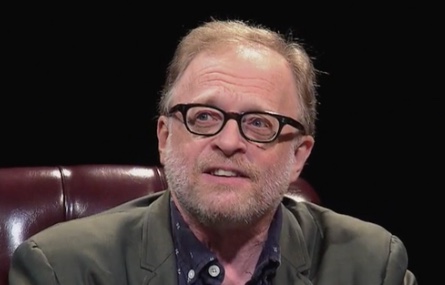
Sam Tanenhaus is a contributing columnist to Bloomberg View, and the U.S. Writer at Large for the British monthly, Prospect. He was previously on staff at The New York Times, where he was editor (in chief) of both the Sunday Book Review (2004-13) and the Week in Review (2008-2010) and was also Writer at Large (2013-14). Before joining the Times he was a contributing editor at Vanity Fair, where he wrote feature articles on politics and culture (1999-2004). His books include Whittaker Chambers: A Biography (winner of the 1997 Los Angeles Times Book Prize, finalist for both the National Book Award and Pulitzer Prize; and a national best-seller) and The Death of Conservatism (chosen by The New Yorker as one of its editors’ “100 Favorite Books” of 2009). His articles and essays have appeared in The New York Times Book Review, The New York Times Magazine, The New Yorker, The New York Review of Books, The New Republic, Atlantic, Esquire, Newsweek, Slate, Time, The Wall Street Journal, Washington Post, and many other publications (in the United States and Europe). Since 2008 he has led nonfiction writing workshops at CUNY. He was a Riggio Lecturer at The New School for Social Research from 2009 to 2014 and has lectured at Harvard, Yale, Princeton, Columbia, and New York University, as well as at the White House and at the Clinton, Kennedy, and Johnson Presidential libraries, the Aspen Ideas Festival, and the Sun Valley Writers Conference. He is currently at work on a biography of William F. Buckley Jr.
Dear Colleagues,
I am very happy to share the news of the appointment of Dr. Mary Elizabeth Cuff as our new USMC Gilson Postdoctoral Fellow. Mary will pursue research, contribute to the Gilson Seminar in Faith and Ideas, and contribute to our broader collegiate community. Please see below for more information about our new colleague.
Best,
Randy Boyagoda
Principal and Vice President
* * *
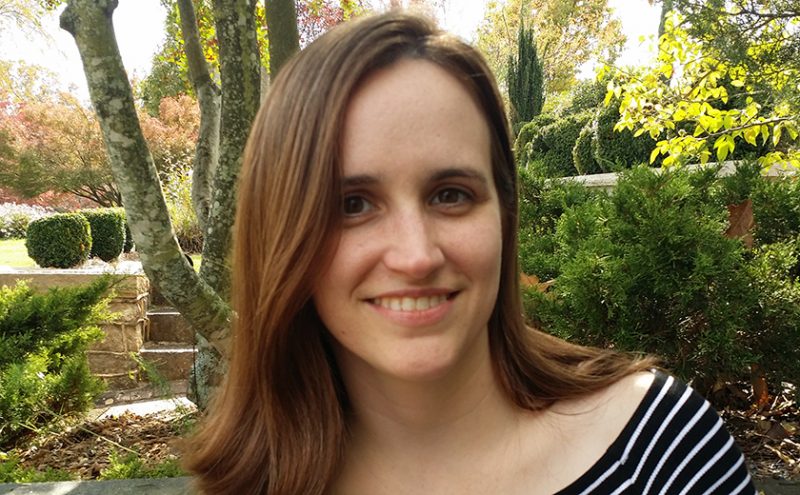
A native of Chicago, Illinois, Mary Elizabeth Cuff received her BA in English literature with a minor in Greek and Latin (2010) at the University of Dallas. As part of her UD education, Mary completed part of her undergraduate studies in Rome. After graduating, Mary began a MA in Classics at the Catholic University of America before realizing that her true passion was always going to be literature. She transferred programs to CUA’s literature department where she completed an MA (2013), a certificate in rhetoric (2018), and a PhD in 19th and 20th century American literature (2018) under the direction of Dr. Ernest Suarez. Her dissertation focused on the literary relationships of Herman Melville, Robert Penn Warren, and Ralph Ellison, specifically on their literary and nationalistic uses of the biblical archetypes of Isaac and Ishmael. She plans on developing the dissertation into a monograph.
Mary has published articles in The Southern Literary Journal, The Mississippi Quarterly, and Five Points: A Journal of Literature and Art. Her research interests are primarily focused on the literature of the US Civil War, the 20th century South, and agrarianism in literature. Her favorite novel is Moby-Dick, and she even likes those long, “boring” parts in the book about labeling the parts of a whale!

